Texas Bill Strength
This page is not intended to be a biography of Texas Bill, but an attempt to retrace his many steps across America during his short but incredibly action-packed lifetime. It was created at the request of and with the help of Dale Strength, Texas Bill’s eldest son, who is dedicated to preserving the legacy of his father.
Sources include:
- Ancestry.com
- Articles from Billboard magazine, as provided by Dale’s cousin
- Mr. Roland S. McDonald, Reference Archivist, Alabama Department of Archives and History
- Minneapolis Star and Tribune
- MyHeritage.com
- Newspapers.com
- PragueFrank’s Country Music Discographies – Frank Frantik has done an awesome job collecting information on Country artists and their recording sessions, despite the fact that he lives in in Prague, Czech Republic. All such recording information comes from this site.
- Ronnie Pugh’s article “Sing, Spin, Stump, Sell: The Forgotten Figure Who Did it All,” written as an entry on TBS for the Country Music Foundation’s encyclopedia. A version was read at the 14th International Country Music Conference on June 6, 1997, in Meridian, Mississippi.
- Don Veasey, Curator of Photographs, Department of Archives and Manuscripts, Birmingham Public Library
- Taped interviews that Dale conducted with his mother at her home in Texas in the early 1980s.
Corrections and additions are always welcome. Feel free to contact me. Jeanne Andersen
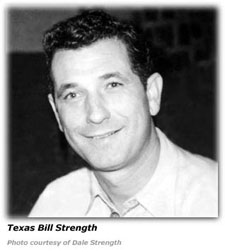
FAMILY HISTORY
This first section gives some background on Texas Bill’s family, going back to his grandparents. First we look at the Strength family on his father’s side, and then a brief look at the Yielding family on his mother’s side. Since all the Strengths were named William, the generations are color coded:
- Grandparents are Red
- Parents are Green
- Texas Bill Strength (TBS in this document) is, at least in this section, Purple.
Adding to the confusion is the protocol that when a Sr. dies and the Jr. has a son with the same name, the Jr. becomes the Sr. and the son becomes the Jr.
THE STRENGTH FAMILY
Despite his moniker, Texas Bill Strength was actually born and bred in Alabama. At the end of the 19th and beginning of the 20th Centuries there were many, many Strengths in the State of Alabama, and very few anywhere else. William Thomas Strength, Jr. comes from a long line of men with the same name.
Looking for early William Strengths, the Census of Free Inhabitants of Western Division, Tallapoosa County, Alabama, taken on August 8, 1860, shows a William Strength, born in Georgia in 1834. An undated document shows a William Strength in the 34th Alabama Infantry of the Confederate Army. Whether this was the same man or if he/they were relations to our Strength family is unknown.
1819
John Henry Strength was born in 1819. He and his wife Louisiana Stevens Strength were the parents of William T. Strength, and therefore TBS’s great grandparents.
Their children were:
- John Henry Strength, Jr., born 1841
- Hugenius Strength, born 1847
- Columbus Washington Strength, 1843 – 1915
- Mary Strength, born 1850
- William T. Strength, born 1855
1883
TALLASSEE
William T. Strength married Mary Artimiss Holt on July 1, 1883 in Elmore County, Alabama. William was TBS’s grandfather. He was born in May 1864. [1855] Artimiss was born in 1853 in Summit, Alabama.
1889
Lena (“Leener or Lener”) Strength was born in May 1889 to William and Artimiss. Lena married Lee Milton McDaniel. In 1910 she, Milton, and her sister Ada lived in Tallapoosa, where they all worked at a cotton mill; Milton as a drawer, and the women as spinners. In 1918 the family lived in Odenville, in St. Clair County, where they were farming. In 1920 the McDaniels had three children and lived in unincorporated Jefferson County. Milton worked as a teamster at a sawmill, where many of his neighbors were coal miners. In 1935-1940 the family lived in Branchville, Alabama, with four of their children. Milton was listed as a farmer on the 1940 Census. Milton died February 19, 1955, in Leeds, Alabama. Lena died on April 25, 1962, in Bell City, Alabama. She was buried at Bethel Baptist Church Cemetery in Branchville.
1890
Willey Strength was born in December 1890 to William and Artimiss. Willey is no doubt a nickname for some unknown Christian name. No information could be found about Willey, and the last we see of him is in 1900 when he is 9 years old. There is a Bill, Jr. in the same family at that point, so it’s unlikely that Willey’s real name was also William, but it’s unclear.
1891
Lige Strength was born on August 18, 1891, in Tallassee, Alabama to William and Artimiss. He was inducted into the Army on March 15, 1918, at Ashville, Alabama. He served from March 20 to December 6, 1918. At that time he lived in Acmar, Alabama. He was also a coal miner. He married Minnie P. Sullivan on March 7, 1923 in St. Clair County, Alabama. He died on May 19, 1930, and was buried at Mt. Olive Cemetery in Morris, Alabama.
1893
Ada Bell Strength was born in May 1893, to William and Artimiss. Ada married A.C. Brown. In 1930 Brown was a mechanic at a textile mill in Russell, Alabama. In 1935-1940 the Browns lived in Girard, Alabama. In 1940, Brown and three of their sons worked in a textile mill. In 1963 she was listed in James’s obituary as Ada Brown, Phenix City. When she died on July 11, 1970 her last name was Thomaston. There is a marriage notation for her on October 10, 1951, in Russell, Alabama, but no spouse is listed.
1895
Ivy L. Strength was born on January 19, 1895 to William and Artimiss. On June 10, 1911, Ivy married Ollie Parker in Tallapoosa and had one child. Then she married a Mr. Gray and had two children. On November 12, 1928, she married Robert Jefferson Mashburn (1881-1964) in Etowah, Alabama. Mashburn had four children. In 1963 Ivy lived in Pell City, Alabama. Ivy died on June 29, 1985, in Ragland, Alabama. She is buried in Mount Zion Cemetery in Pell City.
Mary Artimiss Holt Strength died on April 10, 1895, in Warrior, Alabama. Warrior is now a northern suburb of Birmingham. At the time of her death, Warrior’s population was about 1,000.
On December 14, 1895, William married Rosa Vidella “Deller” McKay or McCay. Della is TBS’s Grandmother. She was born in August 1875. She was the daughter of James and Harriet McCay.
1897
William Thomas Strength, Jr. was born in May 1897, to William and Della Strength. This William Strength was TBS’s father. He went by WT, and became WT, Sr. when his father died.
1899
Art Strength was born in August 1899, in Tallassee, Alabama, to William and Della.
1900
The Census taker in the 1900 Federal census (June 13, 1900) spelled the family’s names the way they were pronounced, including their surname, written as “Strinth.” Della was listed as “Deller,” and the children were listed as:
- Leener (Lina)
- Willey (unknown real name)
- Lige
- Adie (Ada)
- Ivie (Ivy)
- Bill Jr. (William, Jr.)
- Art
William T. Strength was listed in the 1900 Census as a farmhand.
James Solomon Strength, son of William and Della, was born on August 22, 1900, in Alabama. James never went to school and was illiterate – he signed his WW I registration with an X. His WW II registration indicated that he lived in Irondale, Alabama, was unemployed, and that his contact person was his mother, R.V. Bruner. James died on June 11, 1963. His obituary stated that he had lived in Leeds (near Moody), and that he had lived in Irondale most of his life. It said that he was a retired coal miner. He was buried at New Hope Baptist Church cemetery. He was survived by his wife, Viola, of Leeds. His brother, W.T., was living in Houston, as was his half brother, R.A. Bruner.
1901
Susan Frances “Fannie” Strength, Della and William’s daughter, born August 26, 1901, in Montgomery, Alabama. Fannie married James Jason Alexander “Shug” Isbell. Shug was born in 1872 and died in 1957. Shug was 46 and Fannie was 18 in 1920. He had daughters aged 18 and 16 at the time. Together they had at least three more children. In 1920 they lived in Bold Spring, Alabama. In 1930 he worked at the sawmill on Bessie Ferry Road in Jefferson County, Alabama, near her brother William. In 1940 Rosa’s obituary said that S. Isbell lived in Irondale. James’s obituary says that Fannie Pilkington lived in Gate City, Alabama, in 1963. Susan died on January 30, 1972, in Mobile. Her obituary in the Mobile Register indicated that her name was Mrs. Susan Frances Pilkington, a native of Montgomery. The obit does not list anyone named Pilkington in the list of survivors.
1901-1906
William T. Strength died sometime between 1901 and 1906.
1906
Della Strength, William’s widow, married Reuben Marion Bruner on May 13, 1907, in Jefferson County, Alabama. Reuben was born in 1864 [or 1871] in North Carolina. His parents were from Virginia. It was the second Marriage for both Della and Reuben.
1907
Lorna Geneva Bruner, Della and Reuben’s daughter, was born on September 19, 1907, in Birmingham. She first married James Barnett at age 18 on January 3, 1923, using the name Loney Bruner. They were married at Roberson Mines, Jefferson County. She married Willie Green Braswell on October 26, 1929, using the name Geneva Barnett. In the 1930 Census she was listed as Mary for some reason, and was living in Cotton Hill, Alabama where Willie was listed as a farmer. In 1935-1940 the family lived in Eufaula, Alabama, where Lorna worked in a textile mill. Willie was not shown to be working in 1940. In 1963 Lorna lived in Eufaula. Lorna died in September 1984 in Eufaula, Alabama. She is buried in Sardis Cemetery, Baker Hill, Alabama. Willie died on April 23, 1986, and is in the same cemetery.
1909
Raphael Anglo Bruner, Della and Reuben’s son, was born on September 13, 1909, in Tallassee, Alabama. He was only 5’ 2” and weighed 115 pounds. He worked as a truck driver. In 1940 and 1963 he lived in Houston. He died on June 10, 1978, of lung cancer in Houston, Texas.
1910
TALLAPOOSA
In 1910 the Federal Census showed that Della and Reuben M. Bruner lived on Ashhurst Ave., Tallapoosa, Alabama. By this time Della was known as Rosie. Reuben “Ruby” and Rosie both worked in cotton mills – Reuben as a weaver, Rosie as a doffer. Children living with them were listed as Louie G. and Rachel A. Bruner, and James, Susan, and William Strength.
1913
Rufus Bruner, son of Rosie and Reuben, was born in 1913 in Rodo, North Carolina. He died on April 6, 1923 at the Roberson Mines in Jefferson County, Alabama at the age of 11. He is buried at the Hillview Baptist Church Cemetery in Forestdale, Alabama.
1914
Martha Dulcina “Cinny” Bruner, daughter of Rosie and Reuben, was born on August 23, 1914, in North Carolina. She married George N. Mitchell on October 26, 1931. In 1940 George was a laborer in Irondale. In 1963 she lived in Irondale, Alabama. In 1940 her mother Rosie (listed as Rosa) and her half-brother James lived with her and her family. She died on February 17, 1994, in Fountain Valley, California.
1916
Rosa M. [Vidella] Bruner, daughter of Rosie and Reuben, was born on May 2, 1916, in Charlotte, North Carolina. On August 2, 1930, at age 14, she married Therel Deforrest Carlton, age 18, in Irondale. Therel was born in Mississippi on May 12, 1912. Both of their fathers had to give their permission to wed. On February 19, 1933, son Robert Lewis Carlton was born. In 1934 Rosa and Theral lived in Gate City, Birmingham. In 1935 she was a laundress in Birmingham. They divorced in February 1939, and at the time of the April 12, 1940, Federal Census, Robert was living with Theral and his new wife. Theral apparently married again in 1944.
Rosa married Frank M. Burton on August 24, 1939, in Jefferson County. Frank was born on December 8, 1909, and was a steamfitter. At the time Rosa was a waitress. She died on November 23, 1940, “at a local infirmary” in Birmingham at the age of 24. She and Frank had lived at 1021 12th Street N. The obituary said that they had one son and two daughters. Rosa was interred at the New Hope Cemetery, Birmingham.
1920
In 1920 Rosie and Reuben lived in unincorporated Jefferson County and Reuben’s occupation was listed as “charcoal burners.” Their household included only Rosie and Reuben’s children:
- Lorna
- Raphael
- Rufus
- Dulcina
- Rosa
1935
In 1935 Rosie (listed as Rosa) was a housekeeper in Birmingham, according to the Birmingham directory.
1940
In 1940 Rosie lived with daughter Cinny Bruner and son James Strength in Irondale, according to the Census. Daughter Rosa’s obituary stated that she was survived by parents Mr. and Mrs. R.N. Bruner, Irondale.
1942
Rosie died August 5, 1942, Jefferson County, Alabama
THE YIELDING FAMILY
The Yieldings were TBS’s relatives on his mother’s side.
1888
ONEONTA
George McGovern Yielding (TBS’s Grandfather) was born in March 1859 in Alabama. Both of his parents were also from Alabama. He died on January 25, 1915, in Oneonta, Blount County, Alabama.
George’s wife Lucy T. Yielding (TBS’s Grandmother) was born in March 1863 in Alabama. Her parents were also born in Alabama.
In June 1900 Lucy and George reported to the Census that they had been married for 12 years, which would have made it about 1888.
Their son John Henry Yielding was born in April 1888.
1890
In the 1890 Federal Census, George was listed as a truck driver. They reported that two of their seven children so far had died.
- Mary Yielding was born in September 1890.
- Eliza Belle Yielding was born in April 1892.
- Gypsie Lucille Yielding was born on July 4, 1893, in Oneonta, Alabama.
- Tomie G. Yielding was born in June 1898.
- Jessie Leon Yielding (TBS’s Mother), born on September 30, 1903.
- Katie M. Yielding was born in 1907.
1910
Florence N. Yielding was born in 1910.
The 1910 Federal Census reported that the Yielding family lived in Oneonta.
1915
George Yielding died in 1915, when Jessie was only 15 years old.
1918
On September 9, 1918, at age 15, Jessie married Sam Cross Sandling. Sam was 21 years old, born on March 2, 1897, in Birmingham. In a 1918 Birmingham phone directory he was listed as a butcher, but on his World War I registration card (undated) he listed his employer as the Alabama Great Southern Railway. Sam was inducted into the military from Bibb, Alabama on August 26, 1918, and first assigned to a base in Georgia, but was apparently able to make it back to Birmingham to marry Jessie in September. Jessie’s mother Lucy had to sign an affidavit giving permission for her to marry since she was a minor. Sam Sandling died on October 16, 1918 – where or how is unknown. It was the height of the Spanish Flu, and many of the men conscripted to fight in WW I (Sam was to be a boiler maker) never made it to France. He was interred at the Macedonia Baptist Cemetery in Oxford, Georgia.
1919
Jessie had Sam’s son, Eugene Henry Sandling, TBS’s half brother, on June 9, 1919, in Birmingham. Although there was no shame in being a war widow, and the baby was legitimate, it appears that Jessie took back her maiden name. Other evidence that of Eugene’s real father was that one of his brothers named him as his contact person on his military registration form, using his real last name. However, the name Strength was used on some Census documents.
Brother Albert’s World War II registration card named Eugene as the person who would always know his address. At that time, Albert listed Eugene’s address as 4038 Sixth Ave. No. in Birmingham, which was a bit off from WT and Jessie’s 4032 address. Eugene served in the Marine Corps from April 1, 1944 to March 23, 1947. He married Mattie Beatrice Hall on May 6, 1939 – she died in 1988. His second wife was Christine Kolojacko (May 30, 1932 – January 11, 2011). Eugene died on December 19, 1990, in Conroe, Texas, and is buried at Woodlawn Cemetery, Houston.
JESSIE AND WILLIAM, SR.
1918
Since Lige lived in Acmar in March 1918 according to his World War I military registration card, his brother William probably moved with him from Tallapoosa as well, but there is no hard evidence.
William served in World War I, but if so his military registration card doesn’t seem to be on Ancestry.com. He would have been 20 years old, so it would make sense.
It is unclear when Jessie and William got married but it was probably 1919 or 1920.
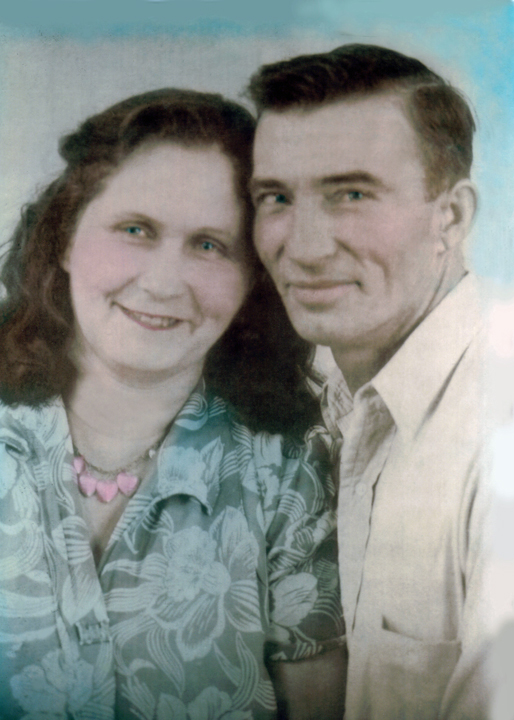
Jessie and William T. Strength Photo courtesy Dale Strength
By all evidence, the Strength family was a poor, itinerant, mining camp family that moved to where the mining jobs were from about 1920 to the early 1940s. Counting Eugene, Jessie’s son by a previous marriage, the Strengths had eight boys. TBS was the fifth of the eight.
1920
MOODY
The 1920 Census showed the family living on “Private Road, Mining Camp, St. Clair County” (town of Moody scratched out). The road no doubt belonged to a mining company, as the Census showed that William T. Strength, age 22, was a coal miner. Jessie was 18 years old. The household also included baby Eugene and William’s brother Lige Strength, now age 30.
Moody is located about 15 miles east of Birmingham. It was known as Moody’s Crossroads well into the 1950s, the crossroads being Park Ave. and Moody’s Parkway/Highway 24/Highway 411. At the end of Park Ave. is the Star Ridge Landfill (shown on the map below as Advanced Disposal Moody Landfill), 770 acres described as a former coal mine.
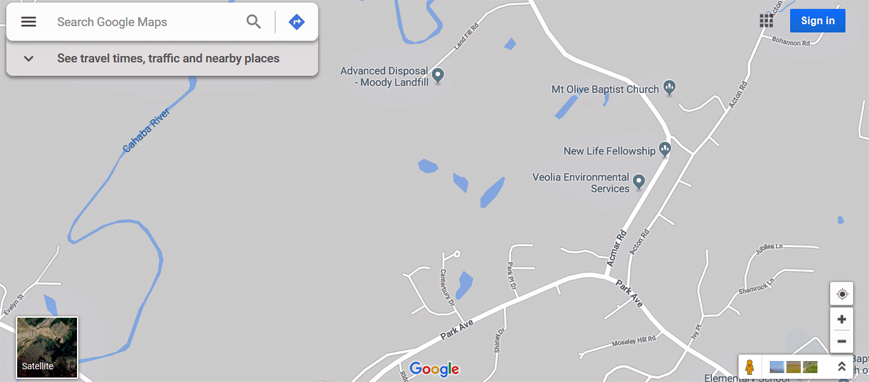
1921
Fred Thomas Strength was born on January 22, 1921, in Acmar, Alabama to William and Jessie. Uncle Fred must have been an interesting character. In 1937, at only 16, he and his dad were convicted of “Distilling” in Jefferson County, Alabama. (See 1937 below.)
In February 1942, Fred’s military registration revealed that he had a “scar across upper lip.” Later that year, in September 1942, he was convicted of “contributing to the dependency, neglect, and delinquency of a female under 18” and sentenced to 12 months in prison, court costs of $18.10, and a fine of $500. If I’m reading this right, he escaped on May 15, 1943, was recaptured on March 11, 1944, and discharged on September 24, 1944 – “Paid out.”
Even his love life was confusing. Documents say he married Jimmie/Jemmie Lee Watson in Miller County, Arkansas, on May 28, 1950, but then he married her again on June 20, 1953, in Houston. She died on February 8, 1988. He died on July 15, 1988, in Liberty, Texas.
1922
Albert Clark Strength was born on September 12, 1922, in Acmar, Alabama. In 1942 he lived in Birmingham with his parents W.T. and Jessie, and worked as a delivery man. His World War II draft registration card noted that he had a long scar on his right leg. He enlisted in the Army on September 21, 1942. In 1950 he lived in Rushville, Nebraska. On May 23, 1951 he married Nellie Florine Alfred in Houston. He died on July 22, 1993, in Galveston, Texas.
ACMAR
Much of the following information comes from the following people:
- Jane and Vernon Barker, Acmar residents. Jane provided me with a Moody/Acmar calendar issued by the Lion’s Club that includes photos and historical information.
- William Rowell, a young man with deep roots in Acmar, having grown up in the house that the school teacher occupied during the mining days.
- Donna Turner, Acmar resident historian, who has provided information and photos.
- Penny at the Moody Public Library, who shared historic photos.
Acmar is an unincorporated community in St. Clair County, three miles from Moody. It was founded in 1908 by Henry F. DeBardeleben, founder of the Alabama Fuel and Iron Company, who opened two coal mines at Acmar. The name Acmar is a combination of two mines, Acton and Margaret – Margaret was named for Henry’s daughter-in-law. Henry died in 1910 and was succeeded by his son Charles, who the miners and their families reportedly called “Uncle Charlie.”
Donna Turner says that most babies at that time were born at home with the company doctor in attendance. Those with very serious illness or injuries went to South Highlands Infirmary in Birmingham.
Several mines were opened in Acmar; some were slope mines and some were shaft mines. Once depleted, soil and rocks were removed and they became strip mines, with coal harvested by drag-line equipment. The soil was then replaced or ponds were built. Coal production peaked in 1926.
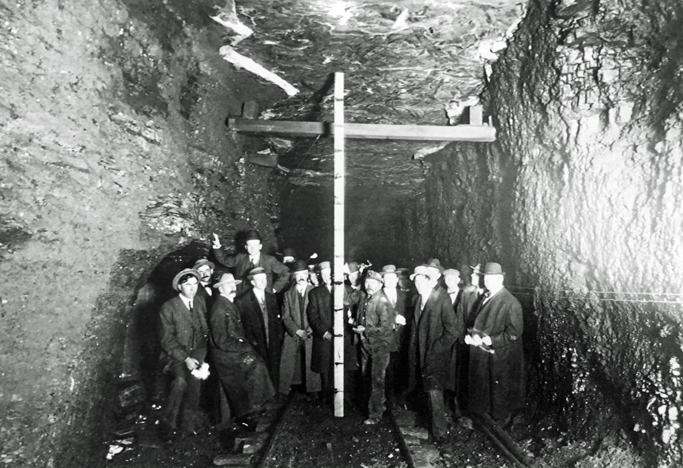
Photo courtesy Moody Public Library
Jane Barker’s calendar says that in 1926 “Uncle Charlie” hired experts to teach the miners to garden and their wives how to can and preserve the food their husbands grew. These skills allowed the miners to weather the Depression without having to accept relief.
Donna reports that “the company also promoted music and even brought in a musician to teach music, mostly to the young people, and the band played at many company events.”
Not all was rosy at the mine, apparently. Wikipedia, citing a book called Everyone Was Black Down There (Robert H. Woodrum, 2007) says that in October 1935, one miner was killed and six were injured when strikers belonging to the United Mine Workers of America attempted to drive into the mines. William Rowell says that there were mounted machine guns at the entrance to the Acmar mines; the concrete is still there.
The mines at Acmar closed in 1951. Several buildings from mining years remain at Acmar, which is an active residential community today. The epicenter is the Acmar United Methodist Church, still active today. Back when the mines were active, the church alternated Sundays between Methodist and Baptist services. The Strengths would likely have gone to the Baptist services. The Baptists eventually formed their own church.
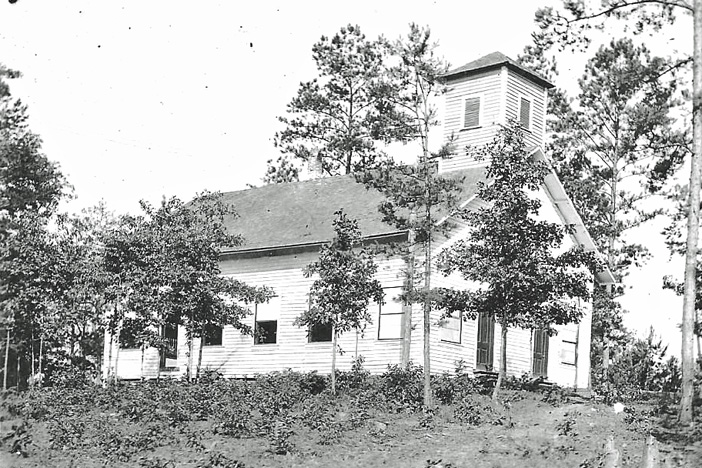
Acmar Church in the 1920s. Photo courtesy Donna Turner
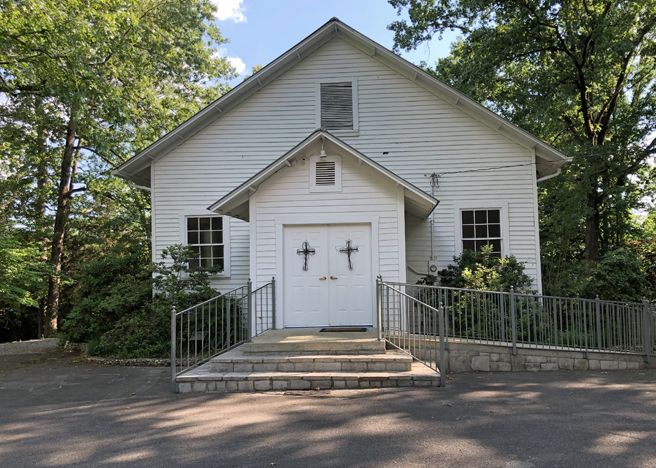
Acmar Church in 2019. The steeple was removed.
The black church is also still there, but in considerably worse shape. It appears that it was later used as a community center. The two churches were proximate to each other in mining days, but the roads have since been reconfigured, so the path between them is a little convoluted.
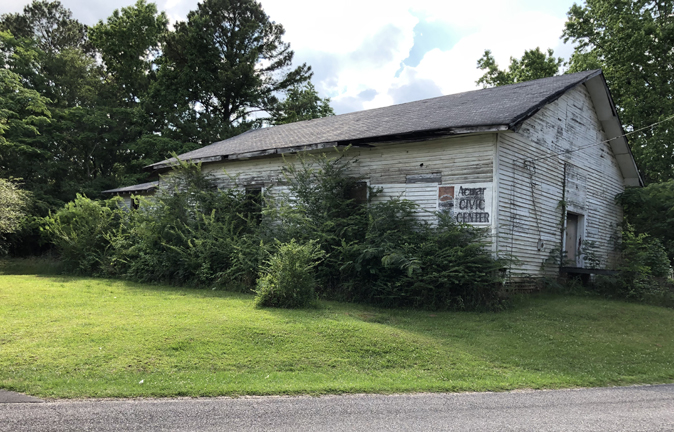
Acmar’s old black church
Other buildings that remain are the teacher’s residence, a gas station, and the commissary. As in most company towns, workers were paid in script, which William Rowell says was referred to as “clacker.”
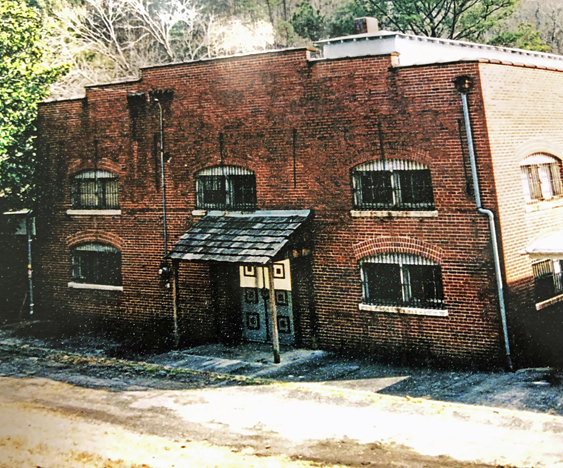
Acmar Commissary – Photo courtesy Moody Public Library
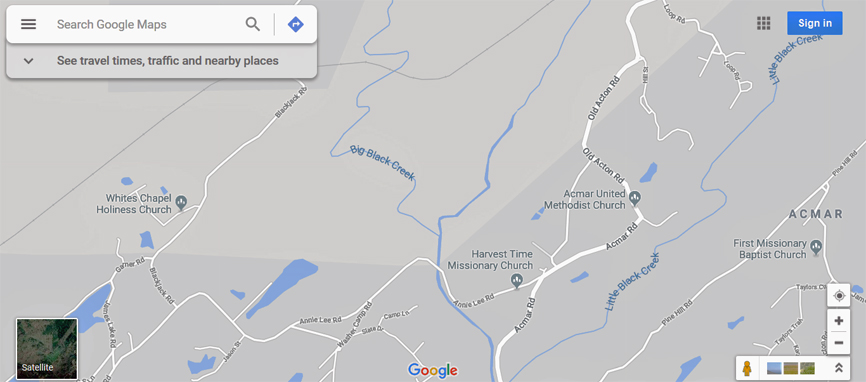
1923
IRONDALE
Edward Woodrow Strength, Sr., was born on May 22, 1923, in Irondale, Alabama to William and Jessie. He served in the Navy from February 4, 1941 to August 9, 1946. In 1950 he lived in Houston. He died on August 30, 2002.
1926
James Silas Strength was born on May 4, 1926, location unknown, to William and Jessie. James served in the Navy from February 1943 to March 22, 1947. He married Helen Lucille Hall in May 1950. In 1950 he was a painter living in Pasadena, Texas. He died on March 21, 1992, in Harris County, Texas, and is buried at Houston National Cemetery.
BESSEMER
1928
William Thomas Strength, Jr. was born on August 28, 1928. Family lore says that he was born in Bessemer, Alabama, but no birth certificate has been located. The family does not appear in the 1926 or 1932 Bessemer directories, although there are quite a few men listed in them with the occupation of miner.
Chris Eiland at the Bessemer Hall of History reports that in 1928, there were three possible places he could have been born:
- Elizabeth Duncan Memorial Hospital, known as Bessemer General Hospital, located at Third Ave. and 17th Street. This hospital was built in 1913 and closed in the early 1970s. It is now the site of Bessemer City Hall.
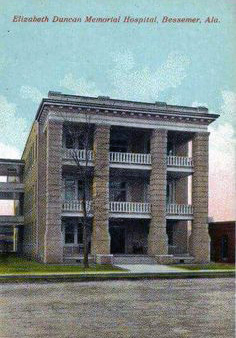
Bessemer General
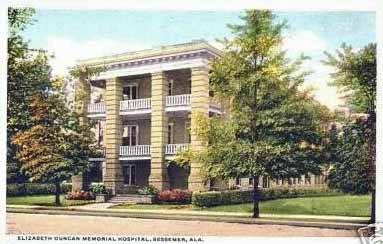
Muscoda Mine Dispensary. Muscoda was one of many Birmingham-area company towns, located at Readers Gap on Red Mountain, south of Bessemer. It is now pretty much a ghost town.
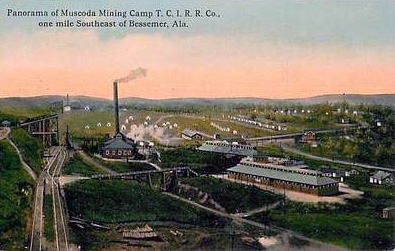
Muscoda Mining Camp
Employees Hospital of the Tennessee Coal, Iron and Railroad Company (TCI), located in nearby Fairfield. TCI became a division of U.S. Steel, and in the 1950s the hospital was renamed after Dr. Lloyd Nolan. The building was demolished in 2009. Fairfield is proud to be the birthplace of George Lindsay (“Goober” on the Andy Griffith Show..”), born in the same year as Texas Bill, but by 1930 he was living with his grandparents in Jasper.
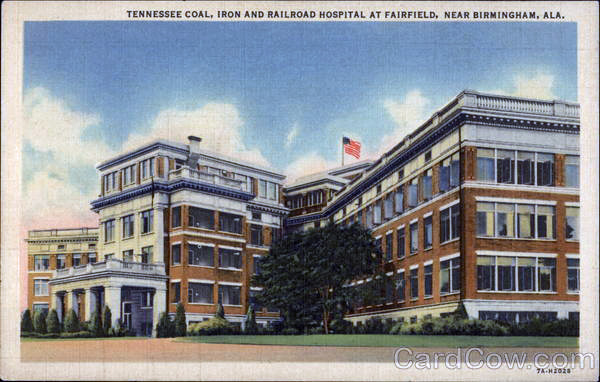
Tennessee Coal, Iron and Railroad Hospital at Fairfield
And, of course, William Jr. (TBS) could have been born at home.
IRON MOUNTAIN
Bill’s eventual wife Dorothy said that he was born in Iron Mountain, Alabama. Iron Mountain is a peak in Alabama and has an elevation of 1,188 feet. There doesn’t appear to be a town there, but perhaps there was a company mining town there in 1928? Here’s a map of the area:
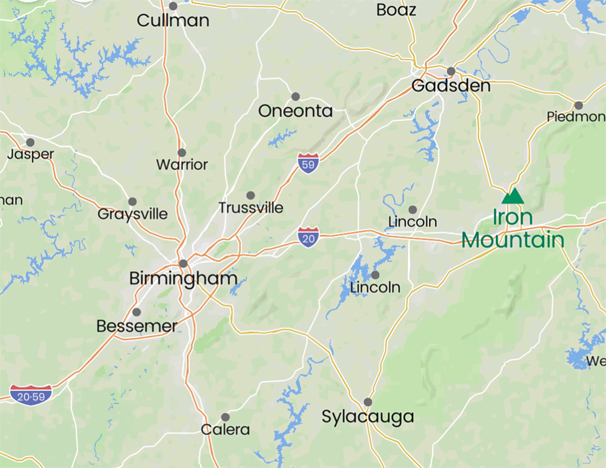
1930
BESSIE
In 1930 the Federal Census shows that the family lived in a house at 191 Bessie Road, Bessie Town, Jefferson County, Alabama. Bessie was located 22 miles northwest of Birmingham. William T. Strength and his brother James were coal miners.
William and Jessie’s Children in 1930 were:
- Eugene (Sam’s son)
- Fred
- Albert
- Edward
- James
- TBS (listed as W.T. in the Census)
BESSIE MINE
This history of Bessie was provided by Don Veasey of the Birmingham Public Library, compiled from the book The Birmingham District: An Industrial History and Guide, written by Marjorie L. White.
The Sloss-Sheffield Steel and Iron Company was the Birmingham District’s second largest producer of pig iron. Many corporations in the Birmingham District built and maintained housing and entire towns, assuming most responsibility for the general welfare of their employees up through World War II. The Sloss-Sheffield Company owned and operated housing, bathhouses, and commissaries at most of its furnace and mining operations, including Bessie.
The Bessie Mine opened in 1903. It was named for John T. Milner’s granddaughter Bessie. It was fairly common for Birmingham-area industrialists to name mines, towns, and railroads for daughters or other family members.
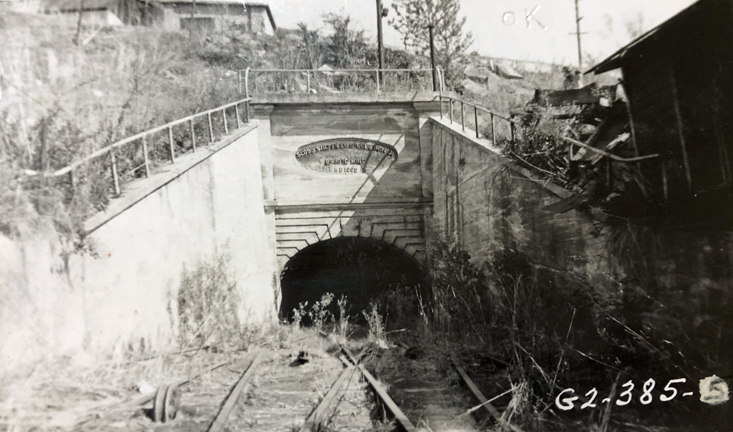
Bessie Mine entrance, 1940. Photo Birmingham Public Library
The mine entrance had a 20 ft. reinforced concrete wall, was 24 ft. high, with guardrails of 3 inch pipe. The entrance was 22 ft. wide, and accommodated a double track rail system.
An article in the Birmingham News dated January 2, 1942, reports that the Bessie mine shut down in 1932. This would seem to indicate when the Strength family probably left Bessie. They had definitely moved on by 1935.
In 1942 it was announced that the Sloss-Sheffield Steel and Iron Co. would spend $700,000 to refurbish the Bessie Mine to provide materials for the War effort.
By 1955, only the Flat Top, Bessie and Hardspat mines were still in operation. As the mines closed, people moved away. Housing at the Bessie and Flat Top mines was sold to employees in 1957 and has was mostly demolished in 1964.
Flat Top and Bessie closed in 1976 when the Jim Walter Corporation (successor to U.S. Pipe, the successor to the Sloss Company) reopened the new Nebo mine nearby.
ROADS IN BESSIE
The configuration of the area is basically a circle of roads that presumably surround the mine itself. There are two roads that lead to Flat Top Road, which is the main thoroughfare through the area (the orange line at the top of the map below, south of Highway 23).
Another name for Bessie appears to be Maben, which may have been the Post Office.
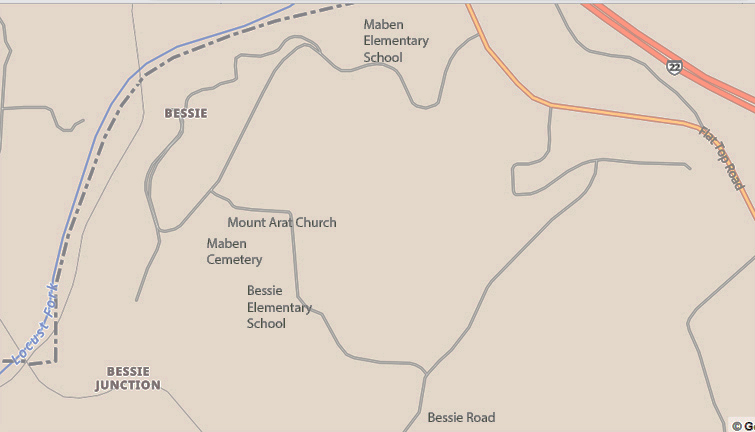
Any attempt to drive through the area now is thwarted by gates that close off the dirt roads.
On the 1930 Census form for the district that included Bessie, there were a handful of roads:
- Bessie Ferry Road: The ferry to which Bessie Ferry Road refers appears to be to the southwest of Bessie, in the bend of the Locust Fork where the river turns back to the north. This appears to be part of the road from the Palos area across the river to Porter, which seems to be a few miles from Bessie. There are a few roads now that lead toward the river but current aerial views do not seem to show any old roadbeds right to it, so the location of Bessie Ferry Road remains unclear.
- Bessie Mines Road: Some current maps still show this road.
- Bessie Road: Various maps show Bessie Road in different locations, mostly south of the mine. The location of 191 Bessie Road is unfortunately lost to history.
- Dry Ridge: Does not exist today.
- Sweet Ridge: Does not exist today
- Lindberg: Bessie-Lindberg Road can be seen on some maps, leading to the extinct town of Lindberg. In 1930, one man, Thomas Davis, a waiter in a restaurant, was counted on the Census as living on Lindberg.
In all, in 1930 the district had 365 houses with 410 families.
BUILDINGS
In 1940, the Jefferson County Tax Assessor took photos of the buildings at the Bessie mine to use for property tax purposes. Mr. Veasey at the Birmingham Public Library was kind enough to pull those files and retrieve the photos.
Below is an example of the kind of home the Strengths would have lived in. It was described as a three room cottage with a pine floor. The 1930 Federal Census says that they paid $6/month in rent.
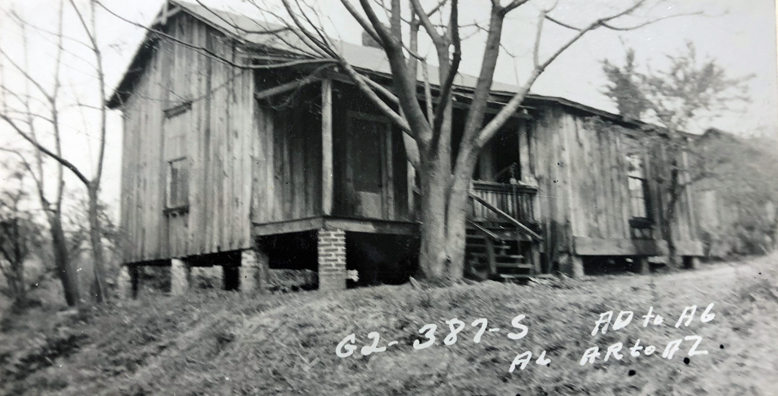
Photo courtesy Birmingham Public Library
Life at the mines was strictly segregated – after all, this was Alabama – which was a little ironic since the coal dust painted everyone black. The photo below is some kind of mine office, with separate entrances marked “White” and “Colored.”
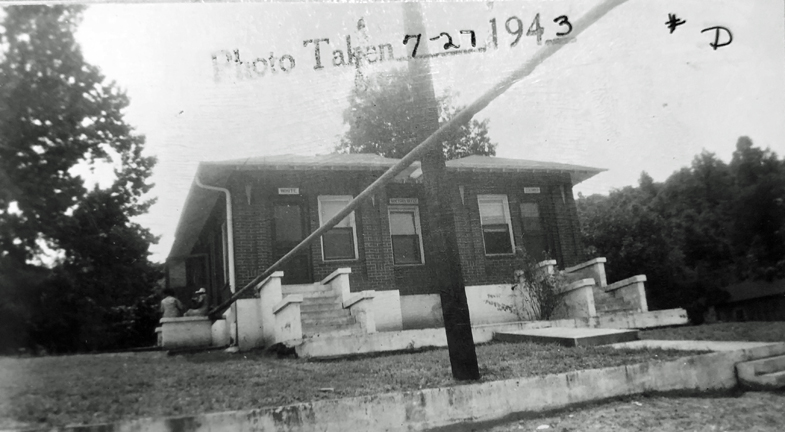
Photo courtesy Birmingham Public Library
There were separate white and black schools, and there are two schools indicated on the map above. The white school was razed on December 8, 1964 – the time that most of the buildings were demolished.
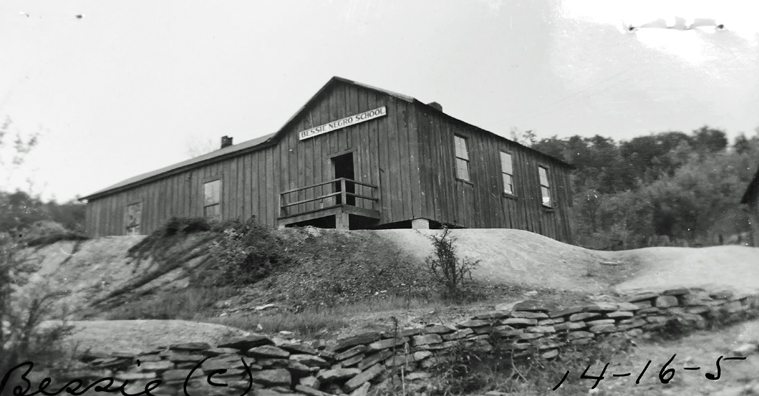
This building has a sign that says “Bessie Negro School.” Photo courtesy Birmingham Public Library.
The map shows a “Mount Arat Church.” Could that be Ararat? The photo of this church was not identified with a name, denomination, or race.
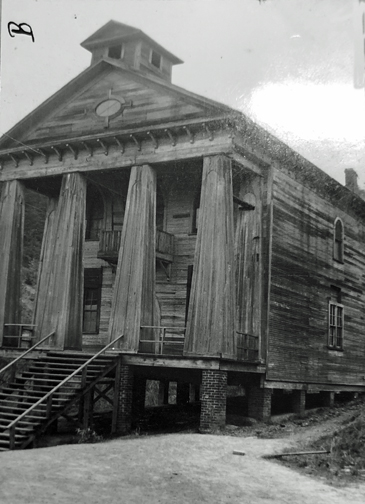
Photo courtesy Birmingham Public Library
Bessie Town is now located within the city of Adamsville, northwest of Birmingham. The only thing left of Bessie is the cemetery. Photos of most of the gravestones in the Bessie/Maben Cemetery can be found on the findagrave.com website.
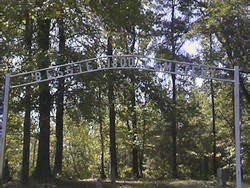
Photo by Patricia Wilbert, findagrave.com
1932
(BIRMINGHAM)
Arthur Leon Strength was born on February 16, 1932, to William and Jessie. Findagrave.com says that he was born in Birmingham, which may be a clue to where the family lived that year. He was apparently known as Pete, and served time in Huntsville Prison in Texas in 1950 (see 1955 below). He died on February 12, 2010, in Lithia Springs, Georgia.
1935
IRONDALE
The 1940 Census asked where the family lived in 1935, and Strengths answered Irondale, a mining town just west of Birmingham.
Irondale is the home town of Fannie Flagg (family name Neal), who wrote the book Fried Green Tomatoes. The story is set at the Whistle Stop Café, which is now called the Irondale Café. It is a cafeteria type place where strictly Southern food is served. Irondale’s historic district is on 1st Avenue, which lies on either side of the railroad tracks. The Café faces the tracks. The film was not made in Irondale, but in Georgia; Irondale is still a thriving community, while in the movie it just fades away… (Thanks, Don Veasey!)
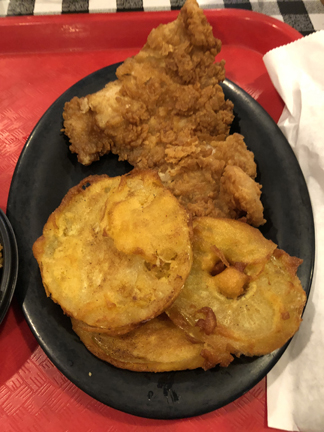
Fried Green Tomatoes – and a Pork Chop
1936
Charles E. Strength was born on February 4, 1936, location unknown, to William and Jessie. Charlie passed away on April 30, 1955, in Pasadena, Texas. He is buried at Woodlawn Cemetery in Houston.
1937
W.T. Strength, age 40, (TBS’s dad) and Fred Strength (TBS’s 16-year-old brother) were convicted of “Distilling” in Jefferson County, Alabama (Bess Division). The notes read, “The Grand Jury charged that subsequent to 11-30-19 (sic) [the defendants] did and unlawfully mfg, sell give away or have in his possession of a still.” They were sentenced to 1 year and 1 day to 1 year and 7 months. WT’s sentence began on April 18, 1937, and Fred’s began the next day. A distilling fee of $50 each was paid on May 1, 1937. They were paroled on November 2, 1937.
Note that in April 1937, when WT and Fred got in trouble with the law, the court was called the Bess Division. So it may be that they were still in Bessie in 1937, and didn’t move on to Irondale until a bit later?
1940
OVERTON
By 1940 the family had moved seven miles west to Overton, an unincorporated area of Jefferson County with about 200 households. Maybe. Overton was essentially the same as Irondale. (William’s half sister Rosa’s obituary in November 1940 said that he lived in Irondale.) It was a coal mining town, but William, now 44 years old, worked at building construction. He reported that he had a fifth grade education. The address given was Irondale Rt. 1, 27th Street Road, which doesn’t really compute on a map. The streets in Irondale only go to about 25th Street, and that area is heavily industrial today.
1942
BIRMINGHAM
In 1942, William, Sr., Jessie, and TBS’s brother Albert were living at 4032 6th Ave. No. in Birmingham, Alabama. Albert was probably listed separately in the directory because he was 22 years old; no doubt the younger boys were there as well. TBS would have been 13 or 14.
NEW ORLEANS
The 1945 New Orleans directory lists Bill, Jr. and his parents living at 857 Magazine Street. Bill’s father was listed as “Delta ship building.”
In 1946 TBS filled out his military registration card (see below), and listed his mother at the same address. This address is also found in a New Orleans directory.
In an interview, TBS’s wife Dorothy remembered that WT, Sr. and some of his sons worked as painters, and that WT, Sr. would make “white lightning.” She thought that TBS might have been in Houston four or five years before Jessie and WT moved there.
HOUSTON
Bill’s parents were living in Houston, the May 13, 1950, Census tells us. The address was 1104 Chartres Street., in downtown Houston. In addition to William and Jessie, who were not working, the household included:
Bill’s brother Fred, 29, listed as a painter in a building firm. At that time he had never married;
Bill’s brother Arther, 28, listed as a telegrapher in a telegraph office. He was listed as a widower.
Chartres Street still exists, along a southeastern stretch next to Interstate 69 (Eastex Freeway), which began construction in about 1954. Texas Bill’s parents lived on the other side of Chartres Street, however, and were probably displaced after their 1950 residency. Their home is either under the highway or the site of the George R. Brown Convention Center.
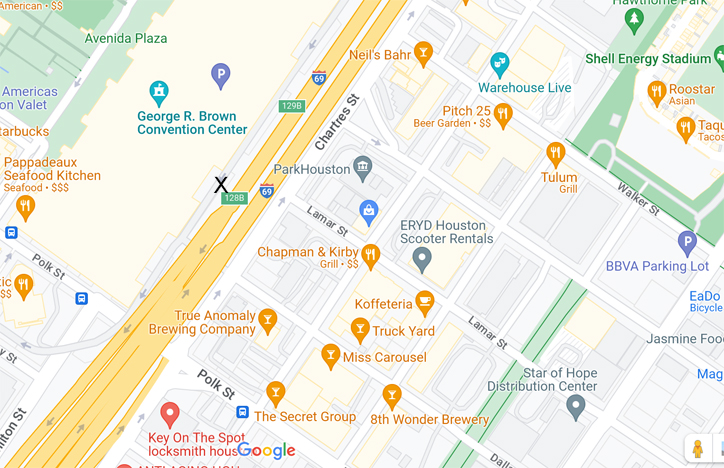
X marks the spot where TBS’s parents lived in Downtown Houston in 1950
William., Sr. and Jessie are difficult to find after this, but in 1958 we find a listing for them at 1277 Sheffield in Houston. William was listed as a carpenter.
CONROE
Jessie died at her home in Conroe, Texas, on September 1, 1965, of carcinoma of the bladder. She was 62. At the time she had been working as a waitress at a drug store soda fountain. Her address was described as “Hollow Road, ½ mile East of Tamina Road, Rt. 1, Box 259 A, Conroe.” She was interred at Woodlawn Garden of Memories, Houston.
W.T. Strength, Sr. died at the VA Hospital in Houston on February 7, 1966, at the age of 69. He also died of cancer of the bladder. His occupation was listed as Painter. His address was listed as Box 77301, Conroe, Texas He was interred on February 9, 1966, at Woodlawn Garden of Memories, Houston.
THE EARLY CAREER OF TEXAS BILL STRENGTH
TEXAS BILL AND THE GUITAR
So how did a man born and raised in Alabama become “Texas Bill?” Jimmie Rodgers notwithstanding, there really were no cowboys in Alabama, so he moved to Houston. And how did he learn to play the guitar? Son Dale asked him that question once. The answer was not the romantic scenario of taking lessons from some black bluesman in New Orleans – he just learned by ear. “Hell son, there’s only 12 notes, how hard can it be?” Dale took that advice to heart and became a professional guitar player himself.
1944
THE JOY THEATER, HOUSTON
Family lore is that TBS won an amateur talent contest at the Joy Theatre in Houston at the age of 16. A search through the Houston papers doesn’t give up any evidence or details about the contest.
National Hillbilly News columnist Norma Winton wrote in 1949 that, in remembering that episode, Bill said, “My Mother thought for sure I was dying, and I can’t say what the old man said.”
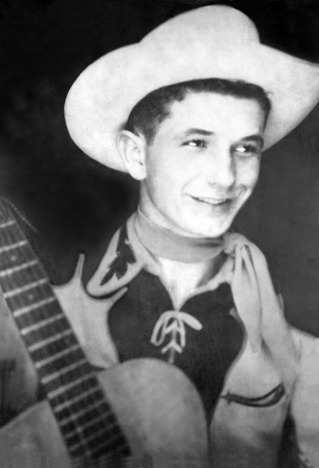
Texas Bill at age 16. Photo courtesy Dale Strength
The theater had been called the Crown Theatre, stood dormant for most of the 1930s, and reopened in 1937 as the Joy, known for a time as the Joy-Tex. (Cinema Houston: From Nickelodeon to Megaplex, by David Welling). All of the references found in the Houston Chronicle (albeit classified ads for help) cited the Joy Theatre.
The people at CinemaTreasures.com describe this now-demolished theater:
Not one of the Houston’s finer show places, this bottom rung, second-run showplace was located at 303 South Main. A haven for Republic westerns, B-movies, and Columbia serials, the Joy Theatre was notorious for running exploitation films and holding late night burlesque shows on weekends.
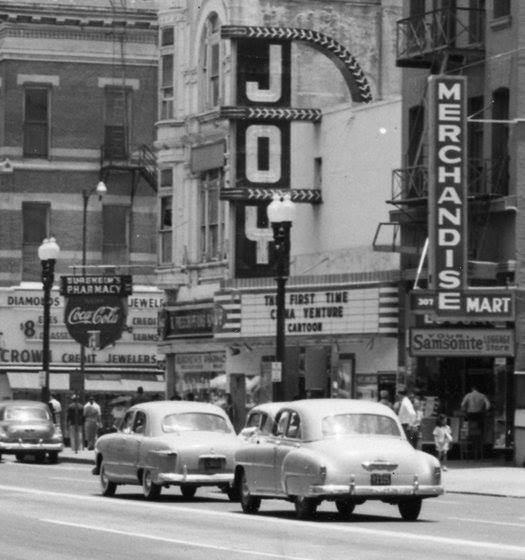
The Joy Theatre, 1953. Credit CinemaTreasures.com
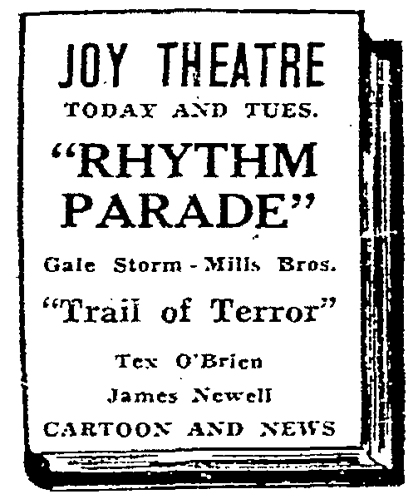
Houston Chronicle, March 27, 1944
KTHT
As a result of this talent show win, the article below tells us that TBS got a job at Houston radio station KTHT. A look at the Houston Chronicle says that KTHT was started up by a County Judge who was forced to give up his position before the FCC would give him a license. The station went on the air with skeleton programming on July 28, 1944, and became an affiliate of the Mutual Broadcasting System on September 1, 1944. Although most of the programming came from Mutual, there were other shows that TBS could have participated in, such as “The Texas Cowboys” and “The Bar X Cowboys.”
1945
NEW ORLEANS
The 1945 New Orleans directory lists Bill, Jr. and his parents living at 857 Magazine Street. Bill’s father was listed as “Delta ship building.”
ST. JOSEPH, MISSOURI
October 1945
The first article about Texas Bill that comes up in a search in Newspapers.com is dated October 12, 1945, and is in the St. Joseph, MO, Journal. This article is important enough to quote in full:
New Entertainer Appears Daily on Station KFEQ
Texas Bill is one title in radio that is more than a stage name, because KFEQ’s Texas Bill Strength is really from down the Texas Trail. He was born in Bessemer, Ala., and after the right doses of schooling and R.O.T.C., took off for the Lone Star State, with his guitar under his arm. He first played and strummed his gitfiddle on the stage of the Joytex Theatre, in Houston, where he won first prize in a stage contest. This got him a job with radio station KTHT, in Houston. And so the radio bug got him.
Texas Bill is now on his way to bigger and better things, even Hollywood, if he can get the breaks. But, Bill isn’t the type to sit back and wait for the breaks to come to him. He’ll make them for himself by trying to do his best along as many lines as possible every single day. He even composes lots of the songs he sings on KFEQ, and hopes to get some of those songs of his recorded one day soon.
Next to music, Texas Bill probably likes girls and food best. He likes to dance, and always wants to learn some new step. He’s five-feet eight, has brown eyes, dark, curly hair, and add to all this his real Southern drawl, and you see what we mean. Texas Bill Strength is heard over KFEQ Monday through Saturday at :15 (sic) a.m. and 11:45 a.m., at 1:30, 2:00, 3:30, and 4:15 p.m., and Sunday morning at 9:45.
His reason for leaving Houston was addressed in a later interview, when he said, “I was just a kid and had the roving fever.” (Ronnie Pugh) A published letter revealed that at KFEQ he did 34 broadcasts weekly, although in those days a show could be as little as 15 minutes.
December 1945
On December 12, 1945, TBS was part of Deb Dyer’s radio show, which took place at the City Hall Auditorium in Chillicothe, Ohio. An article in the Chillicothe Constitution Tribune had a big come-on, saying that “Not only is this a big revue, but prizes will be given to the oldest woman in attendance, the youngest baby, the largest family present and other.” The facts about TBS were a little fast and loose:
Some of the features are: Texas Bill Strength of Houston, Texas. He formerly worked on the Southern Network from KTRH of Houston but is at KFEQ in St. Joseph, Missouri now. Texas Bill is a real Texas cowboy. His home is Houston, Texas, where he lived his entire life before coming to St. Joseph. He is one of the most popular singers on the radio today. He has a southern drawl, a deep baritone voice and, when he stars strummin’ his guitar, you are in for a real treat.
Other acts on the bill were:
- Lexie Lou, Queen of the Yodeling Cowgirls
- The Miller Sisters
- Vincent Westoff
- Swede Johnson
- The Milk Maid Trio
- Uncle Abe, the Fiddler
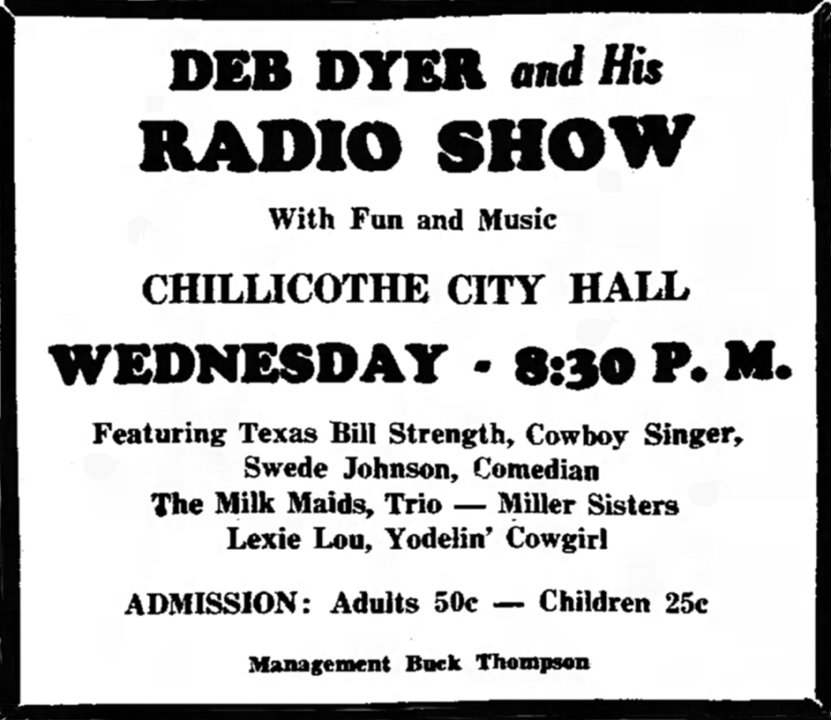
Chillicothe, Ohio, Constitution Tribune
The next day’s news reported that snow kept the crowd small, but manager Buck Thompson said that the troupe would return again.
1946

Photo courtesy Dale Strength
May 1946
The May 1946 issue of National Hillbilly News included a brief write-up about TBS by long-time Ernest Tubb Fan Club President, Norma Winton. At that time, TBS had just finished working at KFEQ in St. Joseph, Missouri. The note said that “His popularity was such over KFEQ that he was being sponsored over 17 other radio stations at that time.”
While working at station KFEQ that May, he traveled to KXEL in Waterloo, Iowa, to look for a job. Unfortunately the owner of KXEL was a brother of the owner of KFEQ, so KFEQ fired him.
MEETING ERNEST TUBB
Soon after he lost his KFEQ job in St. Joseph, he got the chance to meet his idol, Ernest Tubb, at a concert in Fort Dodge, Iowa. He hitchhiked 300 miles to the show, and was
elated and scared when Tubb put him on as an opening act before the 12,000-person crowd. “Ernest dressed me up in one of his suits – boots and hat and everything. It just fit me … that was my first big showdate.” (Ronnie Pugh)
Although not a permanent position, TBS sang for a while at KSOO in Sioux Falls, South Dakota. (Ronnie Pugh)
In the April/May 1946 issue of Melody Trails, Ernest Tubb Fan Club President Norma Winton reported that TBS had written 27 songs but hadn’t yet cut any records. She also reported that:
Texas Bill Strength is no longer at KSOO, Sioux Falls, but is now out in some might swell country – Denver, Colorado … At this writing, Bill isn’t on the air regularly, but is waiting for his Union transfer, and resting up a bit. (Ronnie Pugh)
July 1946
In her “Just Driftin'” column in the July 1946 issue of National Hillbilly News, Norma Winton noted that he was working in Colorado (KMYR in Denver) and making personal appearances throughout the area. In her “Radio Programs and Cowboys” column in the same issue, she mentioned that Texas Bill had presented her with a special recording of her favorite tune at the time, “Yesterday’s Tears,” along with several of his own compositions, including “Please Don’t Ever Forget Me” and “Louisiana Lou.” But he may have been longing for his Southern roots, as Norma noted that he was talking about the cold weather and how hard it was for a Southern boy to cope with it. While he may have complained about it, he was doing well at the time and Norma was envious that he was able to work there since she was a native of the state.
August 1946
On August 28, 1946, TBS turned 18 and filled out his Military Registration Card. He listed his address as Station D, Box 184, St. Joseph, MO, but noted his occupation as “Exemployed” – no doubt because of his misadventure with KFEQ. He described himself as 5’9″ tall, hazel eyes, brown hair, with a light brown complexion. His mother Jessie was given as his next of kin; her address was given as Magazine Street in New Orleans. Bill’s parents were listed in the New Orleans directory in 1946, as they were in 1945.
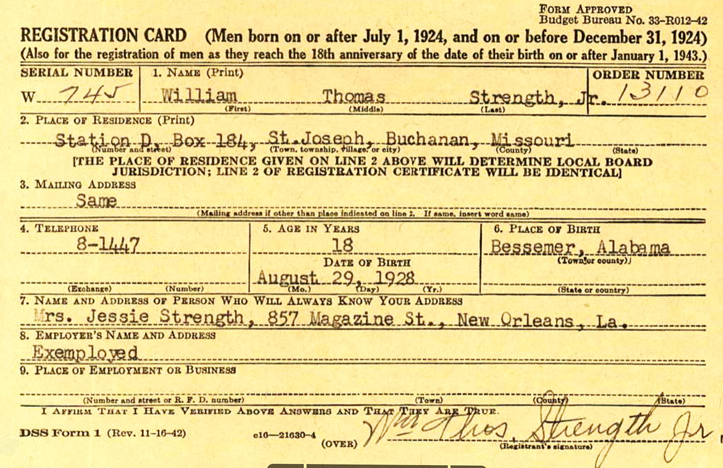
August 28, 1946. Image from Ancestry.com
MELODY TRAIL RIDERS
September 1946
In September and October 1946, TBS was the star of the new band, the “Melody Trail Riders.” That we all agree on. Three sources give slightly different versions of this story.
In the September 1946 issue of Melody Trails, Miss Norma Winton reported that TBS was working as the star of her new band, the “Melody Trails Riders,” in Fort Smith, Oklahoma. “You’ll be seeing and hearing a lot of Bill in the future.”
On October 3, 1946, the Sallisaw, Oklahoma, Democrat American reported that the band was managed by Miss Winton and led by TBS. It had recently entertained in the Roland High School Auditorium on Friday night, September 27, 1946. Members of the show included Jack and Audrey Manning, and Rusty Russell. Jack and Audrey were leaving for a radio job in Kansas City. “The rest of the gang and others will be around in your high school soon. Watch for them!”
October 1946
On October 12, 1946, Billboard again called TBS the leader of the “Melody Trail Riders,” as well as the emcee and the manager. The live program was described as a “new show that is proving popular with Fort Smith and Eastern Oklahoma folk song lovers.”
At present show consists of five pieces, and plans have been made to increase the number soon. In addition to Jack and Audrey and Rusty Russell, the list of performers cited by Billboard included Jackie Jackson and the Larson Sisters.
By the end of 1946, Bill’s career had taken him to Memphis, Tennessee, based on a letter to the editors of National Hillbilly News that listed his PO Box as being in Memphis.
November 1946
TBS, playing the Rainbow Gardens, Memphis, is heard over WHHM. (Billboard, November 16, 1946)
National Hillbilly News columnist Norma Winton reported that in the early days, Texas Bill was also writing tunes such as “There’s Always Two to Blame,” “I’m Lonely Since You’ve Gone,” and “You’ve Left Me Behind.”
In the latter part of 1946, Floy Case reported in her column that TBS had a six-piece western band and was making personal appearance in Missouri and Kansas. She noted that Bill was “…doing all right for himself in this hillbilly biz.” She also mentioned that he had written two new tunes, “The Rose of My Heart” and “Who’s Gonna Love Me Now.”
December 1946
In an article in the December 1946 issue of the Mountain Broadcast and Prairie Recorder, Floy Case told readers that Bill was the “singing emcee of Norma Winton’s band the “Melody Trail Riders.” Case described TBS as “…a young fellow who seems to be going places in a hurry.” Bill and the group were playing dates in the eastern Oklahoma and western Arkansas areas.
At some point before he met his first wife, TBS had a daughter by another woman.
1947
January 1947
Arlie Kinkade’s column, “This, That ‘n the Other” reported that he was working at WHHM in Memphis. (National Hillbilly News, January 1947)
Also in January 1947, Floy Case wrote that Bill was one fellow that “…gets around,” going from Texas to South Dakota and Colorado. She mentioned that he had been working as part of Norma Winton’s band, the Melody Trail Riders, out of Ft. Smith, Arkansas, but had since formed his own band, the “Ranch Ramblers,” and was working regularly at the Rainbow Gardens in Memphis. She, like many of the columnists back then who also dabbled in songwriting, then mentioned that Bill had been plugging a song she had written with Jimmie Davis, “I’m Beginning to Forget You,” that had also been recorded by Ernest Tubb.
A 1952 article mentioned that in 1947, Bill toured with several large road shows then and did stints at KMYR in Denver, KSOO in Sioux Falls, KMA in Shenandoah, Iowa and KRLD in Dallas.
BACK TO HOUSTON
July 1947
Although he is not named on the radio listings until 1948, it could very well be that he was anchoring the “Ranch Hand” program on KATL, as early as July 28, 1947. He is identified as “Ranch Hand” in the 1948 ads below.
December 1947
A 1951 article in Cowboy Songs magazine said that Bill had gone back to Houston in 1947. Evidence of this is in an article in the Houston Chronicle dated December 11, 1947, where he is named as a participant in a floor show at the Plantation. The show was a benefit to buy a jeep for “crippled children.” He is identified as “Bill Strength, radio singer.”
1948
A 1948 Houston directory listed Bill’s address as 504 Aurora. This was the home of his wife Dorothy’s parents. His occupation was given as KATL.
1948 was a busy one in Houston, where he worked at three different radio stations
January 1948
Foremost Dairies offered TBS a 15-month contract to do a morning show called “Ranch Roundup” on a new 5,000 watt station, KLEE. KLEE, located in the Milby Building, went on the air on January 31, 1948, and TBS could have been included in what the Houston Chronicle called “Hillbilly Program.” He was listed under his own name from April 16 to July 31, 1948.
May 1948
In May he had an evening disc jockey program over radio station KATL.This show was 15 minutes long. (Ronnie Pugh reported that this show was called “Texas Music for Texans,” but local radio listings show it under his name. A show by that name only appears in a search for a few months in 1949.) This unusual arrangement seems to have lasted only during his tenure at KATL, which appears to be May 11 to July 31, 1948.
Ronnie Pugh also says that he sang on a third Houston station, KNUZ. This could not be confirmed by radio listings, but the show may not have been under his name.
Ronnie Pugh describes the radio shows:
Each show was heavy on cowboy songs, as those titles and one ad makes clear: “Gather round all you good neighbors who like your western songs with that true Texas flavor! Just relax and let Texas Bill throw those ropin’ rhythms your way. They’re guaranteed to please ya plenty podner.
He performed at night clubs.
He guested on a new barn dance show, “The Houston Hoedown Club.”
He immersed himself with personal appearances in the Houston area.
These personal appearances in 1948 identified him as the “F and M Ranch Hand.”
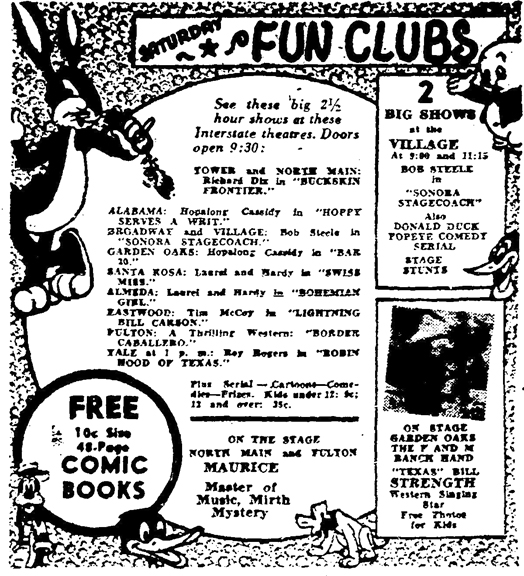
Houston Chronicle
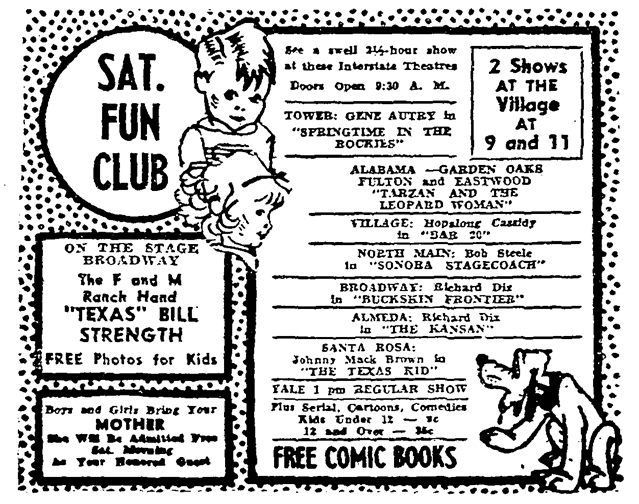
Houston Chronicle, May 7, 1948
WIBB
This is a shot in the dark, but an article on the history of station WIBB in Macon, Georgia, states that it went on the air on November 18, 1948. Although it was just a daytimer with two stations as competition, the article states:
But slowly, through the appeal of such personalities as Johnny “The Bullfrog” Hamrick, “Texas” Bill Strength, and Jimmie Layfield, who played his Hammond electric organ over the airwaves Sundays through Thursdays, the station carved out a respectable following by catering to a wide audience. (The Macon Telegraph, May 31, 1998).
Other than WIBB being one of the stations that carried his CIO program (see January 1950), there is nothing in his previous biographies that indicate that Bill ever worked in Macon, but apparently he did in 1948/1949, at least for a little while. Bill wasn’t known for staying in one place for very long in these early days.
1949
CIRECO RECORDS
Bill’s first recordings were apparently made in Houston on Cireco Records. Seven sides were cut at the session. It appears that Bill played on all of the sessions; the lead singers were both Texas Bill and Jerry Irby.
Two 10 inch records were released:
Cireco 101, with both sides credited to Jerry Irby and his Texas Ranchers:
- “You Can’t Take it With You”
- “Almost Every Time”
Cireco 102:
Side A: “49 Women” by Jerry Irby and his Texas Ranchers
Side B: “Little I and Big You,” by TBS and his Saddle Ranchers
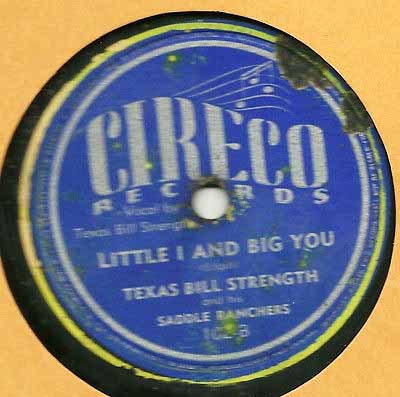
The other songs TBS and Irby recorded at Cireco in 1949, but were not released were:
- “Cowboy’s Sweetheart”
- “El Rancho Grande”
- “Buttons and Bows”
Frank’s notation indicates that the lineup for this session was:
Jerry Irby and His Texas Ranchers [Gerald F. “Jerry” Irby] vocal, first rhythm guitar
*Texas Bill Strength aka David Grey and His Texas Ranchers [William Thomas “Texas Bill” Strength] vocal, second guitar
Unknown lead guitar
Possibly Ernest “Deacon Evans, steel
Peter ?, bass
? drums
Anthony “Tony” Sepolio, fiddle
Pete Burke, piano
[vcl-2/gt], ? [ld gt], poss. Ernest “Deacon” Evans [steel], Peter ? [bass], ? [drums-7], Anthony “Tony” Sepolio [fiddle],“Pete” Burke [pno-6])
How David Grey fits into this picture is anyone’s guess, unless that’s Jerry Irby’s real name.
February 1949
DOROTHY ALTMAN
On February 23, 1949, Texas Bill married Dorothy “Dottie” Altman in Houston. Dorothy was the seventh child of Joseph V. and Pearl Nona Altman.
Joseph Altman was born in Czechoslovakia on March 28, 1891 and came to the U.S. in 1910. By at least 1930 he lived in Houston, where he died in 1980.
Joseph’s wife Pearl was the daughter of John Nona, who was born in either Poland (or Germany,) depending on the year of the Census. Her mother Martha was also of Polish/German descent and was born in Texas or California, Pearl variously reported. Pearl was born in Chapel Hill, Texas on August 7, 1889. The 1900 Census indicates that her birth name may have been Peladio. In 1920 she lived in Austin on a farm with her brother Adam. Pearl died on March 26, 1952, at the age of 62. Her residence was the family home at 504 Aurora Street in Houston.
Joseph and Pearl’s children were:
- Albina “Bina” Krusleski (born in 1913)
- Wallace (1922)
- Josephine E (1925) Married Edward Ludwig
- Paul A. (1923)
- Helen Mary (July 28, 1927)
- Lillie Frances (July 1929) Married Alan Hannuksela
- Dorothy L (born on January 6, 1931)
In a taped interview with her son Dale, Dorothy provided a great deal of information about how she and TBS met. At the time, Bill’s parents were living in New Orleans and Bill was living in Houston.
Dorothy met Bill after the Joy Theater talent contest, while he was playing at a nightclub in Houston. The club was owned by a friend of the Altman family. She may have been 16-17 yrs old. Four of the five Altman sisters (without Bina) would go to the theater to see the regular Sunday afternoon jam sessions, which he hosted, and they met there. At one point she went up to the table where TBS was sitting with a couple of other players with him that worked for the club. She “said hi and what not,” and sat down and started to get to know each other. She said that because a family friend owned the place “Big Momma” (Pearl Altman) trusted her little underaged kids there. The girls continued to come into the club on Sunday afternoon for a few weeks. He was playing for the “kitty.” After she got to know him better she would pass the hat around for him.
She continued that it was just natural that he would go to their house and meet their Mother. It was Bill’s idea – he didn’t have any family in town and they brought him home to have dinner with the family. Big Momma fell in love with him immediately. She used to “box his ears good” when he misbehaved. Dorothy said Pearl gave him the discipline he didn’t get at home. At various times, two other Strength boys, Charlie and Pete, would also stay with the Altmans, which didn’t set well with their mother Jessie, who thought Pearl was trying to take her boys away from her.
Bill and Dorothy were married by the clerk of the Harris County court. The ceremony was solemnized on March 13, 1949, by Rev. L.R. Pearson, Pastor of the North Main Baptist Church.
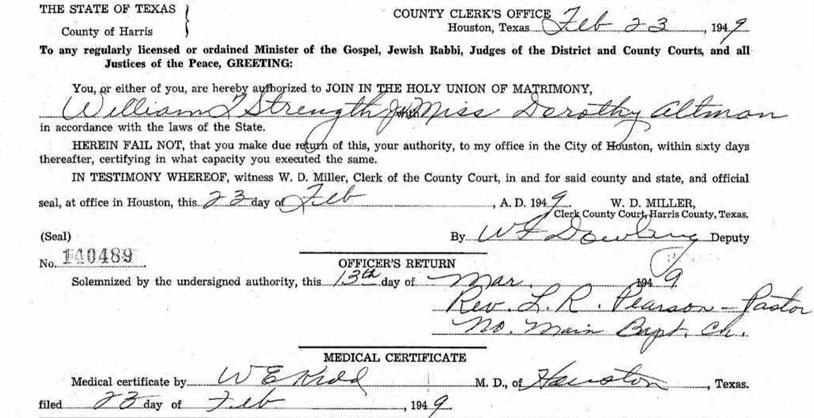
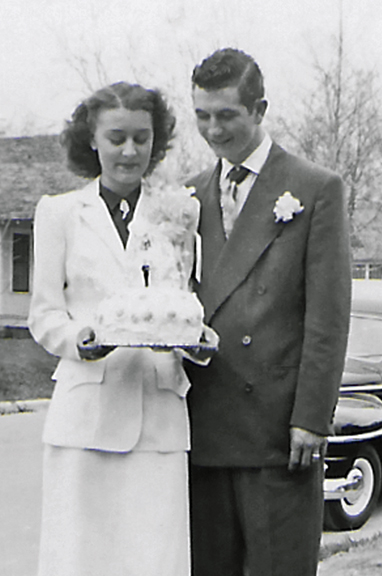
Dorothy and Bill at their wedding reception, Aurora Street, Houston. Photo courtesy Dale Strength
May 1949
4-STAR RECORDS
By May 1949, TBS had signed with 4-Star Records.
In May 1949 he recorded two sides:
- “If I Could Buy Your Love”
- “Please Don’t Ever Forget Me”
The record was released in December 1949, as TBS and His Saddlepals. It was issued as either 4-Star 1334 and/or 3176.
Billboard reviewed it on December 17, 1949:
“If I Could Buy Your Love,” Western string ork [orchestra] setting and a straightforward but not especially strong vocal on a likely pop-Western piece.
“Please Don’t Ever Forget Me,” Tune is machine-stamped out of a familiar die, with nothing special of its own. Rendition is plodding.
July 1949
Biff Collie, the “Bellerin’ Bowlegged Boy, who whirls wax at KNUZ, Houston, reports that rustic music is going great guns in his town. Collie, who does five hours of DJ’ing for folk music daily, is working closely with the Hoedown Club, local bistro which features such local and territory names as:
- Floyd Tillman (Columbia)
- Leon Payne (Capitol and Bullet)
- Ben Christian (4Star)
- Benny Louders
- Texas Bill Strength (4 Star)
On Thursday nights, the “Houston Hoedown Dance” brings together all the local bands, with over 1,000 dancers attending.
(Billboard, July 30, 1949)
September 1949
BIRMINGHAM
TBS and Dorothy moved to Birmingham, Alabama, in September 1949, where he did daily radio programs at WRBC, which was part of a network of 37 stations throughout Alabama.
GREENVILLE, ALABAMA
October 1949
By October 1949 they had moved to Greenville, Alabama. Greenville is located in south Alabama, just 122 miles from the ocean. The small town had 6,731 residents in 1950, and not many more today.
Texas Bill worked for WGYV, on the Alabama Broadcasting System for four months. The station had started up in August 1948.
On October 31, 1949, Ernest Dale Strength was born at the Speir Hospital in Greenville, Alabama. Dale was named after his father’s hero/mentor/friend, Ernest Dale Tubb. The family lived on Conecuh Street, which runs through the town.
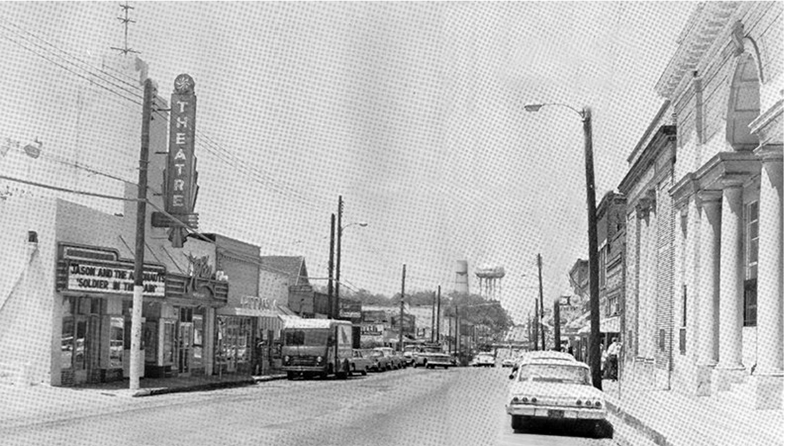
Downtown Greenville, from the City’s website
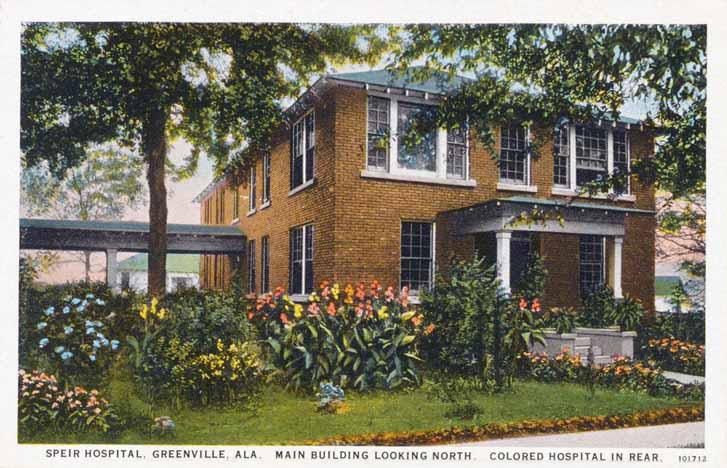
Postcard of Speir Hospital courtesy of the Butler County Historical & Genealogical Society
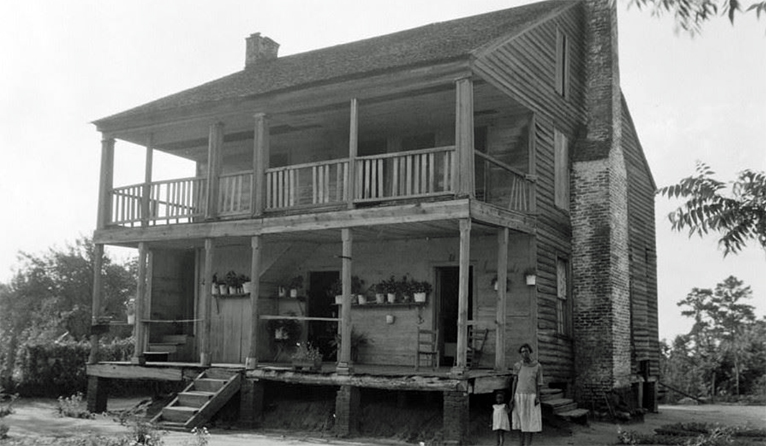
Another part of Greenville’s history, from the City’s website.
November 1949
The caption for the photo below reads:
“TEXAS” BILL STRENGTH,” now with WGYV, Greenville, is heard every morning at 5:30 and is master of ceremonies at the Saturday Night Jamboree. Bill also has several shows during the week. He is the author of several popular songs, including “Louisiana Lou,” “Please Don’t Ever Forget Me,” “Rose of My Heart,” “Im Still Lonely for You.” He started in radio in 1945 at KTHT, Houston, Texas, by winning an amateur contest, and has since been with 19 radio stations and has played with such famous names as Tex Ritter and Bob Nolan, Sons of the Pioneers. Bill has also recorded for Cireco Records. He is already a favorite with local radio fans.
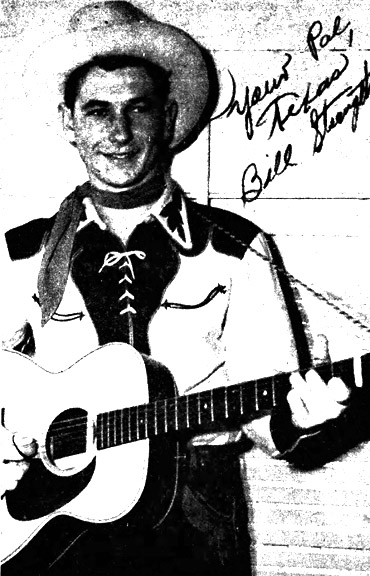
Greenville Advocate, Greenville, Alabama. November 10, 1949
4-STAR RECORDS
In November 1949, TBS and His Saddlepals recorded two sides for 4-Star Records (1403) in Houston:
- “Actions Speak Louder Than Words”
- “Mr. Moon Sailing High”
There is no information of a release date and they do not seem to have been reviewed in Billboard.
December 1949
TBS (4 Star) is doing a DJ shot over at WGYV, Greenville, Alabama. His show includes:
- The Greenville Bucheroos (sic)
- Andy Williams (apparently a Country Andy Williams)
- The Midnight Ramblers
- The Camellia City Ramblers
- Cousin Wilbur
- Charley and Honey Lou
(Billboard: December 17, 1949)
It was later clarified that Andy Williams was a separate act on WGYV and not part of Bill Strength’s show. (Billboard, January 21, 1950)
TBS is personally managed by Rudy Clark, Birmingham. (Billboard, December 24, 1949)
BACK TO HOUSTON
In his “Southwestern Round-Up” column for National Hillbilly News, Tex Moon wrote that in late 1949, Bill once again moved back to Houston.
He was supposedly one of the mainstays at a new venue in Houston where it was said, “The Best Bands of All Come to Hillbilly Hall.” Other performers at the venue included Floyd Tillman, Hank Lockwood, Leon Payne, Benny Leaders, Pete Hunter, the Texas Cowboys, and Woody Carter.
1950
January 1950
THE CIO
TBS took a job with the CIO on January 17, 1950. The first 15-minute program hit southern stations on Sunday, January 22, 1950. At first the program had no title, but later gained the name “American Folk Songs Featuring Texas Bill Strength.” (Ronnie Pugh)
The Congress of Industrial Organizations (CIO) was a federation of unions that organized workers in industrial unions in the United States and Canada from 1935 to 1955. TBS’s affiliation with the CIO was mentioned in a long column by Victor Riesel, which was syndicated in several newspapers simultaneously. It read:
To push its southern organizing campaign, the CIO will put “Texas” Bill Strength, popular disc-jockey and folksinger, on the air to send his ballads across a six-state network, covering Georgia, Alabama, South Carolina, North Carolina, Tennessee, Virginia, and parts of Texas. Between the ballads will be George Baldanzi, CIO southern chief, with speeches.
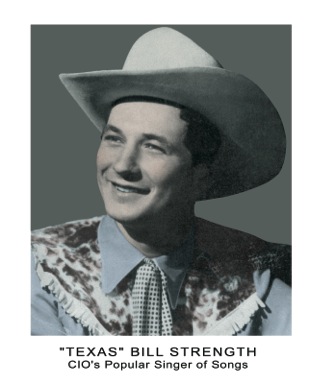
Emanating from WGST, Atlanta, TBS made radio transcriptions with Baldanzi, which were aired over 126 stations. At that time, the CIO had over 6.5 million members, so Texas Bill and his record label, 4-Star Records, took advantage of that and created a slogan for Bill,” …the Boy with 6 and a half million sponsors.”
The 1951 Cowboy Songs article notes that Bill was such a hit with his CIO job that he logged over 57,000 miles: traveling on tours, personal appearances, visiting those in hospitals and institutions, and attending union meetings and conventions for the CIO. Impressively, it was said that he entertained upwards of a quarter million people at each of those conventions. Like many artists, Bill shared the stage with many of the mainstays of country music in that era. But Bill also got to entertain some well-known political figures of the era due to his work with the CIO, including Vice President Alben Barkley, Senator Hubert H. Humphrey, Congressman Christopher of Missouri, and Secretary of Labor Maurice Tobin. See April 1950 for photos of Texas Bill with Senator Humphrey.
Some of the more well-known venues he appeared at were the Palmer House in Chicago; the “world’s largest auditorium” in Atlantic City, New Jersey; the Hotel Utah in Salt Lake City; the National Training School for Boys in Washington, DC; and the Hudson Manor in Tampa.
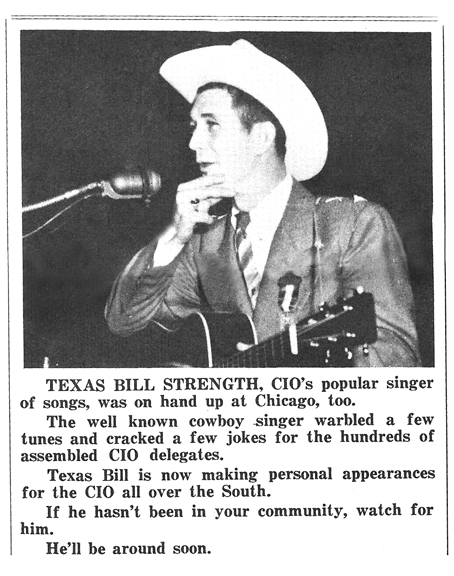
Image courtesy Dale Strength
He also appeared on KWKH’s Louisiana Hayride in Shreveport, and by 1951 he had appeared five times on WSM’s Grand Ole Opry with his friend Ernest Tubb.
None of the articles or ads found implied that TBS did anything but sing and/or entertain at meetings and conventions. The last mention of any CIO actions found was on February 7, 1953.
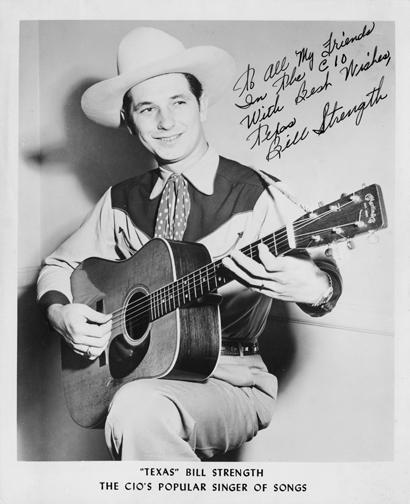
CIO Publicity Photo. Courtesy Georgia State University Library
The ad below appeared in several Southern newspapers on January 20, 1950. An article in the Kingsport, Tenn., Times stated that the programs began on Sunday, January 22, 1950, and were heard from 1 pm to 2 pm. Presumably the programs were only heard on Sundays and not for the entire hour.
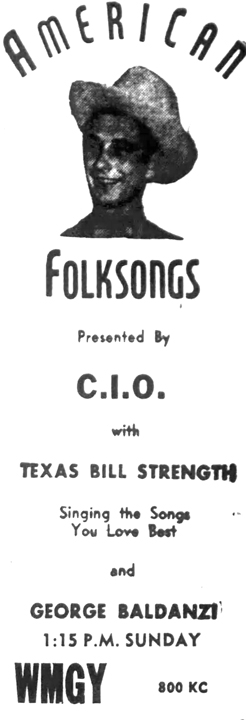
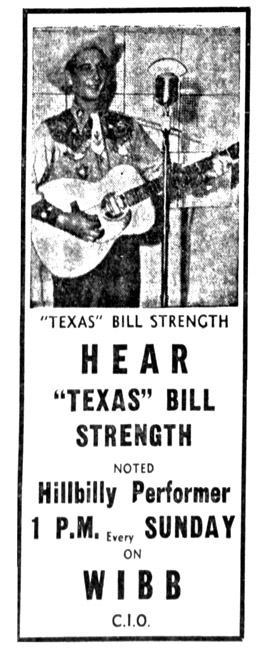
Macon, Georgia, Telegraph. Saturday, January 21, 1950
March 1950
March 11, 1950, Billboard:
The CIO is using hillbilly music as its major format in a new transcribed radio series thru the South. Since January 22 the CIO has been piping the 15-minute weekly show Sunday afternoons to a network of stations that started with 29 outlets and now is carried commercially by 90 outlets in seven Southern States from South Carolina to Virginia. Emanating from WGST, Atlanta, the program features TBS, 4-Star recording artist. In between songs by Strength, George Baldanzi, organizing committee director and executive v.p. of the Textile Workers’ Union, discusses problems involving the Southern worker. In addition to his e.t. shows, Strength is on the CIO payroll to make appearances at all major meetings and conventions held by the CIO in the seven Southern State territory.
April 1950
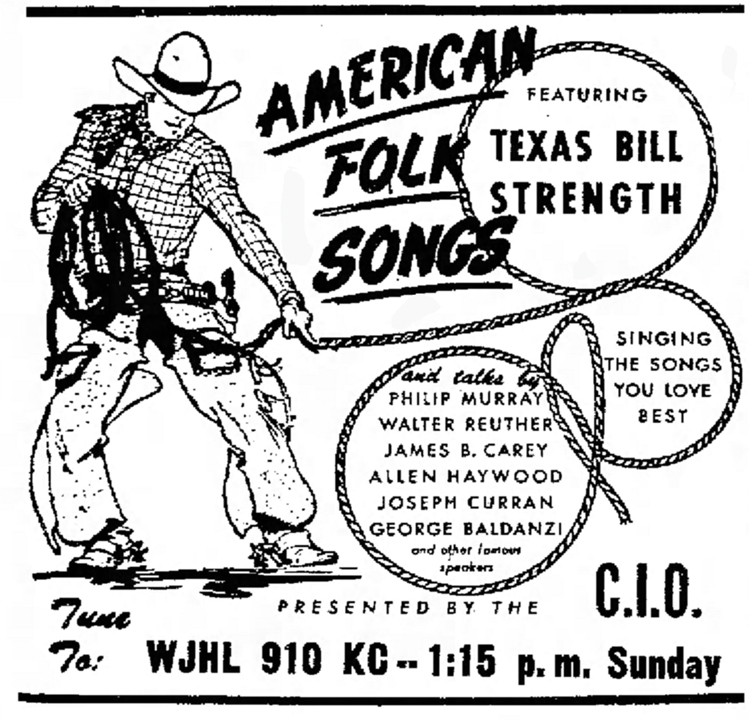
Ad placed in Kingsport, Tenn., in April 1950 and Gastonia, NC in June 1950
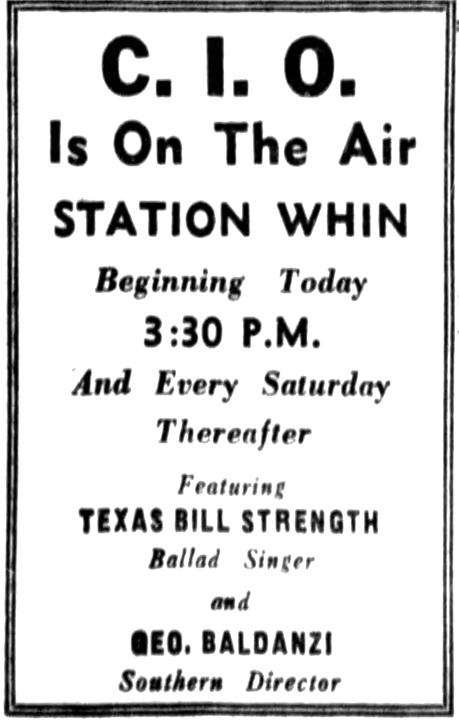
Nashville Tennessean, Saturday, April 8, 1950
The shows were geared toward the Southern states of Virginia, Tennessee, Georgia, North and South Carolina, and Alabama, but were seen on radio logs in Texas as well. By 1951 they were heard on 126 stations.
Initially the target audience for these broadcasts were textile workers that the CIO sought to unionize. We see by the ad below that he was making personal appearances in 1950, sponsored by the Textile Workers Union of America, CIO.

Fort Payne Journal, Fort Payne, Alabama. Wednesday, April 16, 1950
In April 1952 the base of operations was moved from Atlanta to Decatur, Georgia, where his target audience became the employees of Lockheed.
4-STAR RECORDS
In April 1950, TBS and his Saddlepals had a recording session for 4-Star Records in Houston:
- “Black Coffee Blues”
- “Who’s the Lucky Guy”
Both songs were written by TBS. Billboard reported that the record (1465) was released on June 3, 1950.
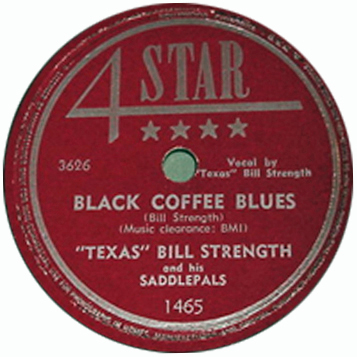
THE 1950 CENSUS
The 1950 Census, which was taken on April 3, 1950, reveals that Texas Bill’s family lived at Apartment 1, 1633 Euclid Ave., Atlanta. Today there is a Euclid Ave. NE (there is no SE), but the addresses end at 1414, when Euclid meets Oakdale, so the building may have been removed or the roads changed.
His “Occupation Category” was checked as “Unable to Work,” perhaps because there was no category for a “Professional singer Labor Organization,” which was written in under Occupation. Under Income, he reported that in 1949, he made no money as someone else’s employee, but made $2,340 as his own business. “Relative Income” – the income of someone else in the household in 1949 – was $252.
MEETING WITH SENATOR HUMPHREY
On April 18, 1950, Minnesota Senator Hubert Humphrey came to make a speech in Richmond, Virginia. The original plan was for Humphrey to debate Virginia Senator Byrd, but arrangements could not be made for Byrd’s appearance, so Humphrey made a speech on “Which Way, America?” The event was sponsored by the Virginia Commonwealth League (an anti-Byrd organization), and took place at someplace called “The Mosque.” (Richmond News Leader, April 18, 1950)
The caption on the photo below reads:
MUSIC BEFORE ORATORY – Enjoying a bit of rhythm before his speech here last night is Senator Hubert Humphrey (second from left), with David G. George and James P. Hart (right), Virginia Commonwealth League officials. Guitar player is “Texas Bill” Strength.”
Richmond Times Dispatch, Wednesday, April 19, 1950
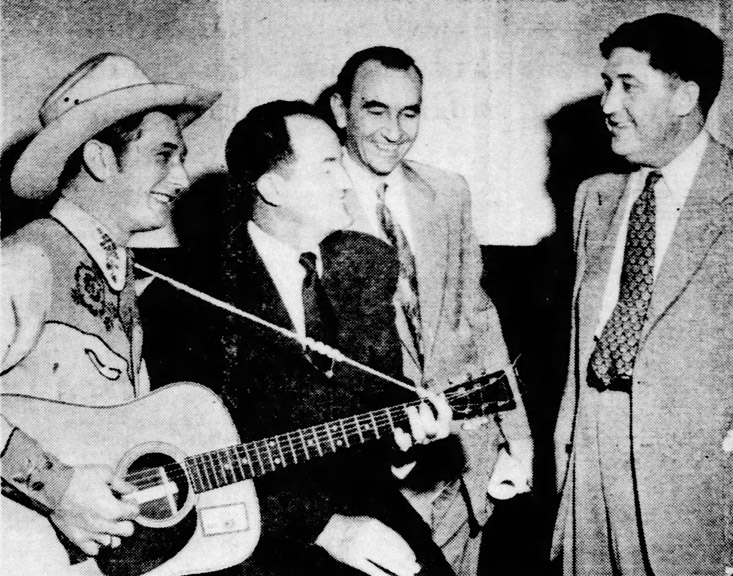
Richmond Times Dispatch, Wednesday, April 19, 1950
The photo below, heretofore undated, can now be dated April 18, 1950. Is the Senator playing Bill’s guitar?
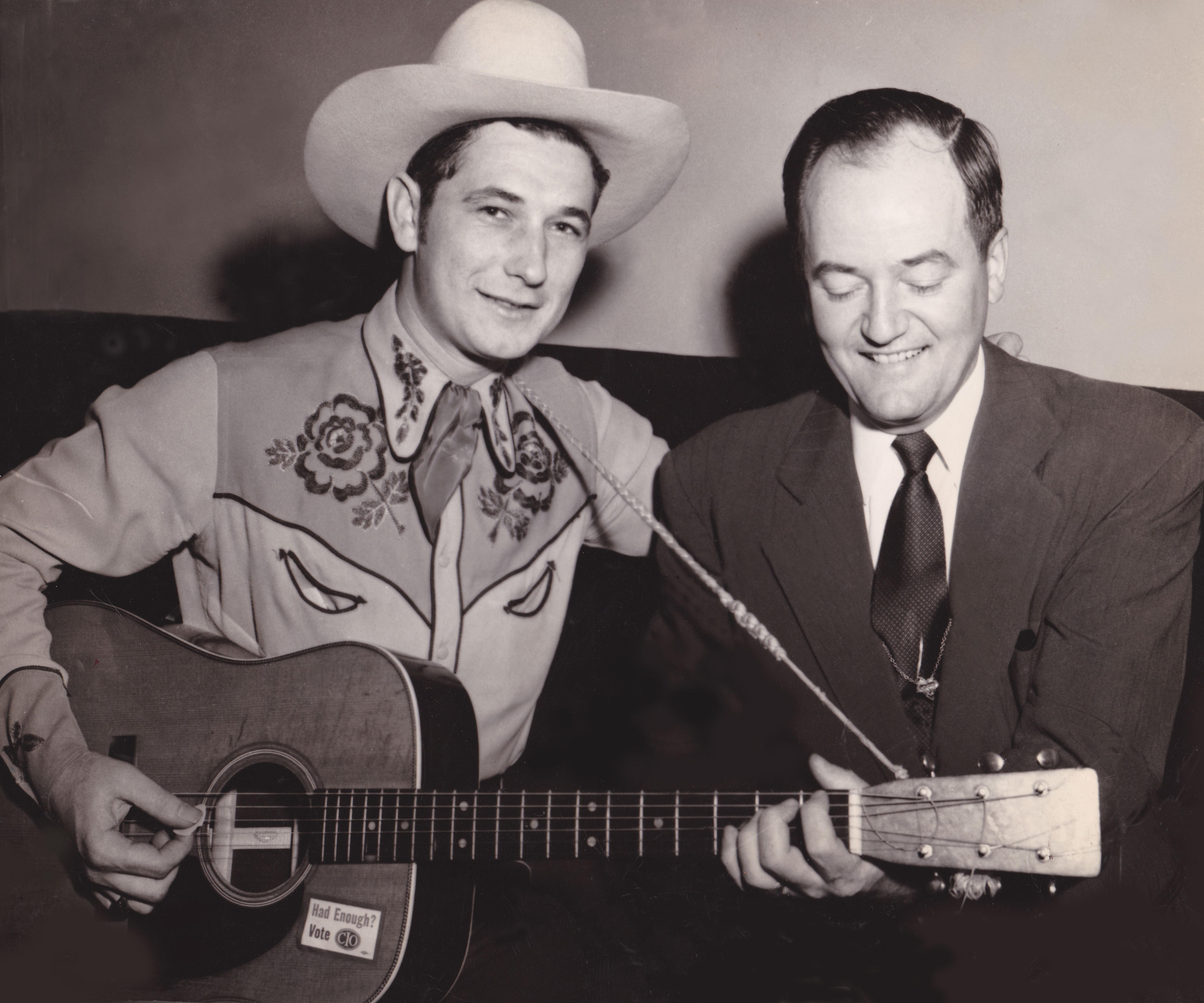
TBS with Hubert Humphrey. Photo courtesy Dale Strength
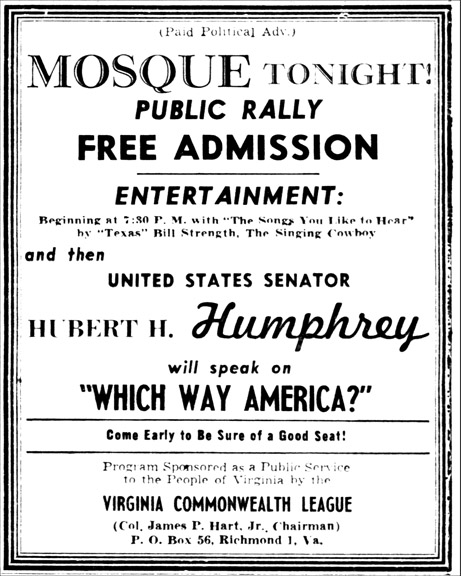
Richmond Times Dispatch, Tuesday, April 18, 1950
May 1950
WE WILL OVERCOME
The CIO’s theme song was “We Will Overcome,” the same song used by the Civil Rights movement ten years later. Records show that TBS and His Saddle Pals recorded it at 4-Star Records (OP-102) in May 1950. The flip side was “Shall We Gather at the River.” No release date is known.
Another 4-Star release, this time with Number 45-1499, is shown to be recorded in July 1950, also with his Saddle Pals. The flip side was again “Shall We Gather at the River” and no release date is known.
In 1952, the record appears on a CIO label with the number OP-102. TBS is listed as the Producer. According to RP, it was only distributed to union members.
In 1952, 4-Star reissued its 102 as X-36. A recording date of January 1952 is given, but that may be the reissue date, as TBS was no longer recording for 4-Star in 1952.
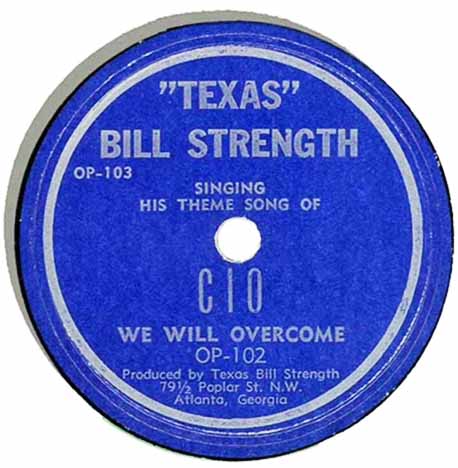
September 1950
4-STAR
In September 1950 TBS and His Saddlepals recorded four sides for 4-Star Records in Houston.
The first record was numbered 45-1532; no release date is known, and no Billboard review was found.
- “I’m Doing a Peach of a Job”
- “It Could be a Wonderful World”
The second record was 45-1554 and was released in March 1951, as evidenced by an ad in Billboard placed by 4-Star Records on March 17, 1951. No review was found. It appears to be the last 4-Star release.
- “Frown on the Face of the Moon”
- “I’m Walking in Heaven”
The record below was pressed for disc jockeys and comes with a commercial!
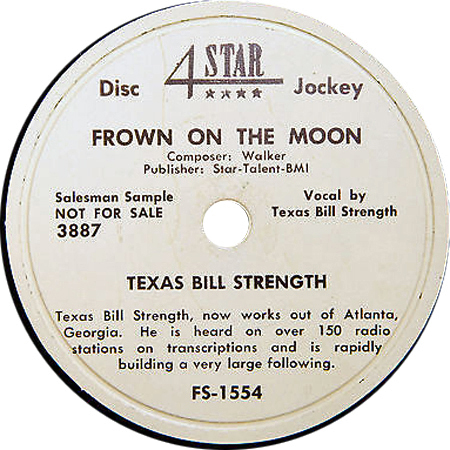
On September 22, 1950, TBS – billed as star of radio, stage and television – appeared at the Rebel Retreat in a program sponsored by the Bristol Optimist Club. Bristol, Virginia, and Bristol, Tennessee were across the state line from each other. Proceeds from the show were earmarked for the club’s general welfare fund. Bill was accompanied by a local band. (Bristol, Virginia Tennessean, Friday, September 22, 1950)
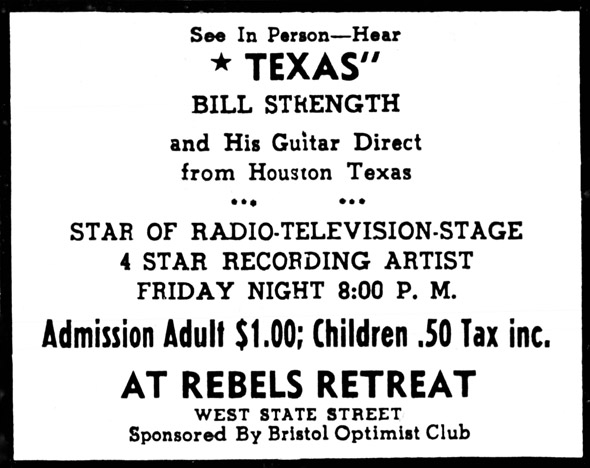
Bristol Herald Courier, Bristol, Tennessee. Friday, September 22, 1950
On September 23, 1950, according to the article above, TBS was to be a guest star on the Grand Ole Opry.
October 1950
On October 11, 1950, TBS performed three shows at the CIO Hall in Kingsport, Tennessee, for the benefit of Holliston Mills employees and their families. The shows were at 1, 3:30, and 7:30, and were sponsored by the CIO organizing committee. (Kingsport News, Tennessee, Wednesday, October 11, 1950)
November 1950
In his column “Lowdown on Hoedown,” Verlin Mays wrote that TBS was
enjoying a brief vacation after his recent tour through Bristol and surrounding towns in Southwest Virginia and East Tennessee. According to a letter I received from Bill, he’ll really start to work in earnest in a few more days. I’d like to wish him a lot of luck because he certainly is a fine boy and a wonderful entertainer.
Bristol Virginia Tennessean, November 10, 1950
December 1950
TBS (4-Star), who has been working labor meetings for the CIO during the past 14 months, was featured singer at the CIO’s national convention in Chicago at the Hotel Stevens two weeks ago. The labor org intends to cut a six-disk album shortly of labor songs by Strength. (Billboard, December 15, 1950)
TBS, “the well known Southern radio and recording star,” was scheduled to make a personal appearance at a “Let’s Get Acquainted” Square Dance sponsored by Local 273, United Furniture Workers of America, CIO (Williams Furniture) on December 4, 1950, at Dave’s Place in Sumter, South Carolina. (Sumter Daily Item, Saturday, December 2, 1950)
TBS with Hank and Audrey Williams in Shreveport, 1950.
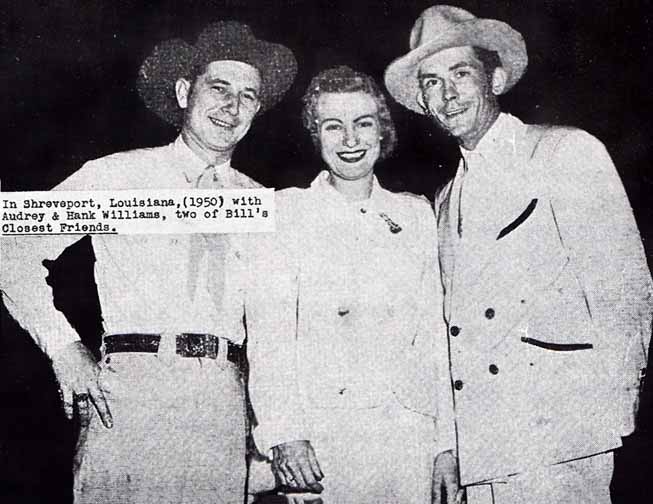
Photo courtesy Jan Sherman, via Derik Olson
1951
The 1951 Atlanta directory listed TBS’s occupation as “vocalist CIO,” living at 124 Jewel.
January 1951
TBS entertained at a two-day CIO convention in Tampa on January 13-14, 1951. (The Tampa Tribune, January 12, 1951)
February 1951
On February 1, 1951, TBS was in Birmingham, Alabama, for a series of CIO meetings. He was pictured in the Birmingham Post-Herald on February 2 visiting the “Crippled Children’s Clinic,” “which is his custom in each city he visits.”
TBS entertained at a meeting of the United Steelworkers of America from Utah and Nevada, which took place in Midvale, Utah, on February 4, 1951. (The Park Record, Park City Utah, February 1, 1951)
April 1951
Robert Wayne Strength, TBS and Dorothy’s second child, was born in Atlanta on April 13, 1951.
In 1951 TBS made several appearances over WAGA-TV in Atlanta while still working for the CIO.
October 1951
The photos below were taken at a conference of the United Steelworkers of America, District 35, Local 309, in Alcoa, Tennessee, on October 6, 1951. The man in the second photo is W.H. Crawford. At the time, Crawford was the Director of the United Steelworkers of America.
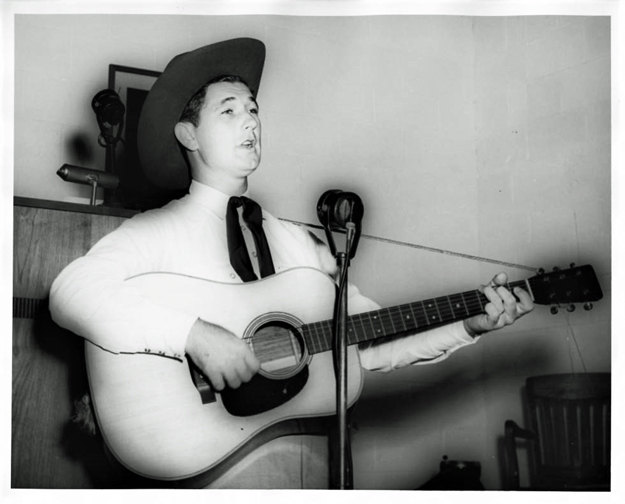
Photo Courtesy Georgia State University Library
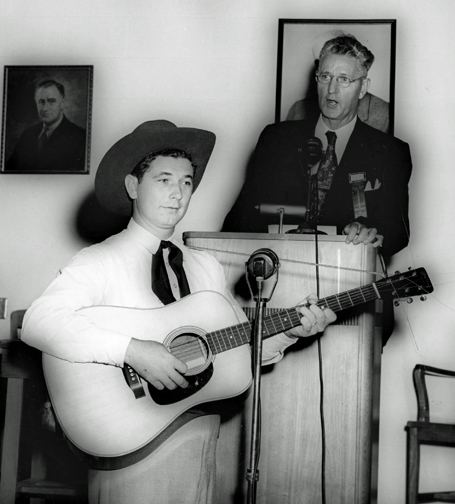
Photo Courtesy Georgia State University Library
November 1951
CORAL RECORDS
In November 1951, TBS signed a three-year contract with Coral Records, a subsidiary of Decca. His friend Ernest Tubb was instrumental in securing the deal, which was beneficial to Tubb as well, since it meant extra work for some of Tubb’s Texas Troubadours. Plus, TBS was under contract for a time to Ernest Tubb Music for his publishing. (Ronnie Pugh)
Billboard explained that Owen Bradley was hired to head up the recording operation of Coral Records, and nine new country artists were added to the roster, including TBS “of Atlanta.” (February 9, 1952)
On November 26, 1951, he had his first Coral session, cutting four sides at the Tulane Hotel in Nashville:
- “Is Someone Else the Lucky One Tonight,” written by TBS
- “Cherry Pie”
- Paper Boy Boogie” was originally written and released by country singer Tommy Trent on Checker Records. TBS added his own flair and covered it shortly afterwards.
- “I Was Only Teasing You,” written by TBS
Coral 64117 was issued as a 78 rpm record. No release date or Billboard review were found.
- “Is Someone Else the Lucky One Tonight,” written by TBS
- “Cherry Pie”
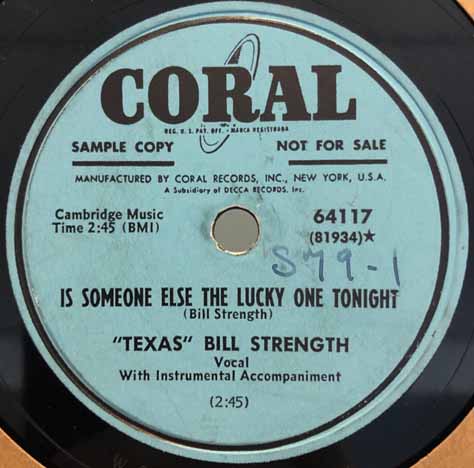
Coral 64133 was issued in June 1952 and Billboard reviewed it on June 14, 1952:
“Paper Boy Boogie:” “Material in this one is very strong with a good boogie beat. Fine instrumentation includes a standout honky tonk piano. Vocal by Bill Strength adds to the attractiveness of side. Should pull coin.” (Ronnie Pugh says Chet Atkins played guitar on this record.)
“I Was Only Teasing You:” “Tune is a switch on the normal weeper. Texas Bill warbles it in pleasant style with a fine assist from the sidemen.”
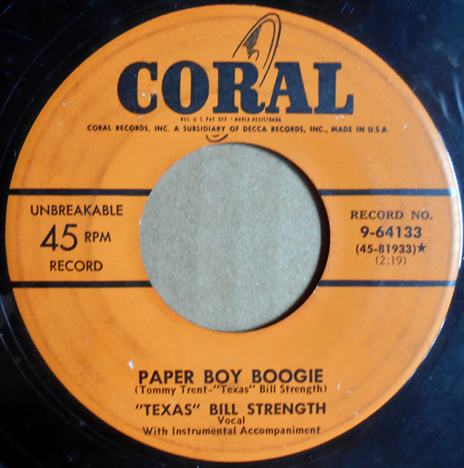
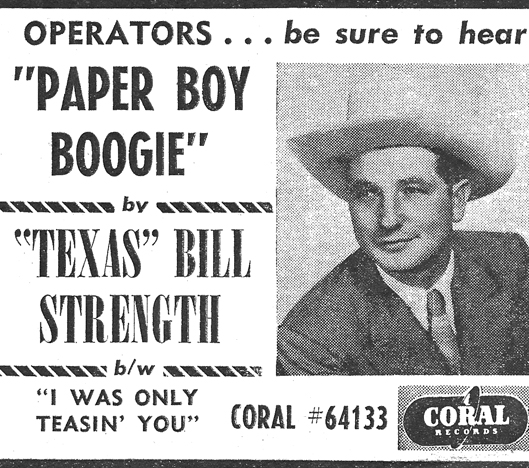
Ad courtesy Dale Strength
At some point in 1951, TBS entertained a North Carolina textile organizing meeting. Now, this photo may just be 2/3 of Bill from the back, but the message it imparts lies in the smiles and laughter on the faces of the men and women in his audience.
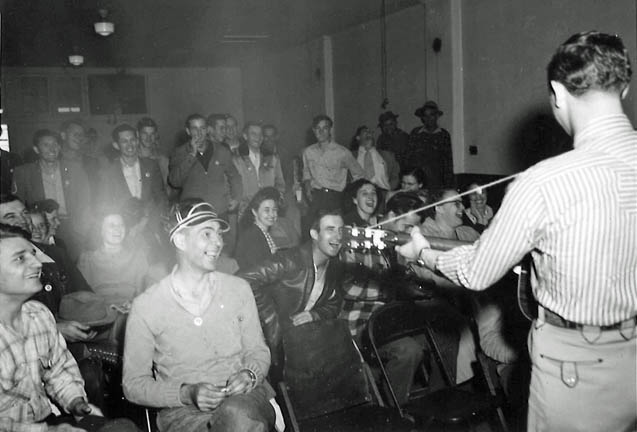
Photo courtesy of the George Meany Labor Archive at the University of Maryland, College Park
1952
February 1952
TBS, new Coral addition, is now working regularly at WAIM, Anderson, SC, and plans to book more talent into his region. He is contemplating using Ernest Tubb soon. (Billboard, February 23, 1952)
April 1952
TBS (Coral) is still working out of the Atlanta office of the CIO, doing songs at labor gatherings. (Billboard, April 5, 1952)
WEAS, DECATUR
On April 6, 1952, TBS moved his base from WGST in Atlanta to WEAS in Decatur, just 5 miles northeast of downtown Atlanta. No longer just on Sundays, a June 1954 article mentioned that his show was from 11:00am to 12:45pm daily. Still working for the CIO, his target audience consisted of the employees of Lockheed. He had a manager, John V. Riffe of Atlanta. (Ronnie Pugh)
This half-hour show gave out special prizes and launched the “Texas Bill Talent Hunt.” “Anyone who can sing, whistle or play ‘Chopsticks’ on a musical instrument and wants to appear with Bill on the radio should contact the CIO office.” (Ronnie Pugh)
Bill would spend over two years at WEAS, and became a fixture in the Atlanta area. He was known as “The Singing Disc Jockey.”
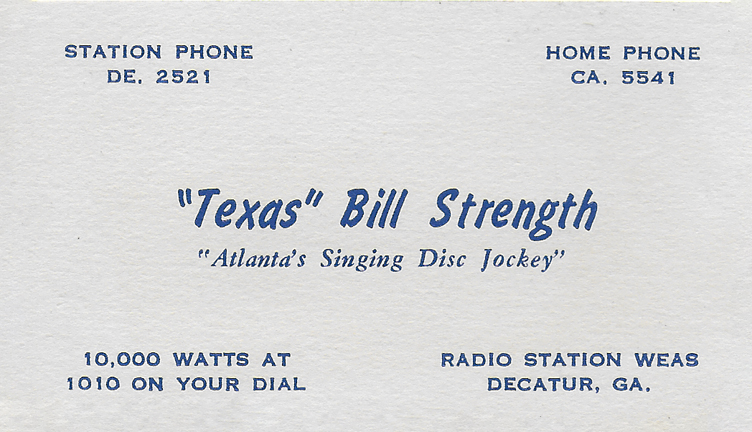
Business Card Image courtesy Dale Strength
- He brought top country music acts into the area for the Dixie Barn Dance, held at East Point’s Civic Auditorium.
- He appeared on WLWA-TV with Ray McKay and the Swingbillies.
- He recruited acts to appear at “his own” Silver Slipper Club, where he would perform on weekends.
THE SILVER SLIPPER
After much frustration and asking questions and writing letters, we still do not know where TBS’s elusive Silver Slipper night club was located. References in the newspaper go back to 1937, when it was reported that Police found a stolen taxi at the Silver Slipper roadhouse on the New Macon Highway (which is now the Old Macon Highway). In 1938, owner Paul Johnson was indicted by the Clayton County Grand Jury on three counts of having slot machines at the Silver Slipper roadhouse. In 1941, County Commissioners revoked all dance hall licenses in Clayton County. The Silver Slipper was referred to as a “Jook.” The location was described as just beyond the Fulton County line on McDonough Highway.
By 1949, the Silver Slipper had changed hands and was now owned by J.P. Copeland. We know this because he was in trouble. He also had a tourist camp, and he was charged with not keeping track of his guests’ cars. Think of one of those noir movies where the young couple are running from the law and/or their parents for one reason or another. We learn here that both the Silver Slipper and the tourist camp are on Highway 42.
On February 20, 1950, the Silver Slipper was advertised for sale or lease. The property included the night club and courts, and apparently was described as being on the Airline Highway.
The first ad shows up in 1950:
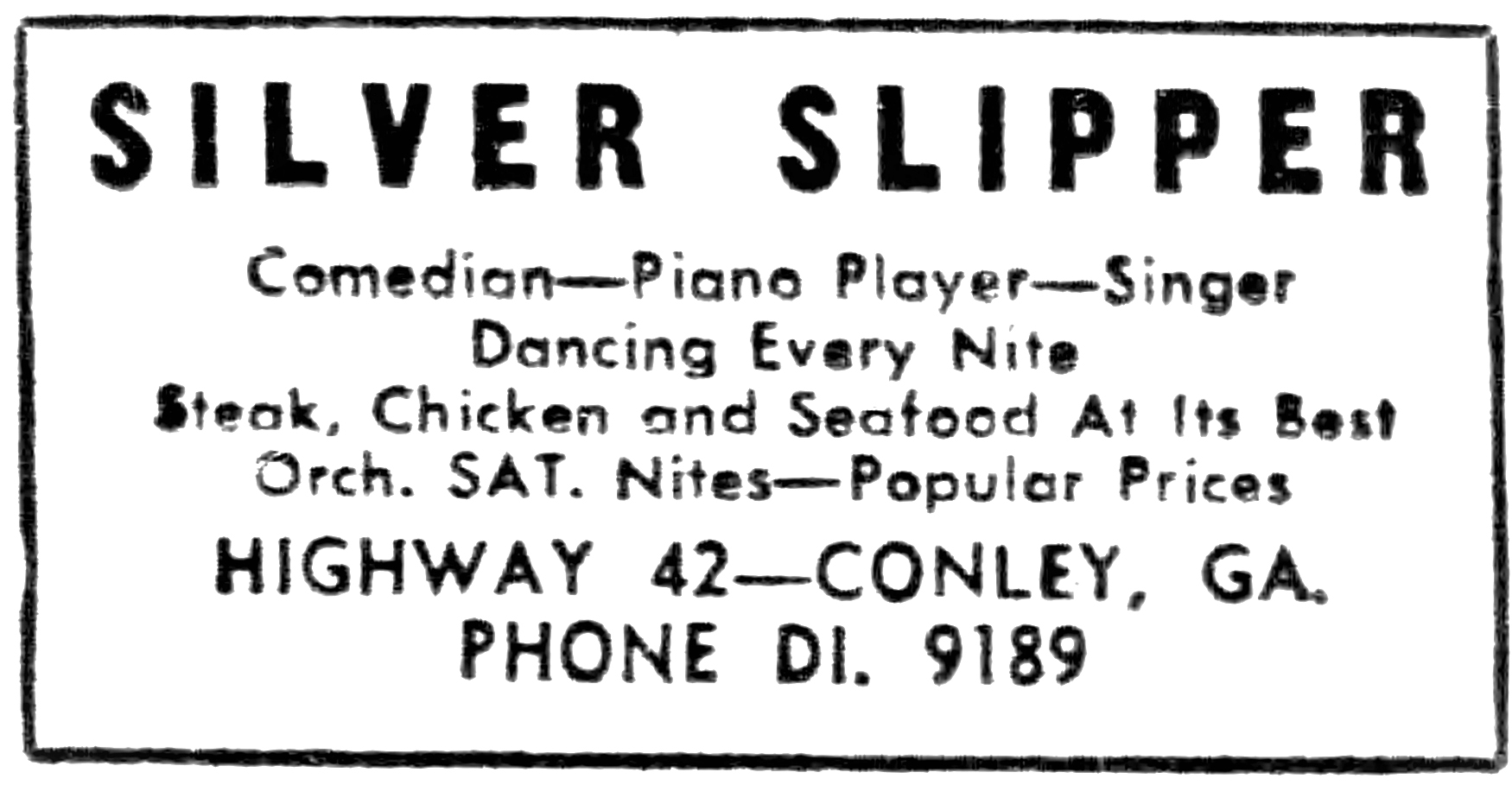
Atlanta Constitution, December 25, 1950
Texas Bill started working for station WEAS in nearby Decatur, Georgia, on April 6, 1952.
On February 28, 1953, one could dine and dance to Groover’s Orchestra.
On June 5, 1953, the Silver Slipper Dining Room was listed for rent or sale. The ad said that it seated 200. It’s possible that this may have been when TBS became an owner/partner.
The next mention is an ad in February 1954.
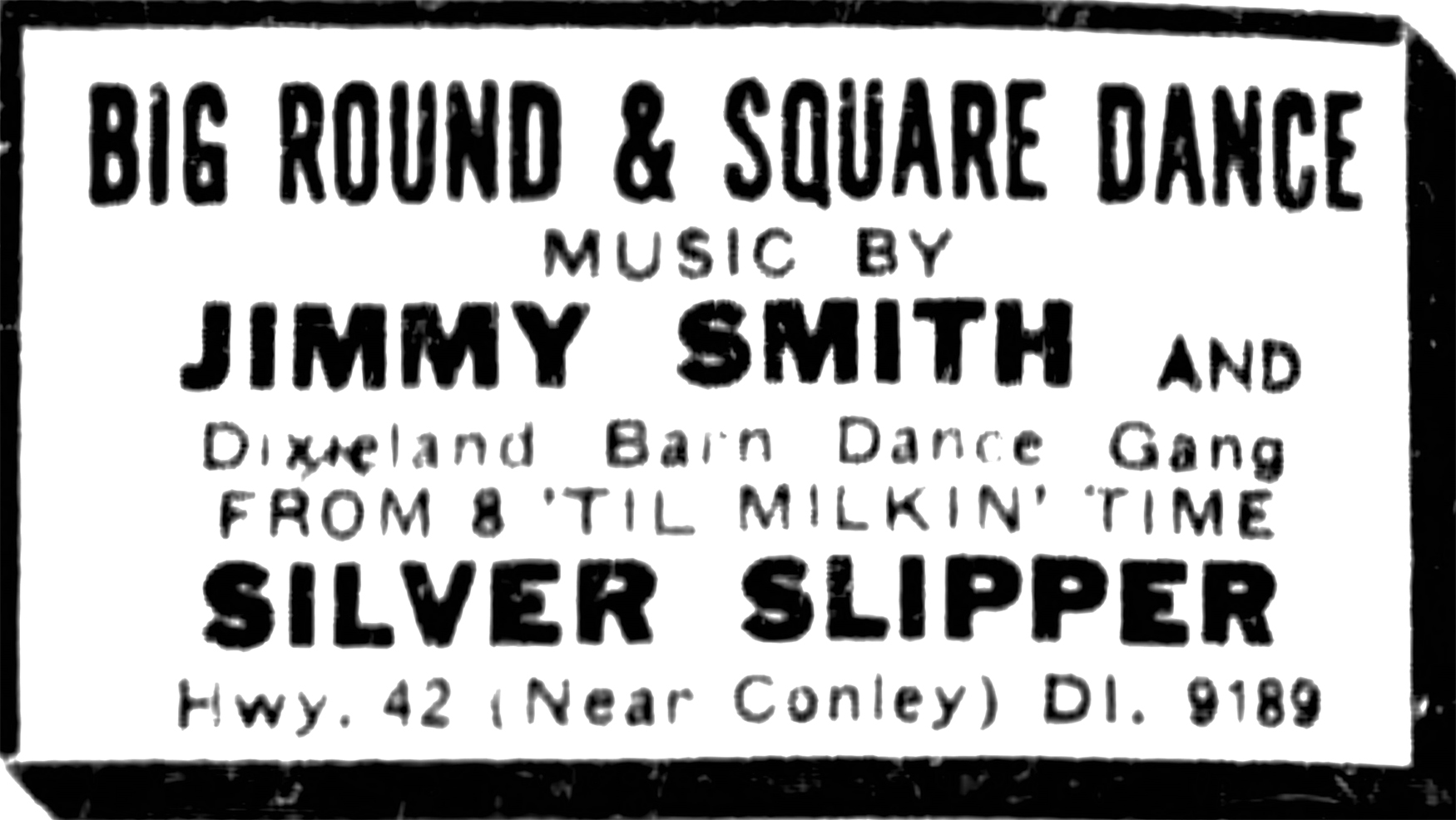
Atlanta Constitution
It was probably during 1954 that TBS recorded “Y’all Come” on the radio, which can be heard here. As you can hear, he throws in a “to the Silver Slipper Friday nights.”
Most mentions of the place in Billboard occur in 1954, and are listed below. Even though he left Decatur for Memphis in September 1954, the Silver Slipper continues to be mentioned until the end of October 1954.
In January 1955 it was further described as being on Moreland Ave., which is the same as Highway 42.
One last ad for the Silver Slipper appeared in 1957:

Atlanta Constitution, September 19, 1957
On October 21, 1959, owner Jasper T. Copeland died of a stroke. He had lived on Highway 42 for 14 years. The Silver Slipper had been leased to Amvets.
The area is mostly industrial now, but there is something telling. There is a road that loops off of and behind Moreland Ave. called Cottage Lane; ironic given the miles of trucks and factories it abuts. But one guess is that the Silver Slipper or at least those tourist cabins used to sit inside that area. So far, the answer is elusive.
TBS FAN CLUB
Another factor, or indication, of TBS’s popularity was his fan club, based in Columbia, Tennessee. The club was run by Willie Bea Gray and Freda Jones, who called him the Houston Star. For a dollar a year, members received an autographed photo, membership card, a newsletter every six weeks, and the quarterly Houston Star publication, described as slick, fact-filled, and one of the best of its kind. By the spring of 1954, membership reached 40,000 in 20 states, and by that fall it claimed coverage in all 48 states. The club’s motto was “Let’s Boost Bill With All Our Strength.” (Ronnie Pugh)
An issue of the Houston Star Fan Club newsletter from the Summer of 1954 provides the names and instruments of the Melody Ranch Boys while promoting TBS’s club, the Silver Slipper:
Every Friday and Saturday night, folks in and around Atlanta can now dance to the music of TEXAS BILL STRENGTH, and the MELODY RANCH BOYS, at the fabulous SILVER SLIPPER SUPPER CLUB, on Hiway 42, eight miles from downtown Atlanta. The MELODY RANCH BOYS feature Buddy Pattilo, fiddle; Jimmy Estes, electric bass; Lamar Hawkins, electric guitar; and our star, Bill. They are also heard daily at 7:15pm over WEAS.
Tragedy struck in April 1954, when the home of President Freda Jones was destroyed by fire, taking all of the records of the club with it. Miss Jones asked that members contact her by writing to the club at 104 East 14th Street, Columbia, Tennessee. (Huntsville Times, April 8, 1954)
Although Ronnie Pugh stated that the club operated between 1952 and 1955, Bill’s peak years in the South, there was evidence that it lasted at least until 1957. On September 30 of that year, Billboard reported that Mary Moore, 112-A Peak Tops (U.S.N.S.), Green Cove Springs, Florida, is the new president of the TBS Fans’ Club, succeeding Dixie Ann Brown, who has been forced to resign due to illness.
April 1952
Sandra Pearl Strength, TBS and Dorothy’s third and last child, was born on April 13, 1952, most likely in Atlanta. Her arrival was announced in the July 26, 1952, issue of Billboard.
June 1952
CORAL RECORDS
On June 27, 1952, TBS had his second recording session for Coral at the Tulane Hotel in Nashville:
- “It’s a Shame”
- “I Found my Love and Lost my Heart”
The record was released in September 1952 and reviewed by Billboard on September 27, 1952:
- “I Found My Love” – The chanter has a fine country tune here and he gives it a sympathetic reading. Tho Strength’s piping is not very powerful, he projects with a good deal of warmth.”
- b/w “It’s a Shame” – “Routine rural weeper is read with the proper pleading quality by Texas Bill. Might do okay in the more rustic areas.”
July 1952
Strength’s e.t. radio show is now heard on 51 Southern stations. He is still touring for the CIO. (Billboard, July 26, 1952)
CORAL RECORDS
On July 28, 1952, TBS returned to Coral Records for his third recording session:
- “Rain or Shine”
- “Heart Don’t Complain”
Coral 64152 was released in March 1953 and reviewed by Billboard on April 4, 1953:
- TBS is on the charts with Coral release “Rain or Shine” (“Bouncy ditty is sung nicely by Strength with his strong voice. Strong band gives good support.”)
- b/w “Heart, Don’t Complain” (“Melancholy oatune is warbled with feeling by Strength. He’s trying to tell his heart that he tried his best.”)
TROUBLE IN HAZELHURST
Being an itinerant folk singer with the CIO was not without its hazards. Organizing large companies was a hot-button issue in the 1950s, and you might just get run out of town.
Take for example the case of the Cook Lumber Company, where CIO organizer John Scott was “mauled” by a man at the gate of the company on July 31, 1952, for handing out union leaflets to workers. The next day, July 1, a man claimed he was beaten by union organizers. July 1 was also the day that John Ramsey, the director of community relations for the CIO, and Texas Bill arrived in town from Atlanta. Bill was known as “the CIO Singer of Songs,” said the report. Ramsey said that he, Scott, and Strength were beaten by seven men at the gate of the plant.
The CIO organizers had planned a mass meeting on July 2, but they called it off at the request of the Sheriff, who could not guaratee their safety. The Sheriff said he feared violence unless the organizers left town. As the six union men started to leave their hotel, a crowd of about 50 men gathered around, and the Sheriff told the mob that the CIO men were leaving. The Sheriff escorted the union men to a nearby town, followed by about a dozen cars.
Ramsey vowed to return to Hazelhurst with lawyers and warrants in two or three weeks to arrest their assailants. He said that they were asked to come into Hazlehurst, and “the trouble was started by a small gang of thugs used by certain politicians.” (The Macon Telegraph, Monday, August 4, 1952)
August 1952
TBS was the special guest on KWKH’s Louisiana Hayride, in Shreveport, on August 2, 1952.
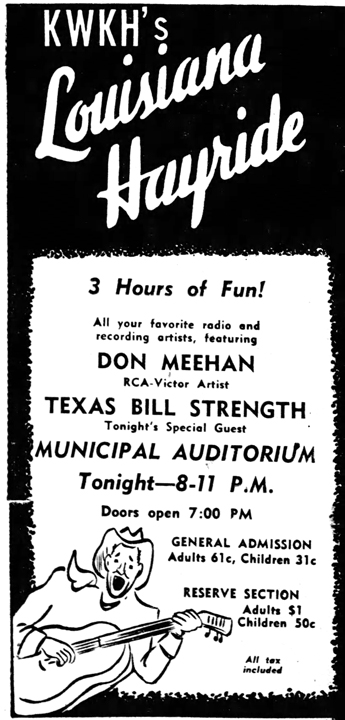
Shreveport Times, August 2, 1952
October 1952
TBS may guest at the national CIO convention in Los Angeles in mid-November. (Billboard, October 25, 1952)
1953
The 1953 Atlanta directory listed TBS’s occupation as “field rep CIO,” living at 124 Jewel East Point.
SOUTH CAROLINA
February 1953
TBS (Coral) is renting his home in Atlanta to move permanently to Columbia, SC, where he’ll do his radio shows for the CIO. (Billboard, February 7, 1953)
The above was the last mention found of the CIO. It appears that, for whatever reason, TBS chose to leave the CIO (or the CIO chose to part with him) and he returned to his job and home in Atlanta, on WEAS. Ronnie Pugh’s biography doesn’t mention this move to Columbia, so there’s no evidence other than the Billboard items that he actually moved his family out there.
(BACK TO) ATLANTA
April 1953
Bill was on WEAS in April 1953, although for only half an hour in the early morning. On Sunday, April 26, he performed two shows with Hank Thompson and his Brazos Valley Boys, Ron McKay and the Swing Billies, Dan Ross, and others at a show at the East Point Auditorium in East Point, Georgia.
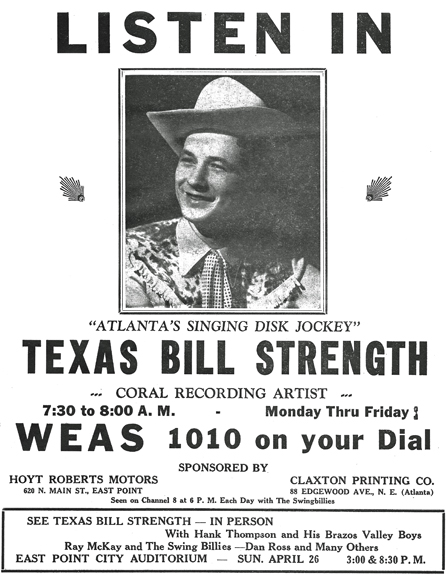
Image courtesy Dale Strength
May 1953
TBS writes from Atlanta that he’s now [back] with that city’s Radio Station WEAS. (Billboard, May 2, 1953) He had worked at WEAS since April 6, 1952.
June 1953
TBS, Coral recording star, has started a talent quest show over radio Station WEAS, Atlanta, “Young American Club Broadcast,” from 9 to 10 am each Saturday. Youngsters perform either hillbilly, pop or jazz. (Billboard, June 6, 1953)
July 1953
On July 12, 1953, Red O’Donnell, in his “Top o’ the Mornin'” column in the Nashville Tennessean, reported that TBS was in town to appear on the Grand Ole Opry. The next month, August 1953, O’Donnell noted TBS’s birthday in his column.
September 1953
TBS is working in Atlanta’s Coral distributor’s office with John Thompson (formerly Cincinnati) in charge. (Billboard, September 12, 1953)
October 1953
TBS and Leon Beaver set for new Coral session immediately under direction of Johnny Thompson, who also handles diskery’s Atlanta office. (Billboard, October 3, 1953)
On October 15, 1953, Atlanta’s new Trailways Bus Station opened with much ballyhoo, and TBS was prominently included in the festivities. Below is the full page and two close-ups of the entertainment sections, from the Atlanta Constitution.
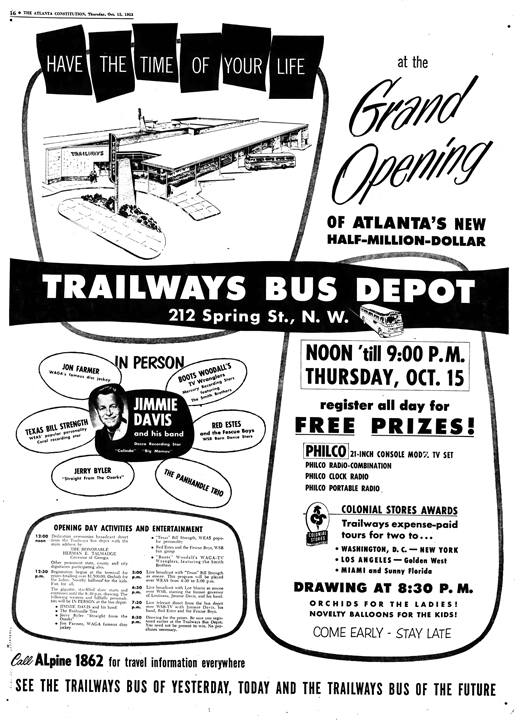
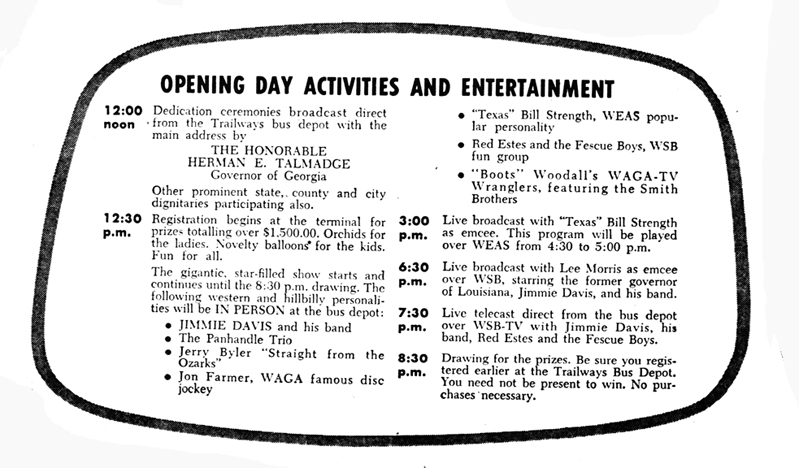
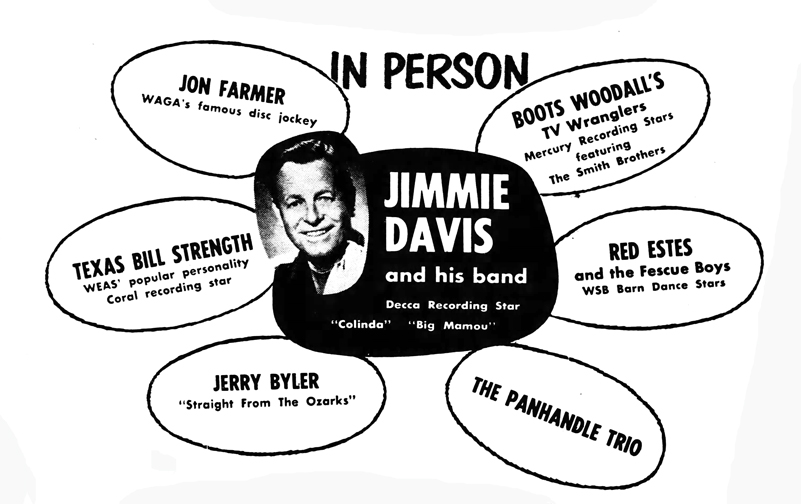
Billboard reported that ex-Governor Jimmy Davis was the guest of Georgia Governor Herman Talmadge for the occasion, and that festivities were headed by:
- Boots Woodall
- Smith Brothers
- Paul Rice
- Pat Patterson
- Cotton Carrier
- TBS
From the end of October to the end of November 1953, TBS had some dates at the Rhythm Ranch, 19 Baker Street NW, in Atlanta. He shared the stage with the Las Vegas Seven, but also with Piano Red, a/k/a Dr. Feelgood?!
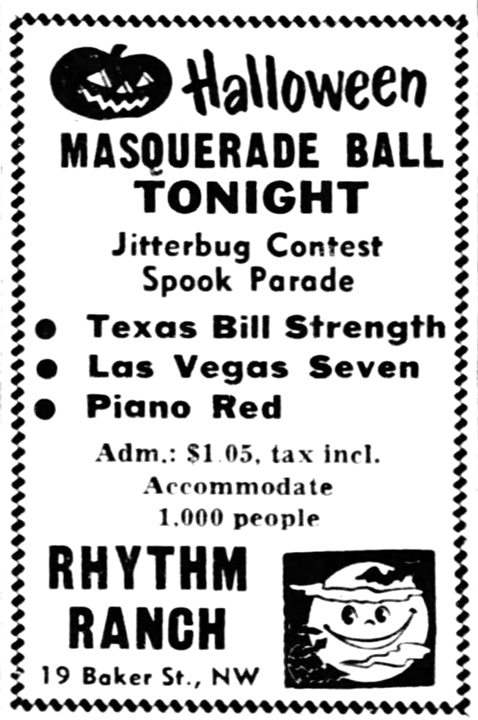
Atlanta Constitution, October 31, 1953
November 1953
TBS promoted an all-star country jamboree in Atlanta recently, with:
- Little Rita Fay
- Curtis Gordon
- Faron Young
- Smiley Wilson
- Kenny Lee
- Kitty Carson
- David Bucie and his boys headlining the bill
(Billboard, November 14, 1953)
CORAL RECORDS
On November 21, 1953, TBS recorded four sides for Coral at the Tulane Hotel in Nashville. This coincided with the second Disc Jockey convention.
- “Nice to be Living,“ written by TBS
- “Nobody Knows This More Than Me“
- “Country Love,“ written by TBS
- “Alone“
Coral 64171 was released in January 1954 and was reviewed in Billboard on February 6, 1954:
- “Country Love” – “Here’s a real cute country item, combining novelty appeal with solid rural sentiment. The ditty is Ernest Tubb’s, and TBS gives it a solid vocal.”
- b/w “Alone” – “A rural ditty full of sadness and pitched in a minor key. TBS does the vocal with heart.”
Coral No. 61284 was release in November 1954 and Billboard reviewed it on November 13, 1954 (a year after the sides had been cut):
- “Nice to be Living,” – A jaunty-paced vocal on a happy little ditty
- b/w “Nobody Knows This More Than Me” – A plaintive weeper about a man who couldn’t buy love, sung with sincerity and feeling.
This acetate appears on YouTube, and appears to be a demo, before the final version of “Nice to be Living” was recorded.
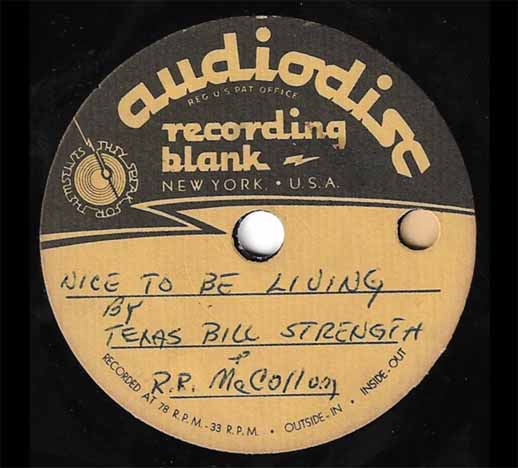
On November 22, 1953, TBS promoted a “Hillbilly Jamboree” at Atlanta’s Municipal Auditorium. Homer and Jethro headlined the bill and there was a capacity crowd. Also featured were:
- Mac Wiseman
- Bonnie Lou
- Jimmy Skinner
- Tom Gibson
- Warren Roberts
(Billboard, November 21 and December 5, 1953)
Another cool ad for a gig at the Rhythm Ranch:
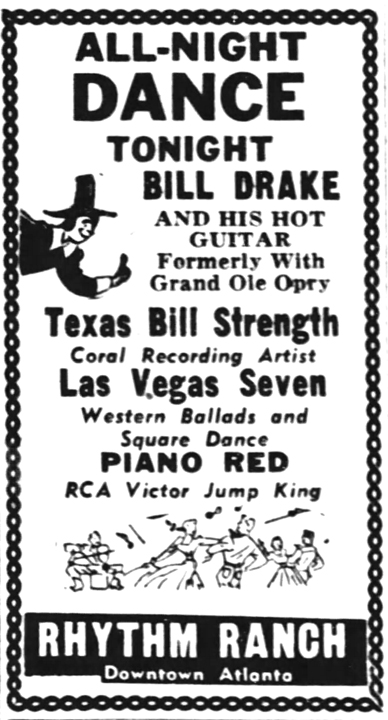
Atlanta Constitution, November 25, 1953
December 1953
December 5, 1953, ad in Billboard:
TEXAS BILL STRENGTH
CORAL
Radio Affiliation, Live Show: WEAS, Atlanta; As DJ: Same
Instrument Played: Guitar
Personal Manager: Bill Keller, 217 West Ponce De Leon Ave., Decatur, Georgia
Booking Office: Stars, Inc., Candler Bldg., Atlanta
Favorite Record, Own: “It’s a Shame;” Other: “May the Good Lord Bless and Keep You”
No. Personal Appearances per Month: 12
Speaking of Coral, it appears that TBS had four songs that he had pitched to his record company but they didn’t want him to record them, so he made an acetate of them, hoping someone else would record them. The songs are:
- “My Ray of Sunshine”
- “I’m So Happy I Could Cry” (the opposite of “I’m so Lonesome I Could Cry”)
- “If I Didn’t Love You” (written by his wife Dorothy)
- “Little White Church”
This acetate has fortunately made its way back into the hands of the Strength family, thanks to a generous collector.
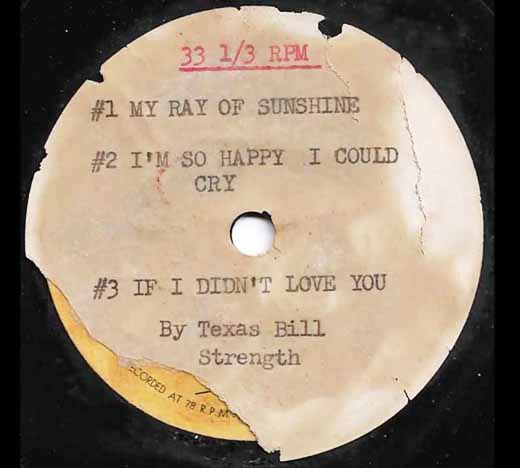
CORAL RECORDS
In December 1953, Coral appears to have dropped several of its C&W artists to concentrate on just a few. TBS survived the cut. The strategy was to issue fewer releases and promote them more vigorously. (Billboard, December 26, 1953)
Coral Records is entering the country and western field with a regular release schedule. Initially, releases will be pushed out at the rate of three and four records per month, according to A&R topper Bob Thiele … Thiele has appointed Johnny Thompson to head up the Coral C&W operation in Nashville… Thompson opened Coral’s Cincinnati and Atlanta branches. He has pruned Coral’s C&W roster to three artists – Tommy Sosebee, Texas Bill Strength and Tabby West. He is negotiating with two name artists.
(Billboard, December 5, 1953)
The Atlanta Constitution reported that a two-hour “hillbilly show and dance” was presented at the Sports Arena on December 17, 1953, under the auspices of the National Association of Handicaps. All proceeds from the show would be used to assist “physically handicapped persons who have lost one or more members of their body or who have been disfigured and are unable to obtain normal employment.” Performers included:
- TBS
- Kenny Lee
- Romeo Brinkley
- Leon Beavers
- Slick and Greasy
- Armand Herron
- Tom Gibson and the Cain Street Cowhands from WATL
Prizes donated by Atlanta merchants were distributed, with the shindig drawing to a close with a dance by Ray Rice and His Rhythm Aces.
(Billboard, January 9, 1954)
The Hillbilly Ball at Atlanta’s Municipal Auditorium last week [late December, 1953] went on til “Milkin’ time” with:
- Jack and Frances Holden
- Boots Woodall
- Smith Brothers
- TBS
- Kenny Lee
- Jimmy Smith
- Peachtree Cowboy
- Uncle Eb Brown
- Tom Gibson
- Leon Beavers
- Warren Roberts
- David Jones
- Tom Lowe
- Tom Noland, and
- Cuzzin’ Lem
(Billboard, January 9, 1954)
1954
January 1954
The Atlanta directory listed TBS as an announcer on WEAS in Decatur, living at 124 Jewel.
Folk talent galore played host to the March of Dimes at Atlanta’s Tower Theater [late January, 1954]. Among those participating were:
- The Smith Brothers
- Boots Woodall
- Pat Patterson
- Little Brenda Tarpley
- Jon Farmer
- Bill Lowery
- John Carroll and Little Donny
- TBS
- Bobby and Mack Atchinson
- Jerry Howell
- The LaFatterairs
- Jack Holden
- Kenny Lee
- Tom Gibson
- Romeo Brinkley
(Billboard, February 6, 1954)
TBS was a featured performer at a Big Round and Square Dance at the Alabama National Guard Armory in Birmingham on January 30, 1954. Also on the bill was Kenny Lee. The dance was sponsored by radio station WVOK.

Birmingham Post Herald, Saturday, January 30, 1954
February 1954
WEAS, Decatur, Georgia, is going to 50,000-watt strength in February, with TBS and Jack Holden handling the disk jockey chores. (Billboard, January 16, 1954)
March 1954
TBS guested on Marty Roberts’ WCKY, Cincinnati, show recently. (Billboard, March 6, 1954)
April 1954
CORAL RECORDS
On April 8, 1954, TBS and Tabby West (nee Phyllis Spain) recorded two sides on Coral. This would be the sixth recording session on Coral.
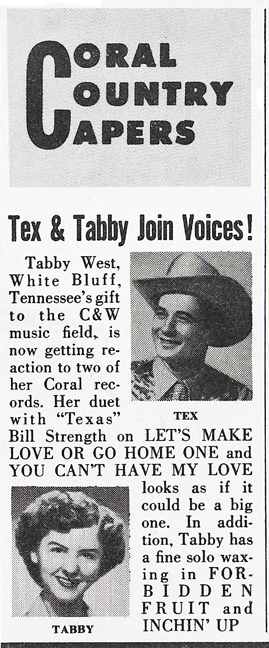
Article courtesy Dale Strength
- ”Let’s Make Love or Go Home”
- ”You Can’t Have My Love”
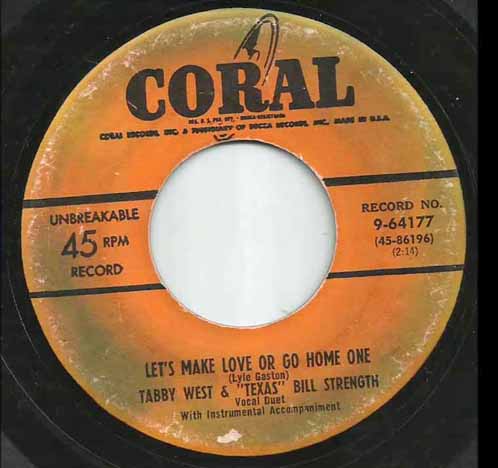
Coral 64177 was released in June 1954 and reviewed in Billboard on July 3, 1954:
- “Let’s Make Love or Go Home” – Tabby West and TBS team up for a saucy reading of a happy novelty effort. Side is cheery, and it could get spins.
- b/w “You Can’t Have My Love” – Old-fashioned opus is sparked by the vocal of the thrush and the sweet-talk of chanter Bill Strength.
May 1954
The Nashville Banner reported that Tabby West and TBS completed another Coral recording session on or before May 7, 1954 (the date of the article). The titles were due for a rush release, according to Coral execs. As far as we know, the sides were never released. The were:
- Forbidden Fruit
- Inchin’ Up
June 1954
TBS appeared on the cover of the June 1954 issue of Cowboy Songs, and was one of three artists featured in the issue.
Jimmie Skinner’s one-nighter at La Grange, Georgia, featured TBS from Atlanta. (Billboard, June 12, 1954)
Summer 1954
A summer 1954 article in Country Song Roundup‘s Fifth Anniversary Issue which featured spotlights on disc jockeys from around the country offered the reader some quotes attributed to Texas Bill that give us perhaps some insight into music and his career:
Since I began singin’ about ten years ago, I have always felt that Country music was a part of my life. I have taken it for granted that it is the only business that I should be in. Within these ten years, I have been associated with many types of people who tell a story. Some tell their story in a speech, others in books, and yet, there are people who can better tell a story in song. … and I guess that’s why I’ve been inspired to since my boyhood, to tell my story in a song.
In addition to music being a part of my daily life, I think it is one of the most gratifying things that could ever happen to an artist. Why? Because when I make other people happy with a song, either on a show date or by playing records on my D.J. shows, I feel that I am reaching my goal—I’m living Country Music!
July 1954
TBS played a string of 10 dates in Ohio, Kentucky, and Indiana with Jimmy Skinner recently. (Billboard, July 17, 1954)
Hank Snow, the Smith Brothers, and TBS played to 15,000 music and baseball fans in Atlanta last week. (Billboard, July 24, 1954)
August 1954
George Riddle, 18-year-old country DJ at WMRI, Marion, Indiana, had TBS and Lonzo and Oscar as guests recently. (Billboard, August 21, 1954)
TBS, WEAS, Decatur, Georgia, continues with his name act policy at his Silver Slipper there. (Billboard, August 28, 1954)
September 1954
MEMPHIS
In September 1954 TBS was moved to Memphis where WEAS had a sister station, KWEM, in West Memphis, Arkansas. He formed a new band, the Swingsters, and played two nights a week in a club at 5100 Summer Ave. in Memphis. (Ronnie Pugh)

KWEM Letterhead courtesy Dale Strength
It was the same time that Elvis, Johnny Cash, and Sun Records were discovering rock ‘n’ roll, and Memphis was an exciting place to be. Bill had so many personal appearances in the Memphis area and around the country, that it was amazing that he could keep his DJ job at the same time, but he stayed at KWEM from September 1954 until he moved to Minnesota in November 1955.
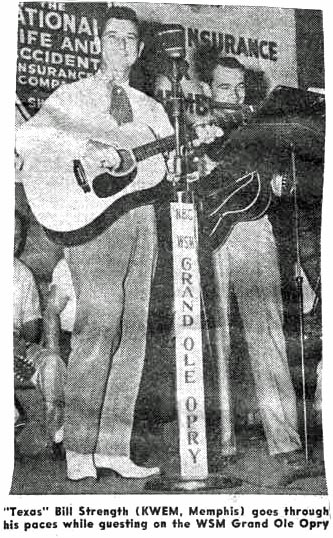
TBS will be Mr. Disc Jockey on the September 10 show from WSM, Nashville. (Billboard, September 4, 1954) Ronnie Pugh reported that a large contingent of his fan club crowded the WSM studios for the event.
Marty Roberts, platter spinner at WCKY, hopped into Atlanta for an appearance at TBS’s Silver Slipper Club. (Billboard, September 11, 1954)
On September 17, 1954, TBS played Sleepy-Eyed John’s Eagles Nest with Webb Pierce and the Wilburn Brothers. (Billboard, October 2, 1954)
HANK WILLIAMS DAY IN MONTGOMERY
September 20 and 21, 1954, marked the second observance of Hank Williams Memorial Day in Montgomery, Alabama. The first Hank Williams Day was arguably March 31, 1953, although it did not appear to be a gathering but a memorial held by radio stations. Williams died on January 1,1953.
This second Hank Williams Memorial Day drew more than 200 C&W DJs and performers to Montgomery. The event was sponsored by the Alcazar Temple of the Shrine. The event was highly publicized in the Montgomery Advertiser-Alabama Journal.
An early article advertising the event prominently featured TBS’s photo and bio on the front page:
To take a brief sampling might here give you some idea of the variety of talent already scheduled.
Start with Texas Bill Strength. Former star of a Texas network and a chain of 126 other stations, he now has turned disc jockey. He has three daily DJ shows over 50,000 watt WEAS in Decatur, Ga. Additionally he has a swing-band, the Melody Ranch Boys, and his own club, the Silver Slipper, near Atlanta. (August 29, 1954)
TBS was described as coming to the event from Houston, and whose latest recording, “You Can’t Have My Love,” was becoming a nation-wide hit.
The itinerary was as follows:
Monday, September 20: This evening was dedicated to performances by artists from Williams’ home state of Alabama.
Late Monday afternoon, a group of performers entertained some 200 GIs at the Maxwell Air Force Base hospital with a 30-minute impromptu show.
This was followed by a huge free show to about 8,500 people at the recently-opened Normandale shopping center, where special honors were given to Hank Williams’ mother, sister, and his widow, Audrey. A life-sized portrait of Hank was presented to his mother.
A combined crowd of about 2,800 attended three dances held Monday night at Fort Dixie Bibb Graves Armory, the Alcazar Shirne Temple, and the City Auditorium, with the various artists doubling between the three spots..
Tuesday, September 21:
Delegates journeyed to Oakwood Annex Cemetery to place a wreath on Williams’s grave.
TBS and his band paid a visit to the grave of Hank Williams in Montgomery
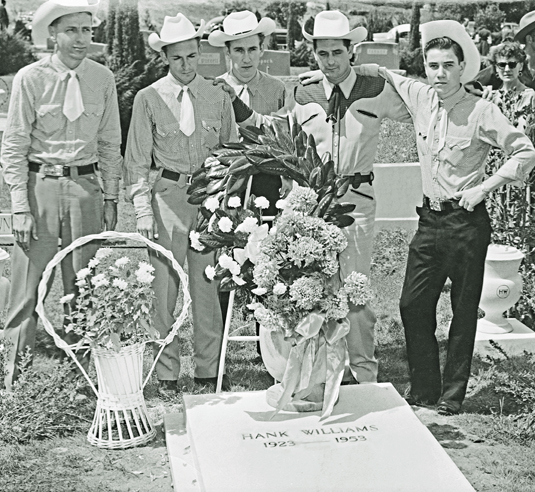
Photo Courtesy Dale Strength
There was a huge parade featuring Governor-Elect Big Jim Folsom, witnessed by an estimated 60,000 people. It took an hour for the parade to pass a given point.
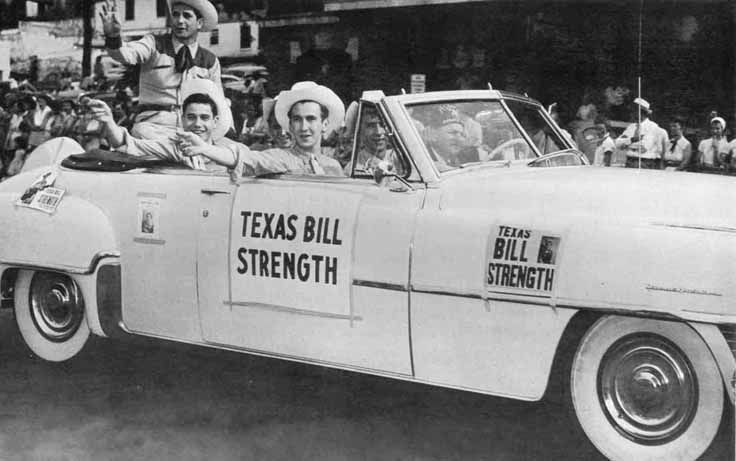
Climaxing the event was the headliner show at the Cramton Bowl, seen by about 8,500 people. Tennessee Governor Frank Clement was the principal speaker. Audrey and her children Lycrecia and Hank Jr. unveiled an 11 foot marble monument of Williams which was to be placed on his grave.
(Billboard, October 2, 1954)
On September 25, 1954, TBS did a “Youth for Christ” charity show with Roy Rogers, Dale Evans and the Sons of the Pioneers. (Billboard, October 2, 1954)
October 1954
TBS, who recently transferred from WEAS, Atlanta, to KWEM, Memphis, is doing a three-hour deejay stint daily plus a 15-minute live show. (Billboard, October 2, 1954)
TBS will appear at his own nitery, the Silver Slipper, Atlanta, on October 9, 1954, with his Melody Ranch Boys. (Billboard, October 9, 1954)
Elvis Presley, with his guitar and bassmen, Scotty and Bill, made an appearance recently at TBS’s nitery [The Silver Slipper] in Atlanta. (Billboard, October 23, 1954)
TBS, still featured on KWEM, Memphis, played his own Silver Slipper nitery, Atlanta, on October 30, 1954, and then embarked on a string of personals that will keep him busy for some time. (Billboard, November 13, 1954)
November 1954
On November 6, 1954, TBS played the “Barnyard Frolics,” Little Rock, with Sammy Barnhart (Okeh). (Billboard, November 13, 1954)
On November 13, 1954, TBS played Birmingham. (Billboard, November 13, 1954) While in Birmingham, TBS guested with Joe Rumore and Dan Brennan at WVOK, Buddy Starcher at WLBS, and Uncle Jim Atkins at WBRC. (Billboard November 27, 1954)
On November 13, 1954, Billboard polled C&W artists to determine which disk jockeys were doing the best job promoting their music. TBS was tied with four others at Number 50 out of 55; his station was listed as KWEM.
On November 15, 1954 TBS appeared in Sheffield, Alabama, with Webb Pierce and Red Sovine. (Billboard, November 13 and 27, 1954)
On November 16, 1954, TBS, Webb Pierce, and Red Sovine appeared in Ripley, Mississippi. (Billboard, November 13 and 27, 1954)
On November 17, 1954, TBS, Webb Pierce, and Red Sovine were to appear in Clarksdale, Mississippi. (Billboard, November 13, 1954) This show may have been shifted to Helena, Arkansas, according to Billboard on November 27, 1954.
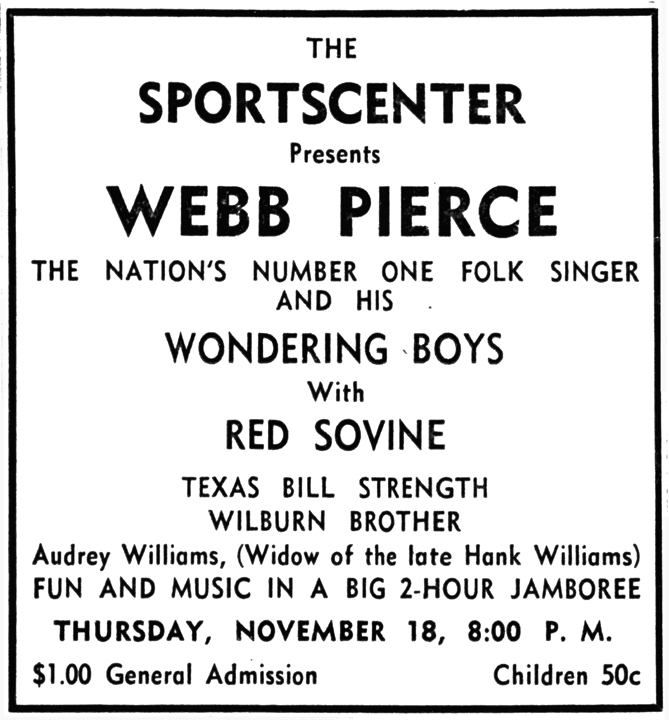
Owensboro, Kentucky, Messenger, November 18, 1954
In November 1954, TBS was scheduled to attend the deejay conclave in Nashville. (Billboard, November 13, 1954)
In late November 1954, TBS was scheduled to play the Roosevelt Lounge in Detroit. (Billboard, November 13, 1954)
On November 18, 1954, TBS was on the bill for a Stars of the Grand Ole Opry package show at the Memphis Auditorium. The show also included:
- Johnnie and Jack
- Kitty Wells
- The Tennessee Mountain Boys
- Cousin Nimrod
- Sonny James
- Chuck Reed
- Bud Deckleman
- Tiny and the Eagles
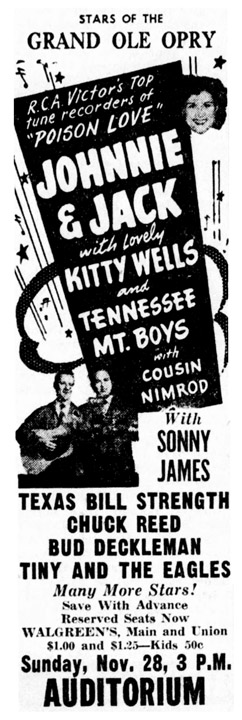
Memphis Press Scimitar, Wednesday, November 24, 1954
December 1954
On December 8, 1954, TBS, Elvis, and the Parker Bros. Band performed at the P&G car lot in West Memphis, Arkansas. This ad was quite a remarkable find by Dale!
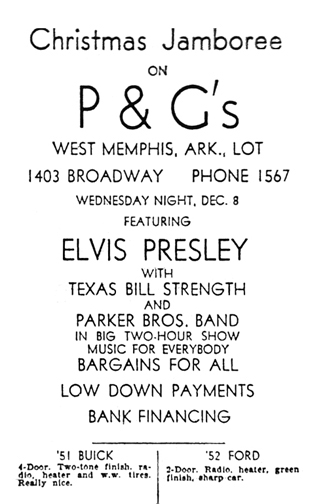
Ad courtesy Dale Strength
Here’s another one, with a fun admonition from Elvis at the bottom:
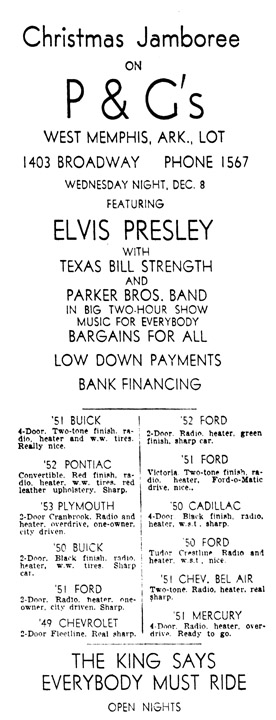
Memphis Press Scimitar, Tuesday, December 7, 1954
On December 23-25, 1954, TBS played Houston and then hopped back to Memphis to resume his chores at KWEM there. (Billboard, January 8, 1955)
One of those appearances was in the ad below, and was also mentioned in Charlie Evans’ “Night and Day” column in the Houston Chronicle. Evans: “Special guest will be Texas Bill Strength, who has been hitting the big-time shows through the South.”
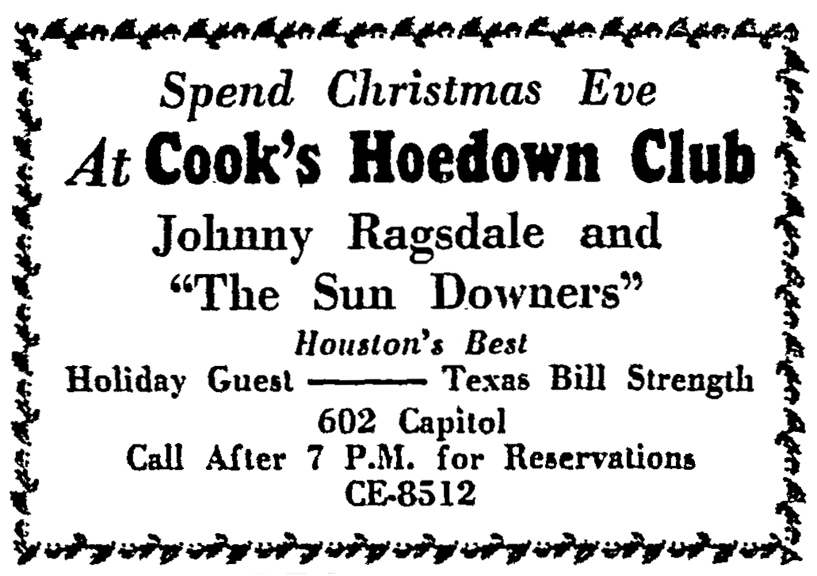
Houston Chronicle, December 23, 1954
Here is another Christmas appearance; in 1954, December 25 fell on a Saturday night.
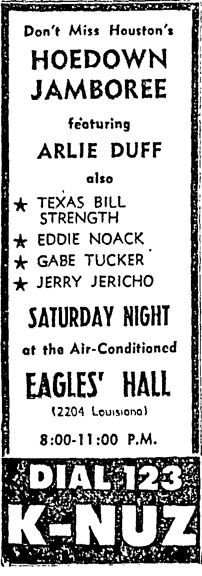
Houston Chronicle, December 25, 1954
1955
January 1955
TBS is set to play a string of dates with Jim Edward and Maxine Brown and Elvis Presley after the first of the year. (Billboard, January 8, 1955)
TBS played a place in Memphis called the Palms in mid-January 1955.
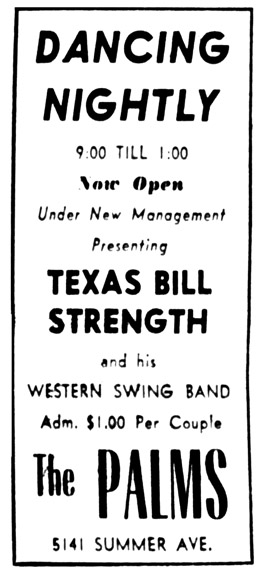
Memphis Commercial Appeal, Saturday, January 15, 1955
On January 29, 1955, TBS was a guest on “Grand Ole Opry” with Faron Young. (Billboard, February 12, 1955)
February, 1955
On February 5, 1955, TBS appeared on the “Ernest Tubb Jamboree” on WSM, Nashville. (Billboard, February 12, 1955)
TBS was the feature on “Barnyard Frolic” over KLRA, Little Rock. (Billboard, February 12, 1955)
March 1955
TBS visited the country deejays in Birmingham and Atlanta last week after winding up on a chain of 14 theaters in Arkansas and Mississippi. (Billboard, April 2, 1955)
May 1955
THE DEATH OF BROTHER CHARLIE
On May 1, 1955, TBS flew to Houston to attend the funeral of his 19-year-old youngest brother, Charles E. Strength, who passed away on April 30, 1955, in Pasadena, Texas. Charlie was a 19-year-old student at the time. Billboard reported that he died from an auto accident – that story is unverified. (Billboard, May 14, 1955)
Below is a photo of Charlie, taken just before he passed.
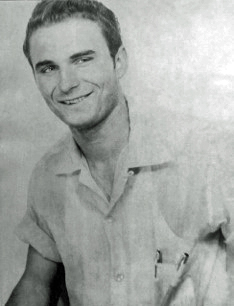
Photo courtesy Dale Strength
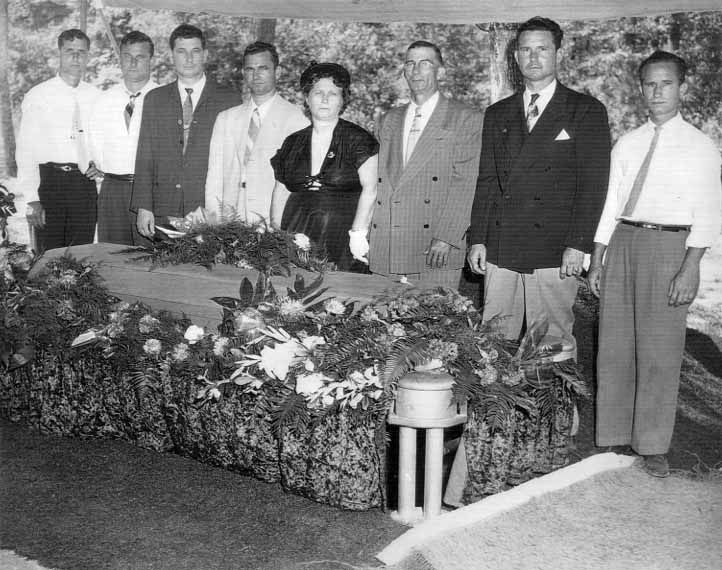
The Strength family at Charlie’s funeral: James, Albert, Bill, Edward, parents Jessie and WT, Gene, and Fred. Arthur (“Pete”) is not pictured. Photo courtesy Dale Strength
In the photo above, the story of Eugene, Jessie’s first son, is pretty clear, since he is nearly a foot taller than the rest of the Strength boys. TBS is probably the tallest of the Strength brothers, at either 5’ 8” or 5’ 9” (depending on the source). Eugene’s military registration card wasn’t found on Ancestry.com, which is a good source of height and weight, but the photo seems to show that his father must have been bigger than William T. Strength, Sr.
The absence of brother Arthur may be explained by the fact that on June 5, 1950, he began a six-year sentence at Huntsville prison for “Theft (3).” Then it says “(1-2).” He had been working as a messenger boy in Houston, and was convicted at the tender age of 18. The notes are difficult to decipher, and it’s unclear if he served the entire six years; if so, it would explain why he was not at Charlie’s funeral.
On May 13, 1955, TBS was set to embark on a 14-day tour of one-nighters thru Texas, Colorado and California. The trek forced Strength to miss the Jimmie Rodgers Memorial Day celebration in Meridian, Mississippi, May 25-26. (Billboard, April 2, 1955) [Later on Billboard says that he did make it.]
On May 16, 1955, TBS appeared with Curly Fox and Biff Collie over KPRC-TV, Houston. (Billboard, May 21, 1955)
From May 19-24, 1955, TBS was set on swing that’ll carry him from Port Isabell, Texas, to Mexico City. (Billboard May 21, 1955)
On May 21, 1955, TBS was on KWEM, West Memphis, Arkansas. He had recently been signed to Capitol Records in Hollywood. He also signed with Hollywood agent Bobbie Bennett. (Billboard, May 21, 1955)
Bennett was a Hollywood agent who had worked with Spade Cooley. She helped him find guest spots on several major shows while he was on the West Coast during the summer of 1955.
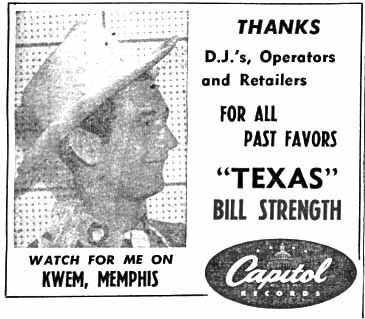
SOJOURN TO HOLLYWOOD
Following the Jimmie Rodgers Celebration in Meridian, Mississippi on May 25-26, 1955, TBS headed back home to Memphis to reload another suitcase and then hit out for the West Coast and a Capitol Records session. (Billboard, June 11, 1955)
On May 28, 1955, TBS was scheduled to appear in the feature slot on the “Big D Jamboree” in Dallas. (Billboard, May 21, 1955) (With Slim Whitman, (Billboard, May 28, 1955) (With Arlie Duff, (Billboard, June 4, 1955)
June 1955
On June 14, 1955, TBS pulled a packed house to the Ritz Theater, Parkin, Arkansas, with the result that he was held over the following night. (Billboard, July 2, 1955)
Somehow, between June 14 and June 25, 1955, according to this timeline, TBS made it from Arkansas to Hollywood. He was back in Memphis on July 4.
On June 25, 1955, TBS does a stint on Cliffie Stone’s “Hometown Jamboree” in Hollywood. (Billboard May 21, 1955).
July 1955
On July 4, 1955, TBS was booked to emcee the “Grand Ole Opry” package to be presented at Russwood Ball Park, Memphis, sponsored by the local chapter of the Cerebral Palsy Fund. The show was promoted by Elmer Yates. The lineup included:
- Ernest Tubb
- Goldie Hill
- Faron Young
- Wilburn Brothers
- Marty Robbins
- Carter Sisters
- Rod Brasfield
- Minnie Pearl
- Sleepy-Eye John of WHHM
(Billboard, May 21, 1955)
On July 22, 1955, TBS (Capitol) had an engagement at the Coldwater Theater, Coldwater, Mississippi. Afterwards he headed for the West Coast, where he’s booked thru August 1 by the Bobby (sic) Bennett Agency, Hollywood. (Billboard, July 30, 1955)
Can you drive from Mississippi to Arkansas in one day?
RED FOLEY – July 23, 1955
TBS was tentatively set to appear with Red Foley’s TV network show June 18. (Billboard, May 21, 1955)
TBS has had his guest appearance on Red Foley’s “Ozark Jubilee” ABC-TV network show shifted to July 23. (Billboard, July 2, 1955)
En route [from Mississippi on July 22, ] TBS stopped off in Springfield, Mo., Saturday (23) for an appearance on Red Foley’s “Ozark Jubilee.” (Billboard, July 30, 1955)
En route to the West Coast, Strength guested on the Ozark Jubilee. (Billboard, August 17 and 27, 1955)
Now Bill had from July 24 to July 29 to make it from Missouri to Los Angeles for his Capitol Records recording session.
Ronnie Pugh wrote that he drove 135 miles between Tulsa and Oklahoma City to visit Hank Thompson. And then he drove the rest of the way to Hollywood across the desert with the top down.
CAPITOL RECORDS
On July 29, 1955, TBS had his first Capitol recording session. He recorded four sides:
- “Turn Around“
- “When Love Comes Knockin’“ – written by TBS, Cash, Hopkins
- “Cry,Cry, Cry“
- “The Yellow Rose of Texas“
CRY, CRY CRY/YELLOW ROSE OF TEXAS
Judging from the record numbers, Capitol must have released “Cry, Cry, Cry” (F3217) b/w “Yellow Rose of Texas” first, although we have no release date or Billboard review. The Los Angeles Times reported on the release of “Yellow Rose” on August 11, 1955. The story of the record is interesting:
Wikipedia reports that Johnny Cash was signed to Sun Records in 1954 and brought Sam Phillips the song “Hey Porter,” which he had written while in the Air Force. He was told to come back with a more commercial song, and overnight he wrote “Cry! Cry! Cry!” His first record featured “Hey Porter” as the A side and “Cry! Cry! Cry!” as the B side. The latter entered the Country charts at No. 14. It was standard at the time for other artists to immediately cover songs.
Ronnie Pugh speculated that TBS may have been the first artist on a major label to record a song written by Johnny Cash. Below is an excerpt from one of TBS’s “Down Memory Lane” columns that he wrote for Upper Midwest Country & Western News Scene magazine, written in 1973:
I like to remember the first day I met Johnny. In the summer of 1955, I was doing my daily DJ show when Johnny walked into the studios of KWAM (sic) in [West] Memphis, very much unknown to anyone … He talked to our station manager and made a tape of a few of his songs … which were later to be recorded for Sam Phillips and the Sun label … A few weeks later, I had the pleasure of being the first DJ to play the first Johnny Cash record, “Hey Porter” … Since my show was made up of requests, the mail began pouring in for Johnny Cash records. John was a top mail puller and soon became the hottest artist on the turntables all across the nation. Before making his first recording, Johnny had been an appliance salesman in Memphis.
I had just been signed by Capitol Records at the time, and I flew to Hollywood and recorded his “Cry, Cry, Cry” … I knew it was a hit song and was hoping to reap some of the sales gravy. The big wheels at Capitol agreed it was a hit … I recorded it on Friday morning and the following Tuesday the D.J. samples were shipped from Capitol’s pressing plant … A rush release … and even though I was on a major label, I still couldn’t compete with the Johnny Cash record of “Cry, Cry, Cry” …
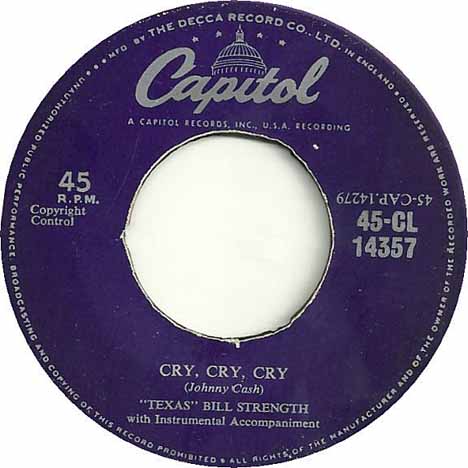
Note the upside down catalog number on both sides…
Luckily, I had “The Yellow Rose of Texas” on the flip side, so they turned it over and made “Rose” the push side; and as a result, John and I both had a hit.
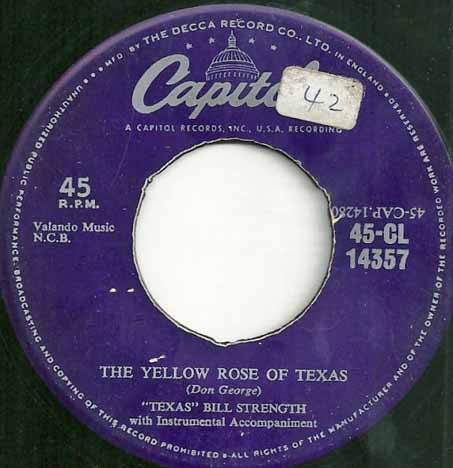
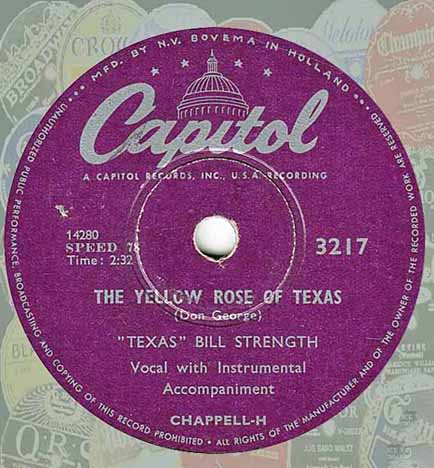
A 78 rpm version of “Yellow Rose of Texas”
The letter below appears to have been sent to a fellow disc jockey, gently urging him to keep spinning the record.
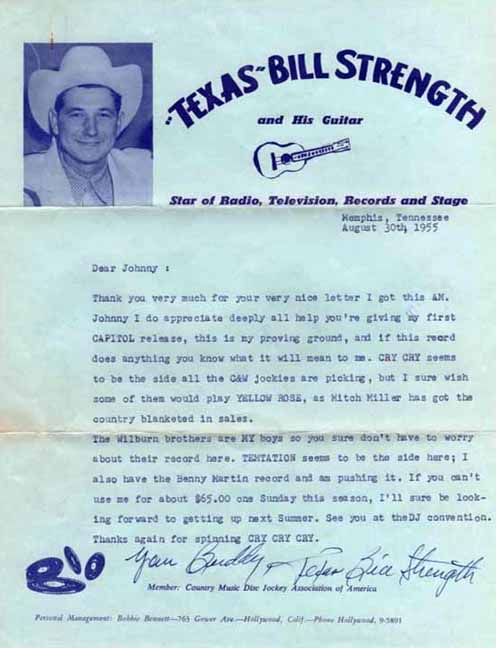
August 30, 1955, Memphis. Image courtesy Dale Strength
Capitol F3282 was released in November 1955, and was reviewed by Billboard on November 12, 1955:
- “Turn Around” – “A strong country ballad with a good melody line and effective lyrics. Texas Bill gives a fine performance. Will get strong deejay action.”
- b/w “When Love Comes Knockin’” – “Fine country rhythm side, belted out in great fashion by Texas Bill, to a lively backing featuring strings and honky tonk piano. Watch it.”
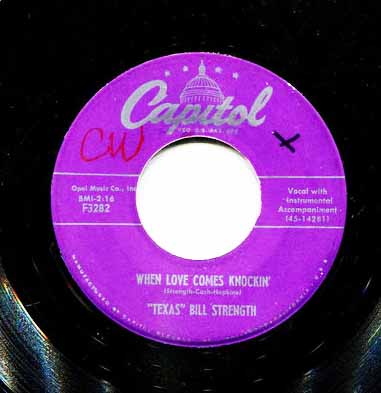
“Turn Around” was included on a Record List on an ad by McLean’s Records in the Newport News Daily Press, published on December 2, 1955.
An unusual independent review of this record was found in the Wichita Eagle, published on January 8, 1956:
Texas Bill Strength has strength in the vocal lines of “Turn Around.” His drawling voice presents a love song of the usual pickin’ and singin’ style. Piano, violin and steel guitar keep the background lively. A movable harmony between instrumentalists is notable.
“When Love Comes Knockin'” is on the other side and on this one Texas Bill had a hand in the composition. A slappy, happy bit, it has some hot solo by violin and fast fingering on the piano part while the whole features jump rhythm and a hoedown tang.
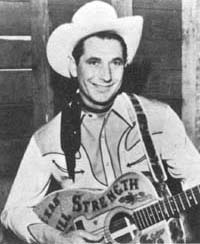
Photo courtesy Dale Strength
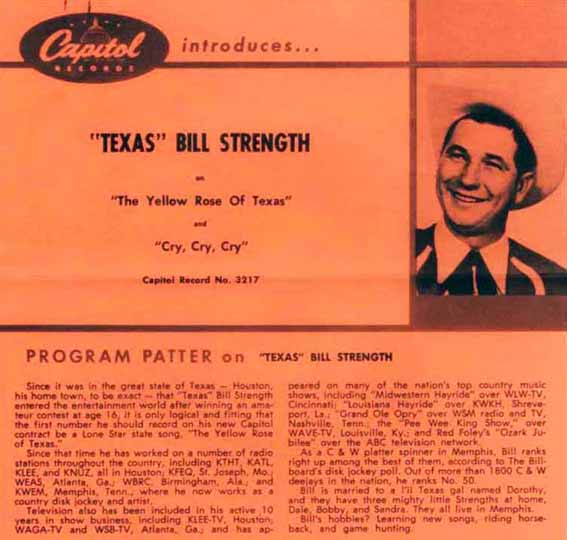
On Saturday, July 30, 1955, TBS appeared on Spade Cooley’s TV show, KTLA-TV, Hollywood. Bill has just taken delivery on a new 45-foot, air-conditioned house trailer, a new ’55 benzine buggy. (Billboard, July 30, 1955)
An undated list of “Recent Appearances” notes that TBS had appeared on the Spade Cooley Show twice.
During his recent trek to Hollywood for the Capitol session, Strength made a successful screen test, with negotiations under way to spot him in a Western feature soon. (Billboard August 20, 1955)
August 1955
On the Coast, TBS:
- Visited with Tex Ritter and Wade and Stuart Hamblen
- Appeared on “Town Hall Ranch Party,” KTTV in Hollywood, with Ritter, Johnny Bond, Wesley and Marilyn Tutt and Freddie Hart
- Appeared with Jolly Joe Nixon and Cliffie Stone over KXLA, Pasadena
- Appeared with Hank Penny and Sue Thompson at Riverside Rancho
(Billboard, August 27, 1955)
OVERTON PARK SHELL, MEMPHIS
On August 5, 1955, TBS appeared on Bob Neal’s eighth and last “Anniversary Jamboree” at the Overton Park Shell in Memphis. Just as Elvis had made his first professional performance at the 1954 event and blown the 4,000 people in the audience away, in 1955 it was Johnny Cash’s time to shine.
- Webb Pierce
- Elvis Presley, Scotty and Bill
- Wanda Jackson
- Bud Deckleman
- Johnny Cash
- Sonny James
- Red Sovine
- Jim Wilson
- Charlie Feathers
- The Neal Boys

Memphis Press Scimitar, August 6, 1955
Dick Stuart, WMPS Memphis, wrote to Billboard that “The biggest country show ever to play Memphis pulled a record-breaking crowd of over 4,000 people to the Bob Neal ‘Eight Anniversary Jamboree’ at Overton Park Shell.
The performers “kept the crowd on the edge of their seats for well over three hours, despite threatening skies. On the Neal anniversary one year ago, Elvis Presley made his debut, and was a sensation. This year Johnny Cash broke thru as the outstanding new act in Memphis. I’m handling him.” (September 17, 1955)
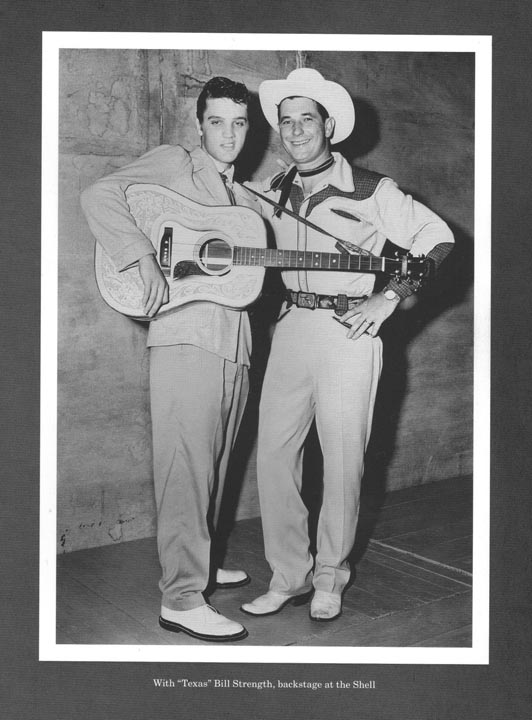
Photo courtesy Dale Strength
The Memphis Press Scimitar of August 6, 1955 also reported that the troupe also visited Little Rock, Arkansas; Sheffield, Alabama; Camden, Arkansas; and Tupelo, Mississippi that week.
On August 6, 1955, TBS did a stint on the “Grand Ole Opry” in Nashville, and the Ernest Tubb “Midnight Jamboree” over WSM. (Billboard, August 20, 1955)
On August 7, 1955, TBS appeared as a guest at Roy Acuff’s Dunbar Cave in Clarksville, Tennessee, with Faron Young, the Wilburn Brothers, and Eddie Hill. (Billboard, August 20, 1955)
On August 13, 1955, TBS was due in Cincinnati for a visit with local disk jockeys and other friends. He has just returned from the West Coast, where he cut his first session for Capitol. (Billboard, August 13, 1955)
On August 14, 1955, TBS left Memphis for a two-week promotional tour in the interest of his initial Capitol release, “Yellow Rose of Texas,” b/w “Cry, Cry, Cry.” He has stop-offs skedded for Louisville, Indianapolis, Cincinnati, Chicago, Philadelphia, New York, Washington and other Eastern cities. (Billboard, August 20, 1955)
In August 1955, TBS was back in Columbia, Tennessee, after a jaunt to the West Coast that offered him the opportunity “of guesting on a number of shows and visiting with folk artist friends.” (Billboard, August 27, 1955)
TBS was a visitor at the home office of The Billboard last week [late August] while in Cincinnati to promote his initial Capitol release, “Yellow Rose of Texas” b/w “Cry, Cry, Cry.” He also guested with various local deejays during his Cincy stay. (Billboard, September 3, 1955)
September 1955
And then there’s Abdalla’s Furniture Store, “Southwest Louisiana’s Largest and Finest,” which also sold Popular, Race, and Hillbilly records. For five weeks in September and October 1955 we see Hit Records charts in the Opelousas, Louisiana, Daily World, with TBS’s “Cry, Cry, Cry” b/w “Yellow Rose of Texas” taking various places on the Hillbilly chart, although they are not numbered. Also, the two sides change from week to week.
On September 10, 1955, TBS played the “Barnyard Frolic” at Robinson Auditorium, Little Rock. Show is emseed by Sammy Barnhart (Decca) and airs over KLRA. (Billboard, September 24, 1955)
TBS had been a recent visitor to DJ Thom Hall at WKYW in Louisville. (Billboard, September 17, 1955)
On September 17, 1955, TBS played the National Guard Armory Birmingham. (Billboard, September 24, 1955)
On September 18, 1955, TBS appeared at the Atlanta Crackers Ball Park, Atlanta, with:
- Ferlin Huskey
- Martha Carson
- George and Earl
- The Carlisles
- Kenny Lee
- Bill Lowery
(Billboard, September 24, 1955)
Strength says reports have been good on his first Capitol release, “The Yellow Rose of Texas” b/w “Cry, Cry, Cry,” with the latter getting the most play. (Billboard, September 24, 1955)
On September 25, 1955, TBS was part of a big Grand Ole Opry show at the Norfolk City Auditorium in Virginia. The show was presented by radio station WCMS in Norfolk. The big name performers were:
- Faron Young
- Little Jimmy Dickens
- The Wilburn Brothers
- Rod Brasfied
- Grandpa Jones
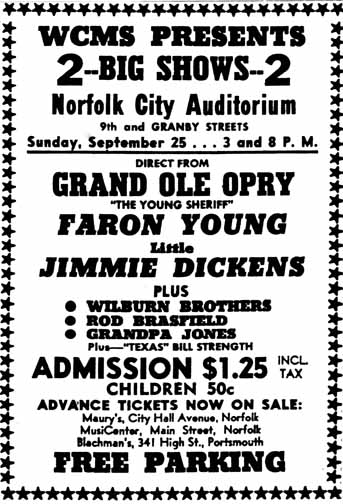
The Virginian Pilot, Friday, September 23, 1955
TBS was in Cincinnati on personals on September 27, 1955, visiting C&W DJs and music men to plug his new Capitol release, “Yellow Rose of Texas,” b/w “Cry, Cry, Cry.” He flew out that night for Memphis. (Billboard, October 8, 1955)
The Corpus Christi Caller Times of September 30, 1955, mixed all of its genres together on its charts, but TBS’s “Cry, Cry, Cry” was there, above a Dean Martin song.
October 1955
On October 13 – 15, 1955, TBS participated in the opening of Memphis’ newest and one of the Mid-South’s largest and most complete shopping centers, the Park Shopping Center, at Park and Getwell. The first six stores staged a jamboree inaugural with top stars of the radio and television musical world, starting with Texas Bill Strength from 9 to 10am for each of the three days. Bill was described as
the popular country disk jockey and artist on radio station KWEM, where he ranks among the top platter spinners. Out of more than 1,800 deejays in the nation, Billboard ranks him No. 50. He lives in Memphis with his wife, Dorothy, and three little Strengths, Dale, Bobby and Sandra.
(Memphis Commercial Appeal, Thursday, October 13, 1955)
On October 21, 1955, TBS and his band were scheduled to entertain at the Kennedy Veterans Hospital with a variety show. It was one of three projects supported by the Armed Forces Officers’ Wives Club of Memphis. (Memphis Commercial Appeal, Friday, October 21, 1955)
TBS’s recording of “Yellow Rose of Texas” was No. 4 in the Cincinnati C&W market. (Billboard, October 22, 1955)
Johnny Cash’s version of “Cry, Cry, Cry” is only now beginning to shape up as a left-field threat. Starting off nicely in the Nashville and Memphis trade areas, it has continued to grow there and has begun to spread. Richmond, Dallas, New Orleans and Little Rock are other territories where Cash has now established himself. TBS’s version is also a good seller in a number of key spots. (Billboard, October 22, 1955)
On October 23, 1955, “Grand Ole Opry TV Stars” gave two performances to good houses at the Memphis Auditorium in the big North Hall. Sponsored by Bob Neal, the show featured:
- Jimmy Dickens and his Country Boys
- Moon Mullican, the Hillbilly Liberace
- Rod Brasfield, Comedian
- Jean Sheppard
- The Wiburn Brothers
- Hawkshaw Hawkins
- Eddie Bond
- TBS
- Ray Price and the Western Cherokees
Faron Young was scheduled to appear, but was hospitalized in Albany, Georgia with hepatitis. (Memphis Commercial Appeal, Sunday, October 23, 1955)

Memphis Commercial Appeal, Sunday, October 23, 1955
On October 28, 1955, TBS was scheduled to appear in Carrollton, Kentucky, with Jimmie Skinner and Hylo Brown. (Billboard, October 22, 1955)
On October 29, 1955, TBS was scheduled to make a return stand with “Circle Theater Jamboree” in Cleveland. (Billboard, October 22, 1955)
On October 30, 1955, TBS appeared at the Lyric Theater in Indianapolis for an “All Star Jamboree.” Billboard (October 22, 1955) reported that Dick Blake was the producer of the show. Other performers were:
- Martha Carson
- The (Bill) Carlisles
- Jim Wilson
- Sonny Grubbs
- Possibly Ferlin Husky, according to the Billboard blurb

Indianapolis Star, Friday, October 28, 1955
November 1955
Billboard reported that on Saturday, November 5, 1955, TBS was to appear on the Pee Wee King TV show over WBBM, Chicago.
This is a head-scratcher.
The Pee Wee King Show apparently began broadcasting on station WAVE in in Louisville in 1949.
In Chicago it was shown on WBBM from October 11, 1952, to March 28, 1953.
In Chicago it switched to station WMAQ in April 25, 1953.
In Minneapolis, it was broadcast on KSTP starting on March 17, 1953.
An undated list of Bill’s performances says that he appeared on the Pee Wee King Show on station KMMJ-TV, Chicago.
Station KMMJ was in the middle of Nebraska somewhere.
Leave it to Texas Bill to leave us in a quandary!
On November 6, 1955, two shows were presented by Jimmy Skinner and Lou Epstein at Emery Auditorium in Cincinnati. Performers included:
- Betty Foley (Decca)
- TBS (Capitol)
- Natchee, the Indian trick fiddler
- Pee Wee King and Band
- Bonnie Sloan (Columbia)
- Fiddlin’ Red Herron (King)
- Neal Burris (Columbia)
- Little Eller Long
- Red Murphy
- The Stanley Brothers (Mercury)
- Hylo Brown (Capitol)
- Jimmy Williams (MGM)
- Ray Lunsford (Excellent)
- Roy Moss
Jimmie Skinner was the emsee. The big show was touted via five Cincy radio and TV outlets. It marks the first C&W talent brigade to play a Cincinnati theater in many years. Reported in Billboard November 5, 1955. On November 19, Billboard reported that 4,800 ducats were sold for the 2,200-seat auditorium. SRO business was the order at both performances, with several hundred turned away at the matinee showing. The show got heavy promotion via five local radio and TV stations.
(Billboard, November 5 and 19, 1955)
The 1955 Billboard C&W Disk Jockey of the Year Poll put TBS at Number 26 out of 60. He was identified as working for KWEM. (November 12, 1955)
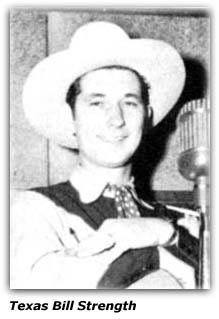
Undated photo, courtesy Dale Strength
On November 12, 1955, TBS put an ad in Billboard, with a picture of himself and text that read (vertically – punctuation added) “THANKS Dee-Jays for every spin you gave me on Cry Cry Cry b/w Yellow Rose of Texas. Your Grateful Buddy, Texas Bill Strength, exclusively on Capitol Records. Hope you like my brand new release, “Turn Around” b/w “When Love Comes Knockin’” Congratulations, WSM, on your 30th Anniversary. Glad to be here. Texas Bill Strength, Station KWEM, Memphis, Tenn. Phone Mutual 5-8606. Member CMDJ. Represented by Miss Bobbie Bennett, 763 Gower Ave., Hollywood, Calif. Hollywood 9-5891.
FAREWELL TOUR
On November 13, 1955, TBS made his final appearance in Memphis at the Ellis Auditorium. It was a farewell tribute to TBS, who announced to the crowd that he was moving to Minnesota to introduce Yankees to country music. The concert, which lasted between 3 and 8 pm, was the first of a six-day tour. Performers at the concert were:
- Hank Thompson
- Charline Arthur
- Elvis Presley
- Carl Smith
- Carl Perkins
On November 14, 1955, the Memphis show from the night before was repeated in Forrest City, Arkansas.
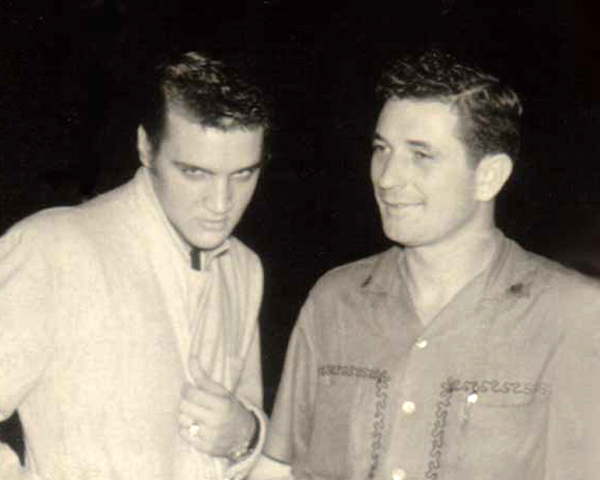
Elvis and TBS before the Forrest City, Arkansas show. Hank Thompson was off camera to the right. Photo courtesy Dale Strength.
The tour was promoted by Bob Neal, Presley’s personal manager. Strength has just given up his deejay chores at KWEM, Memphis. (Billboard, November 6, 1955)
On November 29 and 30, 1955, TBS was scheduled to guest star on “Hometown Jamboree,” Houston. Whether this was a radio or TV show is unclear. (Billboard, November 12, 1955)
MINNEAPOLIS
KEYD
In his column on November 22, 1955, Cedric Adams announced:
Radio Station KEYD will change its policy greatly starting this Saturday [November 26]. The station will move into complete programming of nothing but western and country music. Two of its regular disc jockeys have been dismissed and will be replaced by imports, Texas Bill Strength and Johnny T from Tennessee.
The all-country idea was that of Robert M. “Bob” Purcell and Nashville promoter A.V. Bamford. It was the first station in the Upper Midwest to be dedicated to country music on a full-time basis.
(Minneapolis Star)
TBS’s arrival was also announced in an ad entitled “On the Route with ‘Sunny Jim’ the Golden Guernsey Kid.” Sunny Jim (apparently a baby milkman) mentions the Sonny James show, KEYD’s new manager, Mac Lester, and KEYD’s new disk jockeys.
Starting Saturday all day long the disc jockeys are going to spin the cowboy and country records – and they got two famous cowboy singers coming to work at KEYD. One’s “Texas” Bill Strength, whose two current Capitol Record hits are “The Yellow Rose of Texas” and “Cry, Cry, Cry.” The other one’s the famous Johnny “T” From Tennessee, whose recordings are real popular. They’ll be at the Auditorium, too, along with our own favorite Slim Jim. Then all of the Grand Ole Opry people, “Texas” Bill, Johnny “T” and Slim Jim will have an all day long festival on KEYD Saturday. KEYD’s new slogan is “The Country-Western Station at the Top of the Nation.” Better turn your ear to 1440 on your radio Saturday and hear the fun.
(Minneapolis Tribune, November 22, 1955)
Sonny James, the tall folk-singer guitarist, has joined a troupe of country and folk artists to decorate the stage of Minneapolis auditorium Friday [November 25, 1955] at 8 pm. The Grand Ole Opry show will also feature:
- Ernest Tubb
- The Wilburn Brothers
- Mitchell Torok
- Wanda Jackson
- Arlie Duff
- Ray Price
- Al Terry
- Texas Bill Strength
- Rusty Gabbard
- Billy Byrd
- The Texas Troubadors
Reported by Bob Murphy in the Minneapolis Star, November 20, 1955.

Minneapolis Star, November 25, 1955

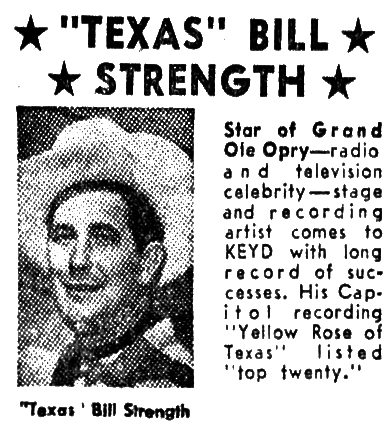
Minneapolis Star, November 25, 1955
KEYD
On November 28, [26] TBS begins his duties at the turntables at KEYD, Minneapolis, where he’ll also do a daily TV show. He asks all record companies to send releases to him at KEYD, Foshay Tower, Minneapolis, effective immediately. Dick Stuart took over the afternoon shift at KWEM in West Memphis. (Billboard, November 26, 1955)
Although Strength had never performed in the area (he called it “Paul Bunyan Country”), he knew that there was an audience for Country music. Ever the entrepreneur, he set his sights on not only becoming a DJ, but opening a club (as he had done with the Silver Slipper in Atlanta) and a record store.
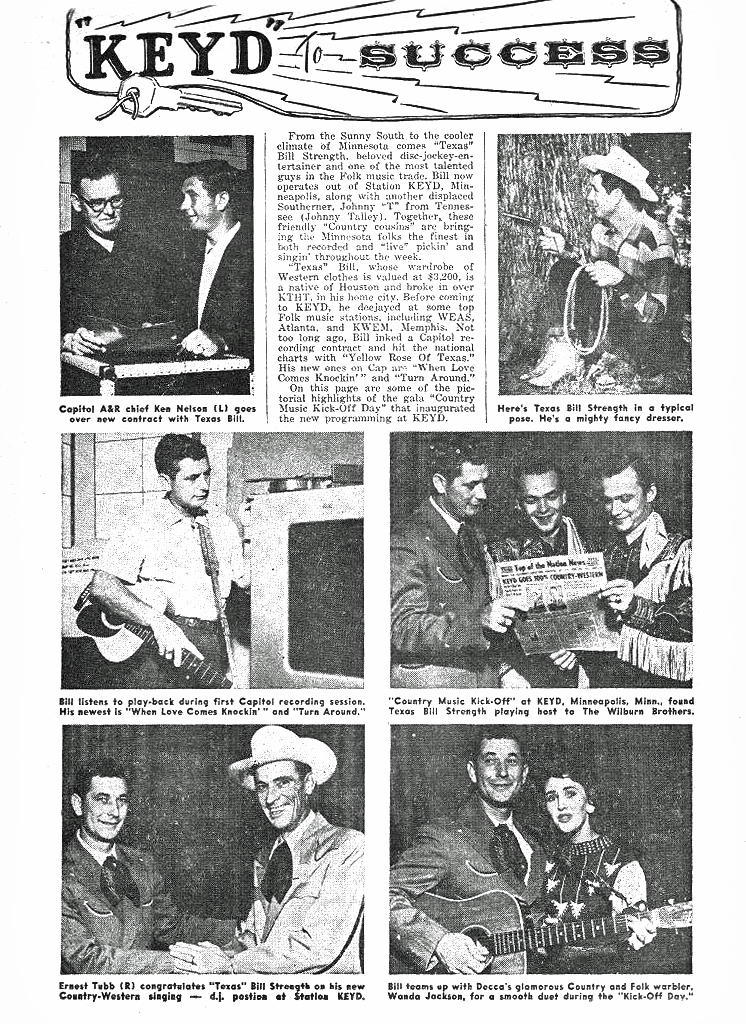
December 1955
The ad below for KEYD announced, “Now All Day – Country Western Music” and announced DJs “Texas” Bill Strength and Johnny “T” from Tennessee, and Slim Jim Iverson.
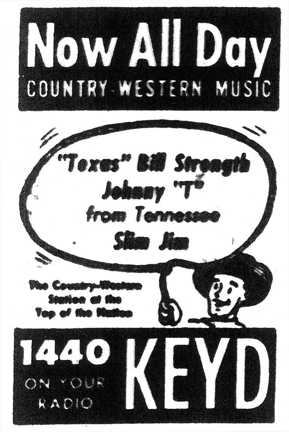
Minneapolis Tribune, December 1, 1955
Billed as Family Broadcasting, KEYD first signed on in 1948. From 1953 – 1955, announcers included Howard Viken, Don Riley, Harry Zimmerman, Slim Jim Iverson, and Slim Jim’s brother the Vagabond Kid. Those last three had a show called “Record Rodeo.” The format included several types of shows, including country, Top 10, Gospel, and others.
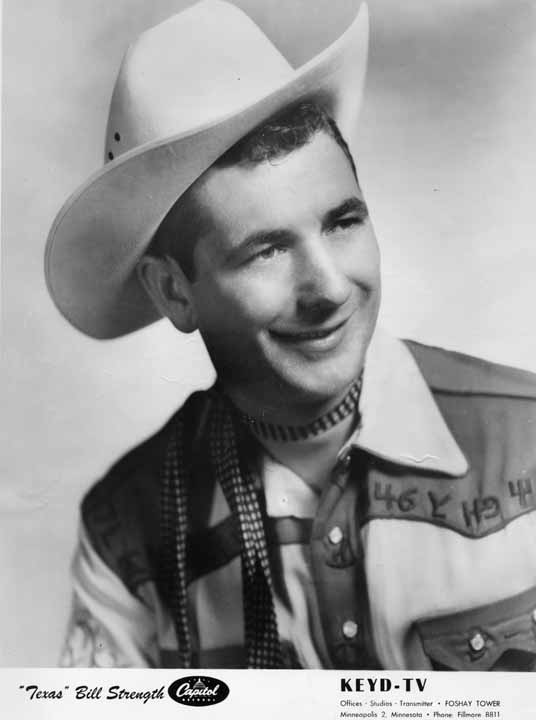
Photo courtesy Dale Strength
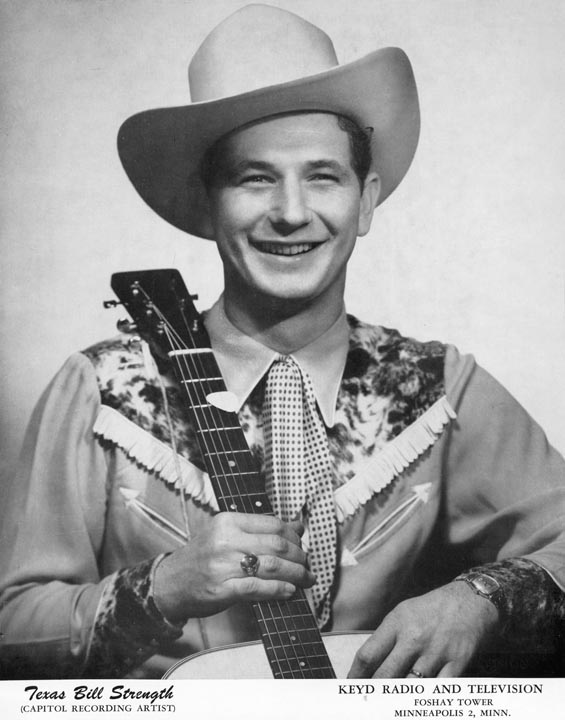
Photo courtesy Dale Strength
Bill’s personal appearances began right away.
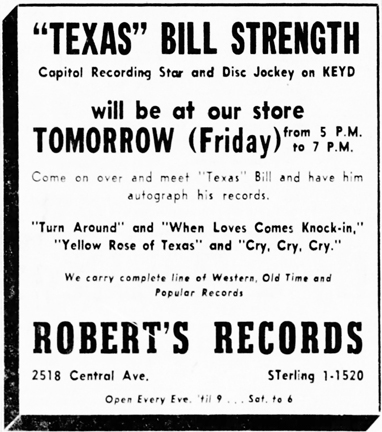
Minneapolis Star, December 22, 1955
On December 31, 1955, A.V. Bamford produced a “Grand Ole Opry” package at the St. Paul and Minneapolis auditoriums. Faron Young will resume activity, following his lengthy illness. Others on the bill were:
- The Wilburn Brothers
- Porter Waggoner
- Marvin Rainwater
- Jim Edwards and Maxine Brown
- Texas Bill Strength, emsee
- Johnnie Talley
- Bobby Lord
- The Wagon Masters Trio
(Billboard, December 24, 1955)
TBS is listed as one of many C&W DJs who double as Wax Artists. His label is Capitol and his station KEYD, Minneapolis. The most successful C&W deejay operating in the personal management field, of course, is Bob Neal, WMPS, Memphis, who manages Elvis Presley.
(Bilboard, December 31, 1955)
ROUNDUP more MONEY with TBS
An undated but undoubtedly early publication was a promotional brochure put out by KEYD to sell TBS to potential advertising sponsors. It has great photos which we’ll try to do justice to here.
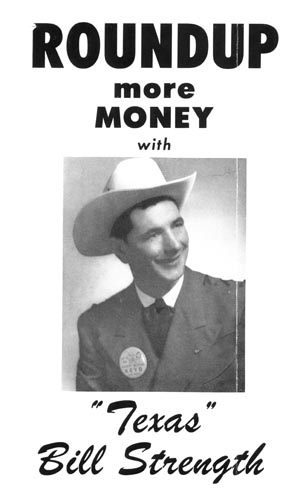
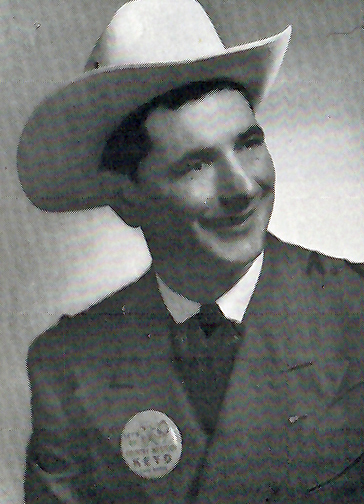
Closeup of the photo above.
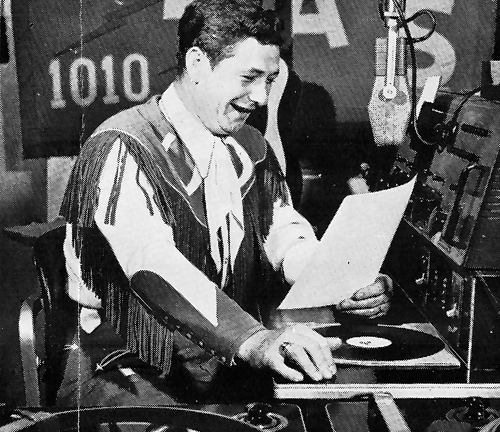
This photo was apparently taken at WEAS in Atlanta.
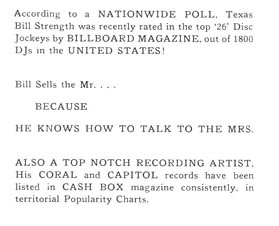
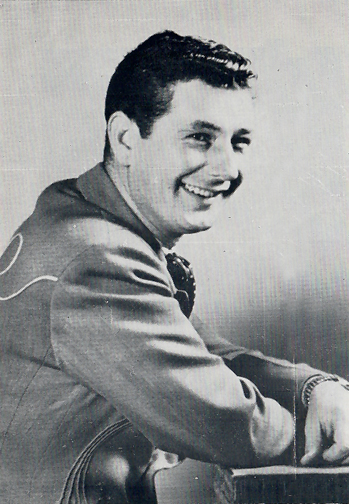
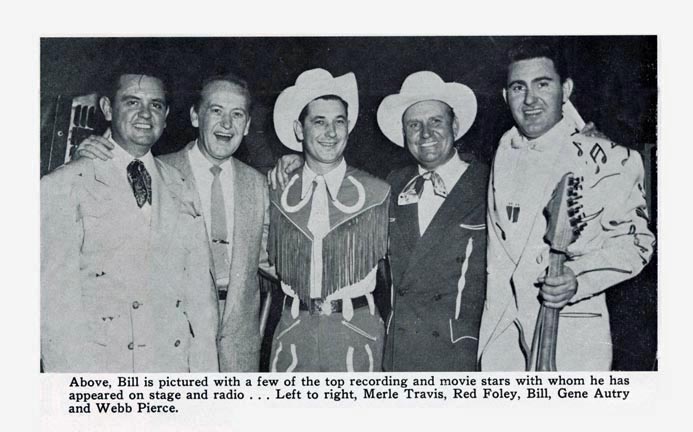
Bill (center) is pictured with Merle Travis, Red Foley, Gene Autrey, and Web Pierce. Photo courtesy Dale Strength
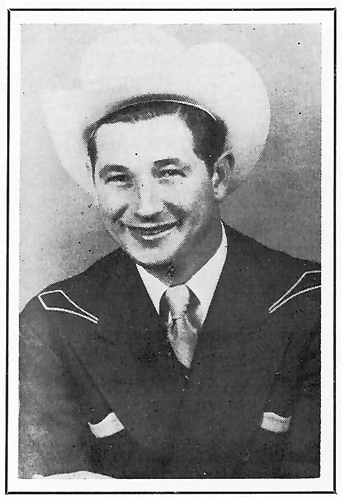
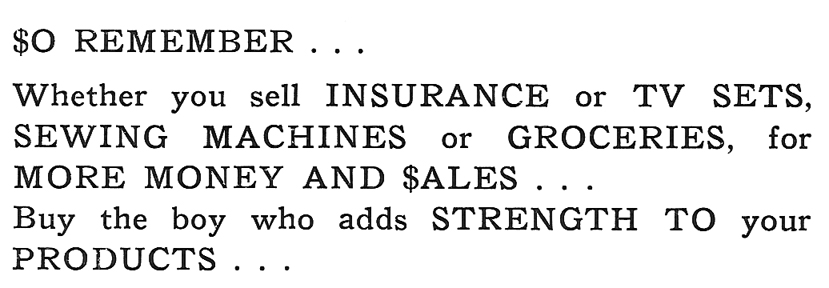
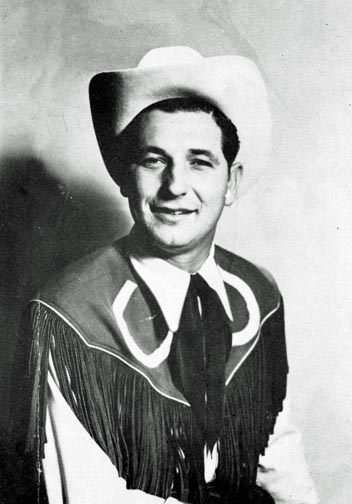
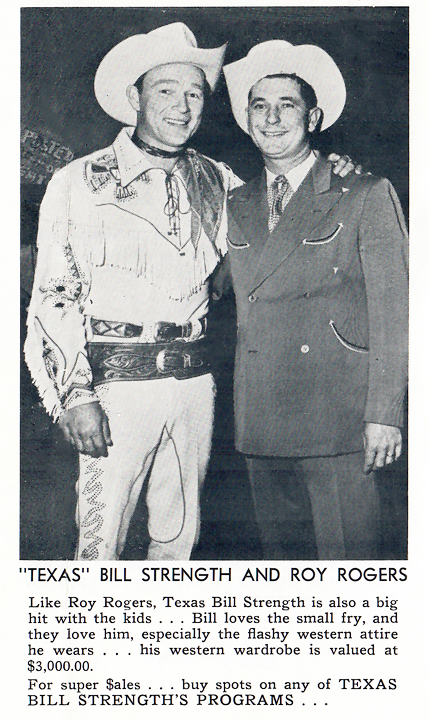
1956
In the 1956 Minneapolis phone book, TBS was listed as living at 902 Second Ave. So., identified in permit records as the Holland Hotel. The Hotel was demolished in August 1959. It is now the site of the Oracle office towers, 900 2nd Ave. So., built in 1984.
January 1956
Jimmy and Ardis Wells and Their Dakota Round-Up, along with the Royal Rangers, are holding forth nightly at the Flame Supper Club, Minneapolis. Appearing with them each Wednesday night is TBS, who now spins the country wax on KEYD, Minneapolis. (Billboard, January 21, 1956)
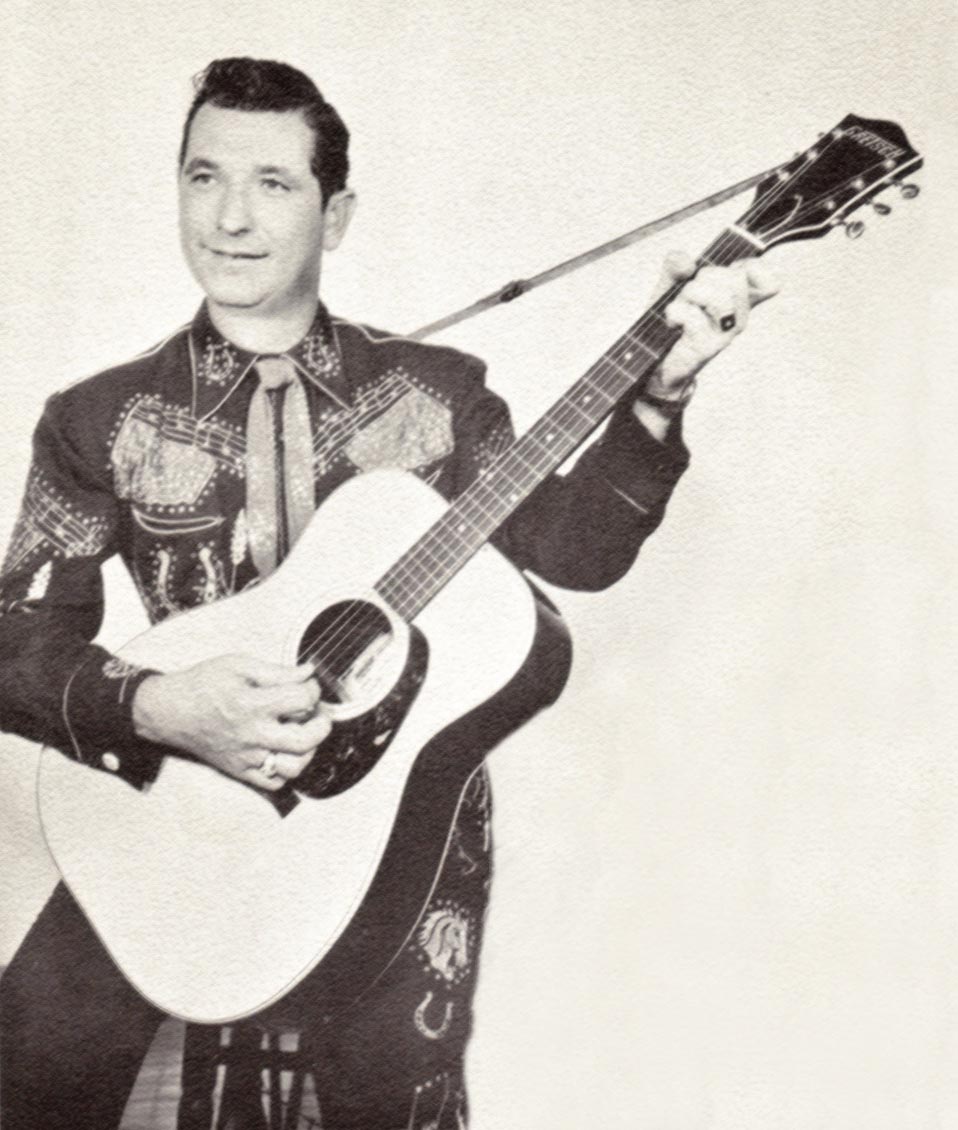
Undated photo, courtesy Dale Strength
On January 29, 1956, TBS guested on “Grand Ole Opry” with Faron Young. (Billboard, February 11, 1956.)
He also appeared on the “Ernest Tubb Jamboree” over WSM, Nashville. (Billboard, February 11, 1956.)
WILL JONES
A wealth of information was provided through the years in the daily “After Last Night” column by Will Jones in the Minneapolis Tribune. On January 29, 1956, Jones wrote about the arrival of TBS and Johnny T in this fanciful article:
“Transcribbled” Music Makes KEYD Hillbilly Dream Land
One of my favorite outdoor sports, when driving in places like Tennessee and Oklahoma, is to turn on the car radio and listen to the local radio stations.
Thanks to KEYD radio’s new staff of imported hillbillies, the long drive is no longer necessary. It’s almost as good as a winter vacation to drive through the Twin Cities’ slush with the car radio tuned to 1440.
Practically any time of day you can pick up the whining git-tars, the insistent beat, the mush-mouthed announcer that go with an all-out hillbilly station.
A man named Texas Bill Strength (pronounced strenth) plays and exclaims over the national anthem (“The Yellow Rose of Texas”). A man named Johnny T from Tennessee carries on endlessly over the delights of corn bread & pot likker, soppin’ gravy & biskits.
“I don’t say y’all don’t have gewid kewiks up north here,” says Johnny T the other day. “Lots of southern ladies have moved up north.”
These new citizens of the Twin Cities are learning their way around fast. Their first week on the air, they complained about frozen ears.
A batch of assorted earmuffs promptly came in the mail.
Other staff members at KEYD – old-timers – looked on enviously and reported: “These guys weren’t on the air two days before listeners started sending them big, beautifully-decorated cakes.”
Texas Bill plays a record for Mrs. Harry B. out in Balloominton” and then asks: “Whar’s Balloominton?” He has a sponsor whose address is 1201 Hormone place.
Texas Bill is also a philosopher, reciting lines like: “Blessed are they that walk around in circles, for they shall become Big Wheels.”
The world Texas Bill and Johnny T dwell in is filled with titles like “You Clobbered Me,” “Ink Dries Quicker Than Tears,” and “Lie Detector,” and tenderly sentimental lines like, “Take your cotton-pickin’ hands off my girl.”
It is a world populated largely by broken-hearted lovers and cheatin’ husbands and wives. It is also a world of gang love, with three girls pining in harmony for three lovers – I think I’ve got the names straight – Jack, Johnny and Jonas.
These tunes are neither recorded nor transcribed. In the words of Johnny T, they are “reseeded and transcribbled.”
The man who brought all this salt port and greens to the Twin Cities is Robert Purcell, a towering, dignified, gray crewcut Madison Avenue type by way of Hollywood.
He’s never run a hillbilly station in his life, and, except for playing an expensive guitar as a hobby, knew nothing about the music until a few weeks ago. His label for it – the music trade label – is country-and-western, frequently abbreviated these days to C. & W.
Purcell was brought here last year to inject new life into KEYD.
“For a while we considered going top-10-tunes kind of operation,” said Purcell, and competing with the stations that are already doing that. We already had a little top-10, plus a little classical, and a little semi-classical, and a little religion, and a little bit of everything. A friend of mine came to town, a man who books country-western shows like Grand Ole Opry for auditoriums. He takes these shows all over the country. He told me this was his second-best territory. Denver, I believe, was first. If it was such good territory for him, I reasoned that a country-western station should do well too. To do it right, we brought in a couple of top country-western personalities. Getting Texas Bill and Johnny T to play country-western is about on a par with getting Frankie Laine and Rosemary Clooney as disk jockeys for the top-10 market.
“So far it’s been very successful, and we’ve found out something else: this kind of programming is more compatible with religious programming. Or at least, the people who listen to one kind of program are less offended by the other.”
February 1956
THE FLAME
As noted above, the first mention of TBS at the Flame appears to be January 21, 1956, in Billboard. Here at home, on February 1, 1956, columnist Cedric Adams wrote:
Western music has spread out a good deal in the last few years and now it takes over a Minneapolis theater café. The Flame at Sixteenth and Nicollet experimented with a western band for a couple of nights and found the customers liked it, so now makes it regular policy. Johnny T and the Tennesseans, one of the top country and western bands, moves into the place tonight and square dancing and other hoppity steps are the rule. The Flame goes whole hog on the theme, using the Dakota Roundup troupe in the lounge, with special Wednesday night appearances by Texas Bill Strength, the hillbilly singer. Any square dance group, incidentally, can bring its own caller along, so you may hear some verbal improvisations. (Minneapolis Star)
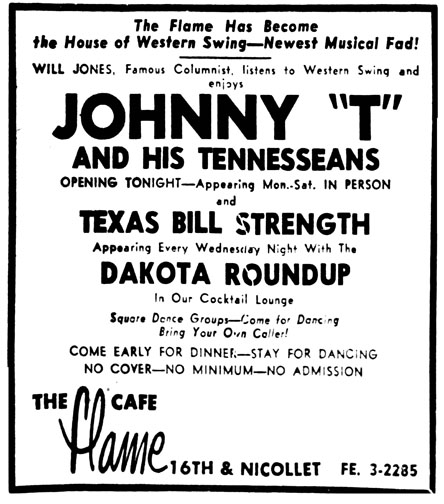
Minneapolis Star, February 1, 1956
The Flame had yet to adopt its distinctive rope font that makes its ads so difficult to find!
Although the photo below implies that it was taken at the Grand Ole Opry, Dale Strength has labeled it as coming from the Flame. It must be an early photo, as TBS’s guitar still has its decorative top.
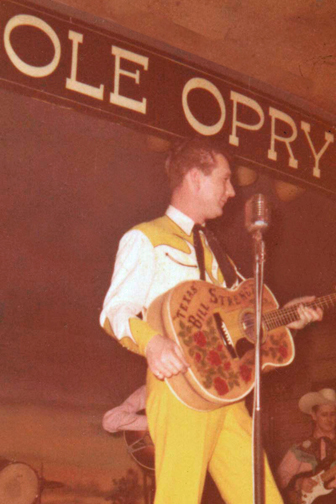
Photo Courtesy Dale Strength
On February 2, 1956, Will Jones of the Minneapolis Tribune also noted the Western trend:
Western music has been a feature of the front bar [of the Flame] for a number of years, but it didn’t invade the big back room until last week. The management tried out Johnny T and his Tennesseans, liked them, and hired them as an every-night attraction.
The Dakota Roundup continues in the front bar, with Texas Bill Strength as a regular Wednesday night guest.
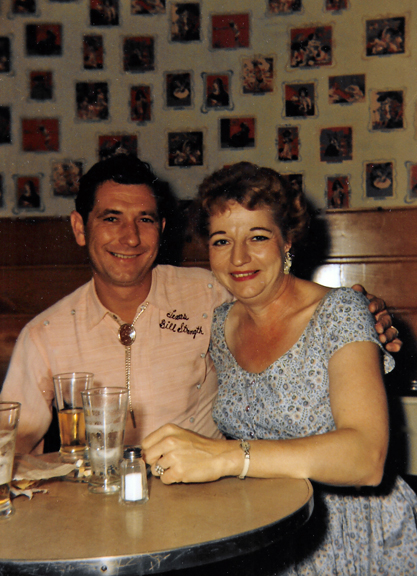
TBS with fellow Flame entertainer Fern Dale at the Flame. Phot courtesy Dale Strength
THE GAY NINETIES
In Will Jones’ column of February 2, 1956, he wrote that “The Gay Nineties has also gone western, with Dave Dudley’s band every night and Texas Bill as a guest Tuesday, Friday, and Saturday nights.
Billboard kind of confirmed this account on February 11, 1956: “Dave Dudley (King) and His Country Caravan have moved into the Gay 90’s, Minneapolis, for an indefinite stand. Guesting there each Tuesday night is TBS, who’s now spinning the country wax over a local station.”
TBS was the feature on “Barnyard Frolic” over KLRA, Little Rock. (Billboard, February 5, 1956)
On February 11, 1956, TBS played a repeat on the Pee Wee King show over WBBM, Chicago. (Billboard, February 18, 1956)
THE MINNIE AWARDS
The annual Minnie Awards took place on February 15, 1956. These TV and Radio awards were sponsored by the local chapter of AFTRA and the Advertising Club of Minneapolis, and probably morphed into the local Emmy awards. TBS won one of the five categories for “Hillbilly” performers – best male singer on the TV side, representing KEYD-TV. Slim Jim won best hillbilly-western personality (KEYD-TV), Harry Siles won best farm show personality (WCCO-TV), and Hall Garven won best hillbilly-western personality (WCCO radio). Will Jones reported:
When TBS was proclaimed best male singer, there were a few raised eyebrows around the Minnesota Terrace and a number of people asking “Who’s he?” (A Twin Cities newcomer, Strength could refer them to Capitol records for some answers. They credit him with five top-selling national record hits, including “The Yellow Rose of Texas.”)
Texas Bill’s popularity was proven by the 1,200 to 1,500 letters he claimed he received when asked in 1970. Although most of it was fan mail, some Minnesotans were not ready for either Country nor Western music. Ronnie Pugh wrote of a dean at Augsburg College who urged readers of the school paper to help keep the odious genre out of the area. “I answered him over the air,” said Bill. “I really chewed him out … told him that he would see the day when country music would come into its own as respectable music.”
TBS himself was enjoying amazing popularity in nationwide polls: one year he was Number 22, and another he was Number 26, out of about 1,800 considered. (Ronnie Pugh)
The Grand Ole Opry came to the Twin Cities several times in 1956. The TV show was sponsored by Pillsbury, and shown on 120 stations around the country. The TV show’s contract required that a troupe visit each of the 120 communities that gets the show on TV at least twice per year. The four troupes were headed by Roy Acuff, Webb Pierce, Hank Snow, Ernest Tubb and Faron Young. (That’s five but that’s what Will Jones said.)
The February 16, 1956 show featured:
- Hank Snow
- Jean Shepard
- Little Jimmy Dickens
- Lonzo and Oscar
- Hawkshaw Hawkins
- Tommy Warren
TBS and Johnny T shared emcee duties.
(Minneapolis Tribune, February 16, 1956)
CAPITOL RECORDS
On February 23, 1956, TBS had his second recording session at Capitol Records in Hollywood under Ken Nelson, the label’s Country A&R chief. He cut four sides:
- ”When the Bright Lights Grow Dim”
- ”It Ain’t Much But It’s Home”
- ”Where Did My Heart Go”
- ”Gotta Lotta Love”
Capitol F3394 was released in April 1956 and Billboard reviewed it on April 14, 1956:
- “When the Bright Lights Grow Dim” – “A moving reading by Strength on a plaintive weeper with effective lyrics.”
- b/w “It Ain’t Much But It’s Home” – “A strong vocal job on an appealing up-tempo tune with clever lyrics.”
Capitol F3477 was released in mid-July 1956, and Billboard reviewed it on July 14, 1956:
- “Where Did My Heart Go?” – “Sincere warbling on a moving ballad with effective lyrics.”
- b/w “Gotta Lotta Love” – “Up-tempo tune is wrapped up in a strong vocal stint and a good beat.”
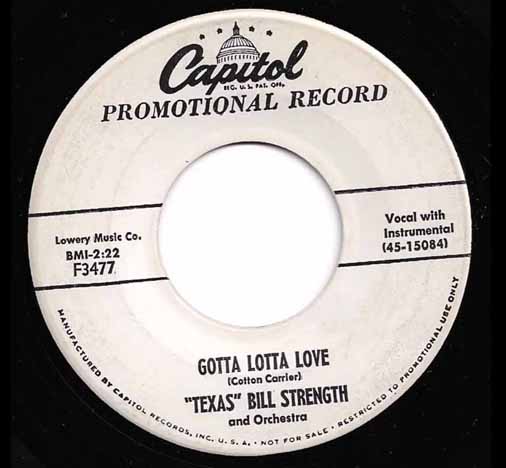
On September 6, 1956, the Pike County, Pennsylvania, Dispatch, commented, “TBS does well with a sad ‘un, “Where Did My Heart Go?” “Gotta Lotta Love” backs it to make a good combination.” The press release apparently described “Where Did My Heart Go?” as “a sad ‘un,” since it was described that way from Milford, Pennsylvania to Chula Vista, California.
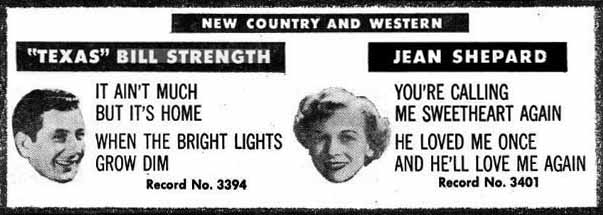
A rare promotional ad in Billboard, April 4, 1956
March 1956
In its Radio News column, the headline was “Texas Bill Warbles in Color”: “KEYD’s “Texas Bill” Strength appeared in a color telecast while he was in California cutting records.” (Minneapolis Tribune, March 5, 1956)
Jimmy and Ardis Wells and their Dakota Round-Up continue to hold forth at the Flame Supper Club, Minneapolis, where Johnny T. and His Crazy Tennesseeans carry on it the club’s rear room each Friday and Saturday night. TBS, now spinning the country wax over a Minneapolis station, appears as guest with Jimmy and Ardis each Wednesday night. The Flame devotes two nights a week to country music exclusively. (Billboard, March 17, 1956)
April 1956
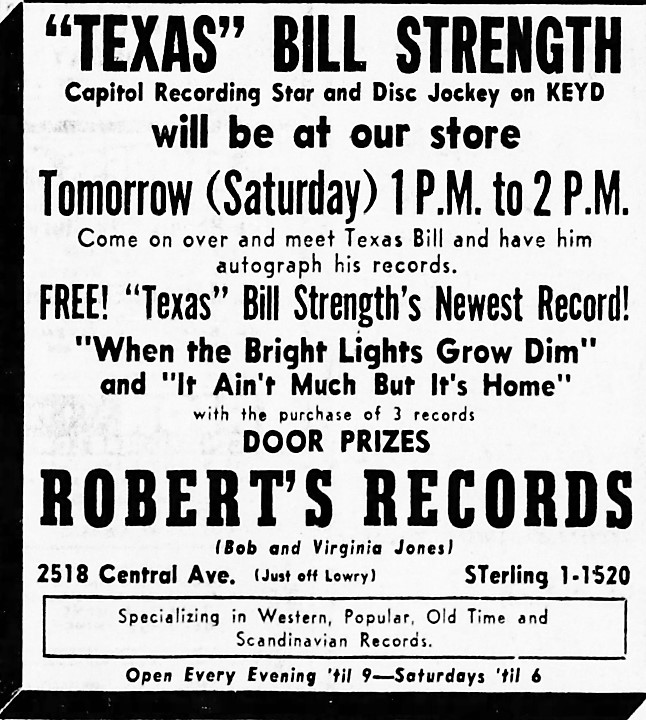
Minneapolis Star, April 6, 1956
Ardis Wells and her all-girl band, the Rhythm Ranch Queens, has opened in the front room of the Flame, Minneapolis, with Jimmy Wells and the Dakota Round-Up Gang holding forth in the Flame’s rear room. TBS (Capitol) is a nightly guest at the spot. (Billboard, April 14, 1956)
The endorsements and appearances continued – this one for King Dodge:
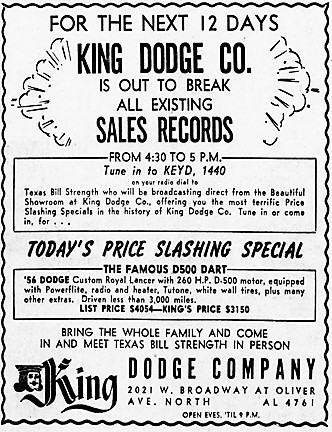
Minneapolis Tribune, April 17, 1956
On April 29, 1956, TBS (Capitol) emseed the “Grand Ole Opry” package, at the St. Paul Auditorium. The show featured:
- Webb Pierce
- Jim Reeves
- Hank Locklin
- Charline Arthur
- Farmer Boys
Billboard, May 5, 1956
May 1956
TBS was featured on the May 1956 cover of Cowboy Songs.
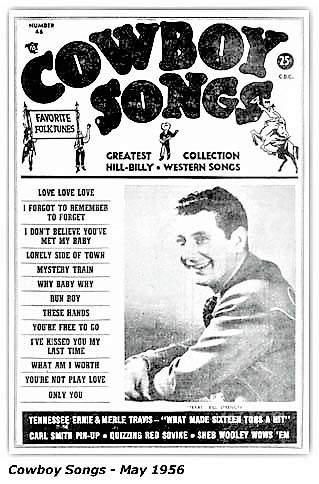
Image courtesy Dale Strength
Bill says he’s working a seven-day-a-week schedule, but will take time out to greet his friends at the MOA convention in Chicago, May 6-8, and the Jimmie Rodgers Memorial Celebration in Meridian, Mississippi, May 25-26. (Billboard, May 5, 1956)
REUNION WITH ELVIS
On May 13, 1956, Elvis was in town for concerts in Minneapolis and St. Paul, and was less than well received – opener Augie Garcia whipped up the audience so much than an apoplectic Tom Parker had him kicked off the stage. But TBS was glad to see his old friend.
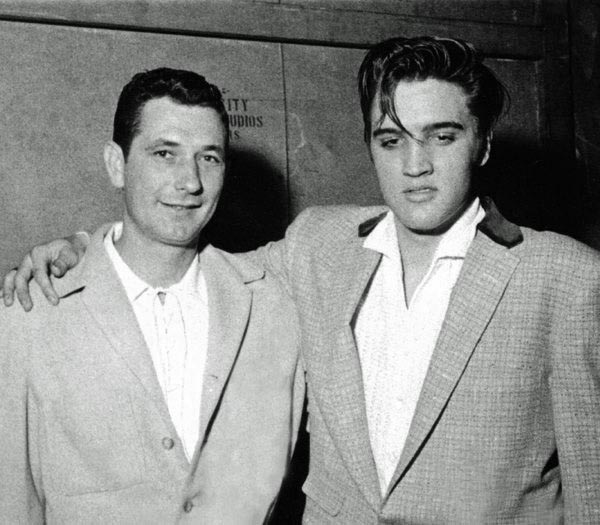
Photo courtesy Dale Strength
TEX RITTER KICKS OFF NATIONAL STARS AT FLAME CAFE
Will Jones announced the addition of national Western stars to the Flame:
Tex Ritter, singing cowboy, will be the first of a string of western names to be booked into the Flame Café. He will appear there next Wednesday night. [May 16, 1956]
On later Wednesday nights the spot will offer Tabby West, Betty Foley, Marvin Rainwater and Bobby Lord – all of whom I have been assured are big names in the western music field. (Ritter I’m sure of, largely because of “High Noon.”)
On nights other than Wednesday, the Flame is still all-western, with Ardis Wells and the Rhythm Ranch girls in the front bar, and Jimmy Wells and the Dakota Roundup in the back room. (Minneapolis Tribune, May 10, 1956)
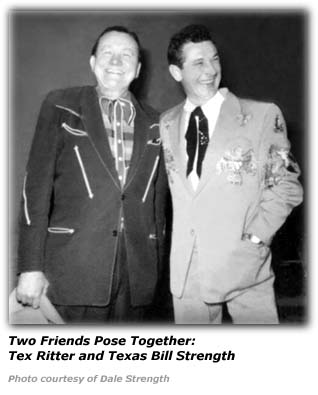
May 16, 1956, was the first time we see TBS in an ad for the Flame Cafe. TBS was on most/all of the Flame ads for 1956. Jimmy Wells and the Dakota Roundup was the house band in the show room. Jimmy’s wife Ardis Wells had her own band, the Rhythm Ranch Gals, in the Cocktail Lounge.
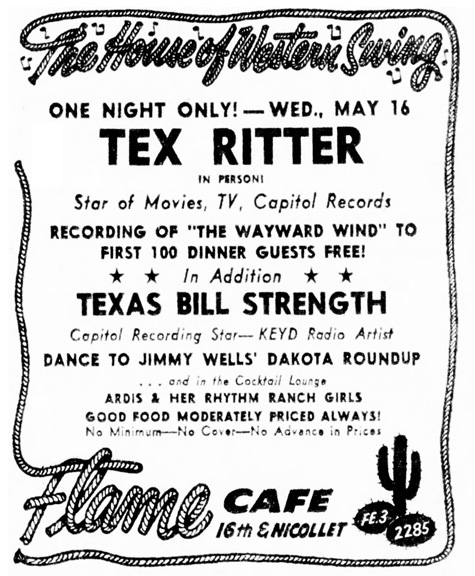
Minneapolis Tribune, May 1956
Texas Bill’s co-star at the Flame on May 23, 1956, was Tabby West. Bill had made a 45 with Ms. West on Coral Records in 1954.
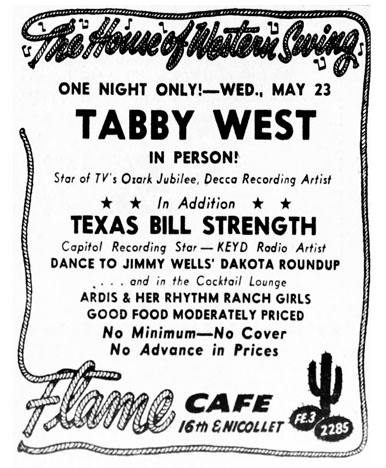
Minneapolis Star, May 22, 1956
RADIO ROULETTE
On May 25, 1956, rival country station WCOW was renamed WISK and the format changed from full-time Country & Western to a combination of Lombardo/Welk/etc. and an occasional Top 10 tune. This left KEYD as the only full time C&W station in the Twin Cities area.
JIMMIE RODGERS CELEBRATION
The fourth annual Jimmie Rodgers Memorial Celebration was held on May 25-26, 1956, in Montgomery, Alabama. Ernest Tubb, Hank Snow, and TBS appeared. Coverage of the event was considerably scaled down from the year before.
Appearing at the Flame from May 30 to June 2, 1956 were:
- Betty Foley
- The Westerners – the World’s only Square Dance Roller Skaters
- TBS
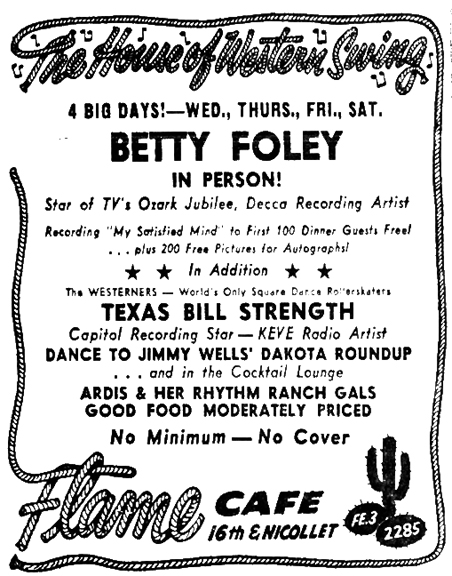
Minneapolis Star, May 29, 1956
June 1956
Headlining at the Flame on June 6-9, 1956 were Marvin Rainwater and TBS.
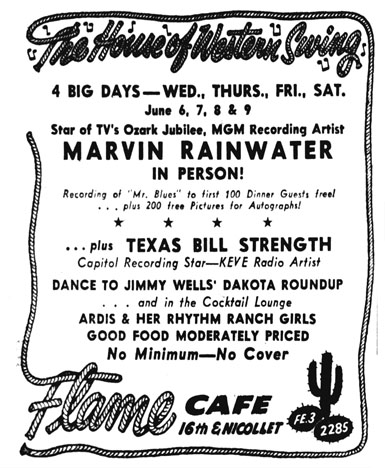
Minneapolis Star, June 5, 1956
TBS was quite a handsome sight at the Flame, decked out in his Nudie suits and all the accoutrements of a rhinestone cowboy.
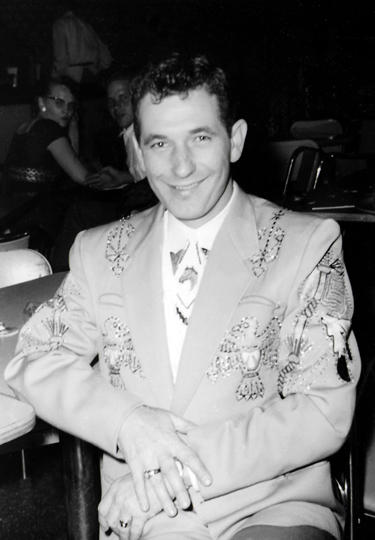
Photo courtesy Dale Strength
TBS and Johnny T are still flipping C&W platters weekdays over KEYD, Minneapolis, with Vern Weegman gaining in recognition with his country shows over the same station on Saturdays. (Billboard, June 9, 1956)
KEVE
In June 1956, KEYD was sold, changed its call letters to KEVE, and played full time Country and Western – one of the first in the country to do so. [The format changed to classical music in 1961. It became KQRS on December 1, 1964.]
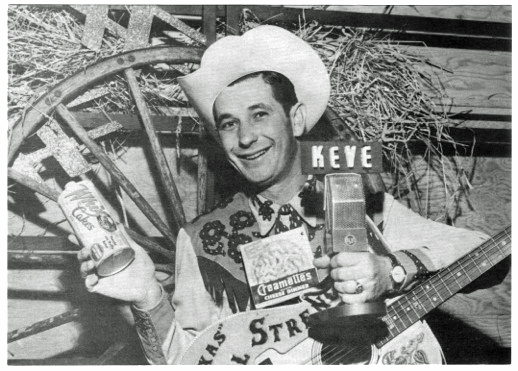
Photo courtesy Dale Strength
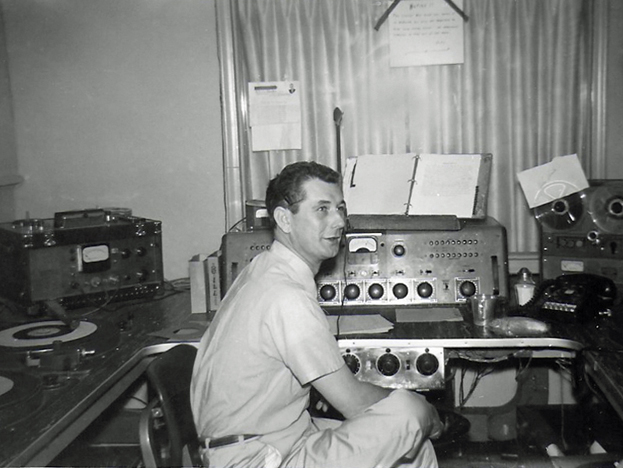
TBS at the KEVE Console. Photo courtesy Dale Strength
TEXAS BILL BOOKS THE FLAME
TBS urged record companies to send new releases to the new KEVE call letters. He says he’s now booking talent into the Flame. (Billboard, June 23, 1956)
Indeed, TBS had become a booking agent and emcee for the Flame and brought in major Country acts, most of whom were already personal friends. These included Jim Reeves, Johnny Cash, Ernest Tubb, Hank Snow, Hank Thompson, and Carl Smith. He performed several nights per week himself in the Lounge, and opened the Main Room shows for the bigger acts. An additional draw was that he would take his friends hunting and fishing if they were so inclined. (Ronnie Pugh)
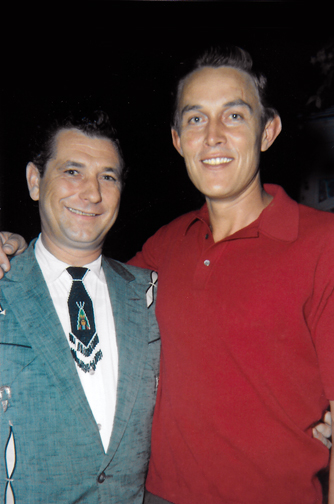
TBS with Jimmy Dean – Photo courtesy Dale Strength
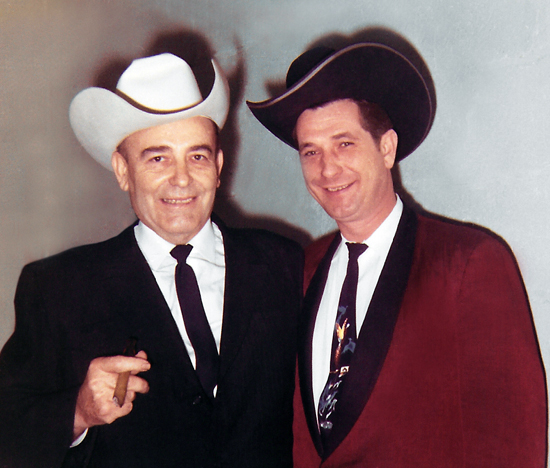
Bob Wills and TBS – Photo courtesy Dale Strength
COUNTRY MUSIC DISK JOCKEY CONVENTION
The Country Music Disc Jockeys Assn. (CMDJA) was organized at an event called “The Convention,” which was the second year of a birthday party for the Grand Ole Opry given by Radio Station WSM in Nashville.
The organization was officially chartered on November 21, 1953, at the Andrew Jackson Hotel, with 76 charter members, including TBS. By April 1, 1956, the list had grown to 150, including TBS, a “giant in the industry today.” “By 1958 it was apparent that there was a need for an all-industry association, in which the disk jockey would be an integral part, and the Country Music Association was born.” (Billboard, October 16, 1971)
On Thursday through Saturday, June 14 – 16, 1956, TBS participated in the Association’s first convention at the Colonial Hotel in Springfield, Missouri. The purpose of the 1956 gathering was to further public acceptance of country music.
On Thursday night, visitors attended the “Eddy Arnold Show,” featuring Arnold and Chet Atkins.
Friday afternoon was dedicated to the board meeting. After that came a chicken and dumpling lunch sponsored by Red Foley’s “Ozark Jubilee.” On Friday night a show was held at the Jewell Theater – a “corker” – with some 1,200 in the audience. The four-hour show was emceed by Red Foley and Sonny James and featured:
- Bill Wimberly’s Band
- Nelson King
- The Bonn Sisters
- Brenda Lee
- Uncle Cy Brasfield
- Johnny Horton
- The Philharmonicas
- Lebby Horne
- Pete Stamper
- Jim Edward, Maxine, and Bonnie Brown
- Billy Walker
- The Carlisles
- Johnny Cash
- TBS
- Smiley Burnette
- The Foggy River Boys
- Red and Betty Foley
- The Belew Twins
- Chet Atkins
- Janis Martin
- Audrey Williams
- Chuck Bowers
- Earl Bowers
- Bonny Gan
- Roy Drusky
- Jerry Reed
- Slim Wilson
- The Westport Kids
- Junior Haworth
- Shirley Caudel
- Warren Smith
- The Ferguson Sisters
The show raised $1,219 for the organization’s treasury.
On Saturday night the conventioneers were in the audience for Red Foley’s “Ozark Jubilee,” which emanated from the Jewell Theater. Late Saturday, Red Foley Enterprises and Decca Records hosted everyone with a cocktail and supper party. Winding up the festivities Saturday night was the awarding of a plaque to the “Ozark Jubilee” crew by the CMDJA members.
(Billboard, June 23, 1956 – article by Bill Sachs)
According to the ad below, TBS was also at the Flame on June 13 – 16, 1956, with Bobby Lord and Wanda Jackson. This overlapped with the covention described above.
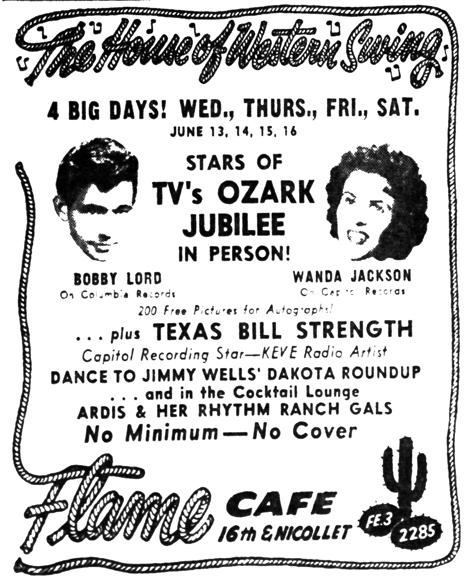
Minneapolis Tribune, June 12, 1956
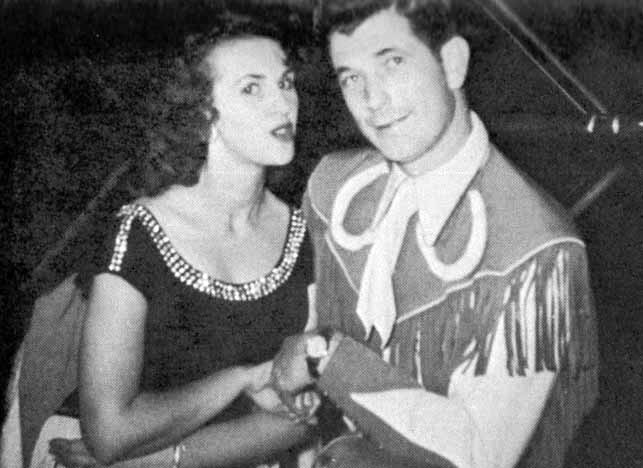
Texas Bill and Wanda Jackson
From June 20-23, 1956, TBS shared the Flame stage with Billy Walker and the Westerners.
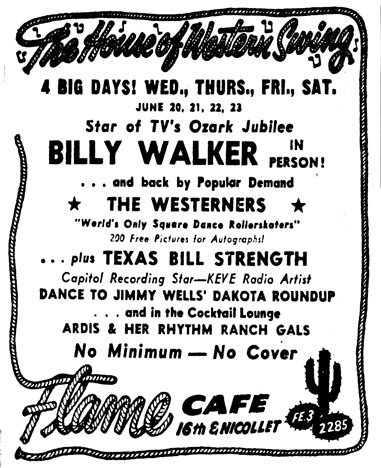
Minneapolis Star, June 19, 1956
On June 20, 1956, Kenny Roberts, whose TV show is now on four days a week over WHIO, Dayton, Ohio, plays the Flame Supper Club with TBS and group. (Billboard, June 2, 1956) (Does not jibe with ads)
On June 21, 1956, TBS made a personal appearance and remote broadcast at a Plymouth dealer.
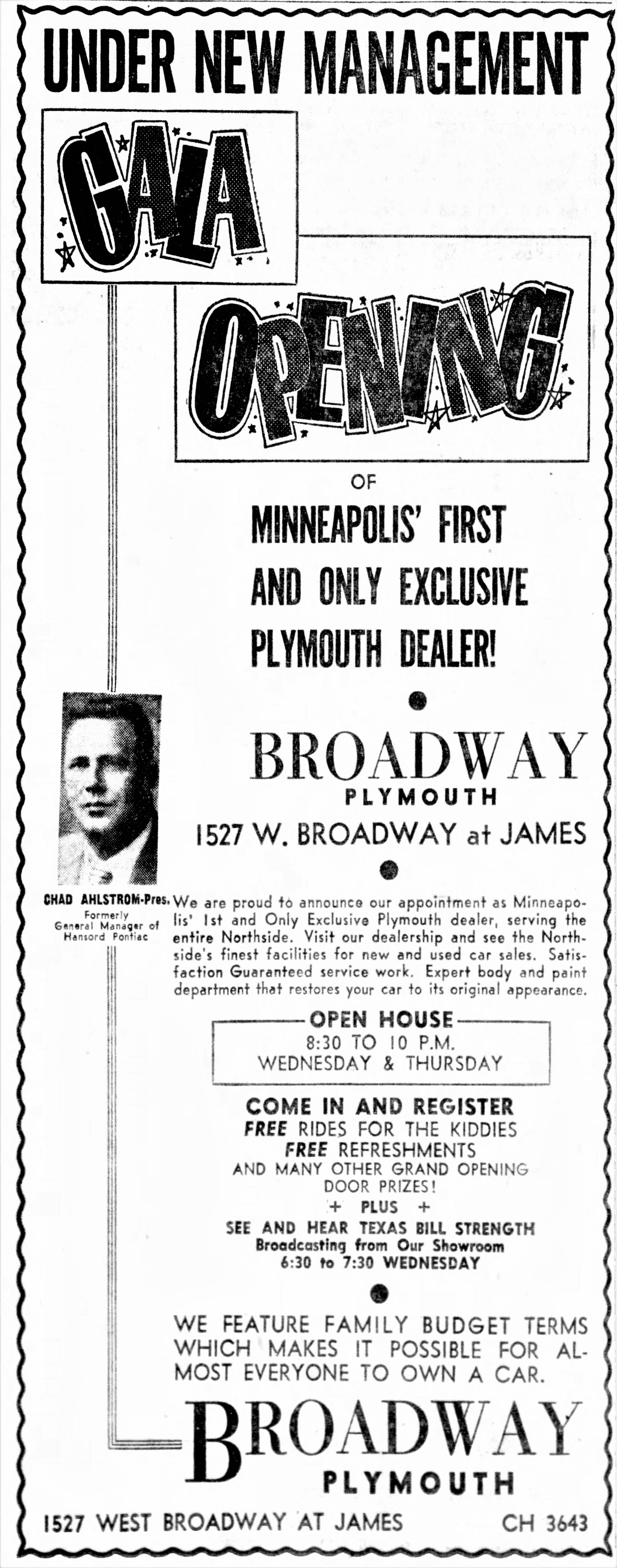
Minneapolis Tribune, June 21, 1956
On June 27 – 30, 1956, TBS was on the Flame bill with Mac Wiseman.
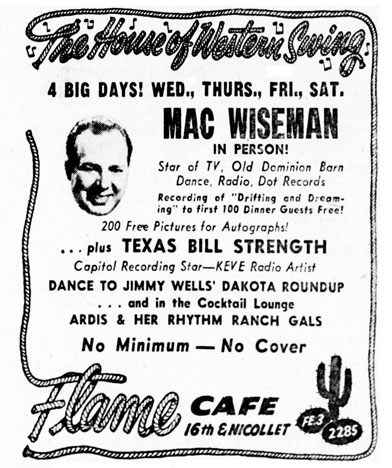
Minneapolis Star, June 26, 1956
July 1956
In July 1956, TBS was featured on the cover of Country & Western Jamboree magazine. Only a few short paragraphs were devoted to Bill inside, but the magazine did mention he was the number one rated Disc Jockey in the Minneapolis-St. Paul metropolitan area.
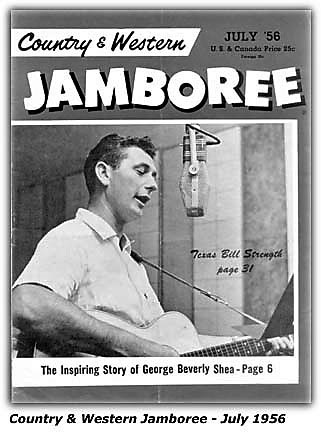
Image courtesy Dale Strength
From July 4 – 7, 1956, Justin Tubb shared the stage with TBS at the Flame.
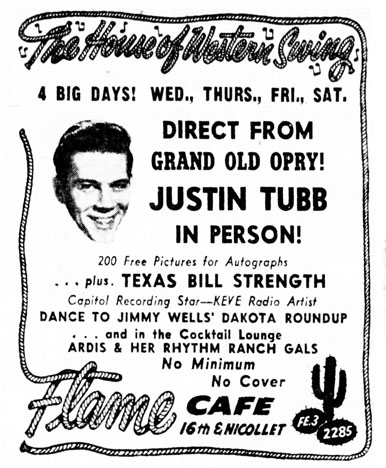
Minneapolis Tribune, July 3, 1956
From July 11 – 14, 1956, Arlie Duff was the guest with TBS at the Flame.
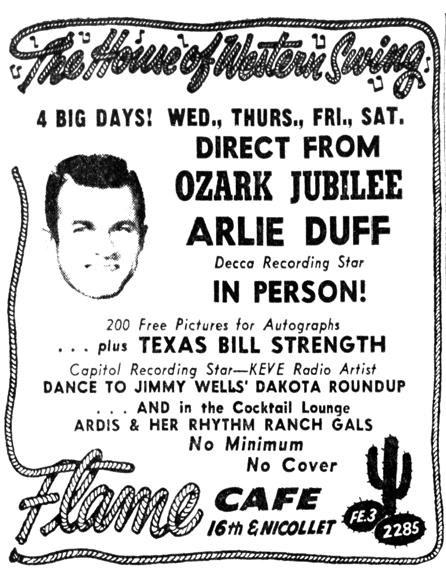
Minneapolis Tribune, July 10, 1956
From July 18 – 21, 1956, Jerry Reed was the special guest with TBS at the Flame.
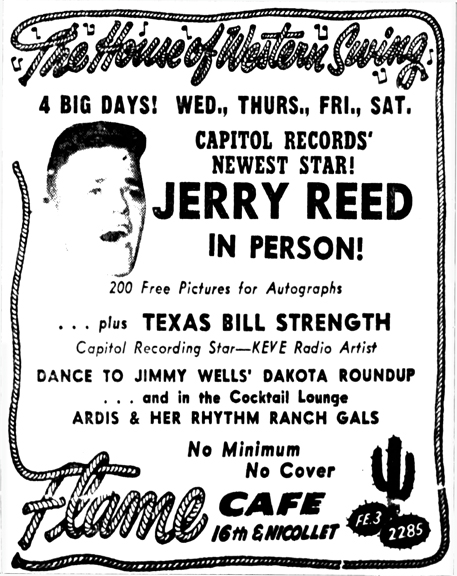
Minneapolis Tribune, July 17, 1956
From July 24 to 28, 1956, TBS shared the stage with Joe Carson and His Southernaires at the Flame. Carson subbed for Jimmy and Ardis Wells who took a vacation.
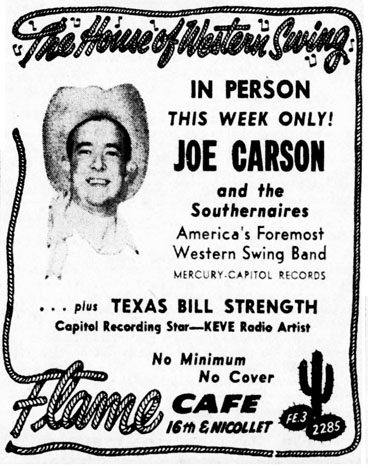
Minneapolis Tribune, July 24, 1956
RED FOLEY – JULY 28, 1956
On July 28, 1956, TBS appeared on Red Foley’s Ozark Jubilee out of Springfield, Missouri, which was broadcast nationwide on the ABC network. Other performers on the show were actor Cannonball (Dub) Taylor, and singers Johnny Bond and Red Garrett. Porter Wagoner hosted the first section and Foley took over for the second. (Houston Chronicle, July 28, 1956)
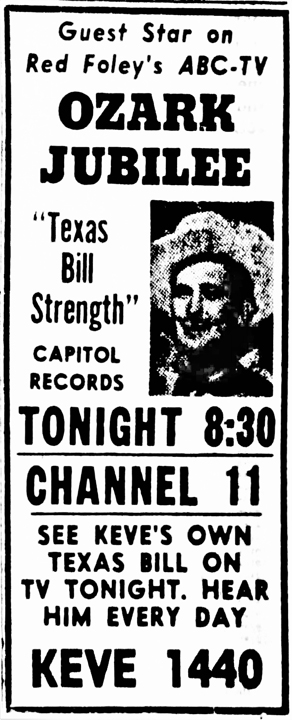
Minneapolis Star, July 18, 1956
This show was broadcast on Saturday, August 4, 1956, from 7:30 to 9:00 pm in Los Angeles. (Los Angeles Evening Citizen News, August 4, 1956)
August 1956
From August 1 to 4, 1956, Marvin Rainwater and TBS were to shared the stage at the Flame.
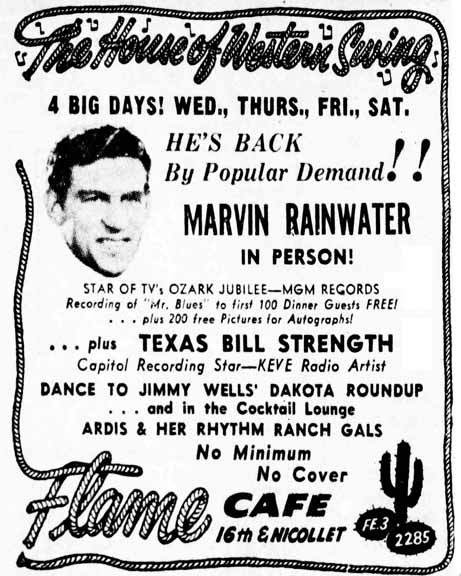
Minneapolis Star, Tuesday, July 31, 1956
CAPITOL RECORDS
But once again, he couldn’t be at the Flame and Hollywood at the same time. On August 3, 1956, TBS was back at the Capitol Recording Studio, cutting four sides. Or, in Billboard talk, “TBS, now working on a heavy schedule twirling the C&W biscuits at KEVE, Minneapolis, was in Hollywood last weekend to cut his third session for Capitol.” (Billboard, August 11, 1956)
- “North Wind“
- “But Do You Think I’m Happy“
- “I Wanna Ride, Ride, Ride (On Your Merry-Go-Round)“
- “I.O.U.“
Capitol F3568 was released in October 1956, and reviewed by Billboard on November 3, 1956:
- “But Do You Think I’m Happy?” – Strength sells with sock songmanship on an amusing rhythm-novelty by Justin Tubb, with good punch-line lyrics.”
- b/w “North Wind” – Appealing vocal treatment of a haunting ballad with sensitive lyric line.
I.O.U. was never issued, and “Merry-Go-Round” was paired with “Six Fools,” which was recorded later on February 25, 1957.
On April 27, 1957, Billboard reviewed Capitol No. 3701:
- “I Wanna Ride, Ride, Ride On Your Merry-Go-Round” – A slick bit of rhythmic wax with a story that has certain touches of double entendre. A happy and well handled version that could easily generate some jock and juke box action.
- b/w “Six Fools” – An unusual piece of material rendered in a minor key. Fancy banjo plucking backs the chanting. Side rates attention and could compete with the flip for plays.
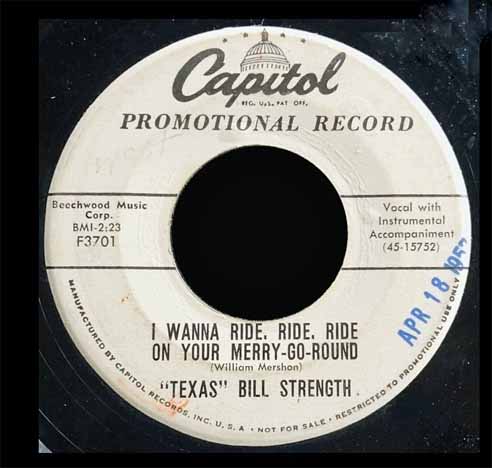
In the August 4, 1956, issue of Billboard, Verne Lotz wrote from Minneapolis: “I’m now with KEVE, the Twin Cities’ and Minnesota’s only all-country & western station. TBS (Capitol) and Johnny T. Talley, newly signed with Mercury, are spinning ‘em here also, as is Vern Weegman.
Mike Jann sent in this photo of TBS at a promotional event and remote broadcast on KEVE from King Dodge, August 1956. Mike says his camera was jostled, giving the picture a kind of echo effect …
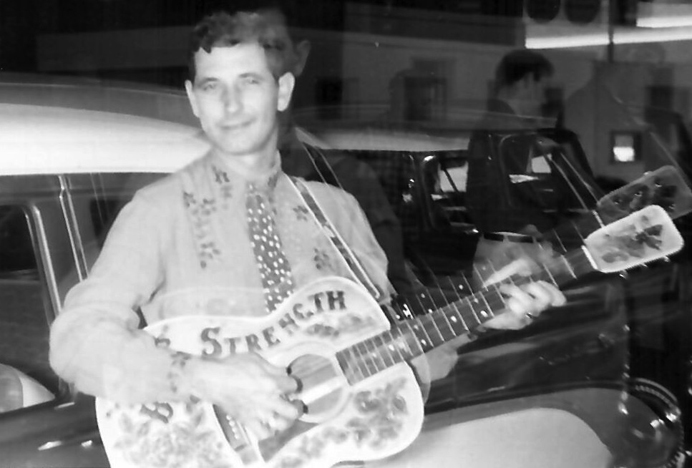
Photo courtesy Mike Jann
Below is Mike himself, at a remote broadcast with TBS on KEVE from the old Minneapolis Auditorium. The gentleman on the right is the radio engineer.
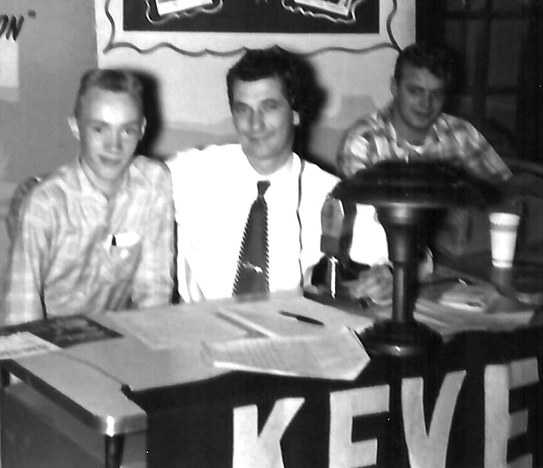
Photo courtesy Mike Jann
On August 8 and 9, 1956, Lee Emerson and the Everly Brothers starred with TBS at the Flame.
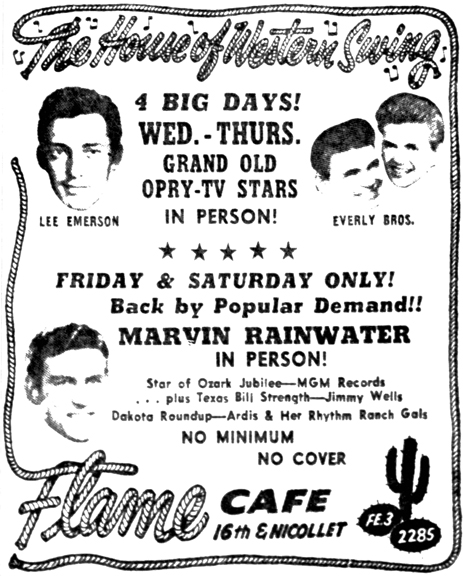
Minneapolis Star, Tuesday, August 7, 1956
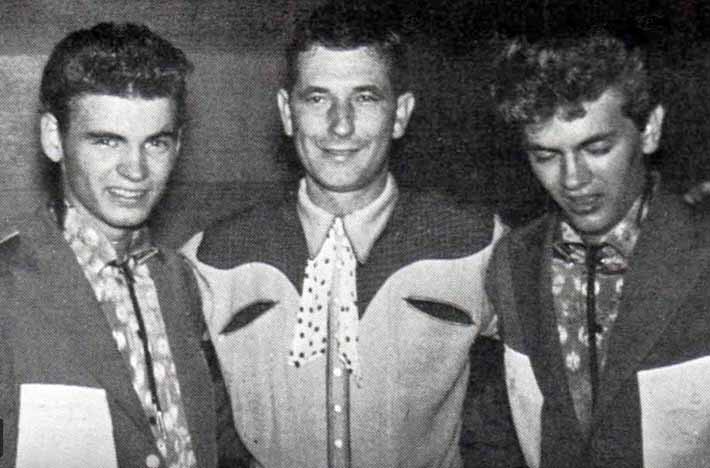
TBS with the Everly Brothers
On August 10 and 11, 1956, Marvin Rainwater and TBS rounded out the week at the Flame.
On August 15 through 18, 1956, Bobby Lord and TBS entertained at the Flame.
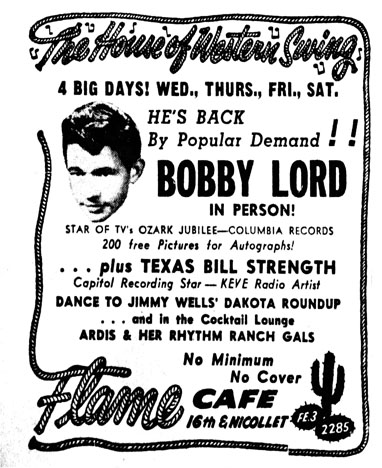
Minneapolis Star, August 14, 1956
Andy Williams visited with TBS at KEVE “last week.” (Billboard, August 25, 1956). Nothing comes up in a search for a country singer named Andy Williams, but dollars to donuts I’ll bet you it’s not the “Moon River” Andy Williams.
From August 22 to 25, 1956, Autrey Inman and TBS performed at the Flame, except that Del Woods and Bonnie Sloan are down for August 23.
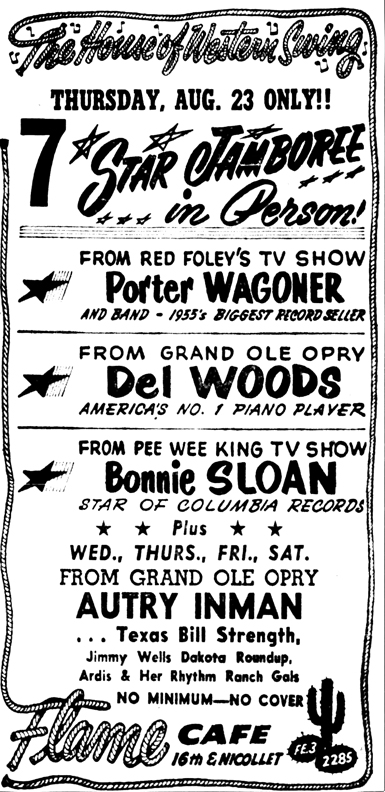
Minneapolis Tribune, Tuesday, August 21, 1956
From August 29 through September 1, 1956, Mitchell Torok (“Caribbean”) and TBS entertained at the Flame.
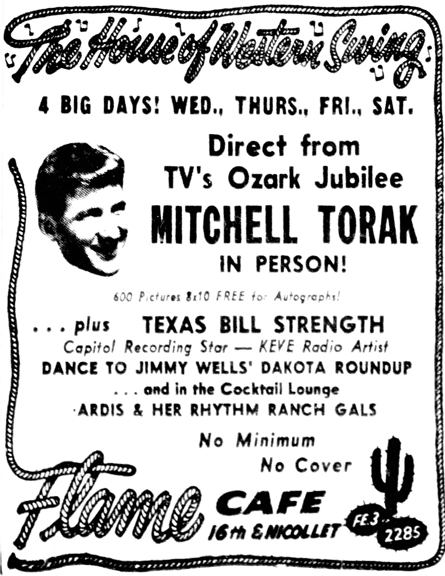
Minneapolis Tribune, Tuesday, August 28, 1956
September 1956
From September 5 though 8, 1956, TBS hosted Miss Audrey (Mrs. Hank Williams) at the Flame.
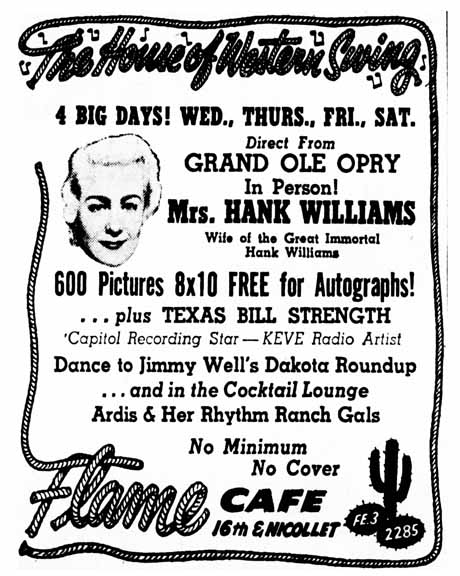
Minneapolis Star, Tuesday, September 4, 1956
From September 12 through 15, 1956, Yodeler Kenny Roberts shared the bill with TBS at the Flame. Kenny was famous for leaping into the air while playing guitar and harmonica at the same time, which gave him the nickname “The Jumping Cowboy.” Unfortunately there doesn’t seem to have been an ad that week.
Still trying to keep his family fed, on September 13, 1956, TBS appeared at a grocery store in Oxboro, south of Bloomington. Also appearing were Steve Cannon as Johnny .44 and Clellan Card as Axel.
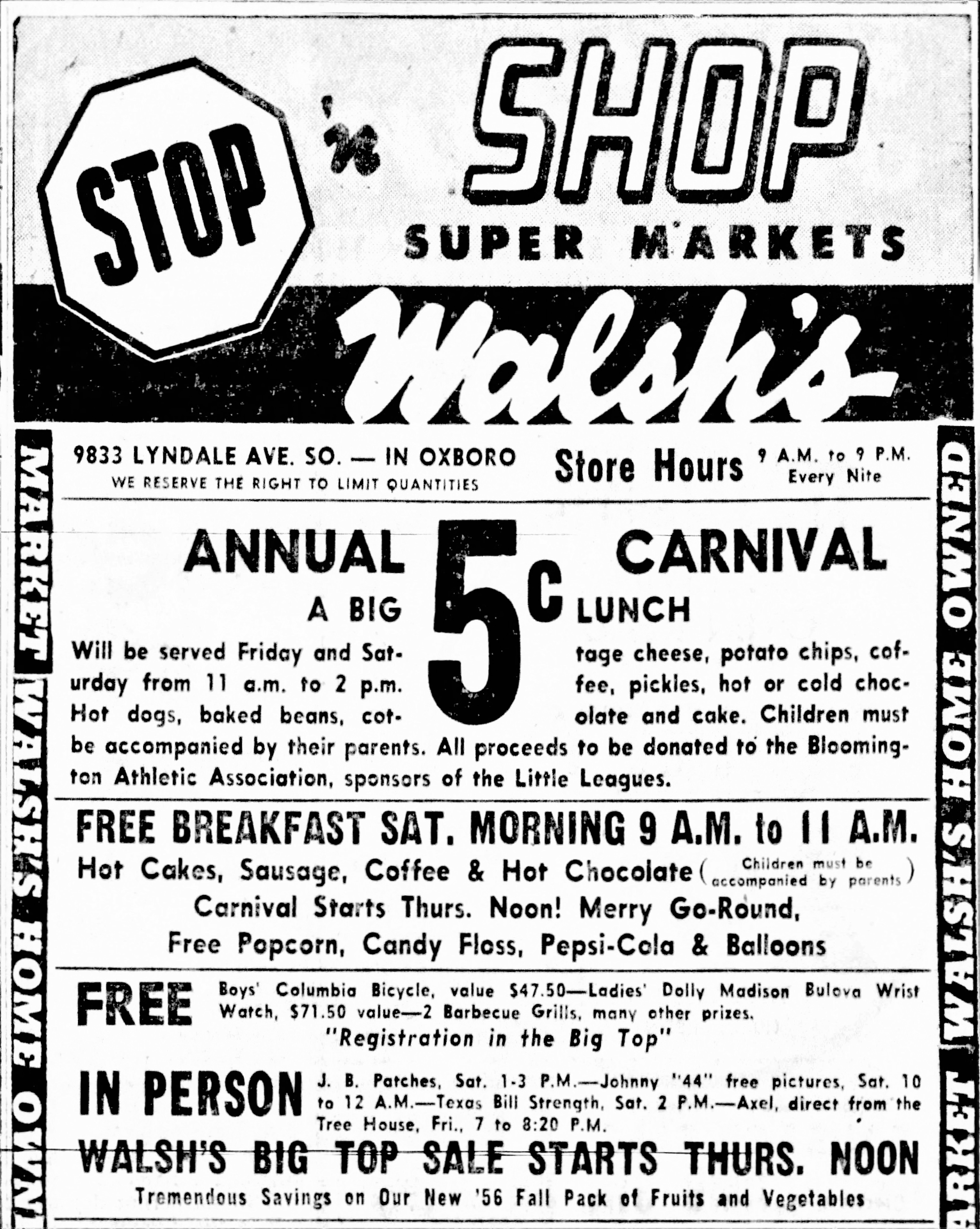
Minneapolis Star, September 13, 1956
From September 19 through 22, 1956, Leon Payne was TBS’s co-star at the Flame.
On September 20, 1956, one of four traveling Grand Ole Opry Troupes came to the Minneapolis Auditorium, with David Stone of the KSTP Barn Dance as emcee. Billboard reported that they “pulled a fat house.” During the show, Johnny T of KEVE was presented with a plaque by Ernest Tubb on behalf of Musicland Records for his achievement in the field of country and western music and for being Mercury’s top record seller in the five-state area. Along with TBS, performers were:
- Roy Acuff
- Ernest Tubb
- Kitty Wells
- Johnny and Jack
- George Jones
- Jimmy Newman
- Tommy Collins
- Hank Locklin
- Betty Foley
(Billboard, October 13, 1956)
“The Flame Books 2 Special Stars”
Two special attractions will come to the Flame café … Thursday [September 27] to perform with regular entertainers in the cast.
Marvin Rainwater, star of the Ozark Jubilee air show, and Mimi Roman, Decca recording star, will be on the bill for the one night.
Appearing also will be Cowboy Copas, Grand Ole Opry performer who is playing Wednesday through Saturday [September 26 – 29], and Texas Bill Strength and the Jimmy Wells and Ardis musical groups, regular entertainers.
(The Minneapolis Star, September 26, 1956)
October 1956
In early October, 1956, Tex Carman (Sage & Sand) and Freddie Hart (Columbia) have been set by TBS for a week’s stand. (Billboard, September 1, 1956). Apparently this did not work out, although ads for Carman and Hart at the Flame can be found in 1960.
From October 10 to 13, 1956, TBS shared the stage at the Flame with Justin Tubb.
Bob Murphy described Mimi Roman (from the aforementioned Flame show) as a “looker” and reported that she went over so well on the September 27 show that they were bringing her back for a four-day run on October 17-20. “On the bill also are the regulars, Texas Bill Strength, and Jimmy Wells and Ardis and their groups.” (Minneapolis Tribune, October 14, 1956)
TBS took a few days off from his platter spinning at KEVE last week for a bit of bear hunting in Montana. Johnny T and Verne Sheppard spelled him during his absence. (Billboard, October 20, 1956)
November 1956
The 1956 Billboard C&W Disk Jockey Poll placed TBS at Number 20 nationwide. His affiliation was listed as KEVE KEYD. (Billboard, November 10, 1956) (In June 1956, KEYD was sold, changed its call letters to KEVE.)
November 10, 1956, Billboard: TBS placed an ad thanking his friends in the business. His affiliations were KEVE Radio, KMGM-TV, Capitol Records.
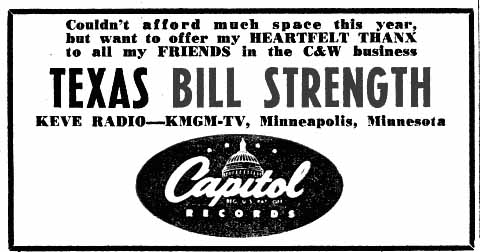
Billboard, November 10, 1956
December, 1956
THE TBS RECORD SHOP
Like his friend and idol, Ernest Tubb, TBS opened a record shop on December 1, 1956, shortly after arriving in Minneapolis. Just happened upon this postcard of ET’s Nashville Record Shop on Facebook:
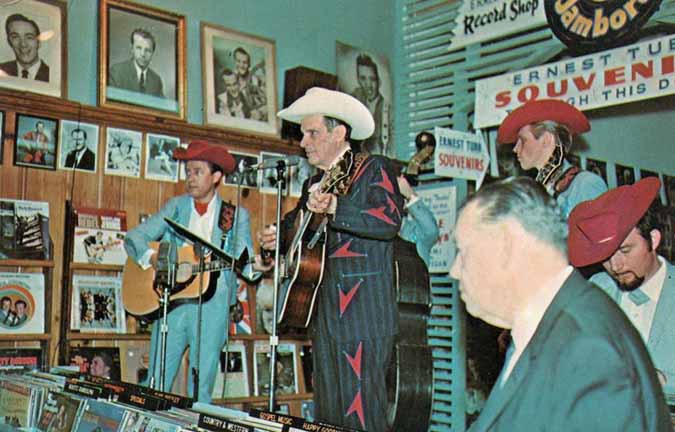
Ernest Tubb’s Record Store, Courtesy Walter Jung
The caption on the back of the postcard reads:
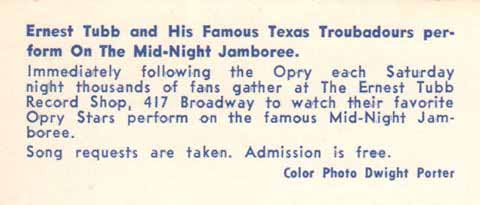
On December 1, 1956, TBS celebrated the opening of the Minneapolis record shop bearing his name with a two-hour remote broadcast featuring talent from the Twin Cities area. Bill asks artist to send him autographed photos for the shop. His address is KEVE Radio, 806 North Lilac Drive, Minneapolis The shop was located at 1003 Marquette Ave. in downtown Minneapolis. (Billboard, December 8, 1956)

Letterhead image courtesy Dale Strength
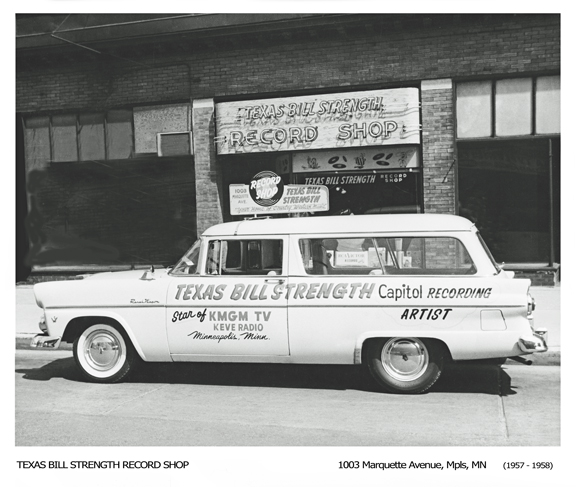
Photo Courtesy Dale Strength
Someone only identified as “Pee Dee” wrote in to describe his experience as a teenage gofer for TBS:
My days at the TBS Record Store were not the most auspicious, and my experiences with TBS himself less than complimentary…to either him or me. I was a 16-year-old “go-fer” who shuttled him and his out-of-town Opry guests around town. In spite of still being in school I did night duty as his driver (he would imbibe…) to places like the auditorium and the Flame (on Nicollet, if I recall). I’d pick up folks like Marty Robbins, Hank Snow and the like at the airport and take them to a hotel or the auditorium downtown. I was also a bit infatuated with Wanda Jackson who drove her own three-toned Dodge La Femme convertible to the ‘Cities and let me chauffeur her around in it, and I chored for a very accomplished fiddle player named Benny Martin who had me shagging across the street to the drug store opposite the shop about twice daily to pick up “cough medicine” — turpin hydrate and codeine with a good percent of alcohol — when he came to town. For his (ahem) cough…back then they’d sell that stuff to anyone including a 16-year-old kid.
I have no idea what [the story] about him being wounded in the thigh was all about. But I do recall that once when he played his cowboy role complete with nickel-plated revolvers — on one particular evening at the Flame all three were loaded but the latter two with blanks, thank heaven — that he got into a difference of opinion with Marvin Rainwater, pulled out one of those things, stuck it in Marvin’s stomach and blew a big black hole in Marvin’s trademark buckskin jacket.
Of course, the unmistakable sound of a shot sent the place into a panic. Fit to be tied, Marvin virtually lifted Bill up by the collar of his prize Nudie-made sequin-spangled jacket and slammed him up against the wall, proceeding with a string of epithets that stopped only when he heard the sirens out front as the cops showed up. Not one for drinking, Marvin got a grip on himself, loosened his on Bill who was pretty much out of it. He instructed me to go get Bill’s shop station wagon and to bring it to the back stage entrance, which I did.
In an abundance of caution, Marvin relieved Bill of his six-shooters and threw them under the front seat. We then stuffed him into the passenger side and I drove him home to his trailer(?) outside of Minneapolis. I then took the station wagon home, back to Clumsy Heights just about in time to turn around and drive to school the next morning.
That morning, I proudly showed up at school in the station wagon which I parked conspicuously right out front…and by doing so I guess I slammed on the brakes a bit too hard because two six-shooters came sliding out from under the seat against my feet! Not too intrigued with showing them to classmates, I pushed them back and left them there until the evening when I brought the station wagon back to Bill at the shop.
Imagine that happening today…
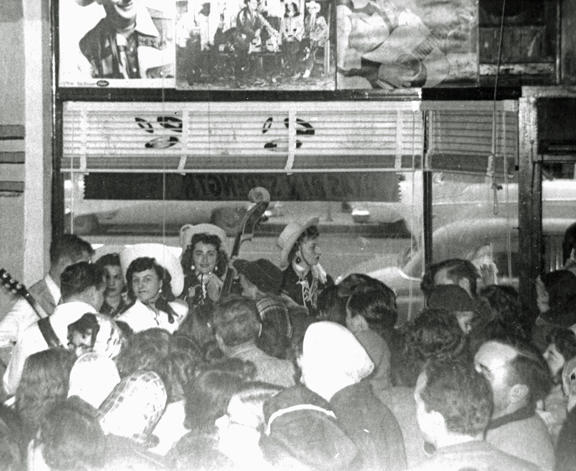
Live performance at TBS Record Shop with TBS, Ardis Wells, North Sisters, Fern Dale, 1957. Photo Courtesy Dale Strength
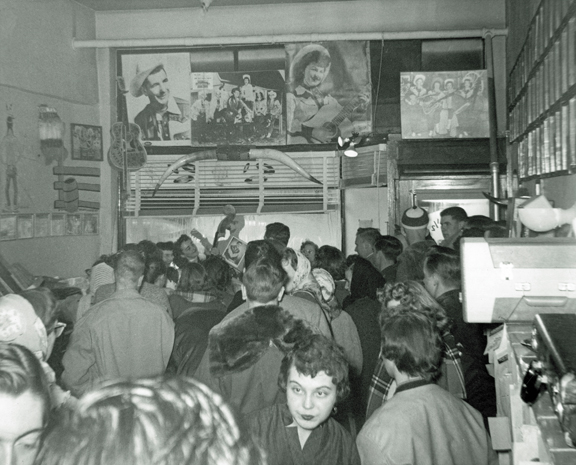
TBS Record Shop Live Performance, 1958. Photo courtesy Dale Strength
This item came over the transom – a record dealer had found an empty package from Texas Bill’s store in an antique shop in New Prague and sent in a photo of it.
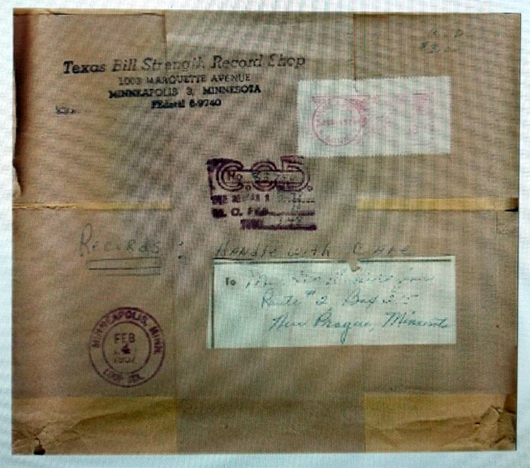
Image courtesy Mike in Shakopee
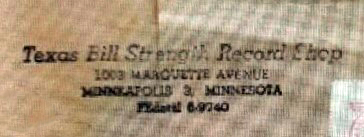
Close-up of the return address
At some point the shop moved to 202 So. 10th Street in Minneapolis, as evidenced by this card found in the archives of the Manske Sisters:
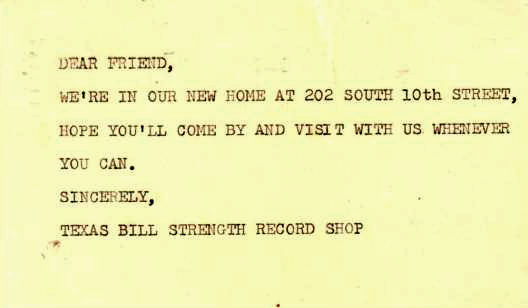
The record shop was “disposed of” in April 1958. The Marquette location became a Hilton hotel in 1992, and as of 2018 the 10th Street location is vacant land.
Another activity of “Texas Bill Strength Enterprises, Inc.” was a series of songbooks. Here’s Volume 2, featuring one of the best closeups of his face:

Image Courtesy Dale Strength
From December 18 to 22, 1956, entertainment at the Flame included Marvin Rainwater, TBS, and Johnny T.
The December 1956 issue of Country & Western Jamboree included the results of various fan polls they had taken. TBS had finished third after other disc jockey legends as T. Tommy Cutrer and Don Larkin as “Favorite Local Radio Disc Jockey.” That list also included other legends that would be in the Country Music Disc Jockey Hall of Fame: Randy Blake and Bill Mack.
A New Year’s Eve 1956 show at the St. Paul Auditorium starred:
- Ray Price
- Ferlin Husky
- Martha Carson
- Autry Inman
- Simon Crum
- Porter Waggoner
- Mitchell Torok
- Texas Bill Strength
1957
January, 1957
TELEVISION
On January 1, 1957, TBS began hosting the TV show, “Adventure Time,” on KMGM-TV, which was Channel 9 at the time. The program aired from 6 to 6:30pm. He showed Western serials and sang Western songs. On March 23, 1957, Billboard published a list of Local Live Country and Western TV Shows. TBS was listed as the producer of his show, the only one in Minnesota. The show had 14,000 loyal followers. (Ronnie Pugh)
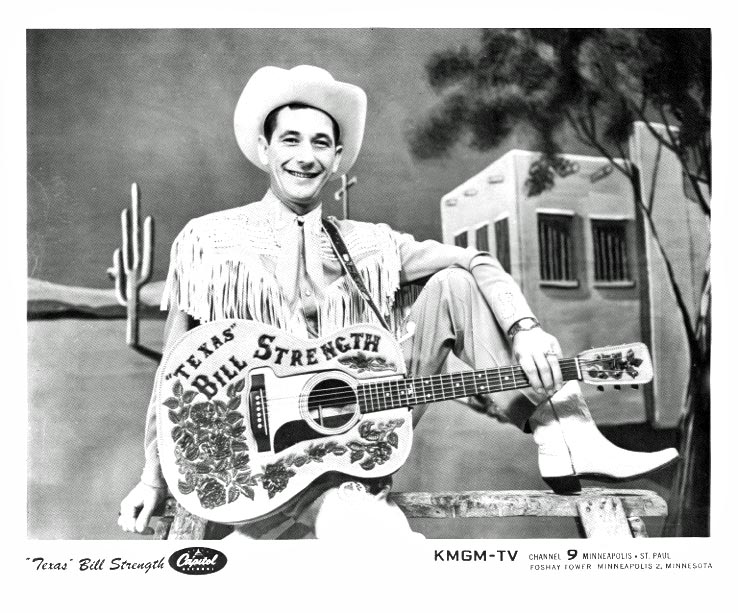
Photo courtesy Dale Strength

Minneapolis Tribune, January 2, 1957
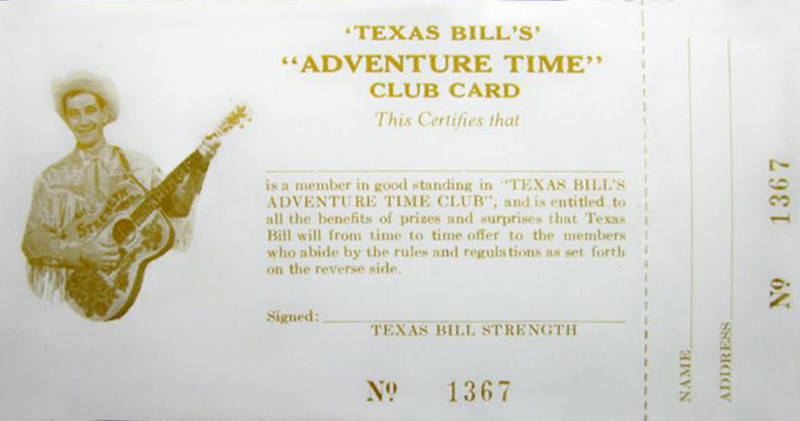
Adventure Time Membership Card, Front – Image courtesy Dale Strength
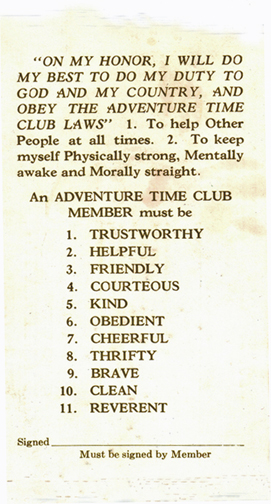
Adventure Time Membership Card, Back – Image courtesy Dale Strength
January 13 – 19, 1957, was the last time TBS was listed on the weekly Flame ad. His co-star that week was Carl Perkins, and Johnny T was also on the bill. It is presumed that he continued his hosting role off and on, as he reportedly resigned that job at the end of March, 1958, replaced by Dave Dudley.
TBS has quit his deejay chores at KEVE to devote more time to his record shop, which is proving fairly successful. Bill also will give more time to promoting himself as an artist. (Billboard, January 26, 1957)
Strength has just kicked off an hour-long TV show, seven days a week, over KMGM, titled “Adventure Time With Texas Bill.” (Billboard, January 26, 1957)
February 1957
On February 15, 1957, TBS leaves on a two-week tour, which will include a double session for Capitol in Hollywood, several West Coast dates for Americana Corporation. (Billboard, January 26, 1957)
On February 16, 1957, TBS appeared on the “Big D Jamboree” in Dallas. Other guests were the Five Strings and the Rangers Quartet. (Billboard, February 23, 1957)
CAPITOL RECORDS
February 25, 1957: TBS made his last recordings for Capitol. Billboard had reported that this was to be a double session, but as far as we know, only two songs were recorded:
- “Cloud 13”
- “Six Fools”
“Cloud 13” was never issued, and “Six Fools” was paired with “I Wanna Ride, Ride, Ride (On Your Merry-Go-Round)” from the previous recording session, released in April 1957.
April 27, 1957: Billboard reviewed Capitol No. 3701:
- “I Wanna Ride, Ride, Ride On Your Merry-Go-Round” – A slick bit of rhythmic wax with a story that has certain touches of double entendre. A happy and well handled version that could easily generate some jock and juke box action.
- b/w “Six Fools” – An unusual piece of material rendered in a minor key. Fancy banjo plucking backs the chanting. Side rates attention and could compete with the flip for plays.
Below is a photo of TBS listening to a playback at one of his four sessions at Capitol Records in Hollywood.
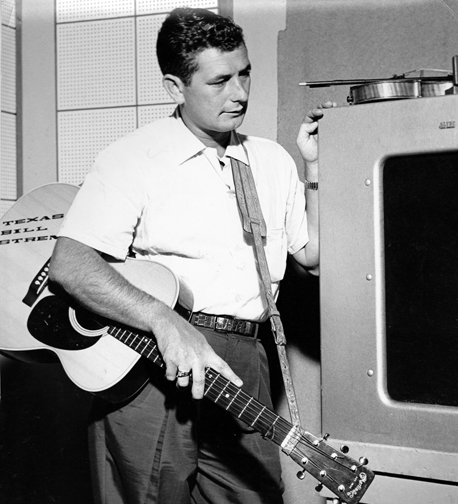
Photo courtesy Dale Strength
March 1957
RED FOLEY – MARCH 2, 1957
On March 2, 1957, TBS made his fourth guest shot on “Ozark Jubilee” in Springfield, Missouri. Also appearing were Patsy Cline, Libby Horne, and comedienne Little Eller Long.
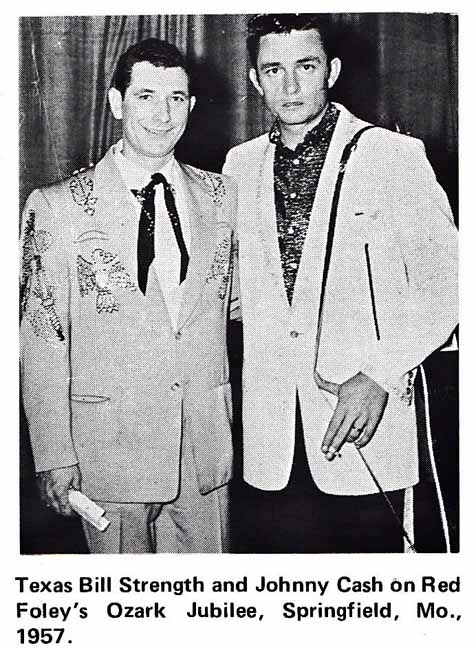
Photo courtesy Jan Sherman via Derik Olson
April 1957
Speaking of Minneapolis, what has happened to our good friend, TBS? (Billboard, April 6, 1957)
Much news in a Billboard report dated April 13, 1957:
TBS has settled down to his usual activities in Minneapolis after a two-week sojourn on the West Coast. [First two weeks in April 1957?]
[TBS continues] his daily show over KMGM-TV, “Adventure Time With Texas Bill.”
Strength has resumed former duties of spinning C&W platters five hours a day over KEVE.
Bill also reports success with his recently opened record shop, which is devoted to C&W music exclusively.
His newest Capitol release is “The Six Fools.” Any deejay wanting an extra copy may write to him at either of the above stations.
MORE RADIO ROULETTE
April 18, 1957, Minneapolis Star:
District Judge John A. Weeks today signed an order to show cause, to be heard before him April 23, by which radio station WISK seeks to prevent William (Texas Bill) Strength, cowboy singer and disk jockey, from continuing to work for radio station KEVE.
WISK claims that Strength signed a 90-day contract March 30 which would move his services to WISK, but has continued to work for KEVE. The contract, it was reported, had options exercisable for the rest of the year, and was effective April 15, but Strength failed to make the change.
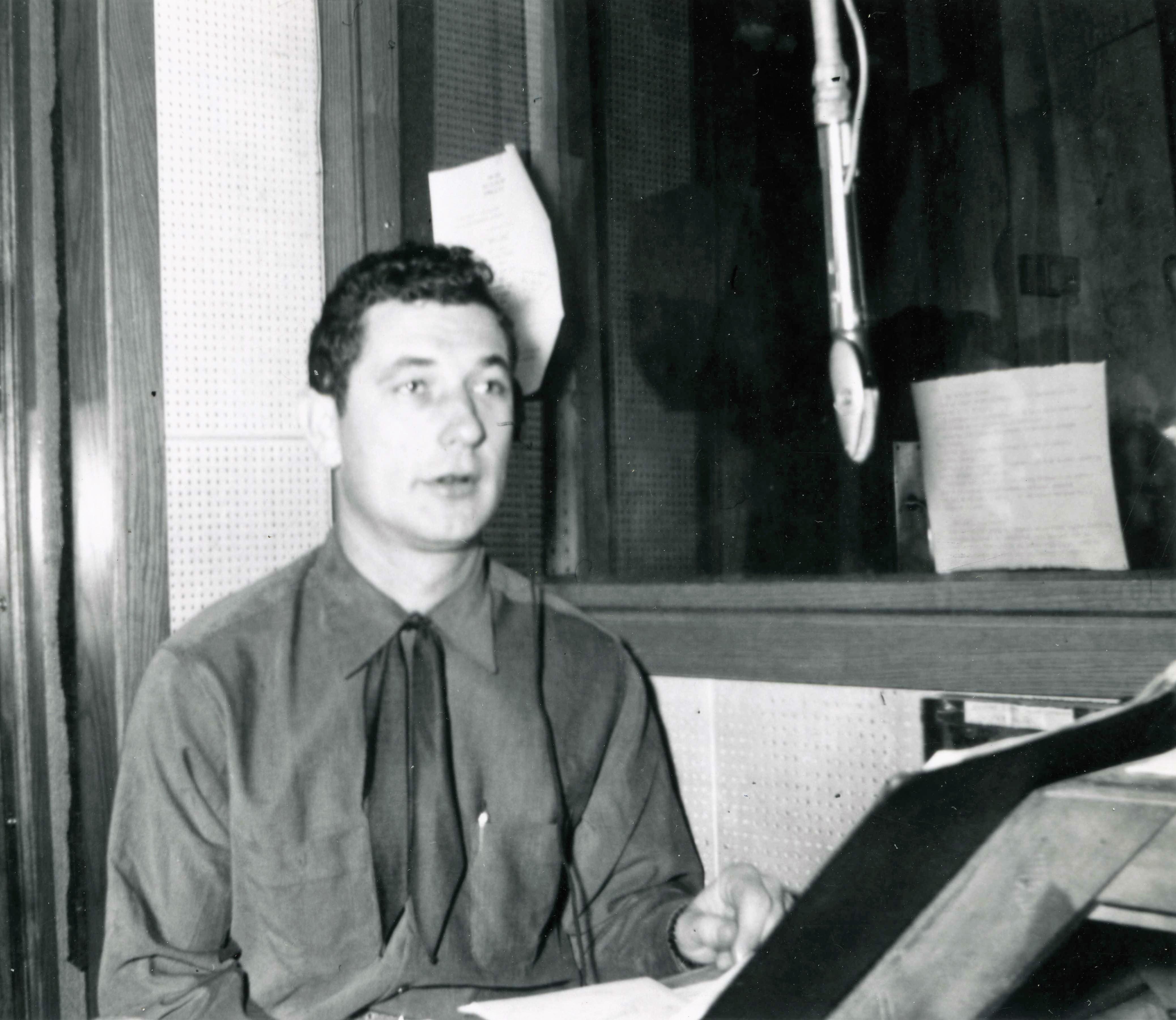
Photo comes from a fan scrapbook, approximately 1957. The back indicates two different radio stations he could be working at during this time.
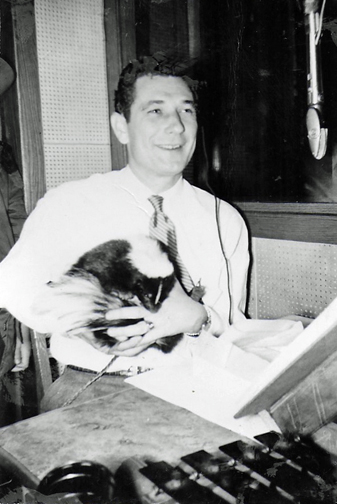
TBS and “Stinky.” Tell us more, Dale!
On April 18, 1957, Will Jones wrote:
A big western and country music bash is on tap at 8 pm Saturday [April 20] in the Minneapolis Auditorium, put on by radio station KEVE. Plunking, twanging and drawling will be:
- Sonny James
- Johnny Cash and the Tennessee Two
- Jerry Lee Lewis
- Gene Stewart
- The Country Gentlemen
Texas Bill Strength, who bunks in the Twin Cities, will be master of ceremonies. KEVE says the show is aimed at popular, as well as western, music fans. (Minneapolis Tribune)

Image courtesy Dale Strength
Below is the program for the event, which features KEVE’s disc jockeys, Texas Bill and Vern Weegman.
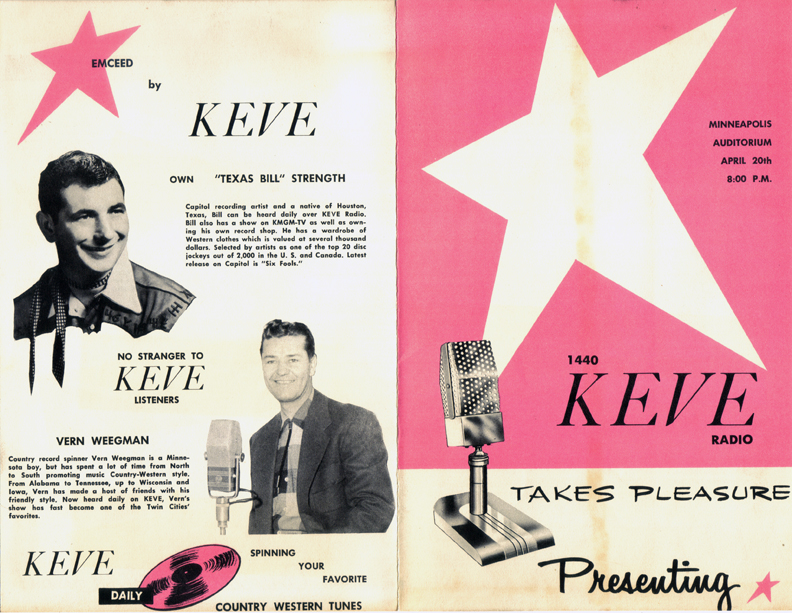
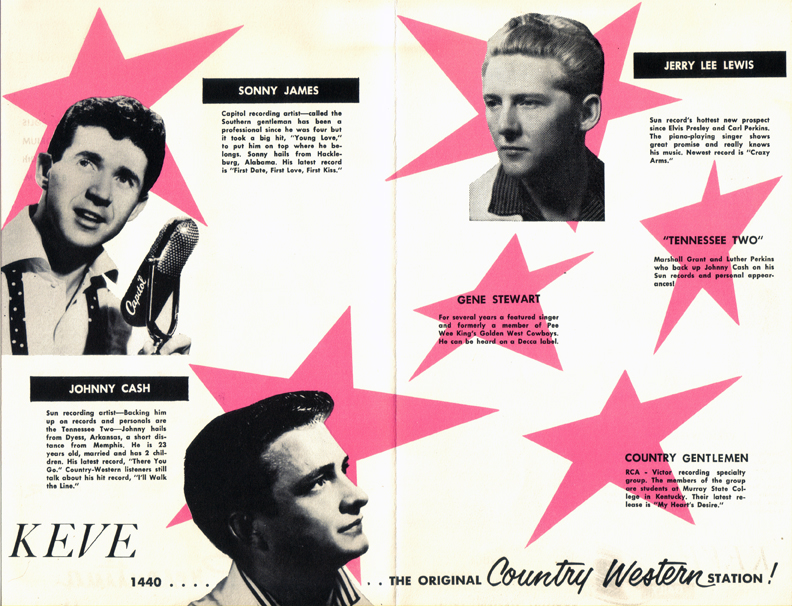
May 1957
FRONT PAGE NEWS
On May 5, 1957, the front page of the TV Tab entertainment supplement of the St. Paul Sunday Pioneer Press was dedicated to TBS, with a big picture of him captioned “KMGM’s Texas Bill Strength.” The headline was “Movie Stardom is Texas Bill’s Aim,” subtitled “Singer is Host for Westerns.” Staff writer Howard Ryan lists TBS’s many enterprises:
- Host of “Adventure Time with Texas Bill” on Channel 9 (KMSP-TV) from 6 to 6:30 M-F. Ronnie Pugh wrote that this was a kiddie show that had 14,000 loyal followers at one time.
- Disc jockey on KEVE from 10 am to noon and 2:30 pm to 5:30 pm, M-F and 10:30 am to 3 pm on Saturdays
- Owner of his own record shop
- Five personal appearances on average each week
- Occasional appearances on “Grand Ole Opry unit guest appearances”
- Music publishing firm in partnership with Tex Ritter
He reported that he was leaving on May 19 for about 10 days to do some personal appearances with Ritter and work with him in a couple of films in California. His biggest ambition was to be a Western movie star. “I’ve had some real good encouragement from producers and directors in Hollywood,” he said. Although he had no formal acting training, he expressed his belief that “I’ve got a natural ability for Western parts.”
As for his musical career, he had had 18 releases with Capitol Records at that point, but his goal was to hit with a million seller.
TBS professed his love for the Twin Cities, which was the Number 2 market for Country music behind Nashville, he said. “Unlike most Texans, I prefer the colder weather – I feel better. I love the people here, too. They have more or less accepted a ‘foreigner’ and made me feel welcome.”
DOMESTIC HIGHS AND LOWS
The Pioneer Press article of May 5, 1957, reported that TBS lived with his family in a “large trailer home at Medicine Lake,” and although he had been promising himself a two-week mountain vacation with his family for five years, he always wound up making personal appearances instead.
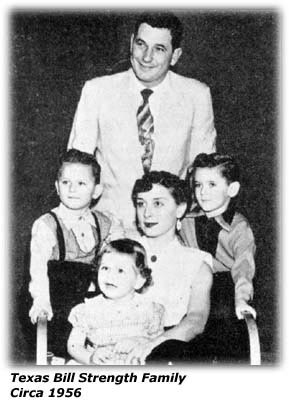
Photo courtesy Dale Strength
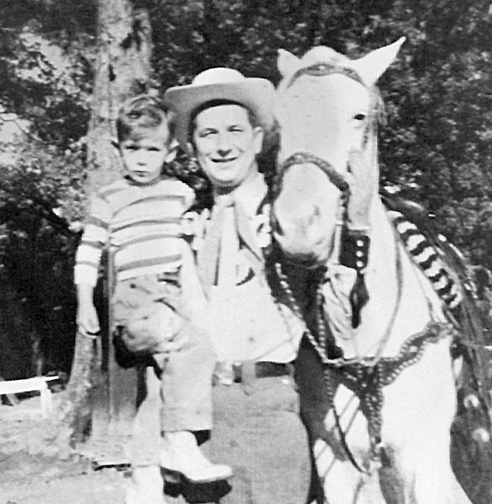
Young Dale with his Dad and Unidentified Horse. Photo courtesy Dale Strength.
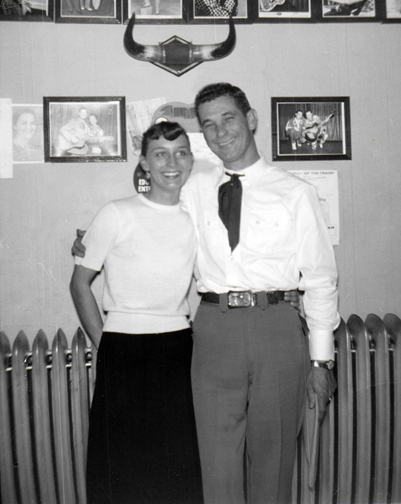
Dorothy and Bill, all smiles at his Record Shop. Photo courtesy Dale Strength
Sometime between May 1957 and 1958, Dorothy left Bill and took the kids back to Houston.
TEXAS BILL’S SCRAPBOOK
The letter below, unfortunately undated, tells us that TBS put together a chronological scrapbook of his career – a copy of which would make this project a lot easier! There are snippets of this book available, but according to the letter, fans sent in snapshots and news clippings to help him piece together his peripatetic career around the United States and all of the celebrities and fans he met along the way. Pictures that could be matched with events have been placed accordingly. Unfortunately, the two pages found on the Internet were too small to post in most cases. And there are pictures of people that are yet to be identified. They are posted here, under the letter.
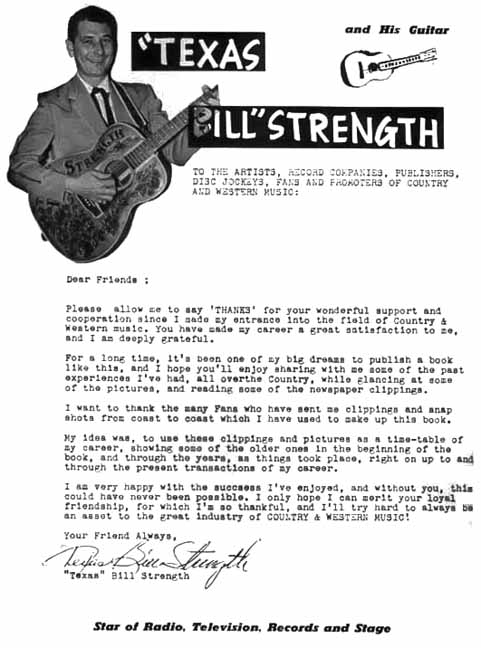
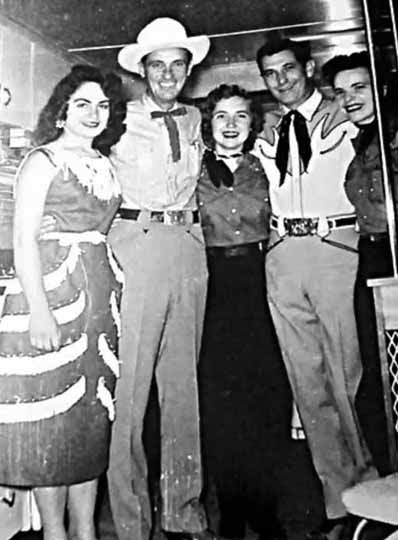
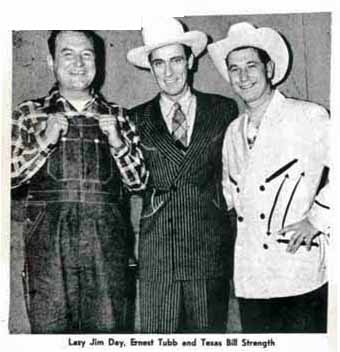
Larry Jim Day, Ernest Tubb, TBS
HOLLYWOOD
If the dates in the Pioneer Press story of May 5, 1957, were correct, Bill was out in Hollywood between May 19 to 29. His goal was to do some personal appearances with Tex Ritter and work with him in a couple of films.
Billboard reported that while he was there he had a two-day guest shot on “Town Hall Party,” and was called in on a session that may net him a movie shot soon. (June 10, 1957)
On May 26, 1957, Will Jones reported that he “landed himself a part in a new western movie. The film will star Webb Pierce and Red Barry. Strength will go back sometime this summer to make the film.”
Although this would have been TBS’s dream come true, it did not come to fruition.
June 1957
On June 2, 1957, TBS played the Griffith High School Gymnasium in Munster, Indiana, with Tex Ritter. Also on the bill were Paul Kersey and His “Melody Playboys,” and Ann Young and the Thomas Brothers.
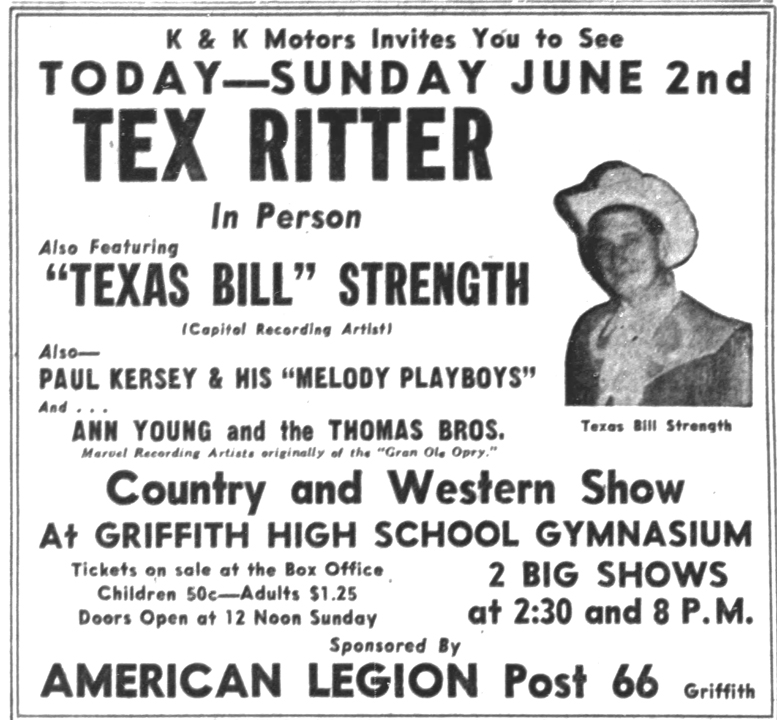
Munster, Indiana, Times, June 2, 1957
On June 14, 1957, Marvin Rainwater and TBS presented a Stage Show and Dance at the Monterey Ballroom in Owatonna, Minnesota.
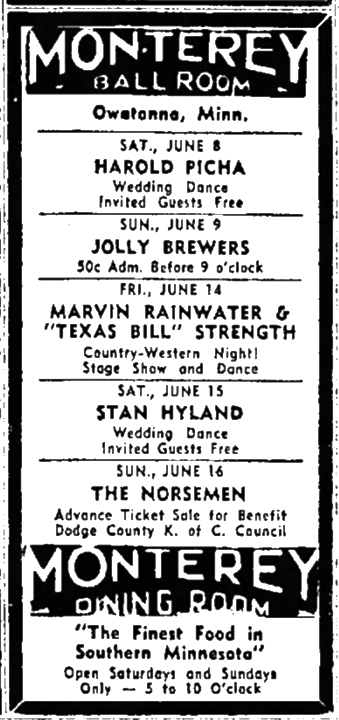
Austin, Minnesota, Daily Herald, June 7, 1957
On the next night, June 15, 1957, the two were at the Granite City Coliseum in St. Cloud, joined by Jimmy Colvard, Betty Rydle (could that be Rydell?) and the Rainbow Rhythm Boys.
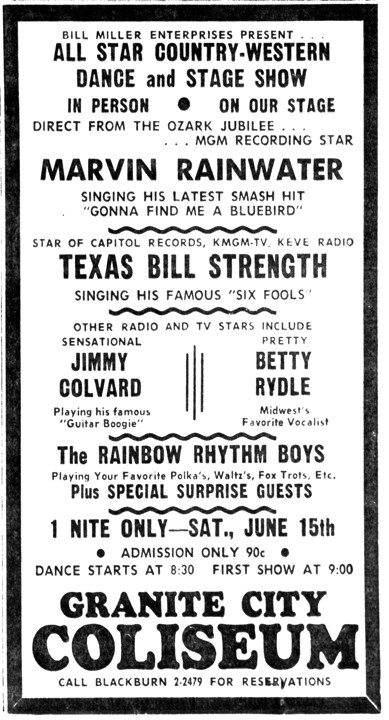
St. Cloud Times, June 14, 1957
July 1957
On July 13, 1957, TBS was back at the Granite City Coliseum in St. Cloud, this time without Marvin Rainwater but with Tex Ritter.
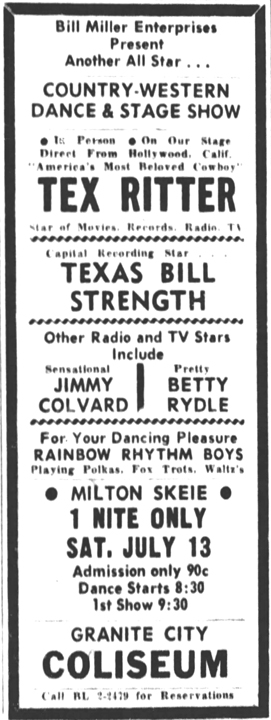
St. Cloud Times, July 11, 1957
On July 21, 1957, Red Foley and the “Ozark Jubilee” TV show cast came to Minneapolis for a big country show at Metropolitan Stadium. Much was made of the fact that the cast flew in for the date. Other performers included:
- Marvin Rainwater
- Foggy River Boys
- Shisk & Whistler
- Bill Wimberly’s band
Local entertainers included:
- David Stone, KSTP-TV
- TBS, KEVE
- Johnny T, WISK
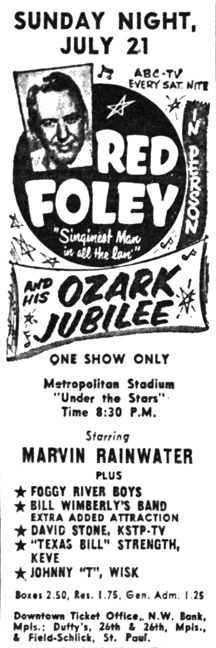
Minneapolis Tribune, July 20, 1957
On June 28 through 30, 1957, TBS and his Trio entertained at the Upper Midwest Championship Rodeo, Metropolitan Stadium in Bloomington, Minnesota. Smiley Burnett, Gene Autrey’s sidekick, was also on the program.
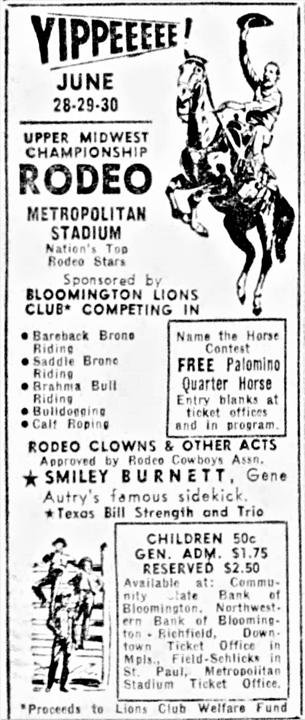
Minneapolis Tribune, June 29, 1957
August 1957
On August 10, 1957, TBS was back at the Granite City Coliseum in St. Cloud, this time with Carl Perkins.

St. Cloud Times, August 8, 1957
On August 17, 1957, TBS played Tiny Tillman’s Happy Hollow Lake in Independence, Missouri. (Billboard, August 19, 1957)
On August 30, 1957, before the Minnesota Twins played Omaha on Appreciation Night at Met Stadium, a softball game between the Celebrities (managed by sportscaster Frank Buetel) played the Minutemen. Buetel vowed to beat the Minutemen’s two-platoon system with brute strength, so he promptly named TBS as his leadoff batter. The Celebrity lineup was:
- Bill Strength, 3b
- Roy Drusky, ss
- John Kundla, 1b
- George Mikan, cf
- Frank Buetel, p
- Wally Karbo, lf
- Dennis Stecher, rf
- Dick Nesbitt, sf
(Minneapolis Tribune, August 29, 1957)
September 1957
On September 7, 1957, TBS and his new all-girl unit, the Westernettes, play the County Fair at Madison, Minnesota, along with Tex Ritter and Smiley Burnette. (Billboard, September 2, 1957)
TBS recently shared the bill with Ernest Tubb and His Texas Troubadors at the Stillwater Speed Bowl, Stillwater, Minnesota. He invites all C&W artists passing thru the Twin Cities to visit him at his record shop at 202 South 10th Street, Minneapolis, and to appear with him on KEVE radio. Strength recently left the Capitol label and is reported dickering with Decca and Columbia. (Billboard, September 9, 1957)
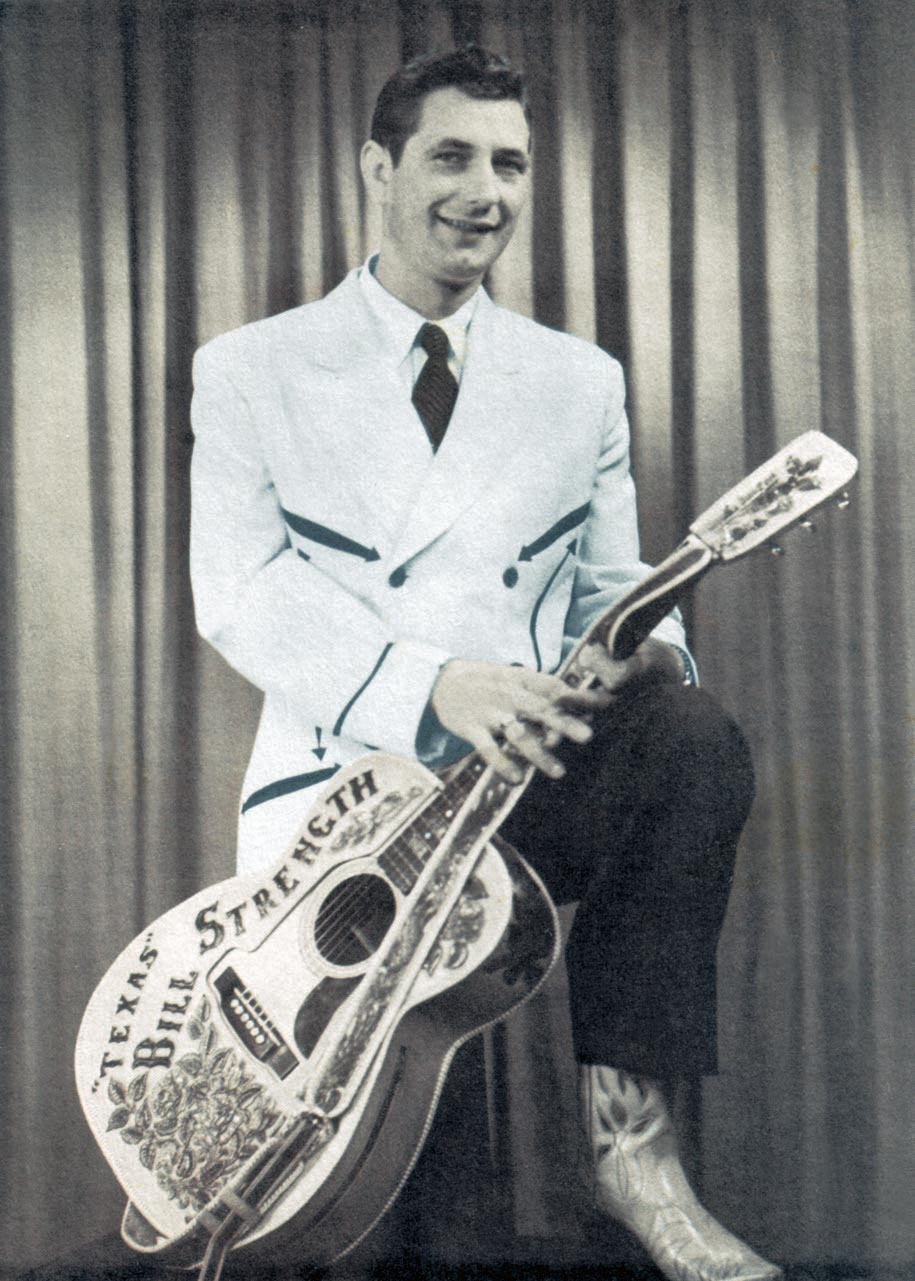
Undated photo courtesy Dale Strength
Bill’s wardrobe for his personal appearances was reportedly valued at over $3,200.
On September 9 – 12, 1957, the furniture store Borg and Powers, 247 Nicollet Ave. in Downtown Minneapolis, held a sale to get rid of inventory in preparation to move to a new warehouse. (Actually, the building was part of skid row and was demolished in 1961 as part of the Gateway Redevelopment Project.) To draw people to the sale, personalities from KEVE and the Flame were on hand, broadcasting from the store.
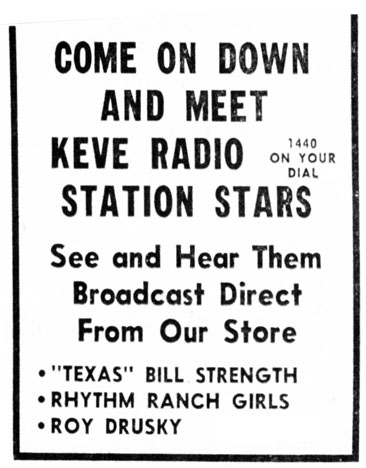
Minneapolis Tribune, September 8, 1957
November 1957
TBS, in addition to his daily deejay and TV shows over KEVE, is appearing five nights a week at the Flame. He’s again doing the booking there. Bill says he’s all set for the big blowout [disc jockey convention] in Nashville. (Billboard, November 4, 1957) He didn’t make it because he came down with the flu. (Billboard, December 23, 1957)
December 1957
From December 11 to 13, 1957, Bill Strength and Roy Drusky were back broadcasting from the Borg and Powers Furniture Store at 247 Nicollet Ave. in Minneapolis.
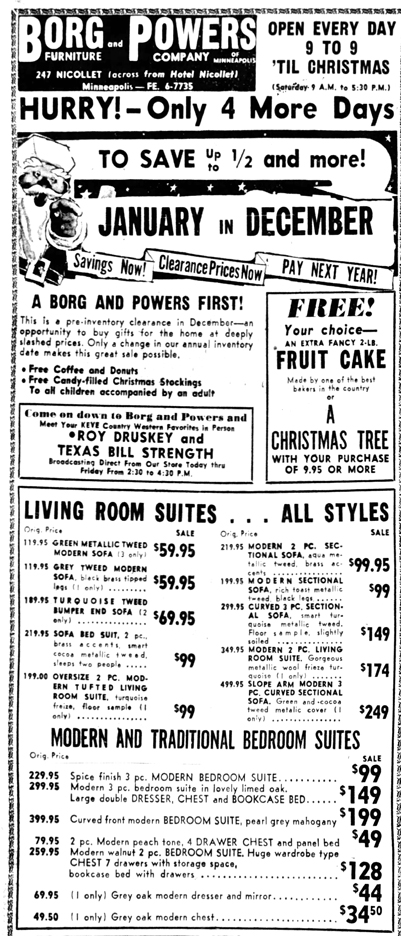
Minneapolis Star, December 11, 1957
TBS, entertainer-deejay, who still holds forth at KEVE, typewrites that he was all set to fly into Nashville for the recent deejay conclave, when he was brought down with the flu. (Billboard, December 23, 1957)
On December 31, 1957, TBS was booked for a big New Year’s Eve Country show and dance at the Minneapolis Auditorium, featuring eight recording artists:
- Jimmie Rodgers
- Porter Wagoner
- Johnny Horton
- George Morgan
- Anita Carter
- Bobby Lord
- Don Davis
- The Wagon Masters Trio – apparently Porter Wagoner’s backup band.
Doing the math, it’s unclear whether Texas Bill was the eighth artist on the bill or the master of ceremonies, as he often played that role in these types of shows.

Minneapolis Tribune, December 28, 1957
1958
Frank’s records show that TBS cut five unissued sides in 1958, titles unknown. One is identified as on the MGM label.
February 1958
TBS, entertainer-deejay at KEVE, has been ordered by his doctor to take four-week vacation, due to physical and mental exhaustion which the doc described as the first stages of a breakdown. Now recuperating in Texas and Mexico, Texas Bill plans to resume his KEVE duties around February 15. (Billboard, February 3, 1958)
Ever the pitchman, TBS is seen in an ad for dog food.
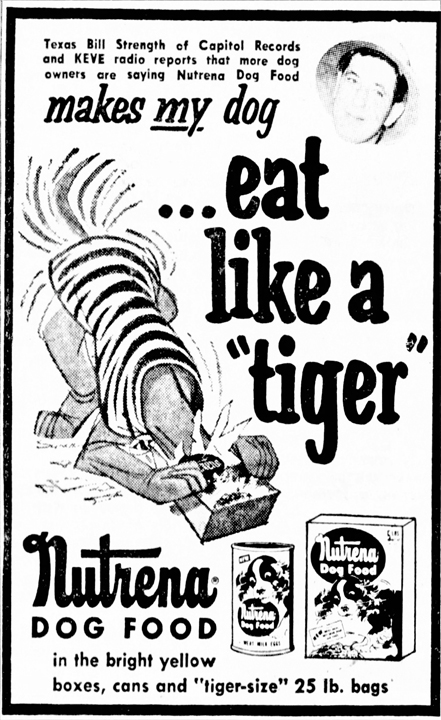
Minneapolis Tribune, February 28, 1958
April 1958
DISENCHANTMENT WITH MINNEAPOLIS
In his April 2, 1958, column, Will Jones reported:
This has been a week of sudden departures in the radio business. Texas Bill Strength left KEVE and the country-western Flame Cafe after a flareup, and was replaced Monday [March 31] at both places by Dave Dudley, country-western singer and disk jockey from Duluth (by way of Chicago and Nashville, Tenn.)
Billboard also reported major changes in Bill’s life:
TBS has set it down at the Vasser Grove Trailer Park, Hopkins, after taking departure from Minneapolis, where he resigned his deejay post at KEVE. Says he has been planning getting out of the disk jockey business for some time in an effort to build his status as a C&W artist. Bill put in most of last week in Chicago, while playing a Calumet City, Illinois, nitery. He reports that he cut a session recently, with the release due soon on either Columbia or Decca.
He also gave up his emsee job at the Flame. Texas Bill says his Minneapolis exodus was not due to a flare-up or conflict as one of the columnists there state, but rather due to health reasons.
Strength says he also has disposed of his record shop in Minneapolis and that he is contemplating a change of scenery and atmosphere.
(April 21, 1958)
ABDUCTION
Sometime between May 1957 and 1958, Bill’s wife Dorothy left Bill and took the kids back to Houston. Bill decided that he wanted the boys with him, and he abducted them from their Aunt’s house in Houston, where Dorothy was living. He didn’t take their sister Sandy, because she was born blind, and he didn’t feel he could give her the help she needed. (She eventually had operations that allowed her to see just fine.)
Dorothy hired a detective to track the the boys down, but TBS kept them hidden by placing them with various friends while he performed around the country. The detective could find Bill, but not the boys. He got word that the authorities had already been to their Grandma Jessie’s place (Bill’s mother) looking for them, and Bill thought it would be safe to let them stay there for a few weeks while he did some show dates. He eventually picked them up and they moved on from there.
Eight-year-old Dale took the photo below of his Grandma Jessie and brother Bobby, a few months after after the abduction. A 1958 directory showed William, Sr. and Jessie living at 1277 Sheffield, in Houston, a house Dale described as a shack. WT was listed as a carpenter. Dale described the place like this:
During the summer of 1958 Bob and I spent a few weeks on Sheffield Boulevard in Houston at Grandma and Grandpa Strength’s place. They lived in something called a “Court,” as in trailer court, but instead of trailers there were a half a dozen or so identical shacks all in a row down a dirt drive in the middle of an industrial neighborhood. There were plenty of trees on the couple of acres where the shacks stood and a small woodland nearby where Bob and I would play. But mostly industrial buildings dotted the neighborhood.
In hindsight the “house” kind of had that “Grapes of Wrath” vibe to it, but we didn’t know or care. They were pretty basic structures with indoor plumbing. I fortunately have one picture of the place that I took with my Dad’s black and white Polaroid camera, the newest and coolest thing to have at the time. The “house” was built up on columns of cinder blocks a couple of feet off the ground. I remember Bob and I exploring and playing under the house. The floors were wood and I recall being able to see the ground through some of the cracks, except where there was linoleum. The kind that came in big rolls and you spread it on the floor like a carpet. Grandma Jessie had a faux oriental rug theme that I thought was really pretty. I really liked the colors and designs.
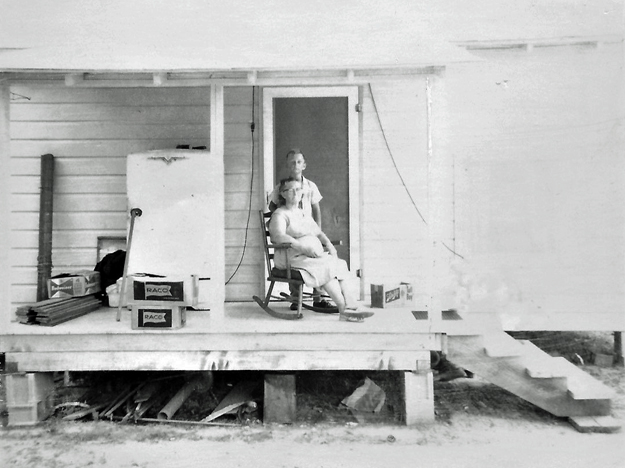
Photo courtesy Dale Strength
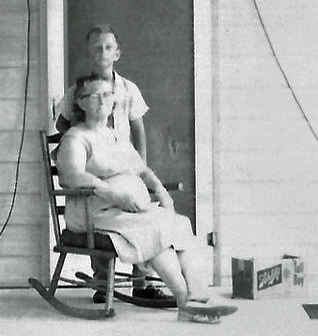
Photo courtesy Dale Strength
The boys eventually lived with the family of “Ma and Pa Norrbom,” whose daughter Mary was the manager of the Flame.
A 1959 Minneapolis directory listed TBS living at 2514 15th Ave. So. His occupation was listed as “entertainer.” By 1959 he had already moved to California, but this may have been a good address for at least part of 1958.
May 1958
In May and June, 1958, TBS played a series of week stands in Midwest niteries. (Billboard June 30, 1958)
Milwaukee’s Cackle Shack may have been one of them. Although this ad came without a year, and the Cackle Shack didn’t come up in a newspaper search, TBS was on Capitol Records from 1955 to 1957, and May 31 fell on a Saturday in 1958, so that’s our best guess.
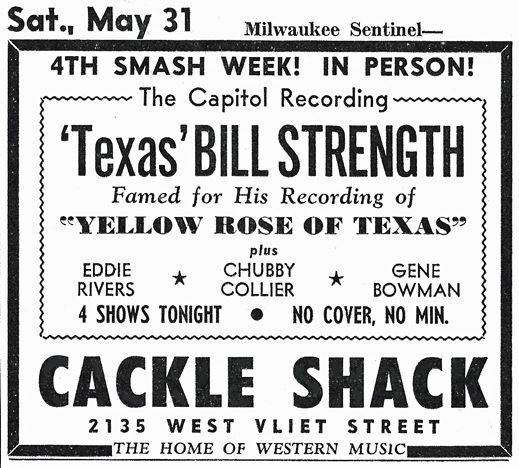
Ad courtesy Dale Strength
June 1958
On June 29, 1958, TBS appeared at the World’s Championship Rodeo at Crystal Springs Ranch, Clear Lake, South Dakota, along with Smiley Burnett, Johnny White, and the Sons of the West, of WELO-TV, Sioux Falls. (Billboard, June 30, 1958)
TBS has planted roots at KISD, Sioux Falls, South Dakota, where he’s doing three and a half hours of C&W music a night. He asks that artists and record companies take note of his new location. (Billboard, June 30, 1958)
July 1958
On July 28, 1958, TBS was in Sioux Falls, South Dakota, performing in a Hometown Jamboree at the Community Playhouse. Other acts were:
- Curtis and Marvin, “Western Melodiers”
- The Caddies
- Harry Schutte
- Rocky Mountain Playboys
- Harvey and Andy
- Curtis and Marvin
- Hezzy Jones
- Walt and Johnny
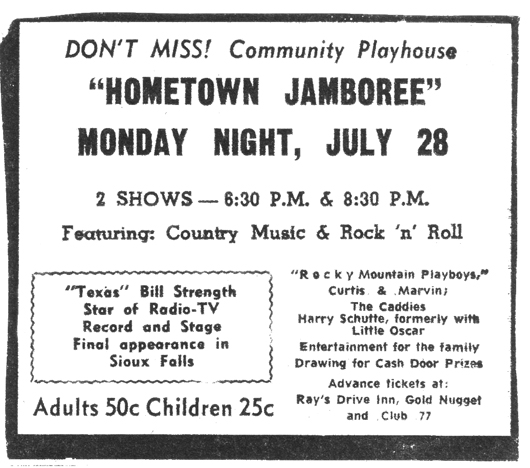
Sioux Falls Argus Leader, July 28, 1958
August 1958
On August 2, 1958, TBS appeared on “Big D Jamboree” in Dallas, sharing the spotlight with:
- Martha Carson
- Wally Fowler
- The Johnson Sisters
- Roy Carter
- Harvey and Andy
While in the Western Country, Texas Bill visited with Mac Sanders and Hiram Higsley at KSIR, Witchita. He also visited Hank and Dorothy Thompson at their home in Oklahoma City. (Billboard, August 11, 1958)
TBS has been roamin’ the country far and wide on personals since leaving his deejay chores at KEVE several months ago. (Billboard, August 11, 1958) [KEVE changed its format to classical in 1961.]
September 1958
On September 19, 1958, TBS was back in Houston at Cook’s Hoedown Club.
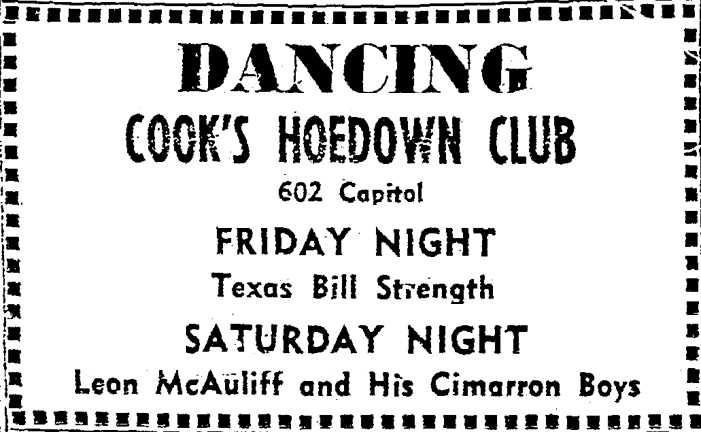
Houston Chronicle, September 1958
On September 27, 1958, TBS performed on “Louisiana Hayride” in Shreveport, Louisiana. Other performers on the show were:
- Charlie Phillips
- Mel Tillis
- Johnny Dollar
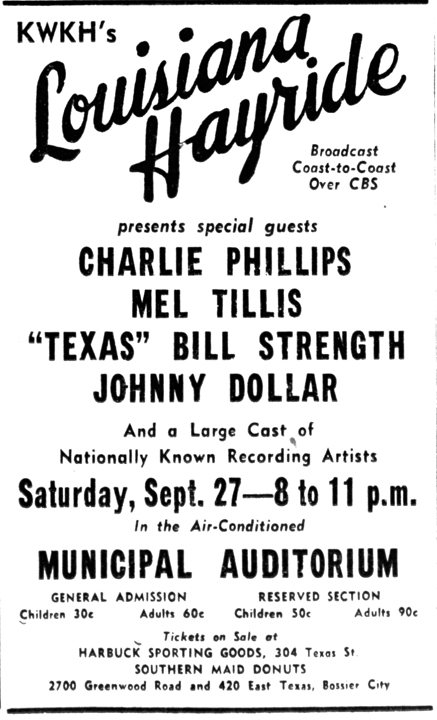
Shreveport Times, September 26, 1958
October 1958
RED FOLEY
TBS did a guest stint on Red Foley’s “[Ozark] Jubilee U.S.A.” at Springfield, Missouri, on October 11, 1958, which goes out over the TV lanes on October 13. (Billboard, October 13, 1958)
TBS scribbles that he’s been constantly on the go the last several months, trying to beat the depression. He says he’s a sure shot to make the big C&W deejay convention in Nashville November 21-22, 1958. (Billboard, October 13, 1958)
CALIFORNIA
In late 1958, TBS and the boys made the move to California, living in Long Beach and working for KFOX, “the Only 100 Percent Country-Western Music Station in Southern California.” He kept an office at 5927 Sunset Boulevard in Hollywood. (Ronnie Pugh)
The ad below apparently announces a new format for KFOX. The mess at the top that you can’t read says THE in front of FOX, and GOES WESTERN below that. This was quite a find but difficult to clean up – faces are always troublesome and my photoshop doesn’t do what it used to do. But this gives us a time frame for when he was at KFOX in California.

Long Beach Independent, August 5, 1959
Another interesting thing about this ad is that TBS worked with Joe Allison. From June 29, 1957 to April 11, 1959, Joe was the host of a local show in Los Angeles called Country America. At the time, Joe was or had been a DJ at station KRKD. An undated list of Texas Bill’s “Recent Appearances” included a guest appearance on Country America, although a newspaper search of guest stars did not find him. It may have been that Bill could have gotten the DJ job at KFOX with a little help from his friend Joe. Just speculating.
December 1958
TBS, the “Denver Dragon,” spent the holidays with the home folks in Houston. (Billboard, January 5, 1959)
1959
March 1959
On March 5, 1959, TBS played the Manger Club in El Monte, California. (Billboard, March 16, 1959)
On March 8, 1959, TBS did a live broadcast at Riverside Rancho, Hollywood, with the Squeekin’ Deacon Moore show over KXLA. (Billboard, March 16, 1959)
On March 9, 1959, TBS showed his wares at the Crow’s Nest, Oxnard, California. (Billboard, March 16, 1959)
On March 13, 1959, TBS played Laramie, Wyoming. (Billboard, March 16, 1959)
TBS, who has been hopping hither and yon for the last 10 months, reports from Hollywood that the breaks are finally coming his way, when MGM slates to issue its first release on him almost any day now. [There are no known releases on MGM Records.] (Billboard, March 16, 1959)
TBS recently appeared with Hank Penny and Wade Ray’s band at the Goden Nugget, Las Vegas. (Billboard, March 16, 1959)
On March 16, 1959, TBS begins a six-week stand at Brady’s in Minneapolis. (Billboard, March 16, 1959)
April 1959
On April 13, 1959, Cedric Adams of the Minneapolis Star reported that “Brady’s on 6th is still pitching western with the Rhythm Rangers quartet plus TBS, whose first Capitol recording of “Yellow Rose of Texas” became a national hit. Strength was also one of the popular stars on Grand Ole Opry.”
May 1959
In May 1959, TBS worked three dates with George Jones and Wanda Jackson in Minnesota. (Billboard, June 1, 1959)
On May 23, 1959, TBS hopped into Houston for a guest shot on the new “Texas Jamboree.” (Billboard, June 1, 1959)
On May 24, 1959, TBS made an appearance at Magnolia Gardens in Houston. He then jumped from Houston to the West Coast, where he’ll work out a string of dates before heading back to his Minneapolis headquarters. (Billboard, June 1, 1959)
June 1959
In the first week in June, 1959, TBS hops to Alaska for a 10-day trek. (Billboard, March 16, 1959.
JACKIE YOUNG
On June 20, 1959, TBS married Jacqueline Ann Young (nee Stanford) in San Diego. Jackie was from Houston and an avid Country music fan, acting at one time as the secretary of the George Jones Fan Club. (Ronnie Pugh) One report said that by 1965 she had been married four times; one of her husbands was Andrew Jackson Young.
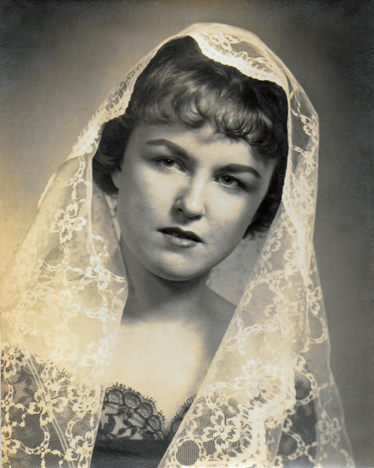
Photo courtesy Dale Strength
The photo below shows Jackie, Bill, and Country performer Floyd Tillman. Tillman’s name was on the marriage certificate as a witness, and may have been the best man. This photo would have been taken on or near the wedding day.
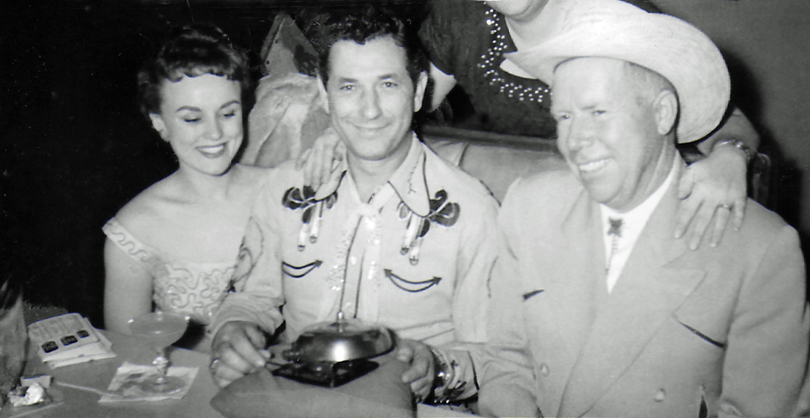
Photo courtesy Dale Strength
Bill’s sons Dale and Bobby lived with him in California, and remember having some fun times with Jackie.
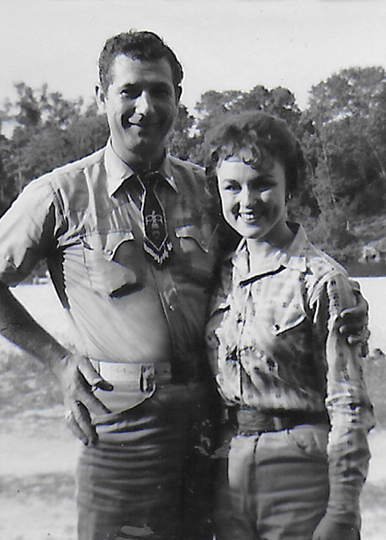
Photo courtesy Dale Strength
Excuse Me
By the fall of 1959, TBS’s marriage to Jackie had fallen apart. Ronnie Pugh described her packing for her departure back to Houston and George Jones’s Fan Club while the couple was being visited by Harlan Howard and Wynn Stewart. Howard told this story to Rich Kienzle:
Wynn and I were trying to figure out how in the hell to get out of there because it was embarassing. Finally Bill stood up and said, “Well, you guys’ll have to excuse me. I think I’ve got a heartache.” And he walked into the bedroom. Wynn and I left and were drivin’ away and I said, “Wynn, that’s a hell of a song title.” . . . A week or two later I jotted it down like I usually do and I told Buck [Owens] about it . . . “
Buck Owens recorded the song “Excuse Me (I Think I’ve Got a Heartache)” on December 23, 1959, and it became a No. 2 hit in the fall of 1960. TBS got no royalties for his title or his pain.
Despite the divorce, TBS and Jackie continued to have a hot and cold relationship. A letter from Jackie found in his archives, dated July 14, 1963, indicates that they had just been together (perhaps in California). Her words indicated that she had done something to make him doubt her fidelity, and she pledged her love to Bill in no uncertain terms, even suggesting that they remarry in the future. After that meeting, Bill returned to Minneapolis and Jackie flew back to Houston.
Jackie Young’s Murder
On Saturday, November 6, 1965, Jackie’s lifeless body was found in the back of her sports car in a pasture, “Four miles south, Highway 146 near La Porte.” She was 25 years old. Her death certificate shows that the immediate cause of her death was asphyxia due to strangulation. Her father reported that she had been a secretary in the steel industry.
A UPI article dated November 7, 1965, described her as a “secretary who wanted to be a country singer.” She died of one or more blows at the base of her skull, according to the medical examiner. A tire tool, the possible murder weapon, was found 62 feet from the car. It was later determined that the tire iron was from the trunk of her car.
On December 11, 1965, Billboard reported that TBS made a trip to Houston from St. Paul to aid the sheriff’s department in solving the mystery. On the night she was killed, Miss Young had attended a dance near LaPorte, a small resort town on Galveston Bay, at which George Jones and band were featured. The Jones band members, who were among the last to see Miss Young alive, were questioned and released.
TBS was told by the police that Jackie had been driving home and was drunk when she stopped for gas, so an attendant offered to drive her or forced his way into her car. He pulled off the road, and his attempt to sexually assault her were met with a ferocious battle, given the skin and blood under her fingertips. TBS was devastated, and reported to Billboard that he and Jackie had set a date to be remarried on February 20, 1966.
On June 6, 1966, Victor Eugene Miller, 21, was arrested in the Dallas suburb of Mesquite, and the next day he was indicted for the murder. He was described as an ex-convict living in West Memphis, Arkansas. He had indeed worked as an auto mechanic in the Houston area and had served time for breaking and entering and larceny in North Carolina. (AP report)
On March 18, 1967, Billboard reported that TBS was in Houston recently to attend the trial of the man arrested in the murder of Jackie. The trial was originally supposed to start on March 13, but was delayed when Miller’s court-appointed lawyers “angered the judge by submitting a thick stakc of pre-trial motions.” The trial was postponed to June 5, 1967. (Lubbock Avalanche Journal, June 6, 1967)
On May 7, 1967, Miller and two other prisoners in a new Harris County jail complex escaped through an open window and pressed a button that released a lock on a door leading outside. Miller supposedly had been assigned as a trustee on duty in a recreation room, according to the Liberty (Texas) Vindicator. The three were tracked down by bloodhounds and caught in woods four hours later about a mile from the jail. (AP report)
On July 13, 1967, a UPI story told the tale of a 21-year-old former Mexican night club hostess and exotic dancer who had been held in jail as a material witness for ten months. Juanita Gallardo Garcia was released on bond pending the trial, now set for August 21, 1967. Ms. Garcia had met Miller in Mexico in 1964. They fell in love, and swam the Rio Grande two weeks later. They lived in Charlotte, North Carolina for eight months, and Pasadena, Texas for almost a year before being separated accidentally in January 1966. They were reunited three days after he was jailed in June 1966. (UPI report)
After several postponements, the trial was set for August 21, 1967.
On September 1, 1967, Miller was found guilty of murder. Although the prosecution “vehemently demanded the death penalty,” the jury recommended he be given a life sentence. Miller, who had first admitted the slaying “to news media, police officers and others” (Liberty Vindicator) and then repudiated the admission, said he would seek a new trial. “I believe I’ll get justice somewhere along the line,” he was quoted as saying. He claimed to newsmen that he had never seen Mrs. Young. Jackie was described as a “four-time divorcee, last seen alive in the camper wagon of a Western music performer.” (AP report)
In 1968, the Liberty Vindicator printed a story that boasted of Liberty Attorney Boots Krueger, one of the defense lawyers for Miller. The sensational article said that the “attractive” “young divorcee” was found “strangled and brutally beaten.” The story of the murder trial was covered in a nationally distributed magazine, the Vindicator went on, and crowed that the verdict was a success since Miller did not get a death sentence. Thanks to the lawyer from Liberty. (All references to the Liberty Vidicator from March 28, 1968)
Thus ends the sad saga of Texas Bill’s second wife Jackie.
Back to 1959
TBS is currently filling some dates for Steve Stebbins, of Americana Corporation, Woodland Hills, California, and plans to remain on the West Coast for some time. (Billboard, June 22, 1959)
TBS typewrites from Hollywood that he’s set on a long string of club dates up and down the Coast by Steve Stebbins and that he plans to remain in that area indefinitely. (Billboard, June 29, 1959)
October 1959
On October 19 and 27, 1959, TBS broadcast on KFOX from 11:30 to midnight, as reported by the Long Beach Independent.
December 1959
On December 31, 1959, TBS was back in Minneapolis, at least for New Year’s Eve, as he hosted a huge New Year’s Eve show featuring:
- Jimmie Rodgers
- Porter Wagoner
- Johnny Horton
- George Morgan
- Anita Carter
- Bobby Lord
- Don Davis

Minneapolis Tribune, December 27, 1959
1960
A 1960 directory lists TBS living at 755 Orange Ave. in Long Beach with wife Jackie. His occupation is listed as Disc Jockey, KFOX. Either the directory was behind or Jackie was around longer than the fall of 1959.
An ad in the 1960 Country Music Who’s Who claimed that he was “soon to be heard on Challenge Records,” but that never panned out. (Ronnie Pugh)
January 1960
On January 21, 1960, TBS made one of his first appearances at The Big Fresno Barn. At this show he shared the stage with Cousin Herb Henson (a fellow DJ) and his Trading Post Gang.
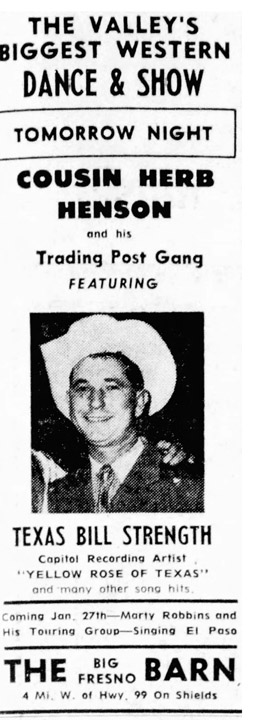
Fresno Bee The Republican, Friday, January 22, 1960
TBS has transferred his activity from KFOX, Long Beach, to KIKK, Bakersfield, where he is serving as program director and deejay. In addition, Texas Bill does a daily stint with Cousin Herb Henson on KERO-TV in the same city. Strength asks that artists and diskeries put him on the list for samples of new releases. (Billboard, January 25, 1960)
February 1960
On February 13, 1960, TBS headlined the dance and show at the Big Fresno Barn.
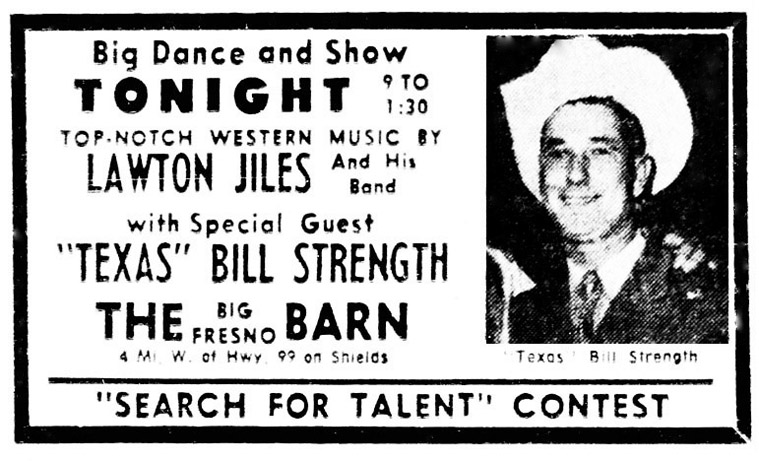
Fresno Bee, February 13, 1960
On February 19, 1960, TBS was on the bill with Ray Price and Pauline Parker at the Big Fresno Barn.
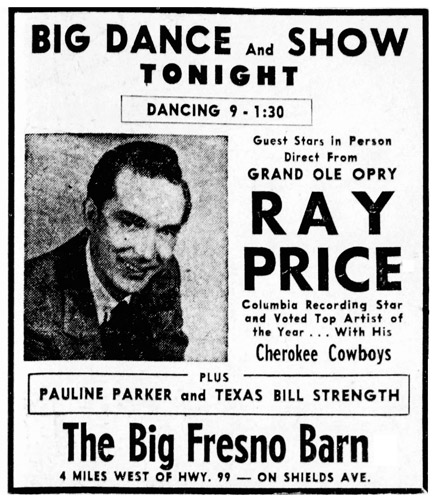
Fresno Bee The Republican, Friday, February 19, 1960
March 1960
On March 12, 1960, TBS was back at the Big Fresno Barn, this time again as the headliner.
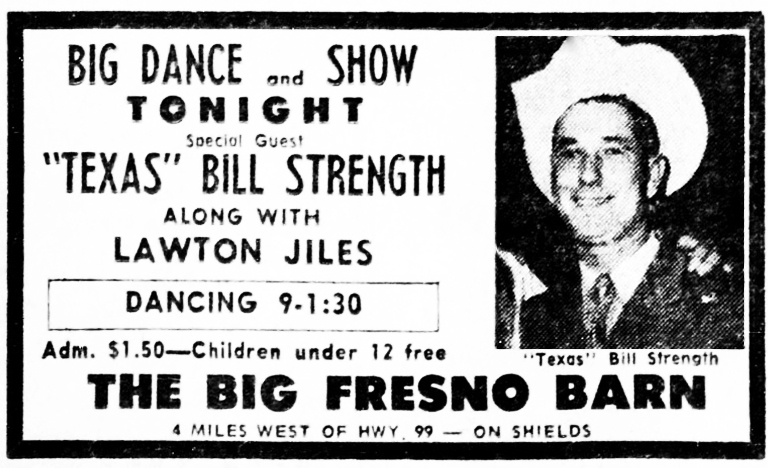
Fresno Bee, March 12, 1960
TBS, now on the staff of KUZZ, Bakersfield, requested that artists send him station breaks and their new records. (Billboard, March 28, 1960)
May 1960
On May 8, 1960, there was an open house at the Kaehn household, for TBS who was visiting in the area. He was on a personal appearance tour, and stopped off here, and rejoined the tour on the 9th in Texas. (Manske Sisters newsletter, May 22, 1960)
TBS was a guest on KCUL, Fort Worth, recently, en route from California to Minneapolis. (Billboard, May 9, 1960)
SUN RECORDS
July 1960
At the invitation of Sun Records promotional manager Cecil Scaife, TBS went to Memphis to record seven sides for the label on July 19, 1960. These were not made at the original Sun Studios at 706 Union Ave., but at Sam Phillips’ new recording studio, a few blocks away at 639 Madison Ave. Scotty Moore wrote on his website that the new studio had been in use off and on as early as January 1960 but was officially was launched on September 17, 1960. The producer is unknown, but the recording engineer was Charles Underwood.
Frank lists the personnel on these sides as:
- Bill Strength – Vocal and Guitar
- Scotty Moore – Guitar
- Stan Kesler – Steel Guitar
- R.W. “T-Willie” Stevenson – Six String Bass
- D.J. Fontana – Drums
- Larry Muhoberac – Piano
- The Gene Lowery Singers
You might notice that the list above includes the members of Elvis’ original band.

1960
As many as seven sides were recorded.
TBS’s only Sun record, Number 346, was issued in September 1960. It was reviewed by Billboard on October 3, 1960.
- “Guess I’d Better Go” – TBS has a strong side here. It’s in the best weeper tradition, with a country-oriented performance which can nevertheless go to pop.”
- b/w “Senorita” – “A bouncy side, with a Tex-Mex flavor. Contrasts sharply with the flip.”

- “Call of the Wild” was included on TBS’s Greatest Hits album, identified with the recording date of 1960. That may be the version recorded at Sun. It was also issued as a 45 on Twin Town Records in 1965, which may have been a re-recording. That version is available on YouTube. Interestingly, the writing credit for “Call of the Wild” was attributed to Cecil Scaife.
- “You Can’t Hurt Me Anymore” was written by TBS. In 2006, this song was released on a Sun Compilation record called “Sun Hillbilly.” This song can also be heard on YouTube.
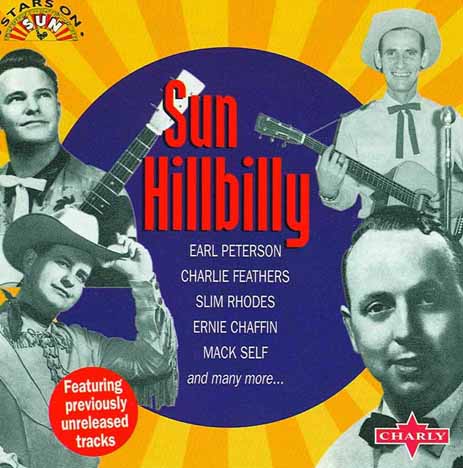
- “Nothing is Sweeter Than You” was released in 1973 on Brite Star, perhaps a re-recorded version.
- “Timber Man”
- “No More Listening”
Frank says “It is possible that some of the above recordings may have been recorded at a session held at Sun Studio on May 15, 1961. Alternatively, this may have been an overdub session.”
August 1960
TBS is back in Hollywood after a jaunt that took him to Chicago, Minneapolis, Houston, and, most recently, Memphis, where he signed a recording pact with Sun Records. His first release for Sun is due out in two weeks. (Billboard, August 22, 1960)
Strength will work club dates on the Coast until Nashville convention time in November, after which he plans to return to Minneapolis.
TOPPA RECORDS
In August 1960, TBS recorded two sides for the Toppa label, of Covina, California. Songs feature the steel of Ralph Mooney.
- “Watching the World Go By”
- “Picture of My Heart”
Billboard reviewed Toppa Record 1021 on August 22, 1960:
- “Watching the World Go By” – “The Texas singer handles this country novelty in good fashion as he explains that he’s lonesome.”
- b/w “Picture of My Heart” – “On this weeper the singer comes thru with a warm vocal, aided by good backing. Listenable waxing.”
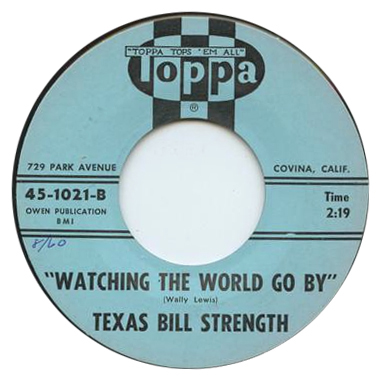
This one’s a little strange. Bill was awaiting the release of his two Sun sides in August 1960 that he recorded on July 19, 1960. On August 22, 1960, Billboard reported, “Meanwhile, he is plugging a new release on the Toppa Records label, of Covina, California, coupling “Watching the World Go By” and “Picture of My Heart.”” TBS would have another Sun session on May 15, 1961. Wouldn’t it be unusual to be signed with two record companies at the same time?
September 1960
On September 10, 1960, TBS was a guest star at Tom and Bill’s Palomino Club, Los Angeles’s Largest Western Night Club, located in North Hollywood.
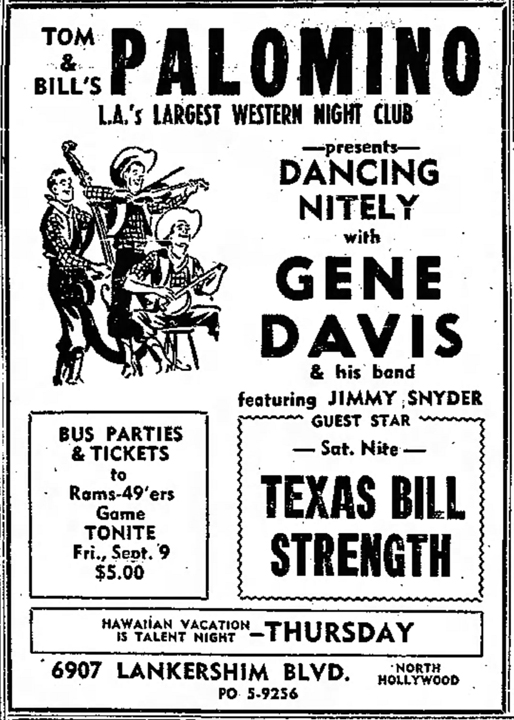
Valley News, Van Nuys, California, September 9, 1960
In September 1960, TBS Registered as a Democrat in Orange County. His address was 7681 El Monte Drive, Buena Park, California.
October 1960
On October 8, 1960, TBS entertained the Okies in Ventura County on a big Saturday night.
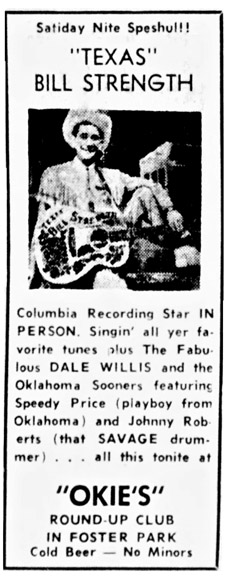
Ventura County Star Free Press, Friday, October 7, 1960
TBS spent four days in the San Francisco sector last week, playing dates for Blackjack Wayne and making radio and TV personals on KNBA, Vallejo, California. Bill, who is presently kicking up dust with his new Sun release, “Guess I Better Go,” will make the country music festival in Nashville November 4-5, after which he plays dates in Tucson and Phoenix with Merle Travis, booked by Raymac Enterprises, Anaheim, which also handles Skeets McDonald, Joe Maphis, Eddie Dean, Johnny Bond, Bonnie Sloan and Rose Maddox. (Billboard, October 24, 1960)
Skeets McDonald placed an ad thanking (disk jockeys?) for putting his song “This Old Heart” on the charts. “also my deepest thanks for your help on “Guess I’d Better Go” TBS (Sun Records).” (Billboard, October 31, 1960) This is curious, since they were on two different labels and McDonald wasn’t a writer of the song.
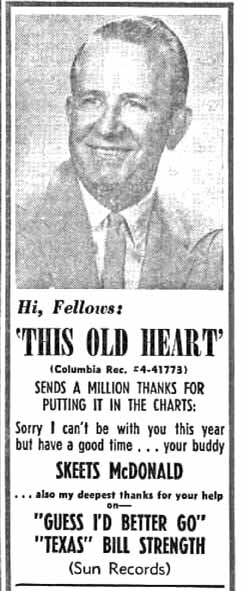
November 1960
TBS had the first of three appearances at the Tucson Gardens on November 11, 1960, along with Bonnie Sloan. Ads were placed in Phoenix and Tucson papers.
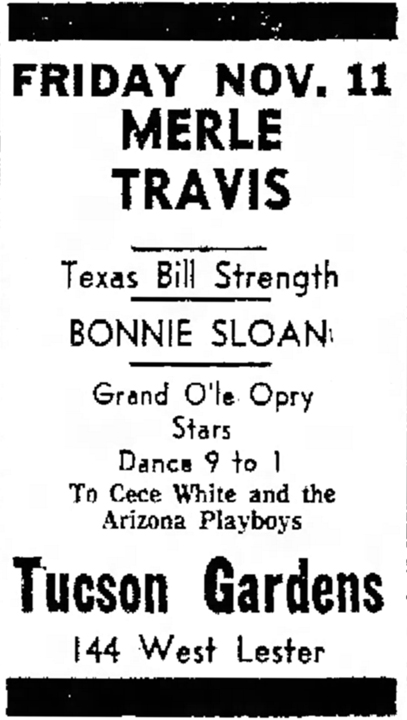
Tucson Daily Citizen, November 11, 1960
Bill returned to the Palomino as a Special Guest Star on November 19, 1960.
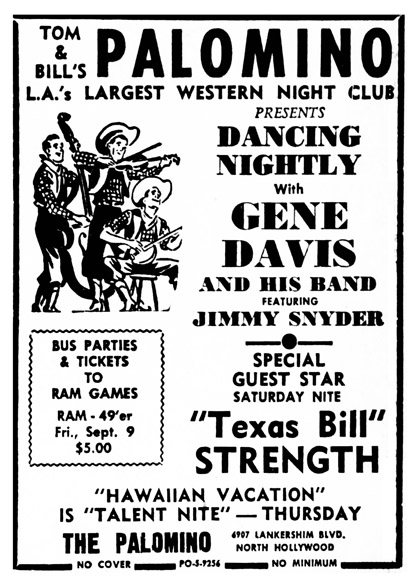
Valley Times Today, North Hollywood, Friday, November 18, 1960
1961
January 1961
SUN RECORDS
TBS departed Anchorage, Alaska, January 16, 1961, for Memphis to cut another session for Sun Records. Texas Bill, together with Bonnie Sloan, played the Montana Club in Anchorage, with appearances on KENI-TV, KFOD and KBYR. The Montana Club is located at 222 Fourth Avenue, Anchorage. The Sun Records firm, which recently knocked the “Texas” off of Bill Strength’s name, will revert to the Texas Bill billing when they spring with his new release. (Billboard, January 23, 1961)
If there were any records released from such a session, they don’t seem to be listed anywhere.
February 1961
The second ad found for the Tucson Gardens was for February 24, 1961.
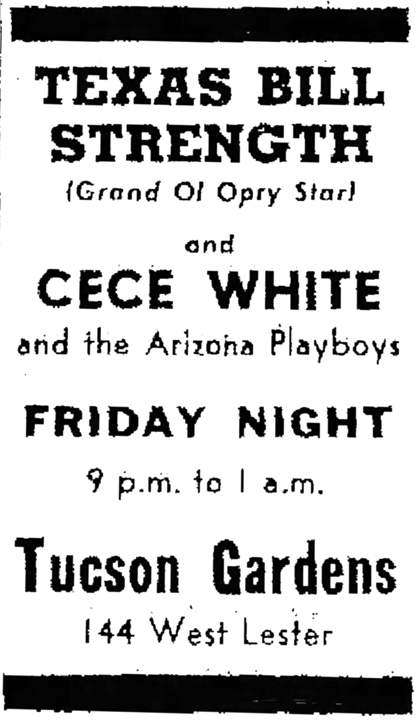
Tucson Daily Citizen, February 24, 1961
April 1961
On April 22, 1961, TBS worked the Grand Ole Opry in Nashville. (Billboard, May 15, 1961)
On April 29, 1961, TBS worked the Big D Jamboree in Dallas. (Billboard, May 15, 1961)
May 1961
On May 5, 1961, TBS appeared at Todd’s Western Club in Fort Worth.
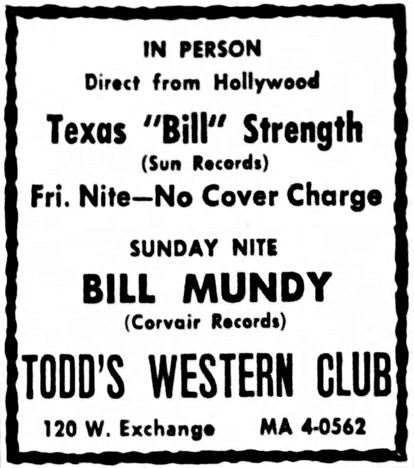
Fort Worth Star Telegram, May 5, 1961
On May 6, 1961, TBS worked the Cowtown Jubilee in Fort Worth. (Billboard, May 15, 1961)
SUN RECORDS
Bill Strength has just finished another session for Sam Phillips’s Sun Records, with release due any day now. (Billboard, May 15, 1961)
TBS’s third performance at the Tucson Gardens was on May 27, 1961.
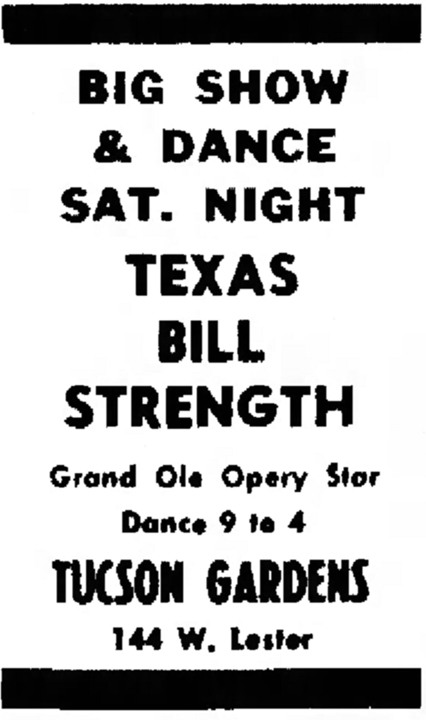
Tucson Daily Citizen, May 27, 1961
June 1961
TBS landed in Chicago last week after playing a string of engagements in and around his native Houston. En route to the Windy City, Bill stopped off in Tucson for a stand at Tucson Gardens (see above) and appearances over KUUN-TV and KMOP Radio. (Billboard, June 12, 1961)
September 1961
On September 6, 1961, TBS was apparently appearing at the Frontier Bar in Madison, Wisconsin, although this ad is confusing. It is from the Wisconsin State Journal, which is/was published in Madison.
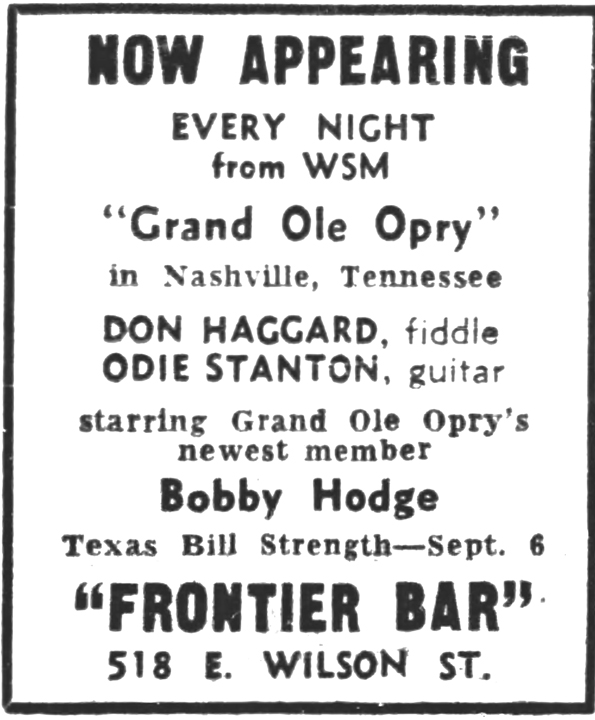
Wisconsin State Journal, September 6, 1961
BACK TO MINNESOTA
Six years after he had first come to Minnesota, TBS was back, this time to stay. When asked why he had returned in a 1970 interview, he responded, “Well, KTCR had just started with country music so I could go to work for them. Beside, Minneapolis and its people have always been good to me.”
This is a fun find. Dale had the photo below, of his dad with the North Sisters at a personal appearance, with no date. Appears to be at one of the many car dealers on Lake Street. Years later, Jan Sherman (North) came up with a similar photo, obviously taken at the same event. This time she could name the year, and because the photo had Stonewall Jackson in the lineup, a quick look at the Flame appearance spreadsheet allowed us to deduce that the date was September 16, 1961!

Jan, Bill, and Patti. Photo courtesy Dale Strength
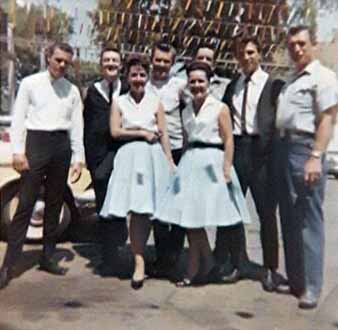
Back Row, No. 1 & 4: Members of Chill Hilmin’s band; No. 2: Duke Larson; 3: Stonewall Jackson; 5: Chill Hilmin; 6: TBS. Front: Jan and Patti North. Photo courtesy Jan Sherman
This ad from Dale indicated that the Montana Club was in Anchorage, Alaska, and was dated September 21, 1961. The ad says he was appearing through October 8.
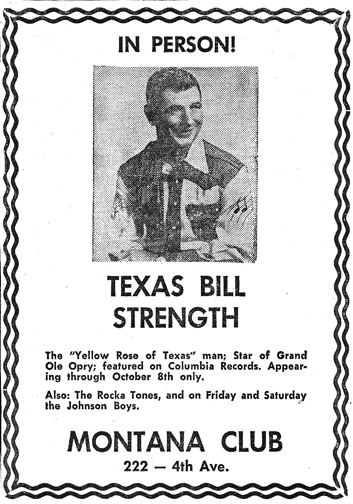
Ad courtesy Dale Strength
Billboard indicated that TBS had been at the Montana Club back in January 1961. The ad below could have been from either appearances or even another one – apparently Alaska was one of Bill’s favorite retreats.
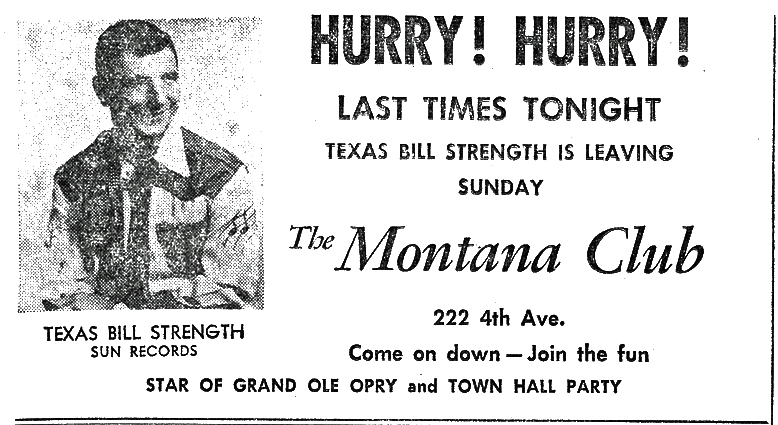
Ad courtesy Dale Strength
November 1961
Jimmy Simpson, of Radio Alaska, Anchorage, reports that Lefty Frizzell and TBS are scoring handsomely on personals in the Anchorage area. Jimmy had them as recent visitors on his air show. (Billboard, November 13, 1961) This must have been before TBS started his job as “permanent emcee” at the Loon.
THE LOON
From November 7 to 12, 1961, Pee Wee King and Redd Stewart were featured at a new C&W club, the Loon, which has made its bow at 2935 Nicollet Ave., Minneapolis, with TBS as permanent emsee. Owned by the operator of the present Torch Club there, the Loon operates Tuesday through Sunday, with Sunday shows starting at 4 pm. (Billboard, November 20, 1961)
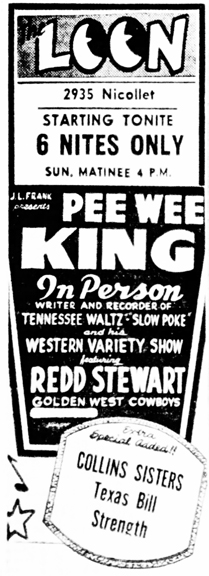
Minneapolis Tribune, November 7, 1961
From November 14 to 19, 1961, Lonzo and Oscar were featured at the Loon, with TBS as emsee. (Billboard, November 20, 1961)
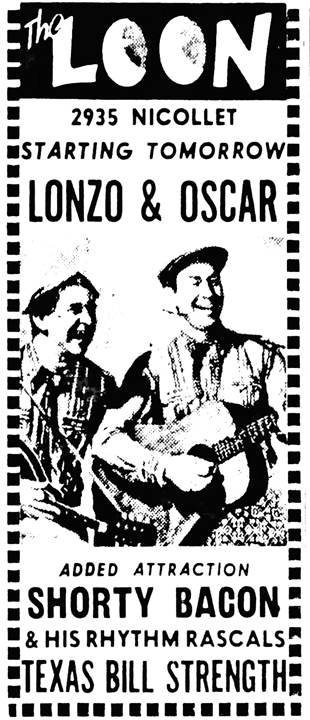
Minneapolis Star, November 13, 1961
The ad below is only for Shorty Bacon at the Loon on November 15, 1961, with TBS, “Minneapolis’ Favorite Son,” also on the bill. (Billboard, November 20, 1961)
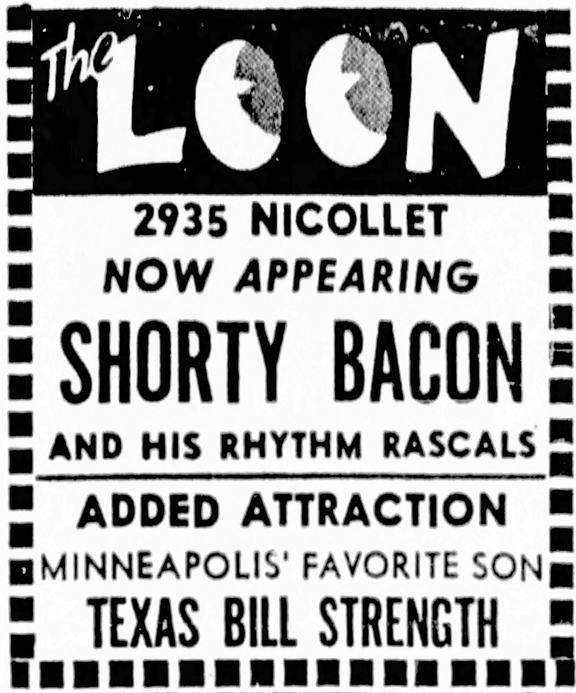
Minneapolis Tribune, Wednesday, November 15, 1961
Jerry Reed performed at the Loon on November 21 to 26, 1961. (Billboard, November 20, 1961)
Claude Gray performed at the Loon on November 28 to December 3, 1961. (Billboard, November 20, 1961)
December 1961
Wanda Jackson and her all-girl unit performed at the Loon from December 5 to 10, 1961. (Billboard, November 20, 1961)
THE TORCH
From December 6 to 10, 1961, TBS worked at the Torch, which was at 607 W. Lake Street – now the site of Dulono’s Pizza.
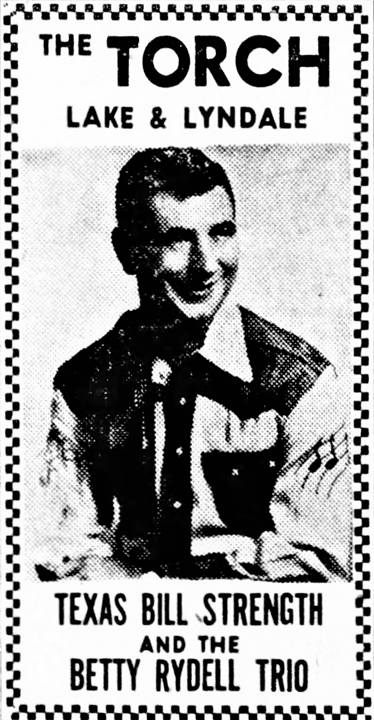
Minneapolis Tribune, December 1961
1962
February 1962
On February 4, 1962, Texas Bill’s first wife, Dorothy L. Altman, married Thomas Edwin Pettis, Jr. in Harris County, Texas. She was 31 and he was 36. They divorced on February 2, 1981, and had no children.
On February 11, 1962, TBS performed two shows at the UAW Hall in Chicago Heights, Illinois. Other stars on the bill were:
- Lonzo and Oscar
- George Jones
- George Riddle
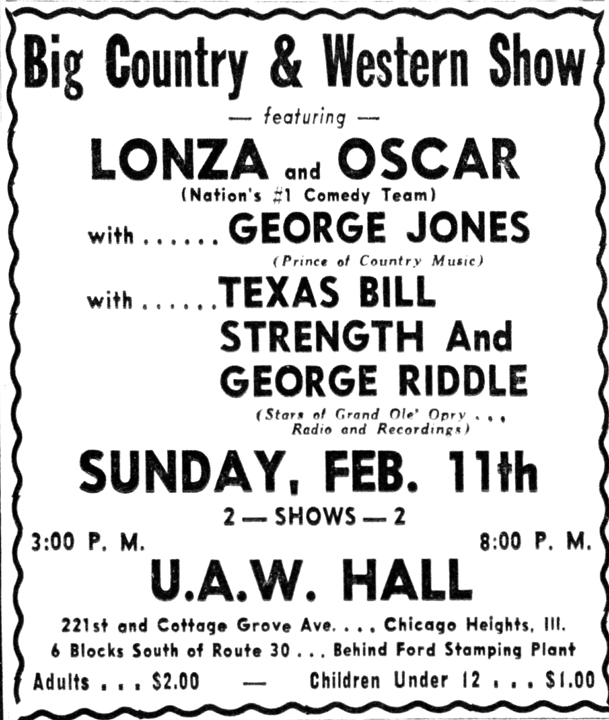
The Times, Munster, Indiana, February 11, 1962
March 1962
TBS and his Western Swing Band appeared throughout the month at the CC Tap Bar in March 1962.
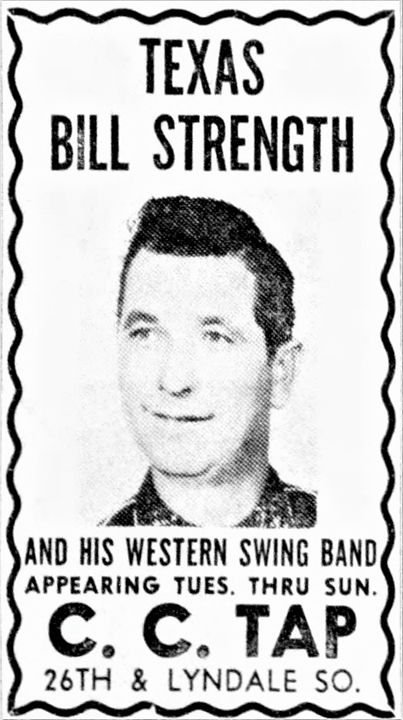
Minneapolis Star, March 8, 1962
In a March 24, 1962, article in Billboard, a column by Bill Sachs headed “Folk Talent & Tunes” had a lot of news about TBS:
ALASKA
Already a fish out of water, being a Southerner living in Minnesota, Texas Bill loved to get even further north to Alaska to perform and to hunt.
In the first week in June, 1959, TBS hops to Alaska for a 10-day trek. (Billboard, March 16, 1959.
TBS departed Anchorage, Alaska, January 16, 1961… (Billboard, January 23, 1961)
Jimmy Simpson, of Radio Alaska, Anchorage, reports that Lefty Frizzell and TBS are scoring handsomely on personals in the Anchorage area. Jimmy had them as recent visitors on his air show. (Billboard, November 13, 1961)
He recently returned from his third [presumably fourth] jaunt to Alaska, where he played the U.S. Air Force bases in Kodiak and Anchorage and appeared with Paul Harper and His Western Combo at Anchorage’s Alibi Club. (March 24, 1962, Billboard, in a column by Bill Sachs headed “Folk Talent & Tunes”]
SUN RECORDS
TBS recently stopped off in Memphis to cut six more sides for Sam Phillips’ Sun Records and says he has an album coming up on the lable early in the summer. (March 24, 1962, Billboard, in a column by Bill Sachs headed “Folk Talent & Tunes”] Prague Frank has no record of a Sun session after May 15, 1961.
April 1962
KTCR
KTCR signed on as a Country station in Minneapolis on April 5, 1962. The 1929 Model A below was TBS’s signature car until he sold it to Johnny Cash in 1970. According to an item by Will Jones, Cash wanted to use it in a movie.
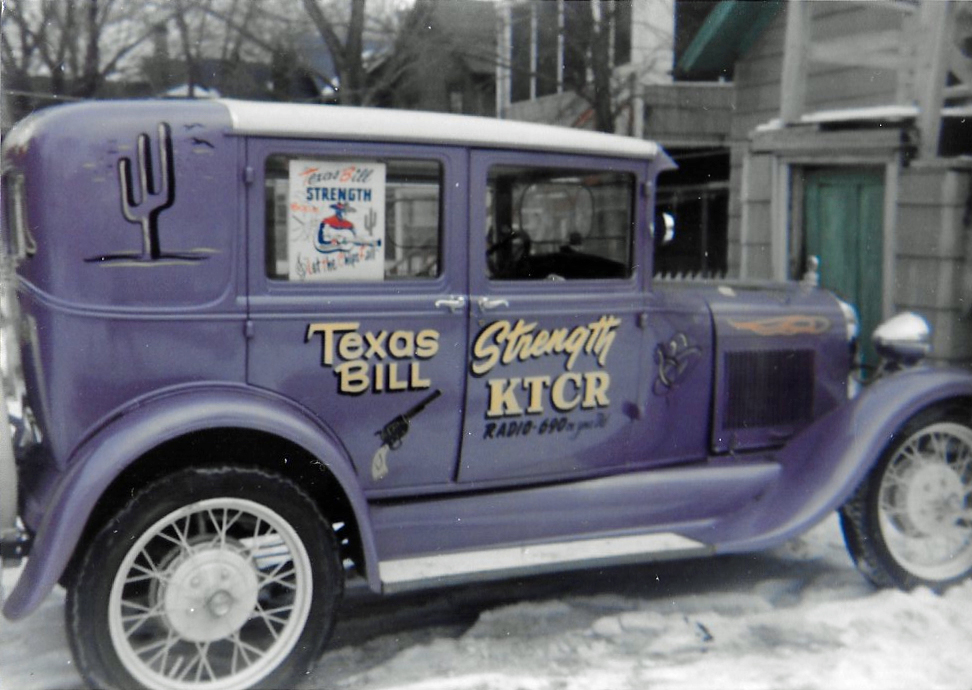
Photo Courtesy Dale Strength
May 1962
George Grimm:
On extension 345 came a voice with a drawl so musical you expected the guitar to start its accompaniment.
“This is TBS,” the southwest-flavored words said. “You know anybody who’d like about 300 old law books? I got ‘em from Mister Eaton who runs Eaton’s ranch south of town here. Figured I’d do a little law book readin’. But I never got to it. Had a couple of attorney friends look the books over. They said they’re useful, but a little outdated. Like I have a complete set of ‘Corpus Juris’ but now there’s a ‘Corpus Juris, Secundus’ that took over. Anyway, maybe one of your readers would like those 300 law books. All he has to do is to drive out to my house and pick them up.”
Texas Bill – with that drawl what else could you want to call him – says please don’t phone. Just arrive with your transportation and take the books with you. His address: 2514 So. 15th Ave.
Even when that fellow talks about law books, it sounds like the verse of a song about somebody’s true, true love!
Minneapolis Tribune, May 7, 1962
June 1962
In addition to his deejay chores at KTCR, and working area dates with his own band, TBS is handling bookings for a nearby club using acts Thursdays through Sundays. (Billboard, June 16, 1962)
August 1962
At the end of August (but before August 23, 1962), TBS went to New York to call on DJs and other trade folk. (Billboard, September 1, 1962)
On August 26, 1962, TBS made an appearance at Twin City Speedway.
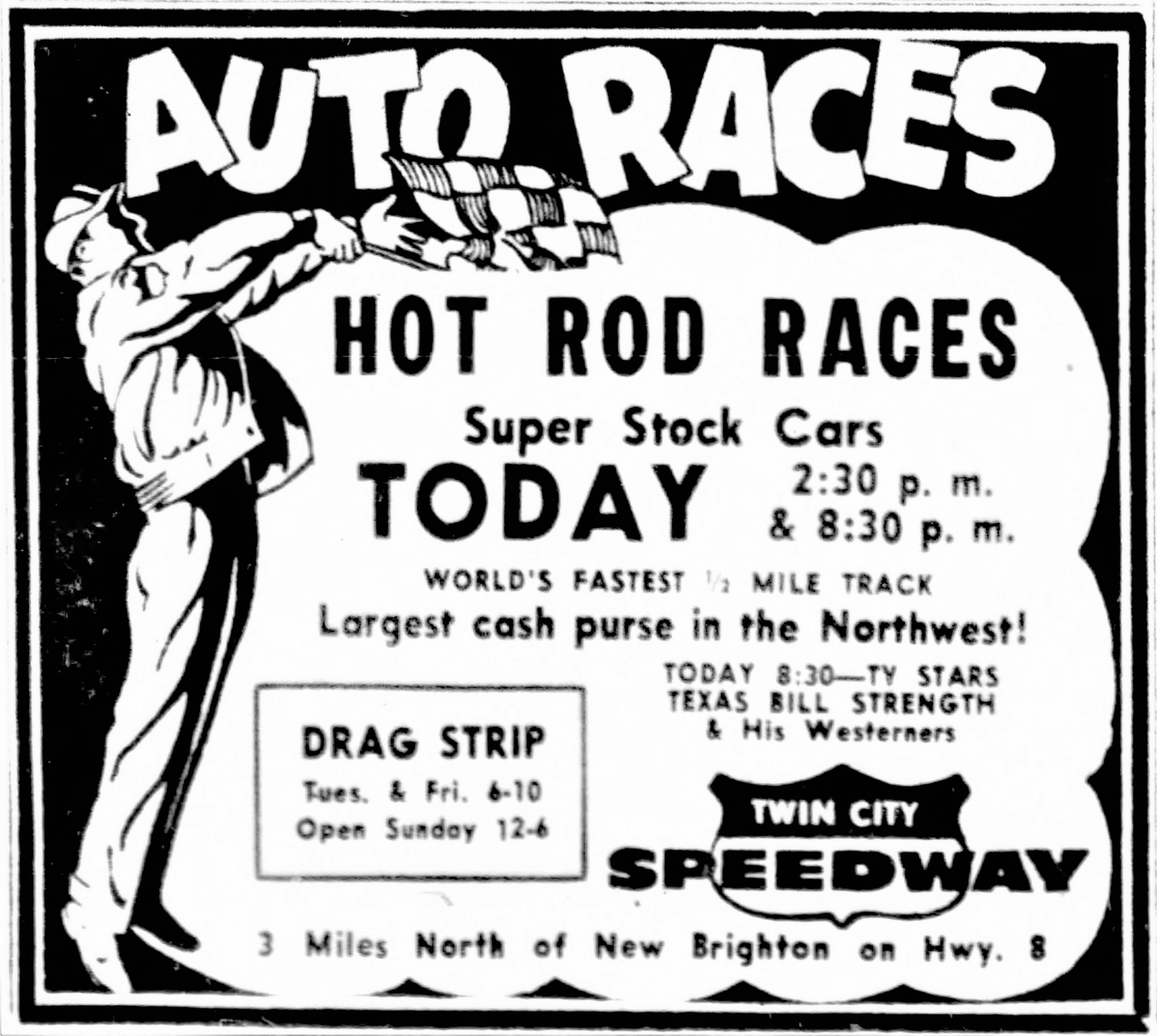
Minneapolis Tribune, August 26, 1962
THE 1962 SHOOTING
The headline in the August 23, 1962, article in the Minneapolis Star read: “Disk Jockey Critically Shot in Scuffle in Apartment:” TBS was described as a disk jockey and a singer at Triviski’s Bar, 678 Selby Ave. in St. Paul.
The night before, August 23, TBS and a friend, Donald “Duke” Larson, were playing behind Barbara Lee Mac at Triviski’s. After the show, they met two young ladies, Barbara Lindberg, 20 (Duke’s sister-in-law), and Rose Kasown, 19. (TBS was 34) They all went to the girls’ first floor apartment at 2437 Elliott Ave. So.
At 2:30 am, the upstairs neighbor, Marcus J. Styer, 26, got fed up with the noise and called the police, but the four went out to eat and were gone when police arrived. The four came back to the girls’ apartment at 3:15 am, and Duke and Rose left. TBS and Barbara sat in the kitchen talking. Finally Styer, who had been in a Wisconsin mental institution in 1957 and 1958, had had enough of the noise. He grabbed his shotgun and headed downstairs.
There accounts differ as to whether Styer burst in shooting or whether TBS grabbed the gun and it went off accidentally. Larry LaPole, Barbara’s brother-in-law, fellow country performer, and Bill’s good friend, said that when Bill opened the door the shotgun went off. Either way, TBS was left with a shotgun wound in the right thigh. Styer said that he used his belt as a tourniquet while Barbara called the police.
Officers arrived at 4:23 am to find TBS lying on the floor of the apartment, and the shotgun leaning against the wall in the hallway. Styer told police, “I shot him and gun isn’t loaded.”
The next day, August 24, the Minneapolis Star reported that Styer was charged with with second degree assault. It also said that TBS was taken off the critical list at General hospital but was still considered serious from a shotgun wound in the groin.
Now this is odd. TBS had actually been hit in the upper right thigh, which the Star had correctly reported the day before. His son Dale says it was a two inch hole, and Larry LaPole described it as just inches from the family jewels.
THE MINNEAPOLIS DAILY HERALD
A bit of explanation here: From April 13 to August 7, 1962, the Minneapolis Star and Tribune were on strike. On May 1, 1962, the Minneapolis Daily Herald was created by businessman Maurice McCaffrey to pick up the slack. He intended for the Herald to continue, even after the Star and Tribune’s strike ended, and it did for a while, but the last issue of the Herald came out on October 1, 1962.
Nonetheless, there was some overlap, and the Herald seemed to care about the medical progress of TBS much more than the big boys, often putting its articles on Page One. The following information was taken from articles from the Minneapolis Daily Herald.
August 23: TBS was taken to General Hospital (now Hennepin County Medical Center). Styer was held in city jail. Styer told police he became irritated with Strength’s singing. He accosted the entertainer with a .12 gauge shotgun but claimed that Strength caused the weapon to fire when he tried to knock it out of Styer’s hands. Homicide officers said that Strength was hit it in the lower abdomen. [There must have been a lot of blood to confuse a leg with a lower abdomen…] Styer was booked in the morning on an open charge for further questioning. The names of the persons whom Strength was visiting were not released.
August 24: “Singer Said to be Better”
Disk jockey and singer “Texas Bill” Strength was taken off the critical list Thursday night in General hospital. Staff personnel said the shooting victim’s condition was revised to “serious.”
August 18, 1962: “Texas Bill Still ‘Serious’; Gun Wielder Charged.”
TBS’s condition remained serious. Styer was chared with second degree assault.
August 31: “Texas Bill Recovers.” This front page story with a headshot of Bill in bed had this caption:
Stilll in serious condition from a shotgun wound is “Texas Bill” Strength, who already has had three surgeries and now is due for a fourth at General hospital. The night club entertainer and disk jockey was shot Aug. 24 following an altercation at 2437 Elliott Av. S. Held on a second degree assault charge on the case is Marcus Styer, 26, of the same address. He is alleged to have acosted Strength at 4:45 am in relation to a disturbance at the apartment below his. Texas Bill told a Daily Herald reporter: “Disturbance? I didn’t even have my guitar with me.”
September 1962
On September 5, the headline read: “Texas Bill Faces Fifth Surgery.”
TBS was still in serious condition, and was told he may have a fifth surgery soon. This article repeated the “lower abdomen” description.
The September 27, 1962, headline read: “Texas Bill Strength Shows Improvement.”
His condition has dropped from critical to serious, and for the first time in 36 days, and six operations, Texas Bill Strength, disk jockey and night club entertainer, seemed to be evidently on the mend. Texas Bill was wounded in the upper left thigh by a shotgun blast Aug. 24.
Now, let’s give the Herald it’s due for reporting more frequently on the condition of TBS, but there are some problems that may be indicative of why the paper didn’t last.
- The Star reported from the beginning that the wound was in his leg, not his “lower abdomen,” which the Herald was still reporting in September.
- The Star also knew from the beginning the names of the other people in the apartment, which the Herald couldn’t come up with.
- Maybe his condition went up and down, but TBS seemed to go from critical to serious twice.
- TBS also seems to have recovered twice.
A search for information about the Herald yields this scathing report of its demise in Time magazine (October 12, 1962):
Hastily flung together by Maurice McCaffrey, a Minneapolis adman, the error-prone and amateurish Herald rose to a circulation of 140,000 simply because news-famished Minneapolitans would buy anything. But when the city’s two dailies resumed publication last July, Herald circulation fell with a sickening thump. Last week McCaffrey’s Herald, anemic and skinny, gave up the ghost.
And here ends our visit to the Minneapolis Daily Herald. We thank them for their chronology of TBS’s condition and surgeries.
By the way, those big guys weren’t always right either. A photo in the initial report of the shooting run by the Star on August 23 identified TBS as “William Straight.”
BENEFIT
Will Jones reported that some musician friends would hold a benefit for TBS, who was still in the hospital. It was scheduled to take place at the Hitching Post on Highway 61 in Forest Lake on September 9, 1962, from 1pm to 1am. Ten bands and 20 acts were scheduled to perform. (Minneapolis Tribune, September 6, 1962)
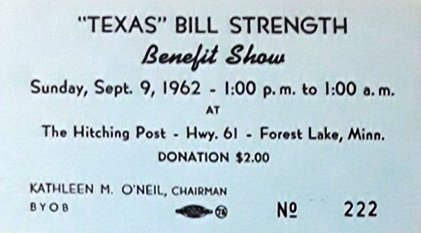
Ticket to the Benefit, courtesy Jan Sherman
About a week later, a delegation visited Bill in the hospital to deliver the check from the benefit. Jan Sherman found him with both of his legs elevated in stirrups – she thought both inner thighs were affected. The wound looked like “strips of bacon” where the skin grafts were being done, taken from his back and sides.
In the photo below, Teddy O’Neil, husband of benefit organizer Kathleen O’Neil, presents Bill with the check from the benefit.
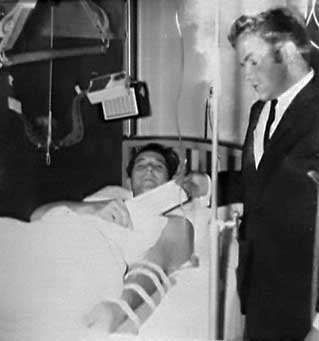
Photo courtesy Jan Sherman
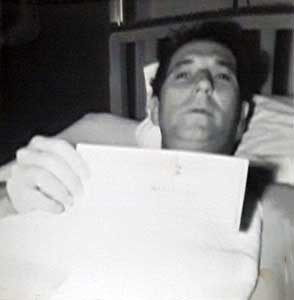
Bill with his check. Photo courtesy Jan Sherman
Below, Jan’s brother Dan Northrop presented a sport jacket to TBS. Dan won it in a raffle at the benefit after spending about $50 in tickets. Dan is sort of propping Bill up in bed.
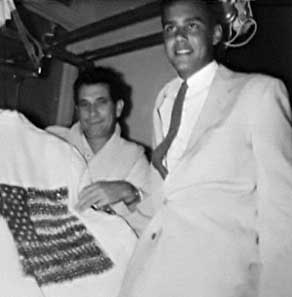
Photo courtesy Jan Sherman
In the picture below, Jan Sherman and Ted O’Neil are shown visiting. Note radio over the bed.
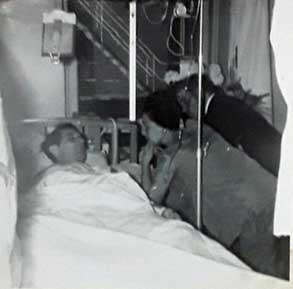
Photo courtesy Jan Sherman
Larry LaPole also visited Bill at the hospital, and recalled TBS saying to him that he was “all done with the wild side of life.”
November 1962
THE TRIAL
Styer’s trial opened in Hennepin County District Court on November 15, 1962. Barbara Lindberg admitted that there had been some noise at about 2 am that night, when she and Rose Kashown were throwing a baseball around with a dog and the ball broke a window. Just before the shooting, she said that she knocked an ironing board into a tin cabinet while going to let the dog out. This time she said that she was the one who applied a tourniquet. She also testified that he kept saying “I’m sorry, I’m sorry, I didn’t know where the noise was.” He pleaded with them to tell police that TBS had grabbed the gun, she said.
On November 19, 1962, Styer took the stand, testifying that he heard “repeated outcries of a woman’s voice” and took his shotgun downstairs to frighten the noisemakers, not checking to see if it was loaded. He denied the allegation that he “burst in,” saying that he and TBS engaged in conversation for several minutes. Styer told him to quit making a disturbance and get out, and TBS mumbed several times “I’ll go,” but then TBS grabbed the end of the gun, which was pointed in the air, and brought it down. This caused Styer’s finger to brush the trigger, and the gun discharged.
After deliberating only two hours, the jury found Styer not guilty of the charges on November 21, 1962. The jury did not believe the “burst in” story (or apparently the wrestling with the gun theory) in light of the contention of the State that the X-ray pattern of the gunshot wound showed that he was a good eight feet away from Styer at the time of the shooting.
GOLDEN WING RECORDS
In 1962, TBS has a recording session that was probably in Minneapolis, for local label Golden Wing:
- “Let the Chips Fall”
- “Foolish Pretender”
Discogs.com has no date for this single (GW 3013), but the last verse of “Let the Chips Fall” is about the shooting. (Thank you to Sherwin Linton for pointing this out.) The writer of both songs is listed as P. Wegman.
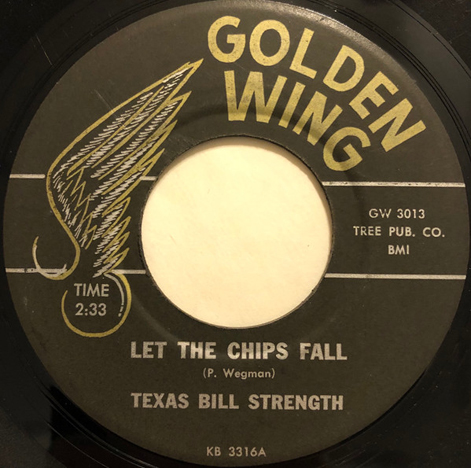
At the end of 1962, TBS did a series of appearances for Atlantic Mills Department Stores.
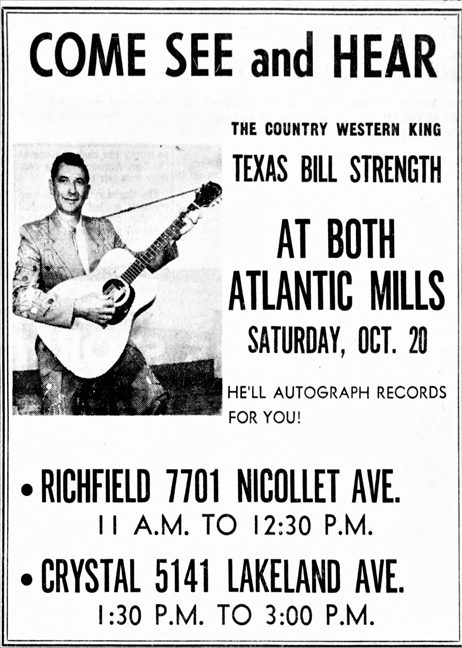
Minneapolis Star, Thursday, October 18, 1962
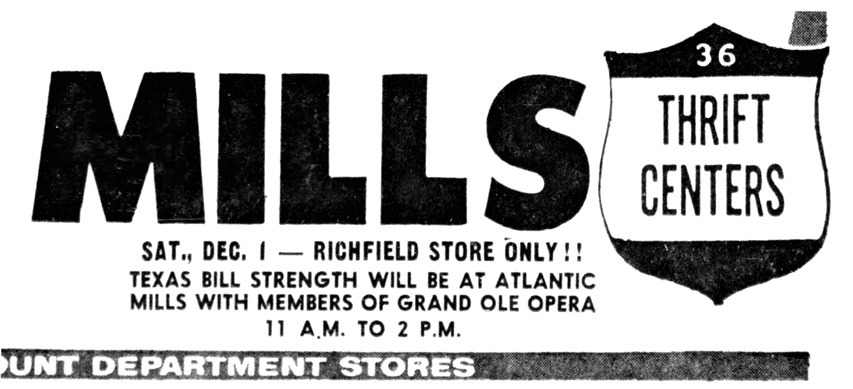
Minneapolis Star, November 29, 1962
1963
Another Golden Wing session was apparently held in 1963, resulting in GW 3024. It was released on the Golden Ring subsidiary label.
- “Tears in my Beer,” written by TBS
- “Let’s Make Love”
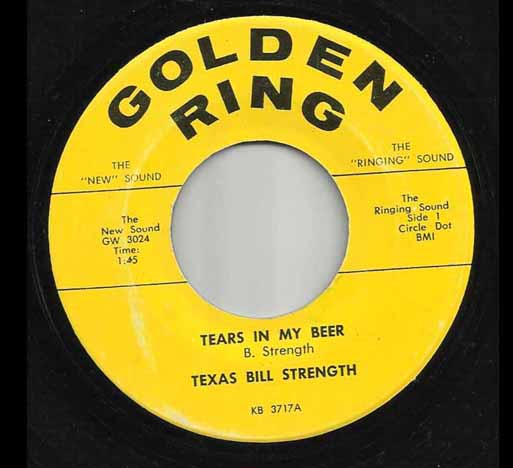
Sometime in 1963, TBS ran for the board of directors for the musicians union, as evidenced by the flyer below:
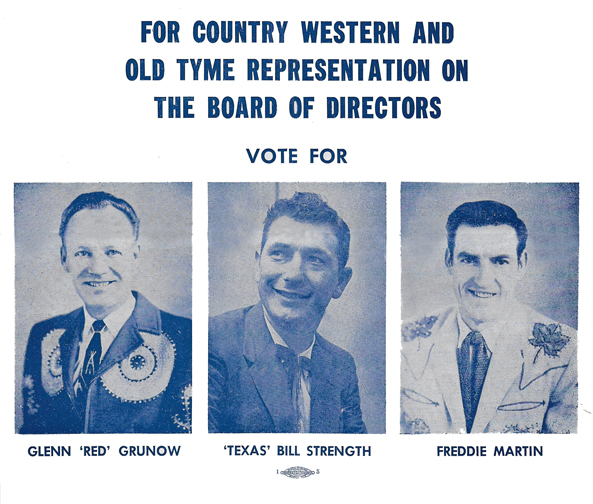
Image courtesy Dale Strength
May 1963
On May 16, 1963, Rex Allen was in town for a stint at the Flame, and Will Jones relayed this story:
Like all true night club performers, he even enjoys zinging an inside joke. TBS, who was involved in a shooting scrape not long ago, was in the audience the other night. During a bit in which Allen showed off his cross-draw 45s, he looked over at Strength’s table and said: “Y’don’t hafta worry, Bill, they’s blanks in these.”
June 1963
On June 8, 1963, KTCR presented the Grand Ole Opry at Met Stadium. Headliners were:
- Claude King
- Skeeter Davis
- Don Gibson
- Merle Travis
- Tex Ritter
- Marvin Rainwater (who was robbed of $650 from his suitcase at the Leamington Hotel)
- Roy Drusky
- Bobby Hankins
- Texas Bill Strength, emcee

Minneapolis Tribune, June 6, 1963
July 1963
A letter from his ex-wife Jackie indicated that TBS and she had met somewhere before July 14, 1963, that was neither Minneapolis nor Houston. TBS had his sons with him.
July 21, 1963: TBS and his Troubadors appeared at the Hot Rod Races at Twin City Speedway.
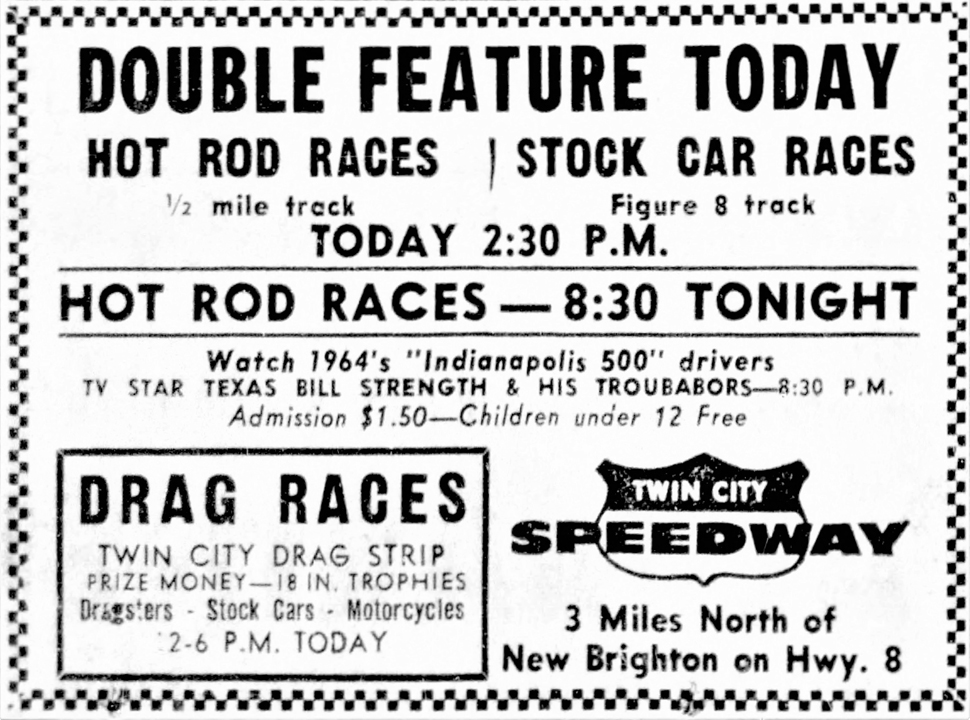
Minneapolis Tribune, June 23, 1963
August 1963
On August 16, 1963, someone recorded his show on KTCR-AM, and it is available to hear on Rick Burnett’s website, Twin Cities Radio Airchecks. The songs themselves are “scoped.”
November 1963
Minneapolis was in the middle of a huge folk music craze in 1963, and Hootenanny was the word of the hour. Apparently the organizers of this Muntz TV Hootenany event on November 10, 1963, thought that folk music consisted of Country music and polka. Hopefully WDGY brought some Kingston Trio records.
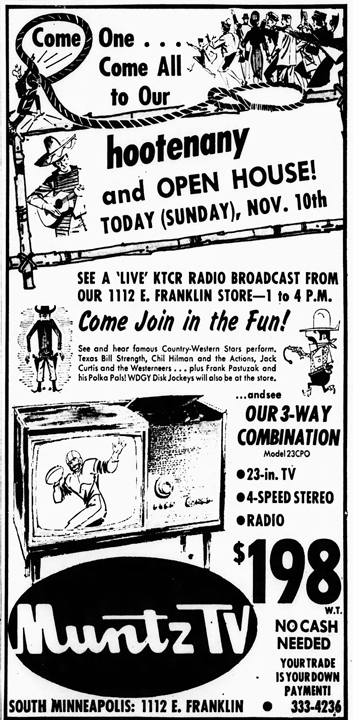
Minneapolis Tribune, November 10, 1963
December 1963
On December 7, 1963, TBS did a remote broadcast from Downtown Crystler-Plymouth from 2 to 4:30 pm, along with Jack Curtis and the Westerners and guest stars.
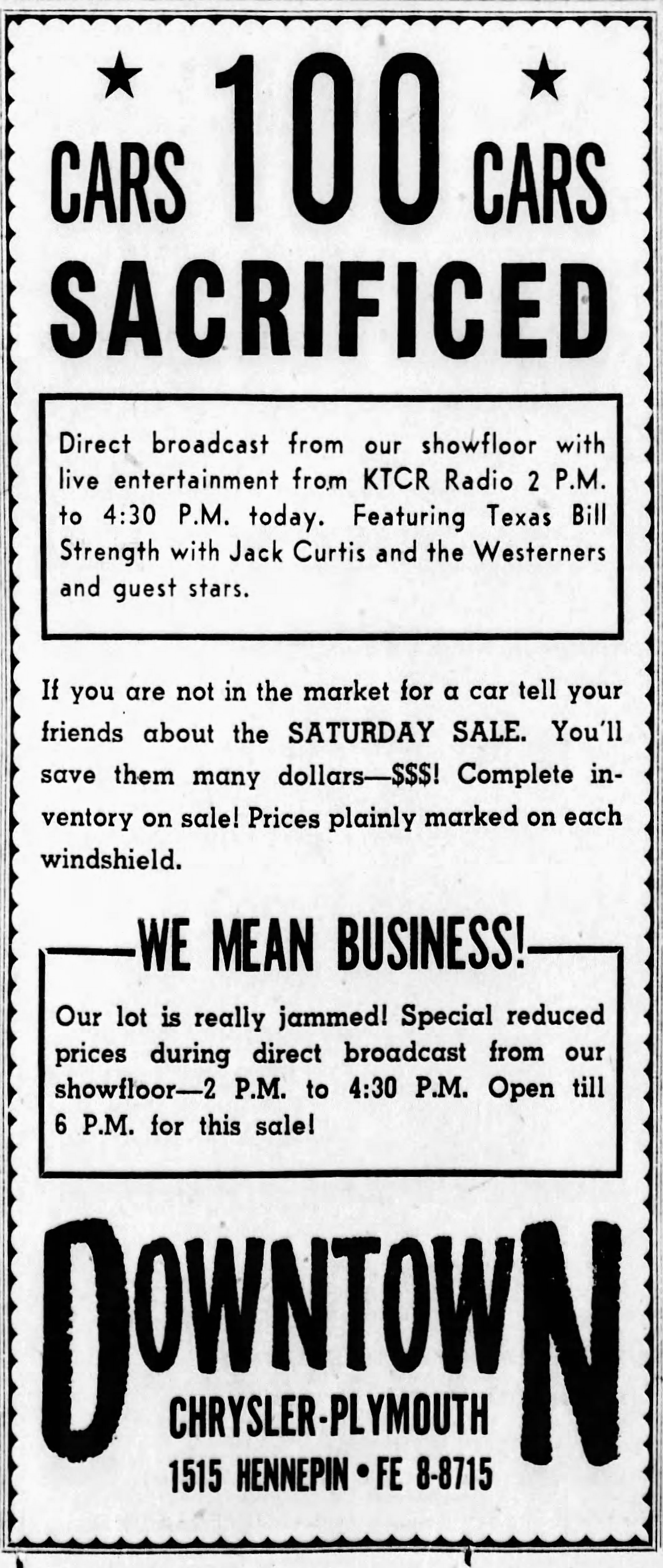
Minneapolis Star, December 7, 1963
1964
January 1964
On Saturday, January 25, 1964, TBS performed in a Grand Ole Opry Show at the Mayo Clinic Auditorium Theatre in Rochester. Also on the bill were:
- Bill Anderson
- Bob Luman
- Bob Prouty
- June Harreld
- Sharron Sparrows
- Topper Country Playboys

Winona Daily News, January 21, 1964
February 1964
On February 15, 1964, there was a Grand Ole Opry Show, Blockbuster Number 3, at the Minneapolis Auditorium. These Grand Ole Opry shows were booked by a DJ named Smokey Smith from Iowa. This show featured:
- Faron Young
- Webb Pierce
- Lefty Frizzell
- Earnest Ashworth
- Sonny James
- Elton Britt
- Jan Moore
- Texas Bill Strength

Minneapolis Tribune, February 15, 1964
This show played to 7,308 paid admissions, grossing over $16,700 – a record gross for Smith in the three years he has been promoting country shows at the Minneapolis Auditorium. (Billboard, February 29, 1964)
April 1964
Spinning the country platters on KTCR are Jay Jenson, Vern Arthur, TBS, and Johnny Long. (Billboard, April 18, 1964)
June 1964
TBS, along with the Minnesota Twins, appeared at Midway Ford on June 25, 1964.
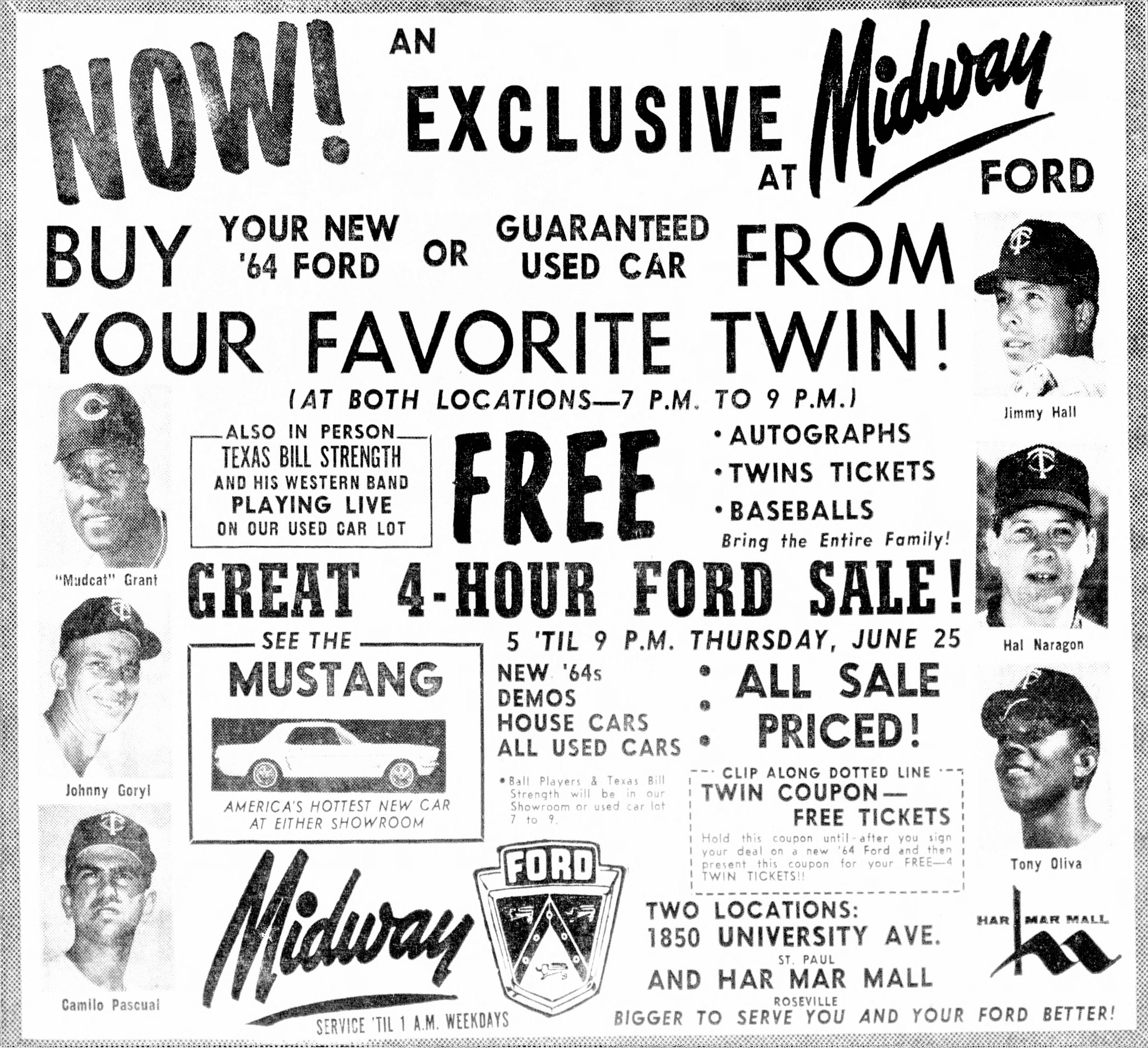
Minneapolis Star, June 25, 1964
July 1964
The Marty Robbins Show came to town on July 11, 1964, sponsored by KTCR. Other performers were:
- Red Foley
- Bobby Lord
- Melba Montgomery
- The Canadian Sweethearts
- Skeets MacDonald
- Grandpa Jones
- Sheb Wooley
- Johnny Bond
- Mac Wiseman
- Johnny & Jonie Mosby
- Joe Maphis & Rose Lee
- TBS
- Pete Nolan of “Rawhide”
The description of the show in the July 11, 1964, edition of Billboard calls it “KTCR’s First Annual Country & Western Music Spectacular,” and only lists Marty Robbins at the top of the list of stars, not the namesake of the show.
Plans were for it to start with an hour-long parade through downtown Minneapolis starting at 2 pm.
Next was a chuck wagon dinner from 6 to 8 pm, and then the three-hour show.
Climaxing the event was the First Annual Minnesota Square Dance Festival, featuring nearly 2,00 square dancers from nearly every county in Minnesota, according to KTCR. That was expected to run from 11 pm to 2 am.
KTCR’s signal reached 70 counties in Minnesota, Wisconsin, and South Dakota; the show was expected to bring in more than 20,000 spectators.
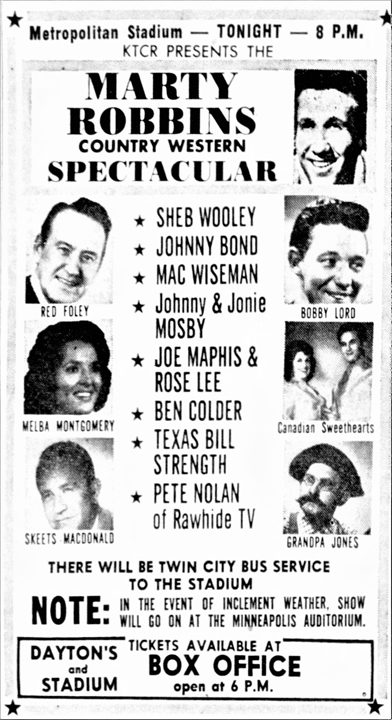
Minneapolis Tribune, July 11, 1964
August 1964
The photo below was taken in about August 1964, ad features Fern Dale and Barbara Lee Mac posing with fans at the Flame. TBS’s name can be seen on a poster behind them.
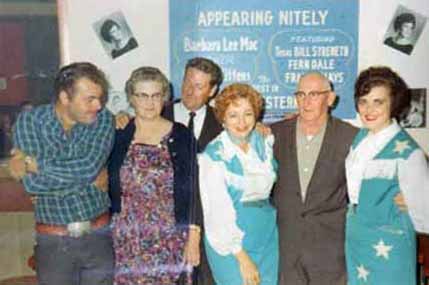
Image courtesy Brett Williams
November 1964
BANGAR RECORDS
In Novemer 1964, TBS recorded two sides for Bangar, a local Minneapolis label. The disks were pressed at Kay Bank Studio.
- “Bells of Memory,” written by TBS and Rusty Kegler
- “Paper Boy Boogie,” written by TBS and T. Trent
Bangar BA00649 was released in 1964.
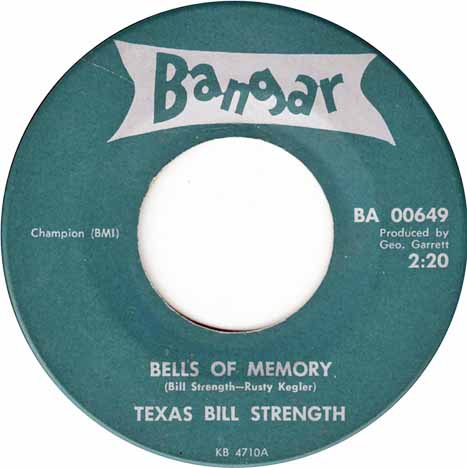
Billboard reported that TBS was giving away a German shepherd puppy in his Name the Puppy Contest. (November 28, 1964)
1965
TWIN TOWN RECORDS
In 1965, TBS moved to another local Minneapolis label, Twin Town. He cut four sides; no recording or release dates are available. The songs were produced by George Garret, who owned the Nic-O-Lake Recording Studio, in the basement of his record store. Garrett either owned Twin Town or had a big hand in it.
- “As Much as Yours as Mine,” written by TBS
- “The Promise”
- “Call of the Wild”
- “Lake Lonely,” written by TBS and Justin Tubb
“As Much Yours as Mine” b/w “The Promise” was issued as TT 704
“Call of the Wild” b/w “Lake Lonely” was issued as TT 712.
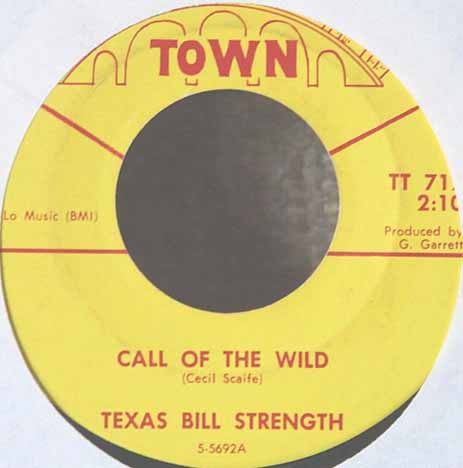
STUDIO CITY RECORDS
Studio City was another George Garrett label. In 1965, TBS recorded a song called “Million Memories,” which was given the number SC1036.
January 1965
An article about how disc jockeys move around a lot, dated January 14, 1965, said that “Bill Strength departed KTCR and returned to KTCR.”
On Saturday, January 23, 1965, TBS participated in a show in West Palm Beach, Florida that apparently took place in a tent theater set up on a polo ground. Other acts included:
- Hank Snow
- Rainbow Valley Boys
- Barbara Lee Mack
- Curly Smith and the Blue Mountain Boys

Palm Beach Post, January 17, 1965
February 1965
On February 11, 1965, TBS appeared at the premiere of “Your Cheatin’ Heart,” the story of Hank Williams.
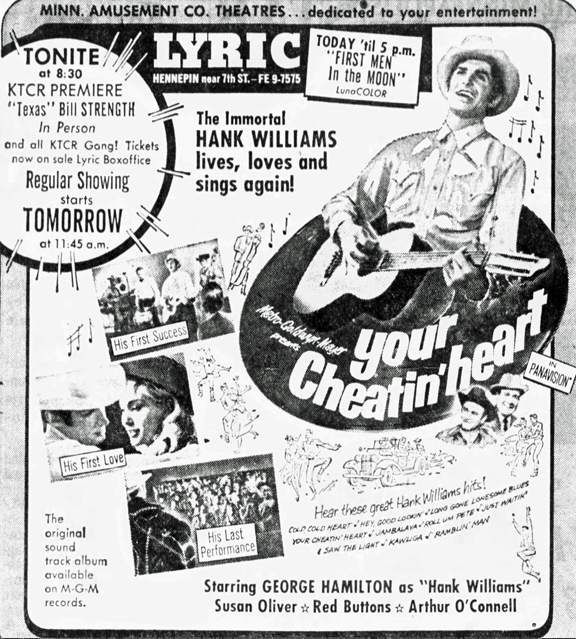
Minneapolis Star, February 11, 1965
THE EXCUSE CLUB
Starting in 1965, on and off until at least 1967, TBS performed on and off at the Excuse Club at Cedar/Riverside.
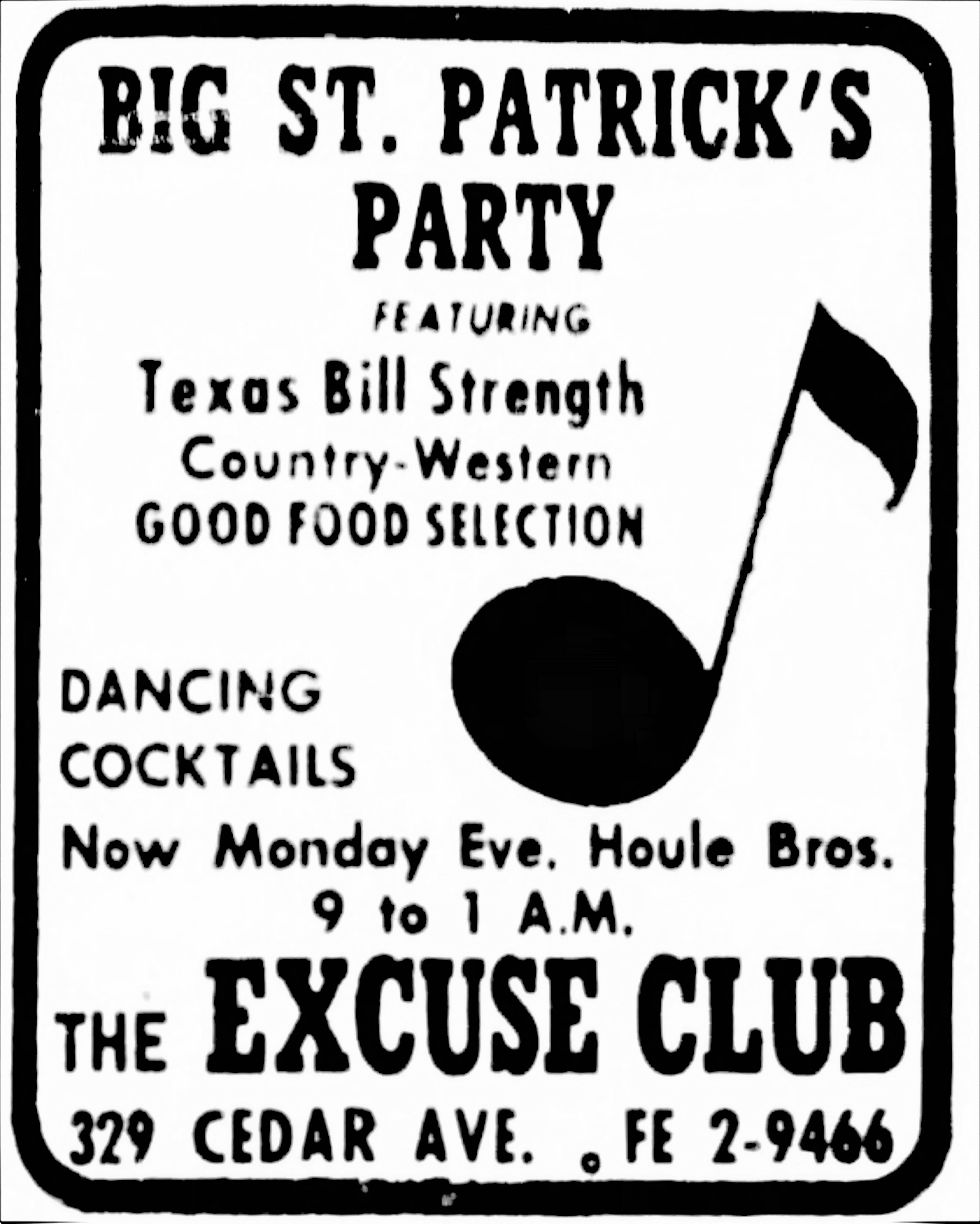
Minneapolis Tribune, March 17, 1965
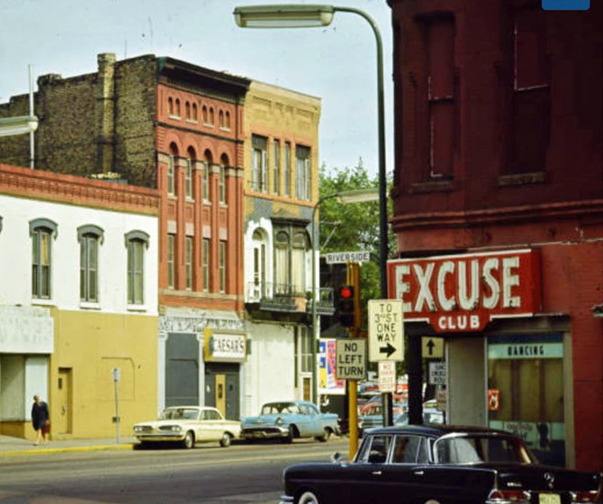
1967 Photo courtesy Hennepin County Library
April 1965
In April 1965 (probably), TBS, Dale, and Bobby participated in a benefit for Lenny Paro at the Medina Ballroom. The show featured performers from the Flame Café, including Sherwin Linton and the Fender Benders. Another performer was Johnny Western; April is the guess because he was performing at the Flame for a week that month. Dale and Bobby appeared playing in a band, and there is a few seconds of footage, but it is silent.
From April 19 to 24, 1965, TBS was back at the Flame as the headliner:
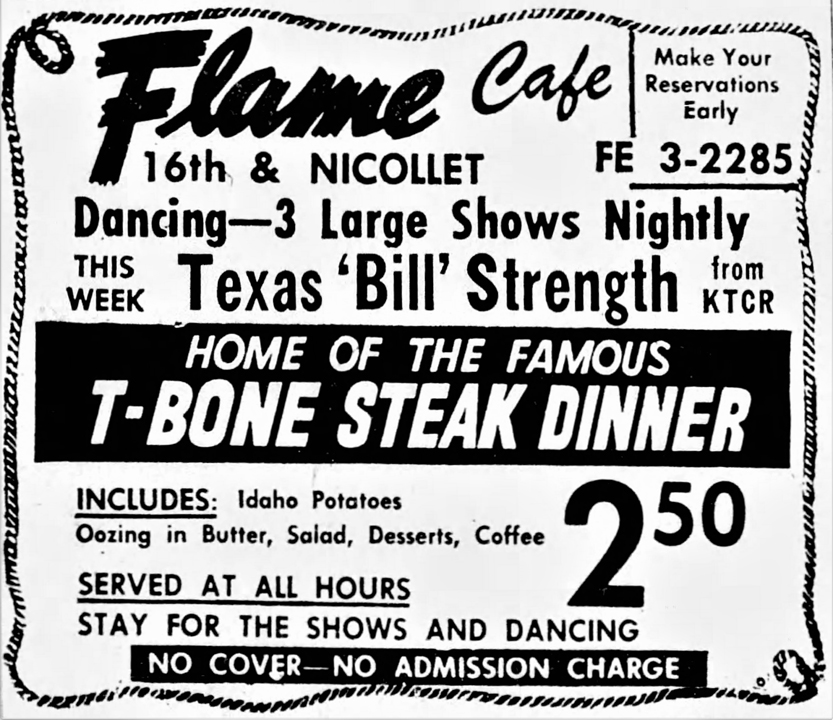
Minneapolis Star, April 19, 1965
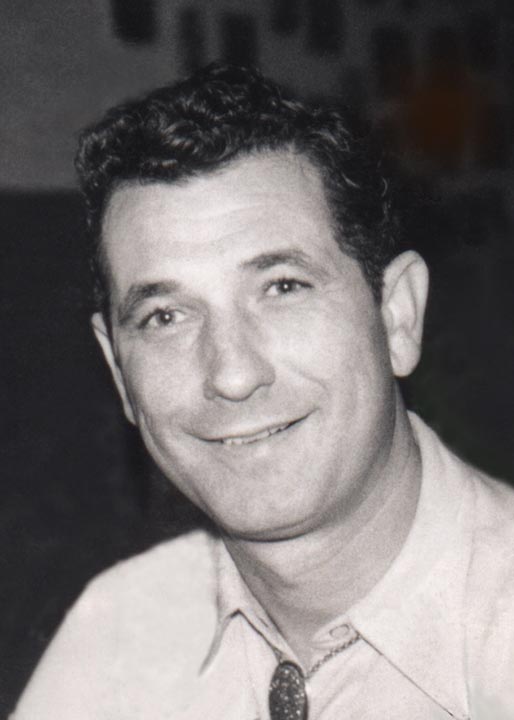
Photo taken at the Flame, courtesy Dale Strength
May 1965
On May 22, 1965, the 9th Grand Ole Opry Show came to town, and TBS was on the bill, along with:
- Johnny Cash and the Tennessee Three
- Tex Ritter
- The Willis Brothers
- June Carter
- Bob Luman
- The Statler Brothers

Minneapolis Tribune, May 16, 1965
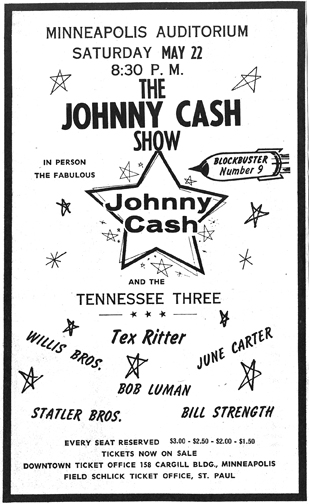
Image courtesy Dale Strength
July 1965
WMIN? KTCR?
On July 3, 1965, Billboard reported that TBS was named music director of KTCR. He was in charge of reviewing new records and making up the KTCR Top 50 Chart. Billboard rated the station as “being tops in influencing the sale of country records and Strength as top DJ in the market in influencing the sale of country records.”
On July 5, 1965, a blurb in the Tribune announced TBS’s move to WMIN radio to host a noon to 3 pm record show.
On July 10, 1965, a Billboard Radio Response Rating for Minneapolis/St. Paul still identified TBS as working for KTCR. It said he had 78 percent of the Country audience, with Art Blaske and Vern Arthur at KTCR and Johnny West from WMIN sharing the other 22 percent of the country DJ ratings.
On July 28, 1965, a gossip column in the Houston Chronicle called “The Big Beat by Maxine” had this to say: “Biff Collie, the former Houston deejay, has not entered the public relations field on the West Coast. Biff has been in radio out there for some time. He also reports that another ex-Houston radio voice, Texas Bill Strength, has been upped to program director at KTCR in Minneapolis.”
On August 2, 1965, another blurb in the Tribune repeated TBS’s move to WMIN.
On August 5, 1965, the ad below made the move to WMIN official. The black eyes refer to a cigarette ad campaign, “I’d rather fight than switch,” no doubt.
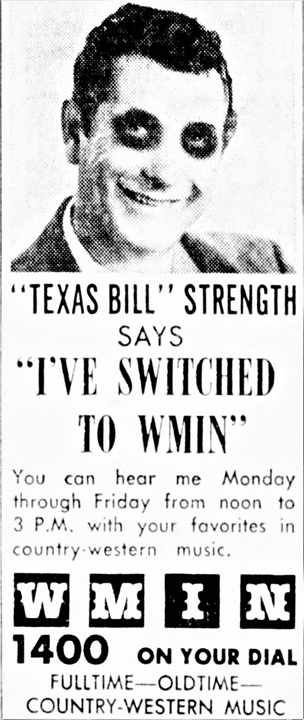
Minneapolis Star, August 5, 1965
On August 14, 1965, Billboard reported that TBS has joined countrified WMIN, St. Paul. He was with KTCR there. In Biff Collie’s “West Coast Ramblings” column in the same edition of Billboard, Biff says “TBS has been upped to program director at KTCR Radio, Minneapolis. Bill and I worked together in Houston in the late 1940’s. What a character!” (Billboard was a weekly, so it must have been difficult for them to keep up.)
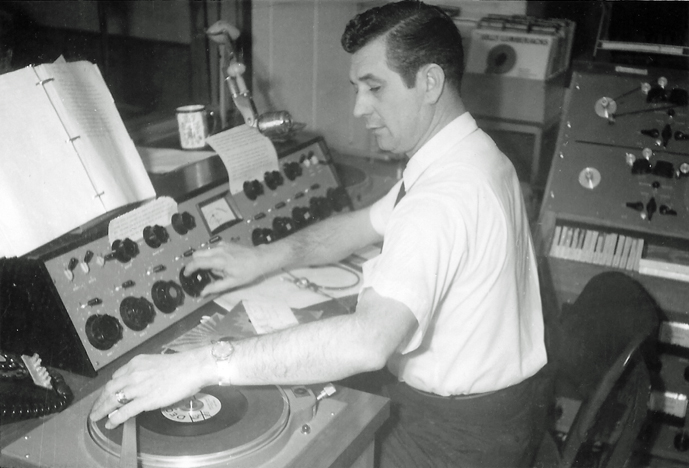
TBS at the WMIN Console. Photo courtesy Dale Strength
FRONTIER CLUB GATHERING
In about 1965, there was a gathering of Twin City and Nashville entertainers with the George Kent Band at the Frontier Club.
Shown kneeling: Texas Bill Strength and Mercury Recording artist George Kent. Standing: Sherwin Linton; Tony Farr; Chill Hilmin; Gary Verne, George Kent’s Drummer; George Guinn, who was from Oklahoma and popular in the Midwest; and Wayne Wilson, who later became Buck Owens bass player. All those with matching shirts were George Kent’s band.
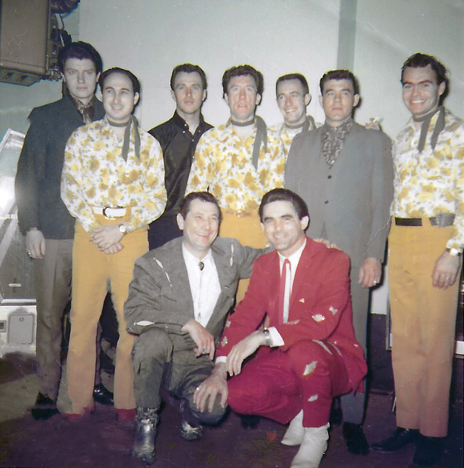
Photo courtesy Sherwin Linton
August 1965
The ad below for an appearance at Midway Ford on August 2, 1965, mentions both stations, none directly associated with TBS:
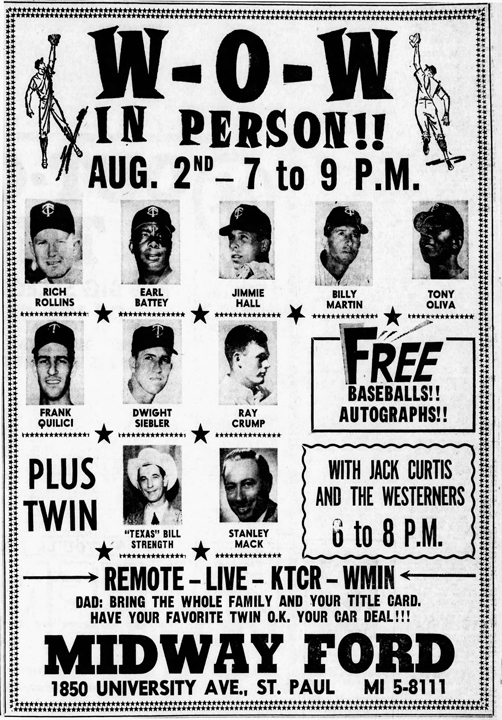
Minneapolis Star, August 2, 1965
TBS was back at the Excuse Club on August 6 and 7, 1965.
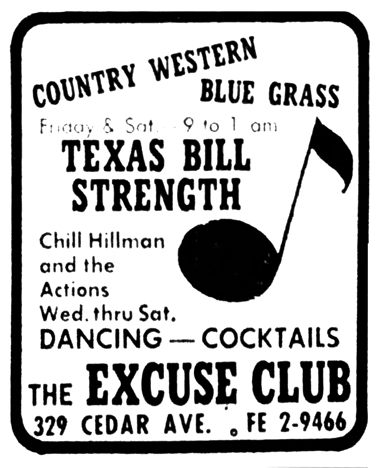
Minneapolis Star, Thursday, August 5, 1965
September 1965
A TIME OF TROUBLES
On September 1, 1965, TBS’s mother, Jessie Leon Strength, died at her home in Conroe, Texas.
The ad below indicates that TBS was scheduled to play the Excuse Club on September 3 and 4, 1965.
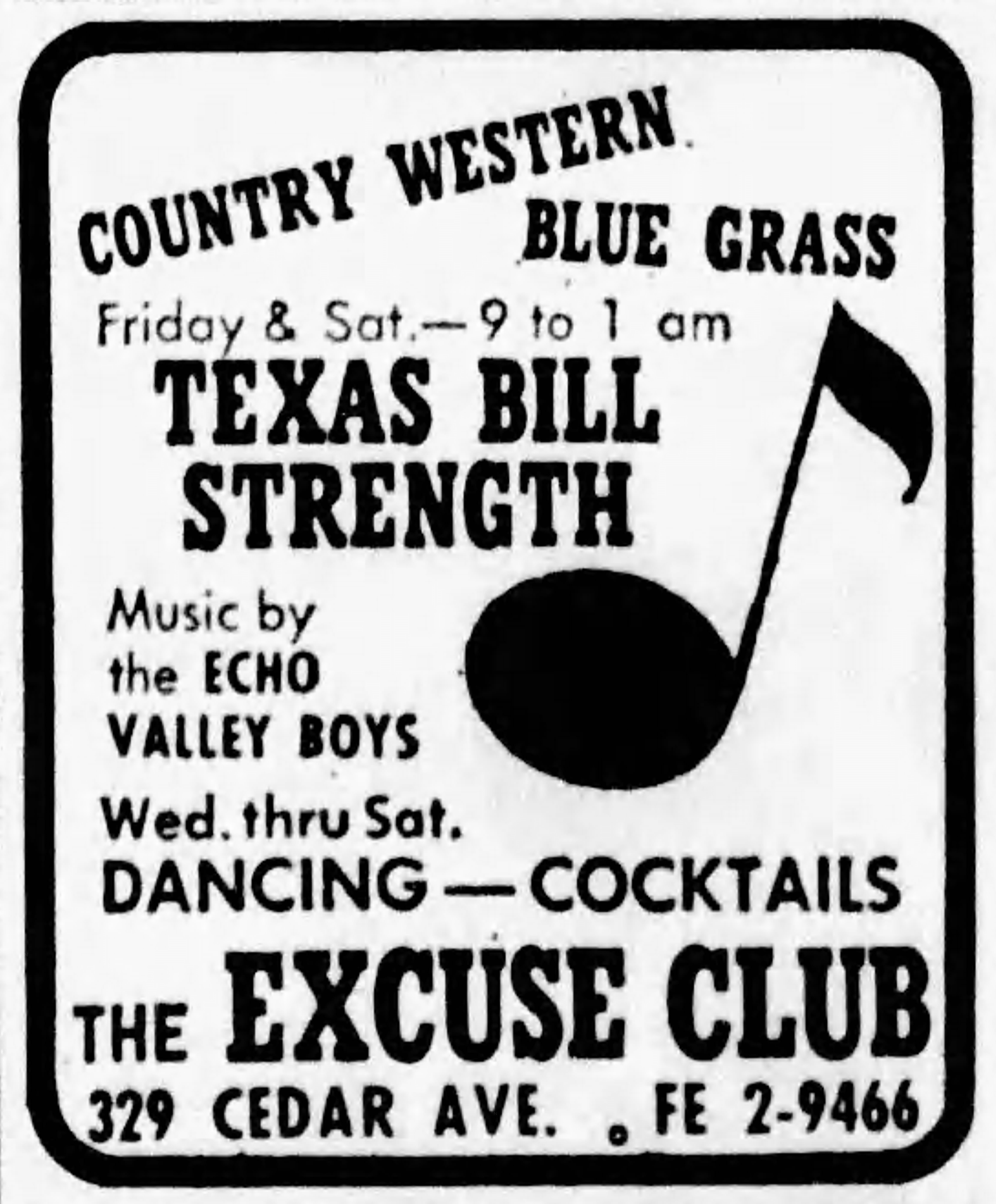
Minneapolis Tribune, Friday, September 3, 1965
TBS was scheduled to make a personal appearance at Major Ford on Saturday, September 25, 1965.
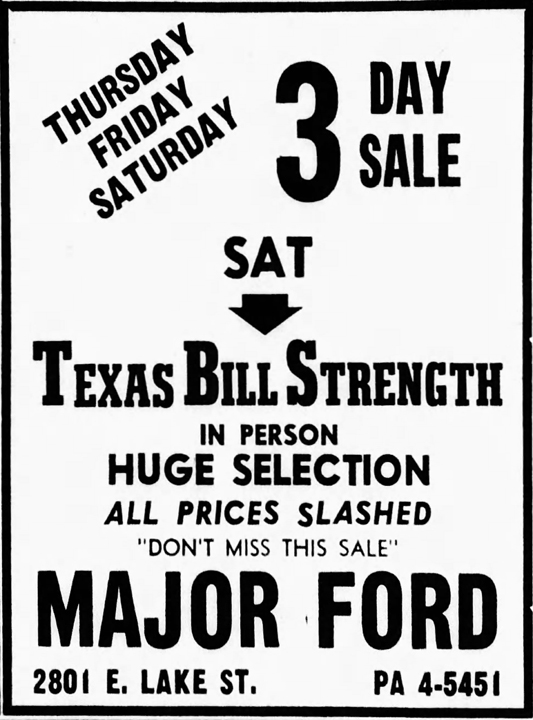
Minneapolis Tribune, Thursday, September 23, 1965.
The ad below, for the same appearance, indicates that Bill was bringing along his band and would perform.
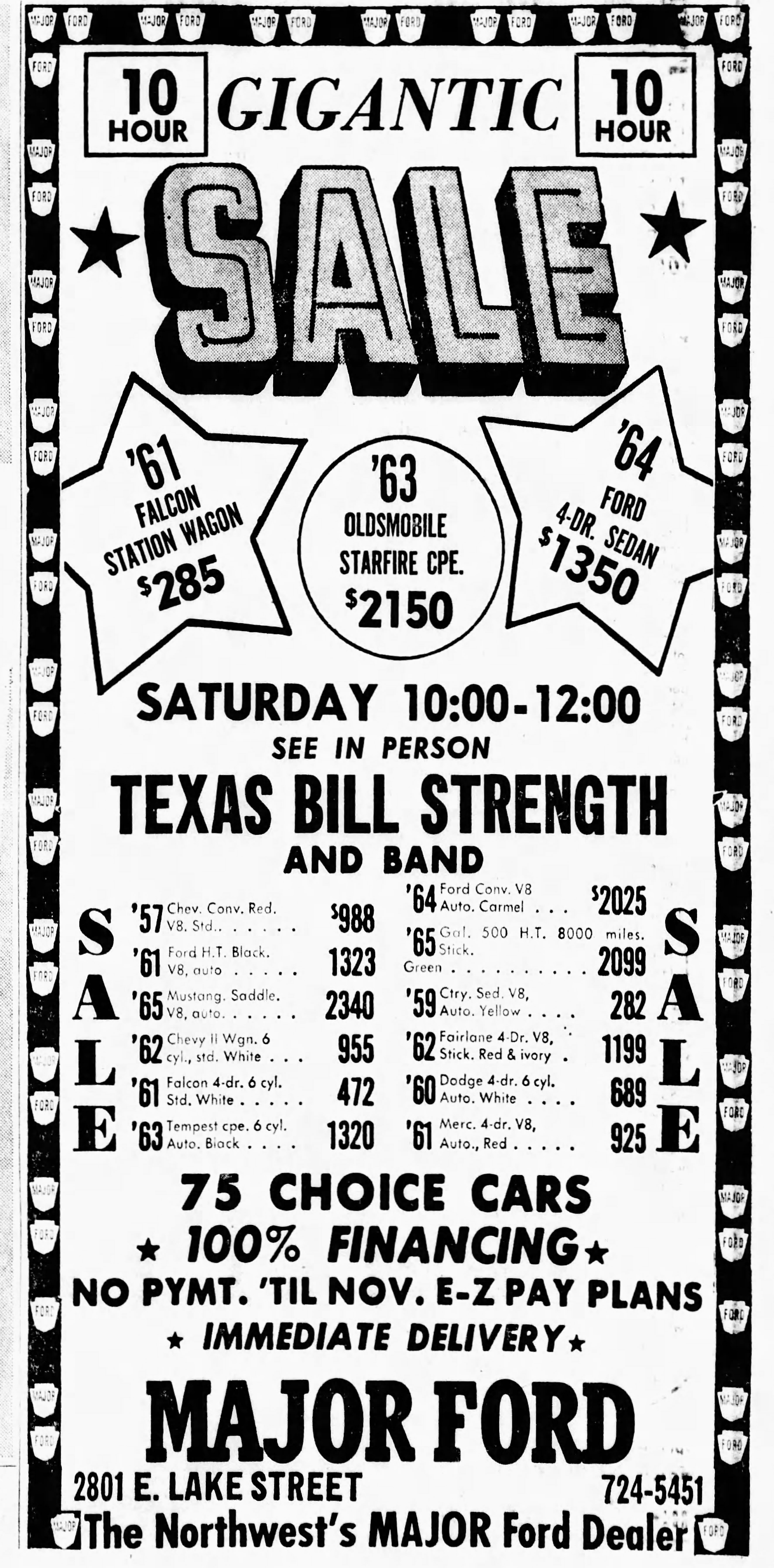
Minneapolis Tribune, Friday, September 24, 1965
October 1965
TBS was back at the Excuse Club on October 8 and 9, 1965. One of his fellow performers were the Polecats, led by Larry LaPole. Larry wrote many of the surf songs recorded by the Trashmen!
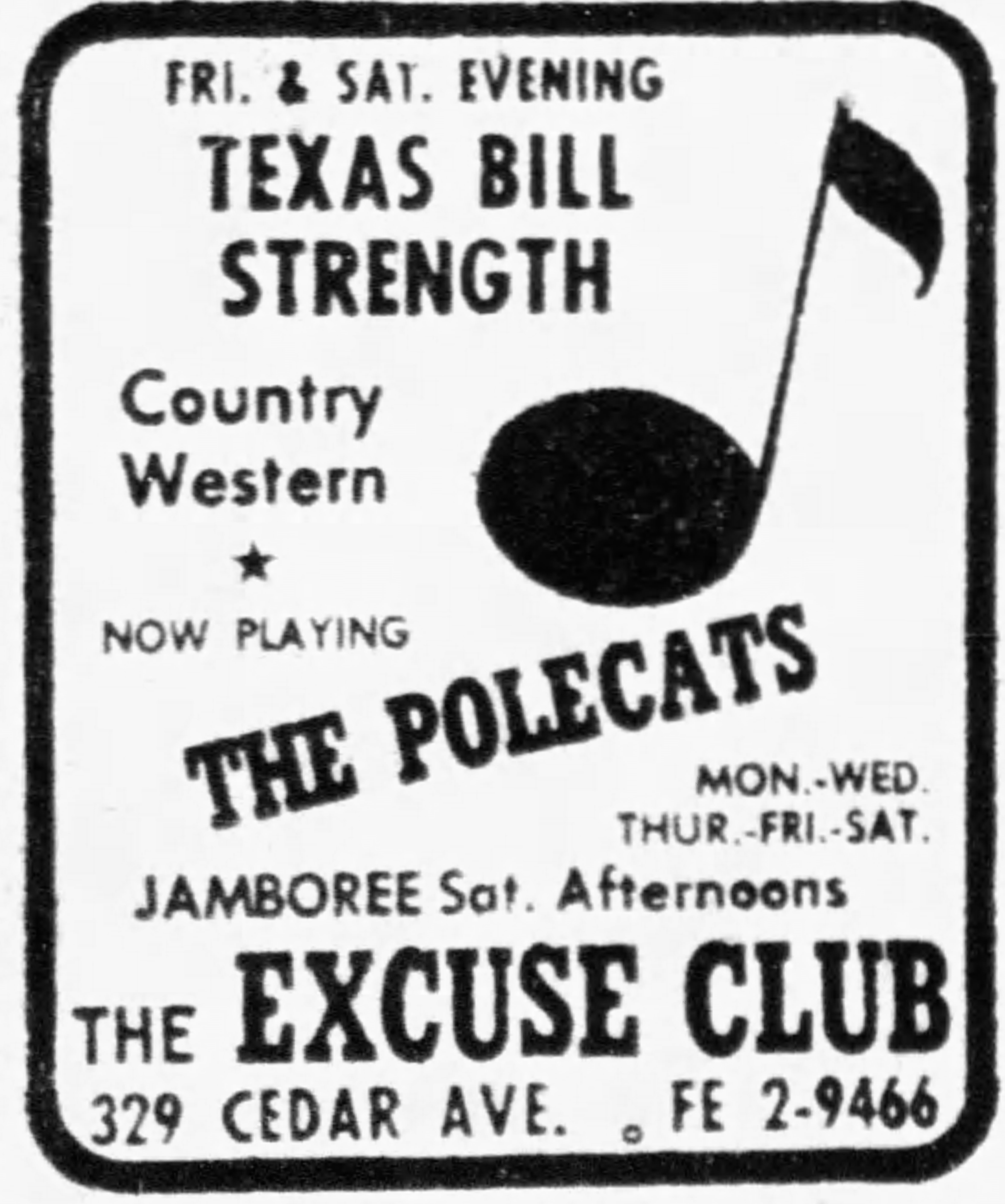
Minneapolis Star, Thursday, October 7, 1965
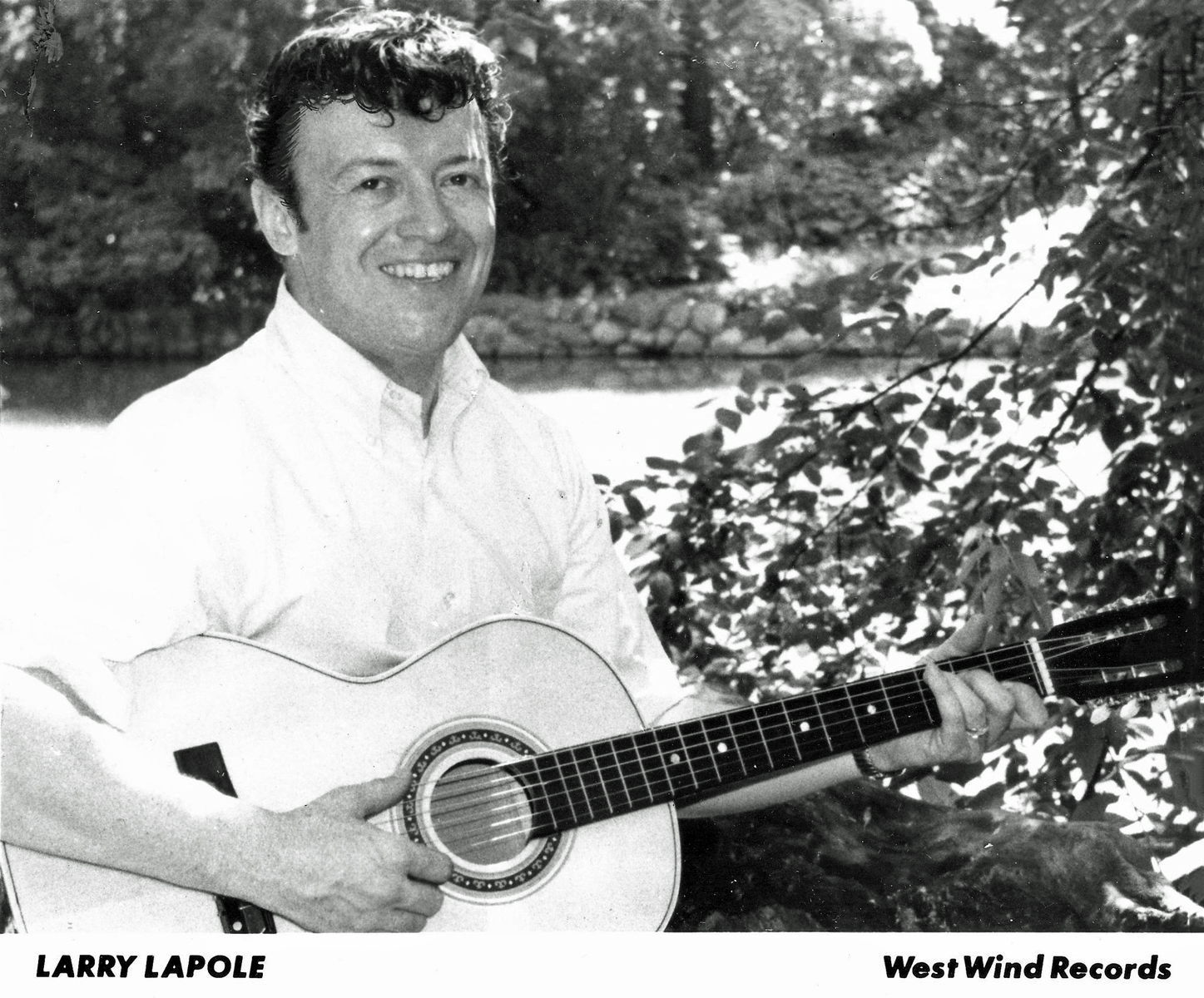
Photo courtesy Mike Jann
November 1965
On Saturday, November 6, 1965, the lifeless body of Jackie Young, TBS’s second wife, was found in the back of her car in a pasture in rural Texas. She had been strangled and bludgeoned with a tire iron. She was 25 years old. Despite the fact that they had divorced, TBS was devastated. See above under 1959 for the details.
December 1965
It was back to the Excuse Club on December 3 and 4, 1965.
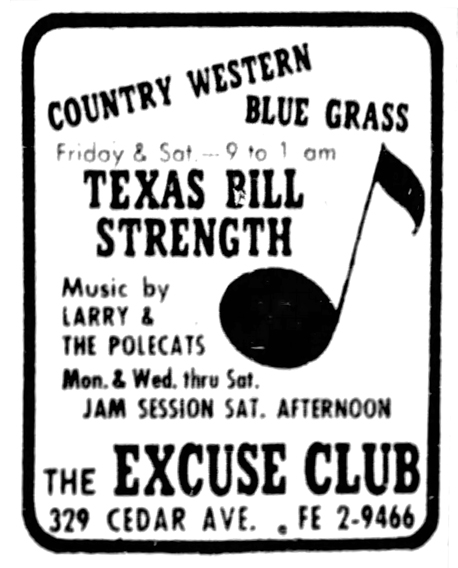
Minneapolis Tribune, December 3, 1965
1966
January 1966
On January 28, 1966, TBS was booked at the Parkway Ballroom in Foley, Minnesota. The ad said, probably mistakenly, Rock ‘n’ Roll Dance. Bill’s band was called the Countrymen.
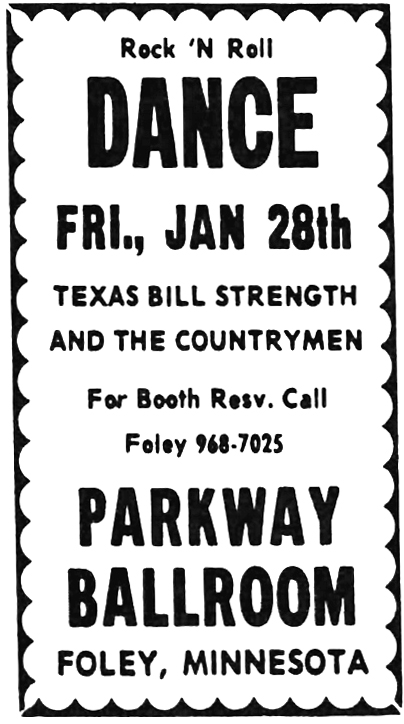
St. Cloud Times, Thursday, January 27, 1966
February 1966
On February 4, 1966, TBS was again at the Parkway Ballroom in Foley, this time billed as a “Big Western Show” with Roger Mews and the Countrymen.
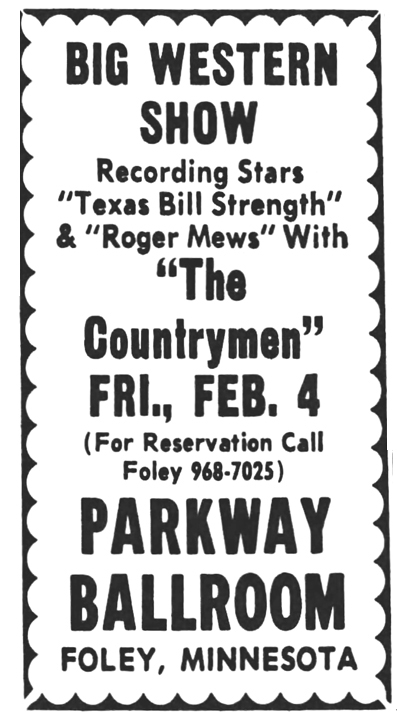
St. Cloud Times, Wednesday, February 2, 1966
On February 7, 1966, TBS’s father died at the VA Hospital in Houston.
Also on February 7, 1966, TBS was stricken ill and was a patient in two hospitals. Doctors at the Mayo Clinic detected a spot of cancer on his left lung and a case of cirrhosis of the liver. Strength, who has in recent years been featured on several local radio stations with his own country platter show, will be forced out of action for some six weeks. (Billboard, March 26, 1966)
Given the information above, it is unlikely that Bill was able to fulfill the obligation below to play a dance at the Parkway on February 11, 1966.
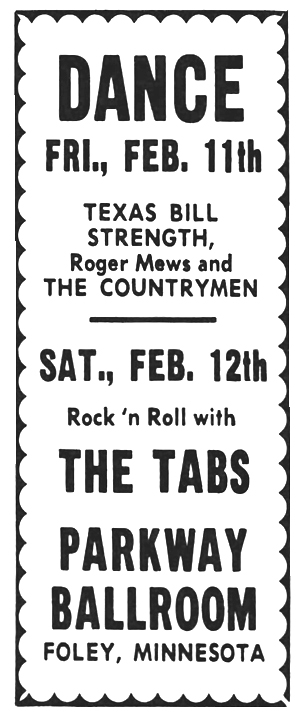
St. Cloud Times, February 11, 1966
March 1966
March 17, 1966:
TBS, veteran country music entertainer and deejay who was forced to relinquish his deejay post on February 7 due to illness, informed Billboard that he is well on the way to recovery and hopes to be back in harness soon. Writing under date of March 17, Strength says, “I was in Mayo Clinic for 14 days. They thought I had a touch of lung cancer but got it cleared up in time by giving me pulmonary dilating treatments and oxygen four times daily. They also discovered I have a 40 per cent portion of my liver chewed up, but I’m recovering real well.” Friends may write to Texas Bill at 2600 East Medicine Lake Boulevard, Minneapolis, 55427.
This address appears to be in Plymouth, although the house at that address wasn’t built yet. Perhaps it was the one next door, which was built in 1920. (Billboard, April 2, 1966)
A benefit show for TBS’s medical expenses was held at the Medina Ballroom on March 27, 1966. More than 17 area bands, as well as local deejays and radio and TV personalities, have donated their services for the benefit show. Merle Travis has been busy lining up other acts. Mail will reach Strength in care of Mr. and Mrs. Ralph Rundquist, 1490 64th Avenue NE, Minneapolis. The closest this address computes today may be where Highways 100 and 694 meet in Brooklyn Center. (Billboard, March 26, 1966)
April 1966
TBS had an extended engagement at the Golden Spike Club in or near Sauk Rapids, Minnesota, from at least April 7 through April 10, 1966.
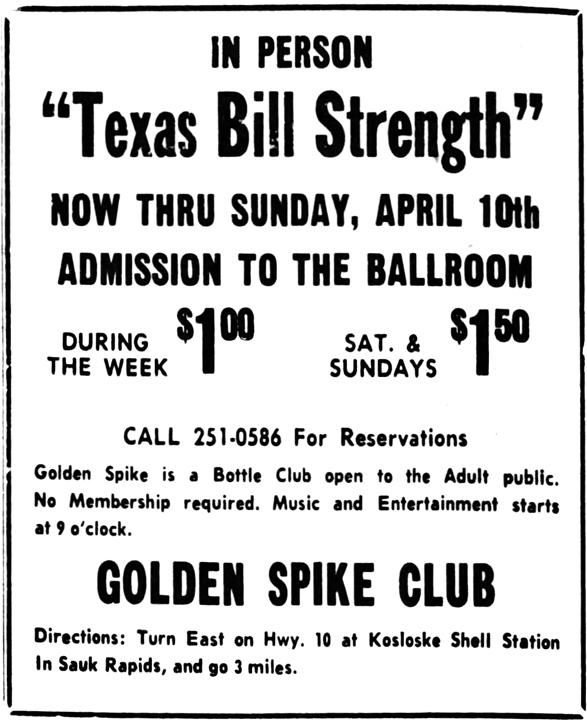
St. Cloud Times, Thursday, April 7, 1966
June 1966
NASHVILLE
TBS, forced to relinquish his deejay chores recently on a Minneapolis station due to illness, which laid him low for several months, has recovered and will henceforth work as a country music single. Strength says he has given up the deejay business, at least temporarily. He arrived in Nashville recently [June 1966] to scout for a potential hit song and a recording session. (Billboard, July 9, 1966)
NASHVILLE/STARDAY RECORDS
In June 1966, TBS cut two sides for Nashville Records, a subsidary of Starday.
- “The Moment I Found You”
- “Best Thing in Life is Love”
NV5291 was released in 1966.
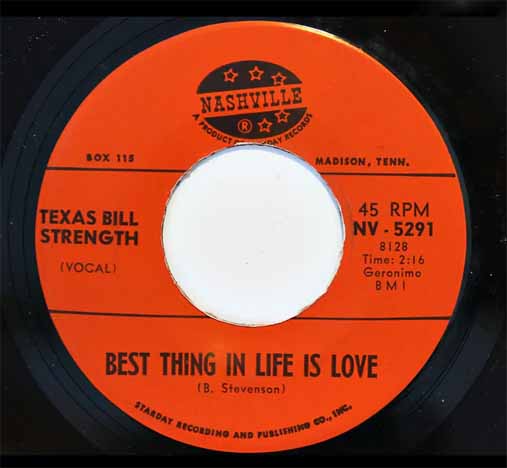
It was also probably at this session that two other sides were recorded; they were on TBS’s Greatest Hits album, released in 1967, so it’s a guess that they were recorded in 1966:
- “I’m Gonna Catch You Baby”
- “Betty Lou”
On June 24, 1966, TBS appeared on Bobby Lord’s TV show in Nashville. (Billboard, July 9, 1966)
On June 25, 1966, TBS appeared on Ernie Tubb’s Midnight Jamboree TV show. (Billboard, July 9, 1966)
On June 28, 1966, TBS appeared on Ralph Emery’s early-morning TV show. (Billboard, July 9, 1966)
July 1966
Strength left Nashville late this week for Fort Lauderdale for a five-week club date. (Billboard, July 9, 1966)
From August 14 to 16, 1966, TBS filmed the Bill Anderson TV show in Charlotte, NC. After that he will return to Nashville. (Billboard, July 9, 1966)
October 1966
TBS was included on a list of Top Country Artists. He was on Starday Records, represented by the Wil-Helm Agency. (Billboard, October 29, 1966)
On December 17, 1966, the rock band City Strangers, led by TBS’s son Dale, was loading its equipment in the alley after a gig at Mr. Lucky’s, when James W. Rieck, 25, pulled up and demanded to get through. When Dale explained that they had a lot of equipment to load, Rieck pulled a gun on him. TBS saw this and confronted Rieck, who backed off and skeedaddled. Rieck was arrested and held for investigation, but TBS declined to press charges. Rieck later thanked TBS in a letter, telling him that he was on probation and he could have been sent back to prison. Dale’s name was kept out of the newspaper accounts.
1967
January 1967
Here’s an interesting tidbit you only find by accident. It comes from an article in the Nashville Tennessean, dated January 22, 1967, called “Music Star Adds Pencil to Guitar.” It’s written by, of all people, Merle Travis. He’s talking about his various roles as a guitar player, singer, songwriter, actor, and columnist. Here’s the part that’s relevant to TBS:
Now, let me brag on my writing ability. I once wrote a piece for the Texas Bill Strength fan club on how to tune the fiddle to play “Black Mountain Rag,” which was rejected, but I keep tryin.’
A 1967 Talent Directory published in Billboard listed TBS as being on Starday Records and represented by the Wil-Helm Agency.
March 1967
TBS, C&W entertainer and deejay who was forced to vacate the local radio scene more than a year ago due to ill health, has rejoined WMIN, Minnesota’s only 24-hour country music station. (Billboard, March 18, 1967)
May 1967
Now here’s something interesting. All of the ads for the Excuse Club for May 25 – 27, 1967, look like the one below:

Minneapolis Star, Thursday, May 25, 1967
This would imply that Bill was going to be there on Saturday night, which was May 27, would it not? But what about this? Maybe it meant TBS was scheduled for Friday night? But the date stamp is automatic. Very curious.

St. Cloud Times, May 27, 1967
GREEN GREEN BACKS BACK HOME
And here’s a new discovery for 1967. It seems the Trashmen (of “Surfin’ Bird” fame) recorded a novelty song called “The Green Green Backs Back Home,” credited to the Trashmen and the Desert Rat Singers. The record tells us that our friend Mike Jann produced this gem, and the writing credits went to Curly Putnam (who wrote the original song “The Green Green Grass of Home) with special words by Larry LaPole.
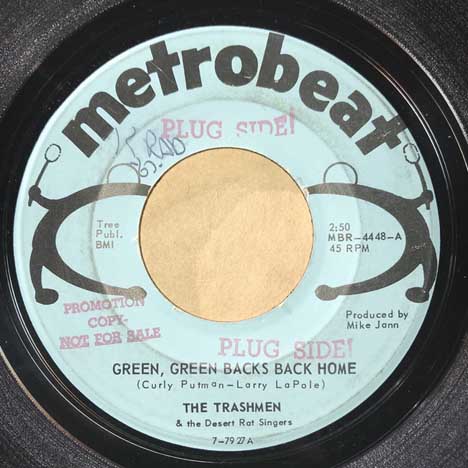
There are many, many connections going on here:
- The record starts with Trashmen lead guitar player Tony Andreason doing his best Walter Brennan.
- Tony and Mike Jann were friends from their teen years, and Mike is the keeper of the flame of the T-Men to this day.
- The second voice on the record, doing a great Gabby Hayes, is none other than Texas Bill!
- Mike was a big fan of Texas Bill – see photos he provided to this page in 1956. He may have been the one to suggest Bill for the part.
- Larry LaPole was the author of perhaps the greatest surf song of all time – “King of the Surf” – the flip side of “Surfin’ Bird.” Larry wrote it using surf terms that Will Jones published in one of his columns in the Minneapolis Tribune.
- Larry was normally a Country singer, with his band the Polecats, and a friend of TBS. They both played at the Excuse Club, and Larry, a wonderful artist, drew some fanciful pictures of Bill that Bill’s son Dale still has.
- Mike and Larry both worked at the Minneapolis Star and Tribune.
Mike recalls that the flip side of this record – “Address Enclosed” – also by Larry LaPole, had been recorded earlier, and was sort of an orphan song, looking for a home. Tony used a psuedonym, “Tony Jones,” a nod to George Jones, so as not to alienate his rock ‘n’ roll fans with a Country song, says Mike.
October 1967
TBS had a brief fling at a Fort Lauderdale radio station following the country music convention in October 1967. (Billboard, April 27, 1968)
1968
March 1968
Will Jones phone interviewed TBS, back on WMIN. He has recorded a new “Texas Bill Strength’s Greatest Hits” album in Nashville. (The album was released in 1967.) (Minneapolis Tribune, March 8, 1968)
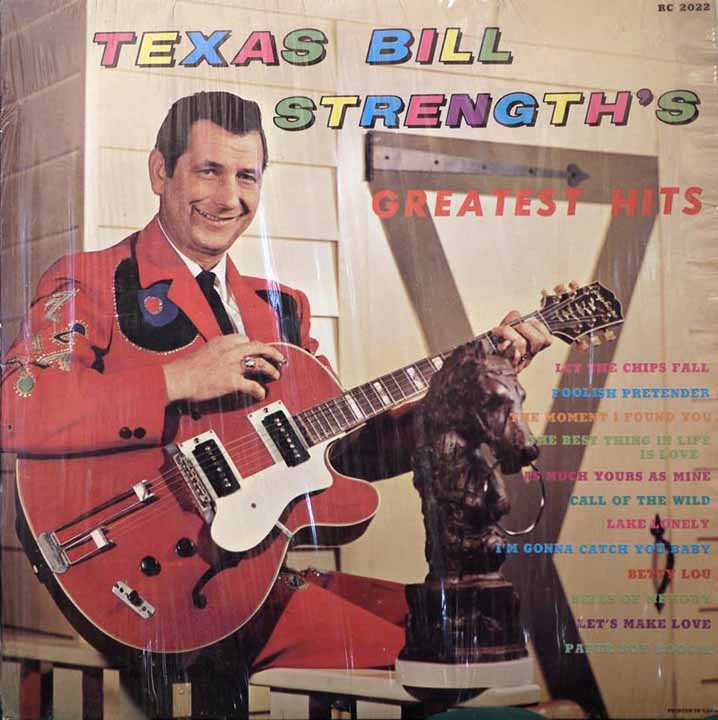
Songs on the album and the years they were recorded are:
- Let the Chips Fall – 1962
- Foolish Pretender – 1962
- The Moment I Found You – 1966
- The Best Thing in Life is Love – 1966
- As Much Yours as Mine – 1965
- Call of the Wild – 1960
- Lake Lonely – 1965
- I’m Gonna Catch You – 1966
- Betty Lou – 1966
- Let’s Make Love – 1963
- Bells of Memory – 1964
- Paper Boy Boogie – 1964
April 1968
TBS has again settled in Atlanta, where he’s doing a daily platter show over WTJH Radio. He’ll spend his free time playing club and show dates in Georgia, Alabama, Tennessee and the Carolinas. Strength also plans to record for his old friend, Bill Lowery. Texas Bill reports that he’ll be married to a Minnesota girl in June. (Billboard, April 27, 1968)
1969
March 1969
On March 2, 1969, radio station WTJH, East Point, Georgia, will sponsor a country music show at the city auditorium honoring the “old timers” of the industry, reported Billboard the day before. Governor Lester Maddox proclaimed Sunday as “Old Timers Day in Georgia.” The line-up of talent included:
- David Rodgers, Columbia Records
- Penny Linsey, Galaxy Records
- Clayton Read, Master Records
- George Read & His Blue Ridge Mountain Boys
- Jack Holden & Frances Kay
- WTJH Ranch Hands
- The Wranglers
- Don Echols
- Hoyt Bruitt
- Freddie Cole
- Jimmy Myers
- Billy Willson
- Bud, Dannie and Mote
- Skillit Likkers and Band
- Spero Patterson
- Riley Puckett
- Slim Spewman
- Debbie and Ronnie Ruggles
- Billy Goldman
- Sylvia Eason
- Billy Dillsworth
Emcees were WTJH announcers:
- Buzz Walker
- Country Jim
- TBS
- Ned Lukens
Discouraged with the state of Country music, TBS tried to quit performing and sell insurance. Quoting a local interview from 1970, Ronnie Pugh wrote:
The year before, 1969, Strength even tried to give up performing to sell insurance. Though his natural gregariousness and quick humor, which had made him so good on radio, might have served him well in the insurance business, he simply couldn’t do it. “It’s like they say. It gets in your blood. Every time I passed a night club, I wanted to go in and start singing.”
Dale sent along this humorous letter from Merle Travis to TBS, commenting on the placid “Hillbillie Convention” of 1969 and how good it was to see each other.
Dale says:
This is a great example of how creative some of the country entertainers would be in communicating with each other. Comedic letters, sketches, photos, taped messages, and gifts were exchanged – I have a nice engraved cigarette lighter that Merle gave TBS. I think without exception all of the artists my Dad worked with were just great people. Bigger than life. And they gave each other a lot of respect, support and love. And I got to experience it all first hand. How cool is that?
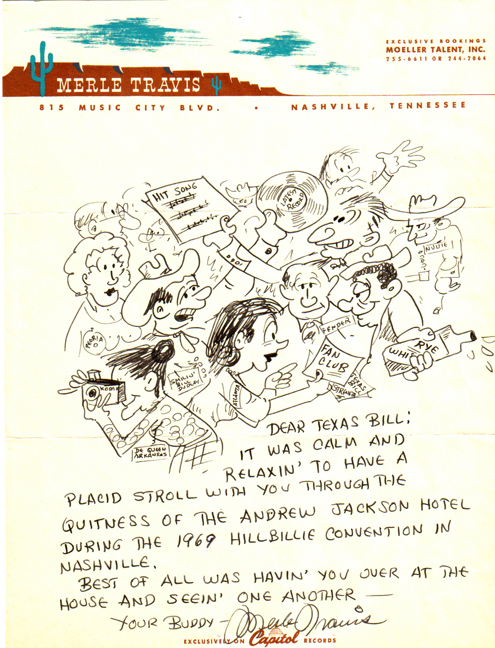
Image courtesy Dale Strength
1970
April 1970
Will Jones wrote that “Texas Bill” is Back in Town:
The often-shot-at TBS is back among us, after having spent the past three years in Atlanta and Birmingham, and touring with Grand Ole Opry units in the South.
He no longer has the metallic-purple, gold-wheeled ’29 Model A Ford that he used to sport around here. During a visit to Nashville he sold it to Johnny Cash, who intends to use it on a TV show.
Strength opened over the weekend at the Casino Royale, a storefront in the Shorewood shopping center that operated for a couple of years as a teen club and is now going the country-western route. Strength is there Fridays, Saturdays, and Sundays, zinging in his own creations such as “Hillbilly Hell,” a takeoff on “Hillbilly Heaven,” among the country-western standards.
He’s also returning to the disc-jockey scene here, and will launch a show on KTCR in a couple of weeks.
Minneapolis Tribune, April 13, 1970
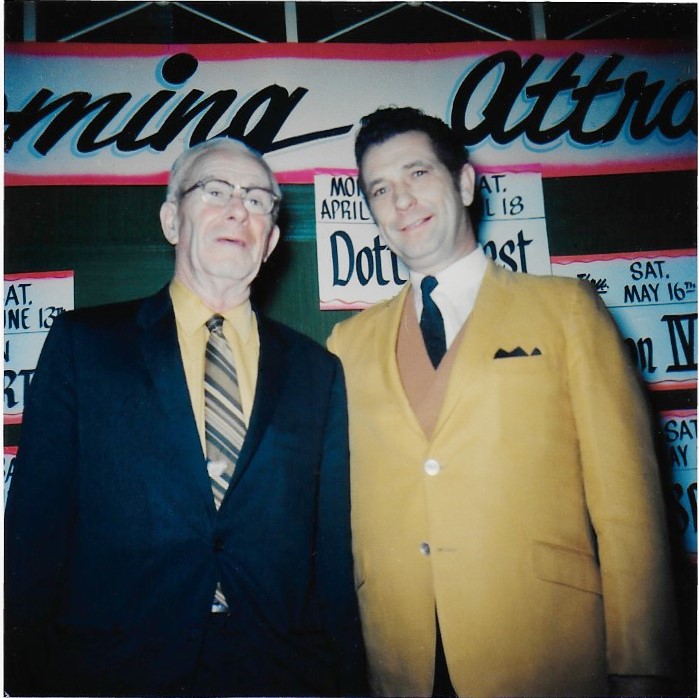
David Stone and TBS; from the dates, probably March or April of 1970. Photo courtesy Dale Strength
Will Jones: “Revised Report on Texas Bill”
TBS, who used to be a disk jockey at KTCR, came back to town and told me he was going back to work there, and I printed it. Now here’s a letter from Robert J. Rock, general manager of KTCR and KTCR-FM: “I do the hiring and firing of personnel at these stations. For your correct information, Strength has not been offered any position at these stations. And furthermore, he will NOT be offered a position here, now or in the future.”
I sense a problem there.
Minneapolis Tribune, April 23, 1970
June 1970
From June through October 1970, TBS had a string of appearances at the Flame:
- June 15 – 20 with the Tiny Harris Country Band
- June 22 – 27 with the Tiny Harris Country Band and Justin Tubb
- June 29 – July 4 with the Tiny Harris Country Band
July 1970
From July 6 to 11, 1970, TBS appeared with Jean Shepard and Warren Robb at the Flame.
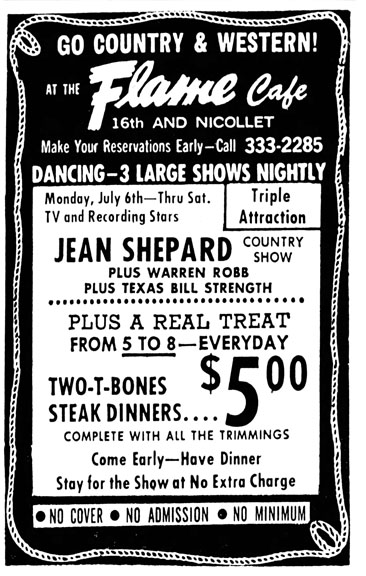
Minneapolis Tribune, July 5, 1970
From July 20 to 25, 1970, TBS appeared with Carl and Pearl Butler and Warren Robb at the Flame.
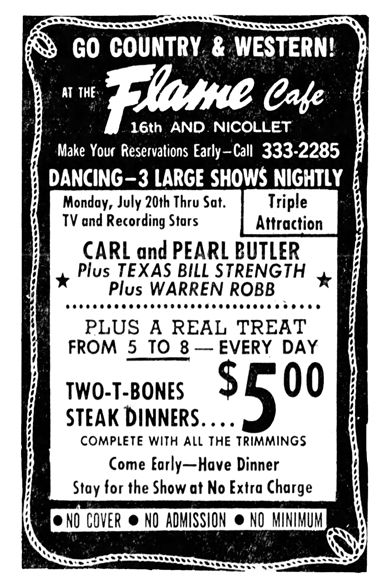
Minneapolis Tribune, Sunday, July 19, 1970
From July 27 to August 1, 1970, TBS appeared with Warren Robb at the Flame.
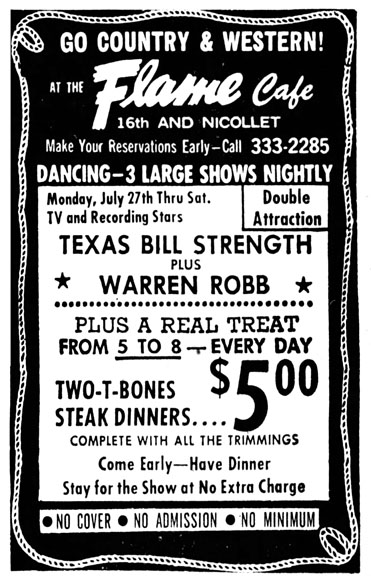
Minneapolis Tribune, July 26, 1970
August 1970
From August 3 to 8, 1970, TBS appered with Liz Anderson and the Willis Wade Country Band at the Flame.
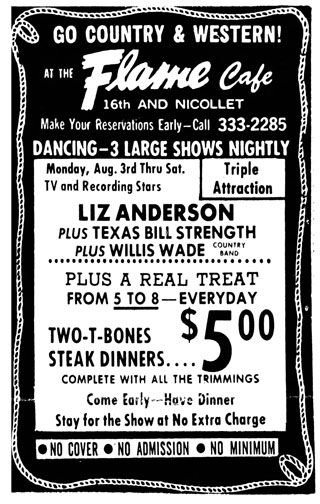
Minneapolis Tribune, August 2, 1970
From August 17 to 22, 1970, TBS appeared with Willis Wade and Johnny Darrell at the Flame.
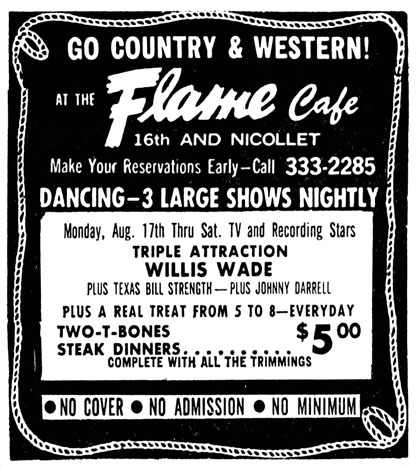
Minneapolis Tribune, August 16, 1970
September 1970
On September 26, 1970, Billboard cried, “Texas Bill Strength, where are you? I was just listening to one of your old Sun Records tunes that Shelby Singleton has repackaged on a variety LP. Great.”
From September 28 to October 3, 1970, TBS appeared with Jerry Naylor and the Clyde Owens Country Show at the Flame.
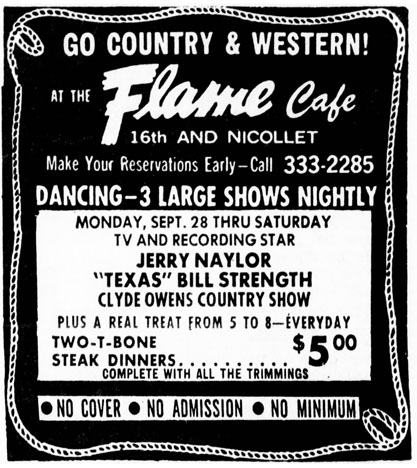
Minneapolis Tribune, September 27, 1970
October 1970
From October 12 to 17, 1970, TBS appeared with Billy Maphis and Rose Lee, plus the Billy James Country Show at the Flame.
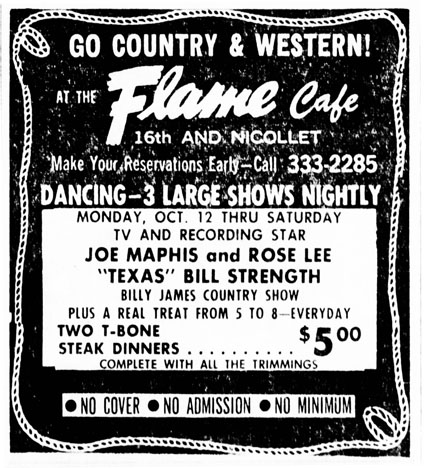
Minneapolis Tribune, October 11, 1970
From October 26 to 31, 1970, TBS appeared with the Cantrells and the George Deaton Country Kings at the Flame.
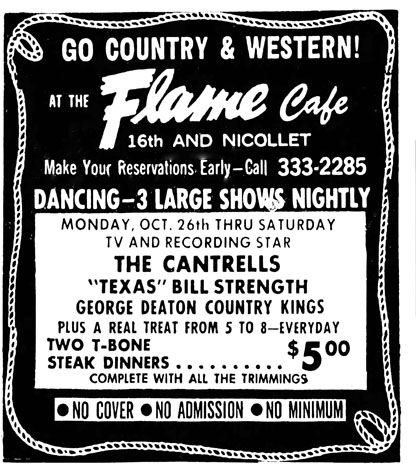
Minneapolis Tribune, October 25, 1970
1971
March 1971
HILLBILLY HADES
RECAR
“Hillbilly Hades” was a clever takeoff on the popular and sentimental “Hillbilly Heaven,” written by TBS with Eddie Dean and Hal Southern. TBS first cut it on Recar Records, yet another of George Garrett’s Minneapolis labels, issued in 1971 as 45-9001. The flip side was “Nervous as a Cat,” another comical song.
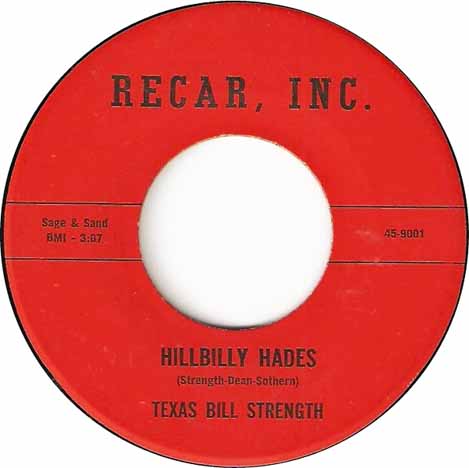
Both songs were then reissued on the Starday label, with the exact same number in March 1971. Bill had been identified as a Starday performer in 1967 but hadn’t had any records released.
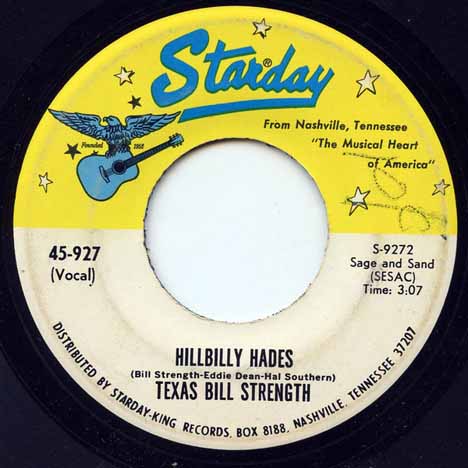
On March 28, 1971, Billboard reported, ” TBS’s new single on Starday is titled ‘Hillbilly Hades,’ a parody of Tex Ritter’s big click of a few years back, ‘Hillbilly Heaven.’ ”
TBS spent two days in Cincinnati last week, plugging his new Starday release, a parody of one of Tex Ritter’s big ones of a few seasons back. Strength stopped here en route from Nashville to Minneapolis, where he continues to spin country platters while appearing as a regular at the Flame. (Billboard, March 13, 1971)
TBS is alive and well in Minneapolis. He wrote Paul Ackerman, music editor of Billboard, a letter about a new Starday Records single called “Hillbilly Hades,” which is a parody of the old “Hillbilly Heaven” country disk. For those of you who don’t know, Texas Bill one of the great country air personalities. (Billboard, April 3, 1971)
Since this came out of a St. Cloud paper, let’s assume that The Office is in the Granite City. TBS had an engagement on April 1 and 2, 1971 with the House Bros. and Bobby Byrd.
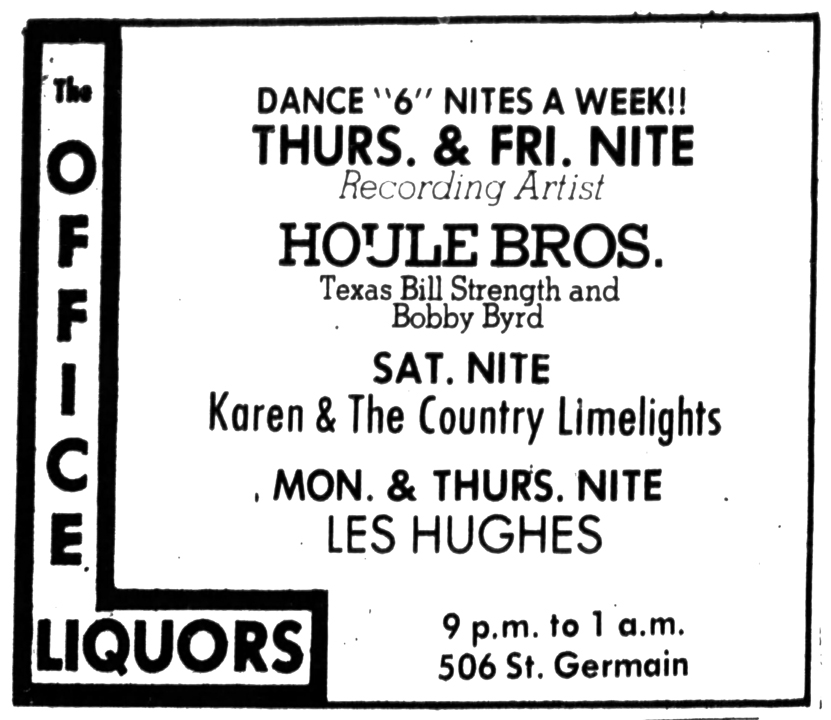
St. Cloud Times, April 1, 1971
July 1971
On July 4, 1971, TBS and Marvin Rainwater performed two shows at 6 and 9 pm at the Stagecoach Inn, between Savage and Shakopee, on Highway 101.
TBS and Marvin Rainwater opened Cooper’s West, the former Seventh Street Rec, 1209 W. 7th in St. Paul, in July 1971. (Connie’s Insider, July 24 to August 20, 1971) Bob Fernow remembers TBS doing some live radio broadcasts from Cooper’s West. The venue didn’t stay country for long.
November 1971
On November 9, 1971, TBS began a stint at a local Minneapolis club called the Filling Station.
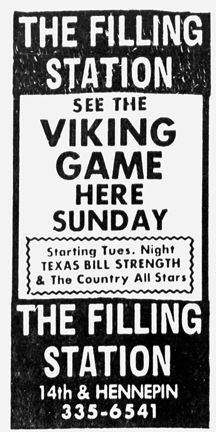
Minneapolis Tribune, Friday, November 5, 1971
Ronnie Pugh quoted an unnamed local newspaper (not the Minneapolis Star or Tribune) that had interviewed TBS in November 1971.
Times have changed … since Bill arrived in 1955 with his guitar. There are at least 20 all-country music night clubs, with at least 15 more which occasionally bill country performers. Progress, undoubtedly, but a scene in which Texas Bill Strength could not possibly hold the upper hand that he once did.
1972
February 1972
From February 22 to 27, 1972, TBS had a stand at the Mermaid Supper Club, which featured Country music.
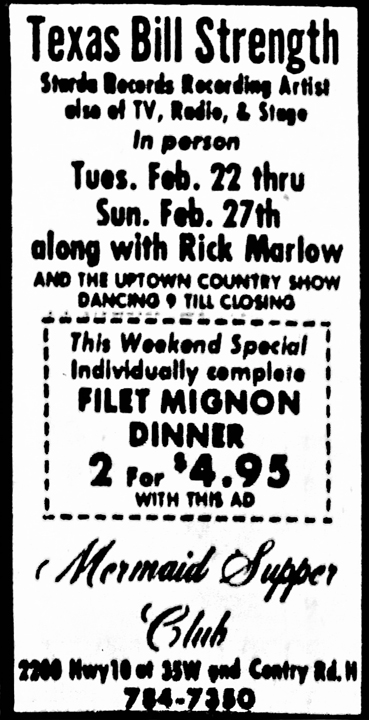
Minneapolis Star, February 1972
September 1972
On Sunday, September 24, 1972, TBS appeared on the Charles McCarty Show, a late-night (10:30) TV show on Channel 5. McCarty was the former Mayor of St. Paul (1970 to 1972), and the purpose of the show was to antagonize his guests like radio host Joe Pyne. On the same show McCarty had the Imperial Wizard of the KKK, a female “Cigar Advocate,” an International Mediator, and a “Guru who discusses life.”
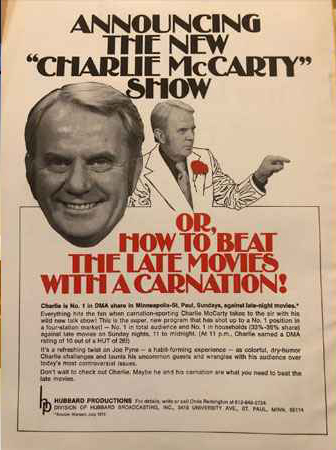
Image from KSTP.com
October 1972
BENEFIT FOR FRANK MAY
On Sunday, October 15, 1972, the Country music community held a benefit for the critically ill guitar player and singer Frank May at Denny’s Loft in St. Paul. “Texas Bill Strength hosted the show and deserves much credit..” reported the Country & Western NEWS-Scene, November 1972.
Other participants included:
- Barbara Lee Mac
- Jan and Patti North
- Marvin Rainwater
- Chill Hilmin
- Bob McDonald
- Bob Flynn
- The Guys and Gal
- Freddie Haas with his Golden Nuggets
- The Mark Allen Trio
- Fern Dale
- Kim Martin
- Ray Boyles
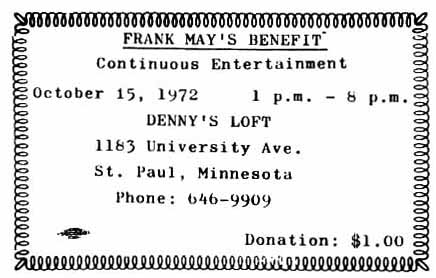
Ticket courtesy Jan Sherman, via Derik Olson
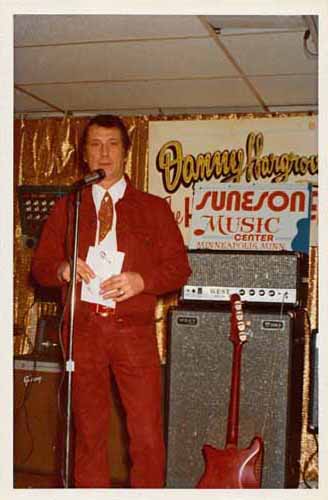
Photo courtesy Jan Sherman via Derik Olson
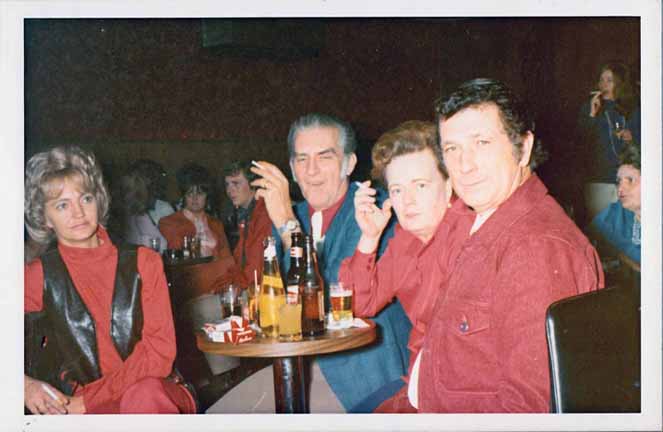
Photo courtesy Jan Sherman via Derik Olson
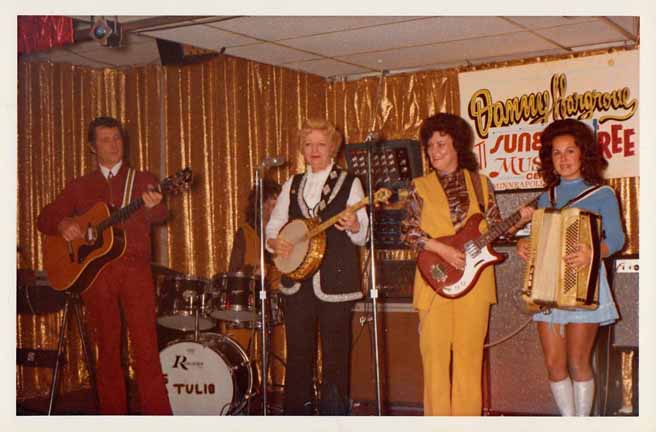
TBS, Fern Dale, Barbara Lee Mack, and Jan Sherman. Photo courtesy Jan Sherman
Well over $2,000 was raised. Frank May, nee Mazzitello, died the following Sunday at age 38.
THE RIVERSIDE
The ad below confirms that TBS performed at the Riverside Supper Club in Ludden, North Dakota, on August 11 and 12, 1972. The Riverside was the last venue Texas Bill ever played, on August 5, 1973. See below.
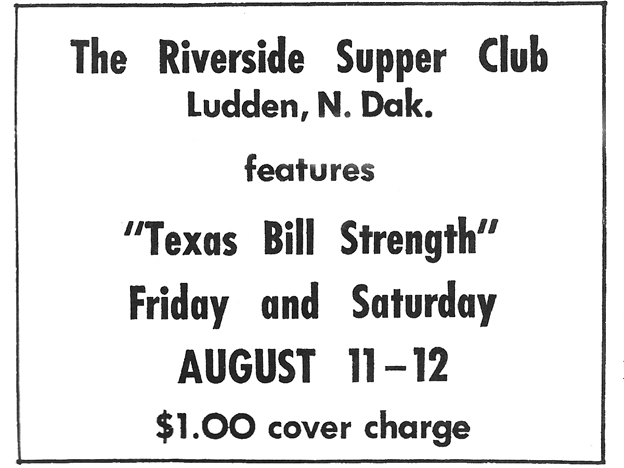
Image courtesy Dale Strength
SOUND 80
The November 1972 Insider mentioned that Sherwin Linton had cut a single at Sound 80. “The Sundowners, Texas Bill Strength, and Mary Beth and Chill Hilmin have also recently cut sessions at Sound 80.”
1973
March 1973
After discontinuing its country format a year ago, the Flame reverted to form and began bringing in big name country performers again. There were now two full-time country house bands: TBS and his group in the front lounge and the Chill Hilmin Country Show in the main room. Part of the renewed interest can be attributed to the addition of an all-night country show on KTCR-FM with Gregg Elsworth. KSTP AM also had a midnight to 6am country show directed specifically at truck drivers and other night people, hosted by Al Carlson. KSTP had a powerful 50,000 watt signal. (Billboard, March 10, 1973)
May 1973
BRITE STAR RECORDS
On May 12, 1973, Billboard announced that TBS, still active with radio and television in the Minneapolis area, has signed with Brite Star Records. The label has a Nashville address. It was his last record label.
TBS cut two sides for Brite Star, issued as No. 2448:
- “Some How, Some Day, Some Way,” written by TBS and Bobby Sisco
- “Nothing is Sweeter Than You,” written by TBS and Don Scaife
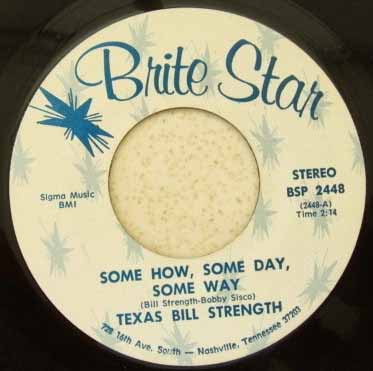
June 1973
The June 1973 Insider reported that TBS was working at Larry Henning’s By George Inn in Anoka, by Lake George.
Johnny Cash, June Carter, Carl Perkins, and the Tennessee Three were in town on June 13, 1973, to perform at the Minneapolis Auditorium. TBS caught up with him while he was in town, and wrote about him in his “Down Memory Lane” column in the Upper Midwest Country & Western News Scene magazine. The article also included this photo of the two, taken on that June 13, 1973, day.
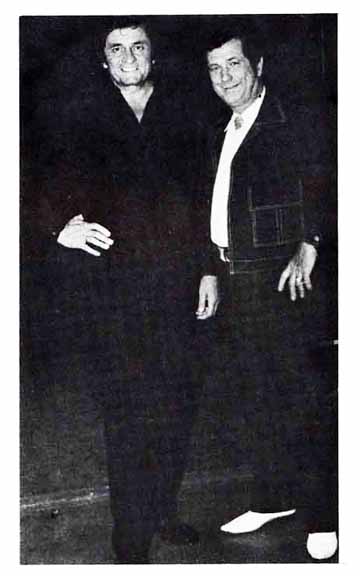
JR RANCH
On June 15, 16, and 17, 1973, TBS performed at the JR Ranch in or near Eau Claire, Wisconsin, run by John Roucheat (hard to read). On the 16th and 17th, the Ranch was running a Rodeo, and Tex Ritter was also on hand for entertainment. Attractions included Dancing under the stars to Country Western Music June 15, 16, & 17 by Texas Bill Strength, Star of Radio, TV, Stage and Records.

Eau Claire Leader-Telegram, June 6, 1973
The Insider reported on this appearance in its July 1973 issue, but true to form garbled it to say it was the H&R Ranch. They did did get the Tex Ritter part right, though. Unless TBS and Ritter were at some other ranch as well?
July 1973
The July 1973 Insider also reported that on July 10 and 11, 1973, Minneapolis would host a meeting of the board of directors of the Country Music Association – the first time in our City.
It also said that tours to Nashville from Minnesota were “booked up tight for months.” TBS was organizing such a tour.
The August Insider said that the quarterly meetings of the officers and directors of the Country Music Association were held on July 9 – 11, 1973. Sound 80 gave a cocktail party at their studios, and TBS was there, along with Roger Suneson, Tex Ritter, LeRoy VanDyke, and Roger McGuinn.
THE DEATH OF TEXAS BILL
One topic that I knew almost nothing about was the circumstances surrounding the automobile accident that led to the untimely death of Texas Bill. It’s no wonder – the information was all over the place:
- In an article about TBS published in the Journal of Country Music in 1998, Ronnie Pugh wrote, “While riding back asleep from a singing job in Fargo, North Dakota, on August 5, 1973, Strength was paralyzed from the chest down when his car, driven by a friend, left the road and flipped over several times.”
- In the program from the 2006 Rock/Country Hall of Fame when TBS was inducted, his biography says that he was “asleep in a car while driving with a friend on a promotional tour.” This is the same language used in TBS’s biography on a website called hillbilly-music.com and another one called bopping.
- A website connected with a country broadcaster’s radio seminar also mentioned the “promotional tour.”
None of this turned out to be true. The “friend” turned out to be his steel guitar player, Bobby Mack (McDonald), and many years later, Bobby Mack’s ex-wife, Kim Martin, wrote a song based on a newspaper article from the town where the accident happened. The song was called “Denver Dragon” (a nickname TBS picked up because he could do the routine so well), and can be heard on YouTube. The song yielded more hints and inspired me to go to North Dakota to check it out for myself. I spoke to witnesses, read contemporary newspaper accounts, took photos, and I think finally got the real story of what happened on the tragic night that caused the injuries that ultimately led to the death of Texas Bill.
Some of the information below is undoubtedly heresay, some speculation, and some from members of the Strength family. Much comes from memories from 45 years later. But I have a fair amount of confidence in the sequence of events.
THE GIG
Far from being a “promotional tour,” this was just a one-off performance where the plan was to drive up to the venue from the Twin Cities, do the show, and return after the show was over. Kim said Bill set it up for Sunday, August 5, 1973. She said she was supposed to sing and play bass, but she was called into court and had to stay in Minneapolis. Bill recruited Bobby Mack to be a part of the band.
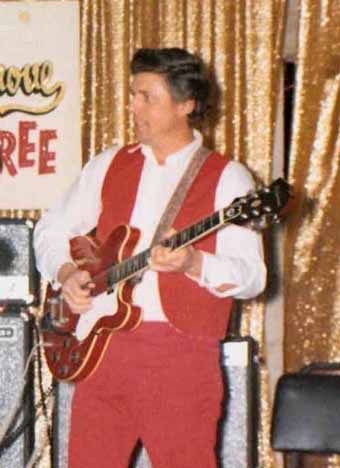
Bobby Mack at a 1972 benefit. Photo courtesy Jan North, via Derik Olson
THE VENUE
The name of the venue was the Riverside Supper Club, located ten miles south of Oakes, North Dakota, and a mile west of tiny Ludden (Population 44 in 1970). Sherwin Linton had “discovered” the place; he says,
I had played there many times from May of 1970 through the ’70s and early ’80s. I would likely have never been there if I had not blew an engine on a new Dodge Motorhome, but that’s another story. I introduced Marvin Rainwater and Bill to the owner Don Pulfrey and arranged for them to be booked there.
Even now the club appears to be in the middle of nowhere, but it is conveniently located at the intersection of Highways 11 and 1, on the east bank of the James (called the “Jim”) River. Sherwin says that folks in the surrounding small towns thought nothing of driving for miles to the place for dinner and a show.
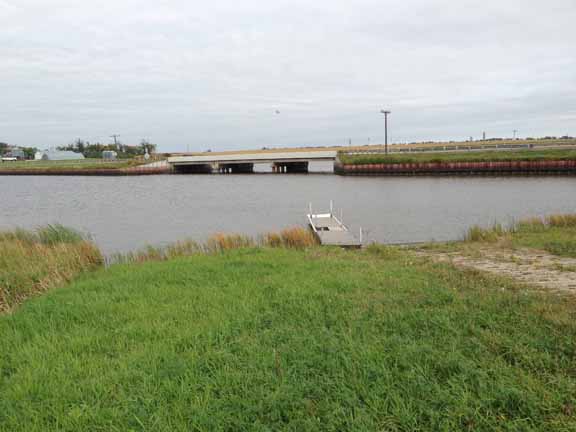
The Jim River
The Riverside was a 50’ x 100’ brick building built in 1961 by Marvin and Geneva Anderson, and Geneva’s brother-in-law, Elmer Jensen. After a soft opening, there was a Grand Opening on December 18, 1961, with a rose given to the first 100 ladies and an undisclosed grand prize. In 1968 the club was sold to Don Pulfrey. Pulfrey owned it when the accident happened.
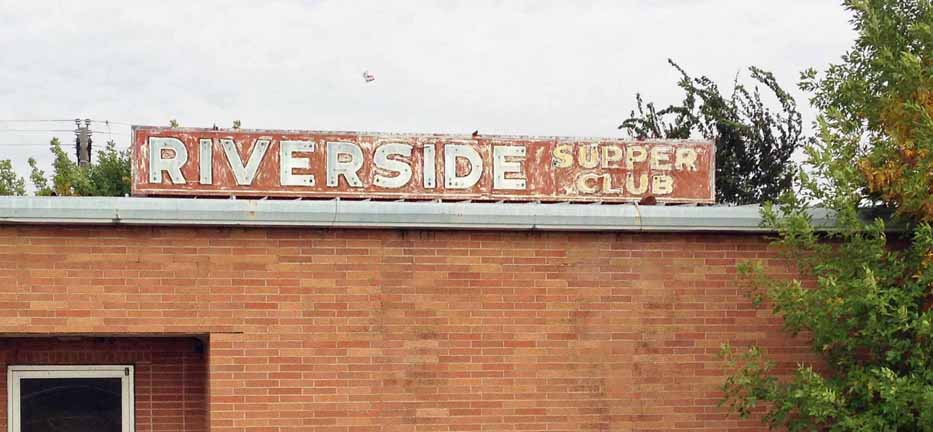
September 2018
The next owner was Marvin Anderson, Jr., who bought it in December 1974 but closed it in November 1975 to move to California. The next owner was Kenneth “Snook” Loepp and his wife Donna, who made all the salads. The Loepps bought it in 1980, but shortly after Donna died in 2001, Kenneth closed the Riverside. Snook died in December 2015. The Riverside today is a ruin, with a caved-in roof and overgrown shrubbery. But a peek in the door reveals the dining room to the left, still set for dinner with tables and chairs and tablecloths. The kitchen is straight ahead, and the lounge is to the right.
A wooden extension was built to accommodate the band and the dance floor. A mural featuring pink mountains was painted on the end of the extension (on the right in the photo below).
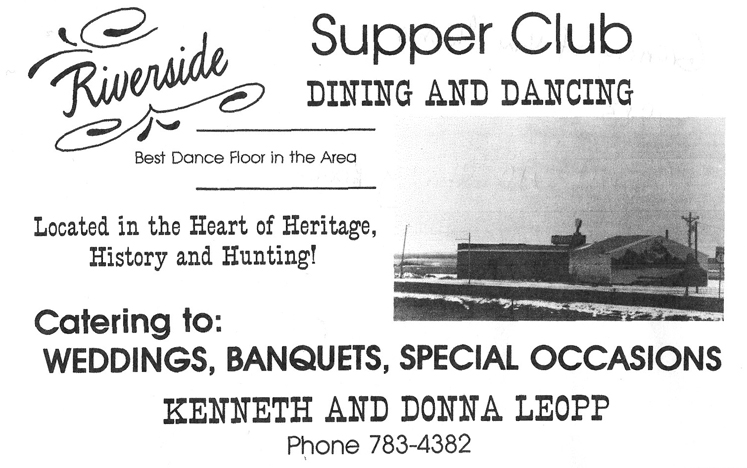
1983 Ad from Granary of the Plains – History of Guelph, ND, courtesy Dickey County Historical Society
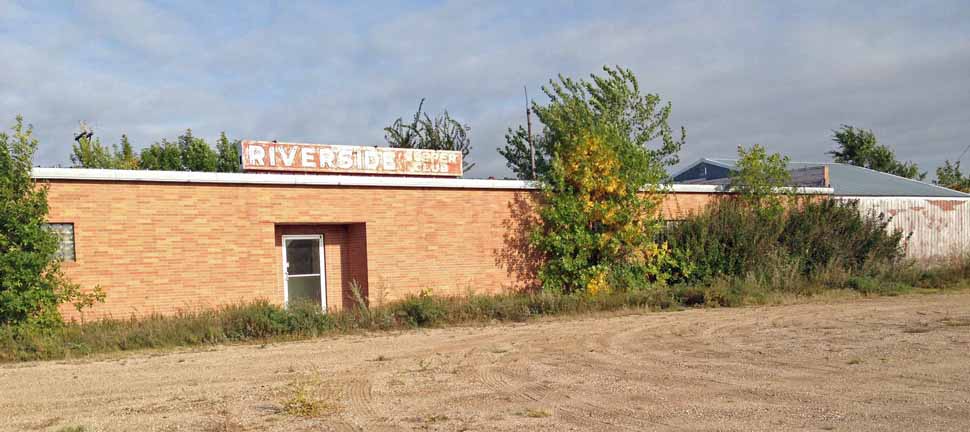
September 2018
LEAVING THE CLUB
After the show, the musicians hung around, drinking and having fun. Based on when Bobby Mack arrived at his door for help, farmer Lorence Holmgren estimated that they probably left the club about 4:30 am.
Sherwin Linton: “I talked with Don (Pulfrey) later after the accident and he said Bill and Bob (especially Bill) stayed and partied after the show and were well loaded when they left. He begged them not to leave, even offered to put them up in his RV out back, but they left anyway. When Don talked about that night he had tears in his eyes.”
WHO WAS DRIVING
This seems to be one of the biggest sources of contention, but it seems pretty clear that Bill was driving. First, both men were most certainly in the front seat, since the back seat was full of musical instruments, including a steel guitar.
- Kim Martin seems to think that her husband “Bob was asleep, which no doubt saved his life as he was relaxed.”
- This contradicts what Lorence Holmgren remembers, which is that Bob told him that he was awake and kept telling Bill that he was going the wrong way.
- As was mentioned in the introduction, some mysterious “friend” was driving while Bill was sleeping in the back seat.
- The Kulm Messenger, 8/16/73: “Driver Texas Bill Strength…”
THE CRASH
Lorence described the mixup: From Ludden they would have gone north on Highway 1 and turned right (east) to get on Highway 13. 13 would have taken them all the way to 94 and back to the ‘Cities. Instead they missed the 13 that was going east, kept going north on Highway 1, and saw a sign for Highway 13, but that 13 was going west. When they reached Highway 281 (at Edgeley), Bob was sure they were going the wrong way, but the more he tried to tell Bill that they needed to turn around, the faster Bill drove.
On the map below, the green line traces the route taken, starting at Ludden at the border of North and South Dakota. As you can see, they took Highway 13 west instead of Highway 13 east (see arrow). It was raining, and the correct intersection was probably poorly marked.
Four Mile Corner: (Kulm Messenger, 8/9/1973): “Their car failed to complete the curve in Highway 13, 4 miles north of [Kulm]. Apparently the car traveled along the north shoulder for several hundred feet but rolled over as the driver attempted to bring the car back on the highway.” Four mile corner has been reconfigured since then, but that was the term used for it in the newspaper account. I suspect that Kim used this account for her song.
Lorence said the car slid sideways, halfway off the grass before it started to roll. The tires blew, the car rotated 2 ½ times and ended up on its roof.
The devastation of the damage can be seen in the photos below, taken after the car was towed into town.
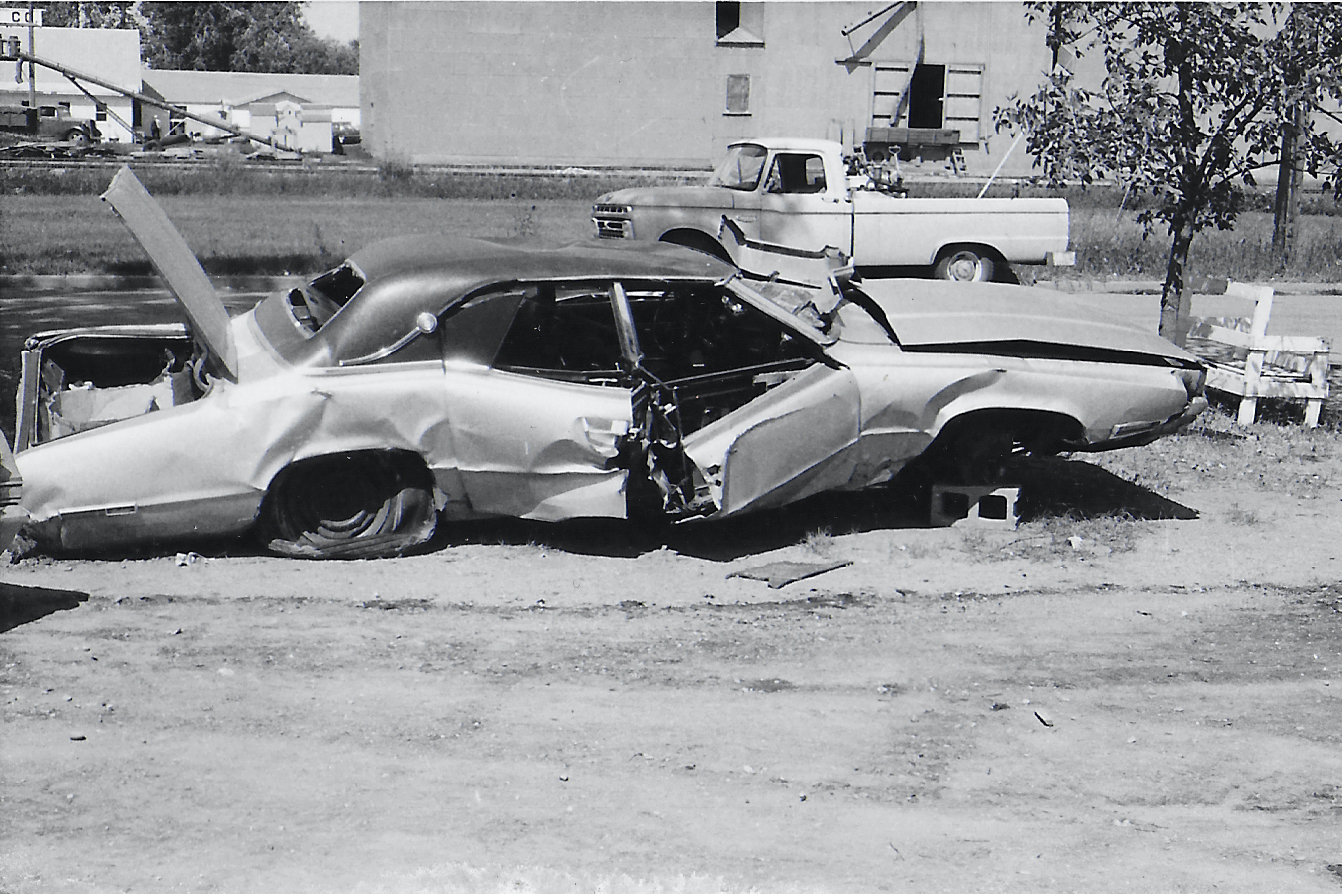
Photo courtesy Dale Strength
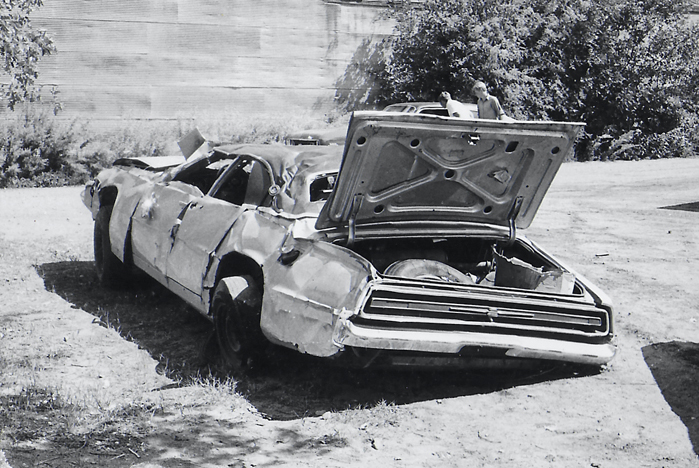
Photo courtesy Dale Strength
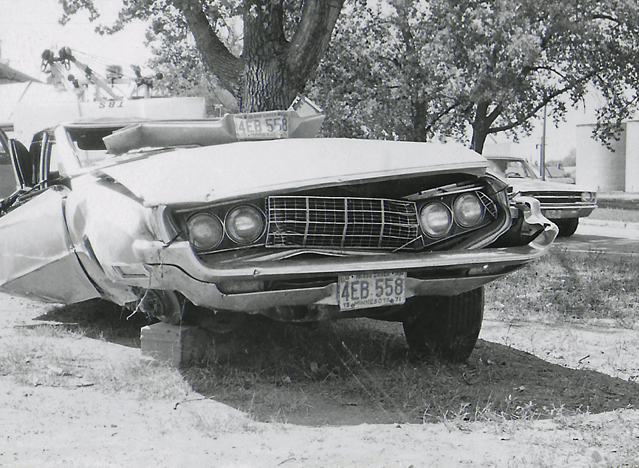
Photo courtesy Dale Strength
The photo below was published in the local newspaper.
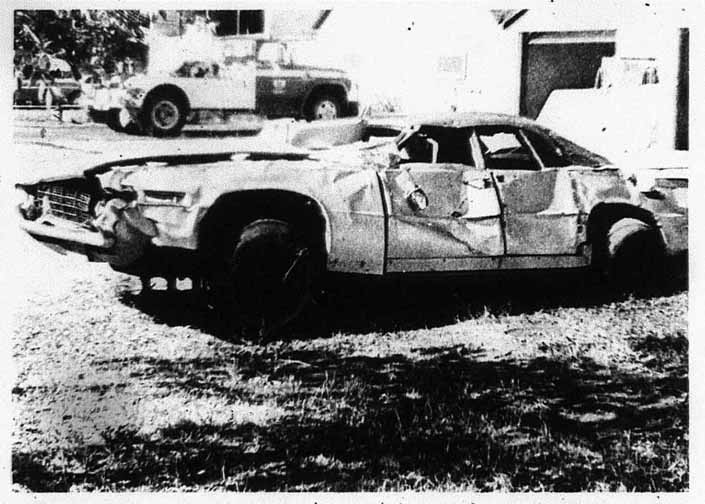
Kulm Messenger, August 9, 1973
Bill bought his 1968 silver Thunderbird from friend/fellow musician Chill Hilmin. This was one of the most powerful cars on the road, with a V-8 engine that had to be tuned down for insurance purposes.

Image from Internet
THE WEATHER
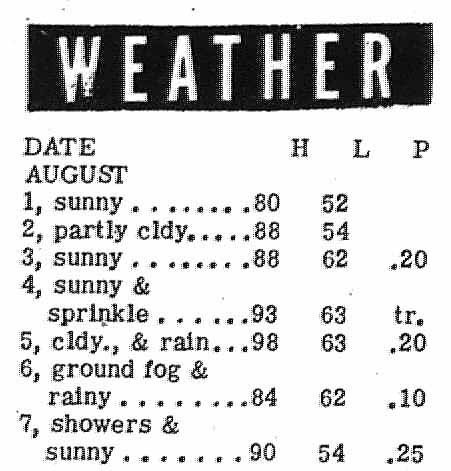
Kulm Messenger, August 9, 1973
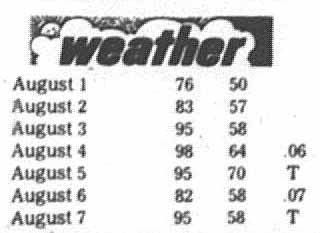
Oakes Times
THE HOLMGRENS
Bob crawled (Kim) or walked (Kulm Messenger, 8/9 and 8/16) to the Holmgren farm where he saw a light and summoned help. A neighboring farm was actually closer, but Bob probably saw their light.
Lorence Holmgren was 22 at the time and was raised on the farm. He had just taken it over from his parents a couple of years ago from his parents, who had moved into town.
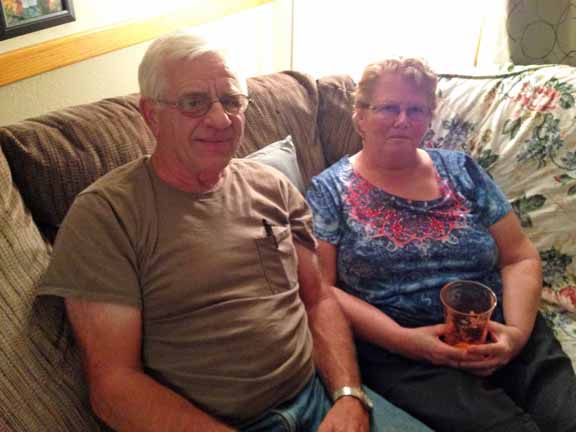
Mr. and Mrs. Lorence Holmgren – September 12, 2018
Lorence and his wife described the scene that night. Bob got to the house, opened the outside screen door, and pounded on the kitchen door. It was then about 6 am Sunday morning. Lorence went to see who it was. Bob was soaking wet and had some blood on him but wasn’t too gruesome. Lorence’s brother Michael was staying there that night too. They remember Bob’s first words as “You gotta help us.” He asked for blankets and laid down on the kitchen floor.
BOB’S INJURIES AND HOSPITALS
Lorence and his wife personally took Bob to the local hospital in Wishek. She said they had to air out the car afterwards, it smelled so much like alcohol. The Kulm Messenger said Bob was still in Wishek on August 9.
Kulm Messenger, 8/16/73: Bob was later transferred to St. Luke’s in Fargo with a partially crushed chest and an injured knee. “He will go back (to St. Luke’s) next week for a knee operation.”
Kim said he was then released to recover at home.
IMMEDIATELY FOLLOWING THE CRASH: BILL
Lorence realized from Bob’s description that Bill’s injuries were more serious and he needed an ambulance. With no 911 system, all he could think of to do was to call local policeman and friend Dave Robinson and Dave handled calling the ambulance for Bill. The Kulm Messenger (8/9/73) said that the Holmgrens “called ambulance and patrol.”
ELLENDALE
Edgeley Ambulance took Bill to Ellendale Memorial Hospital. According to admissions reports in the paper, he was not admitted.
Bill’s son Dale and friend Gregg immediately drove up to Ellendale. Dale remembers that Bill’s head was stabilized and he was upside down so they had to look at him from underneath. Dale remembers Bill saying something to the effect of, “Well boys, here we go again.”
ST. LUKE’S
Not right away, but soon he was transferred to St. Luke’s Hospital in Fargo. Below is a photo of St. Luke’s in 1975 – it looked just the same in 2018, although with extensive additions on the right side. In 2018 it was owned by the Sanford Medical Group, but apparently the locals still call it St. Luke’s. The quality of the photo is poor because it is from a display in the lobby taken with a phone.
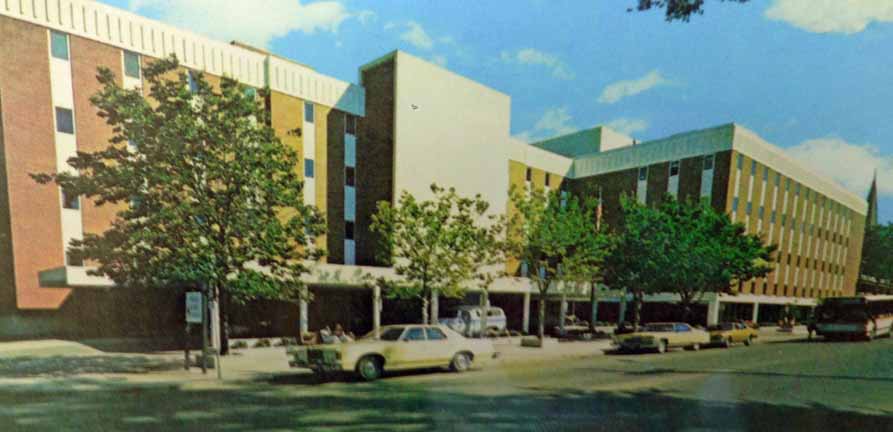
At this writing, TBS was in poor condition at St. Luke’s Hospital in Fargo following an auto accident. Bill records for Brite Star in Nashville. (Nashville Scene column by Bill Williams, Billboard, August 18, 1973)
Bill Williams reported that TBS was still in the Fargo hospital. This appears to be his last mention in Billboard. (August 25, 1973)
ST. PAUL- RAMSEY HOSPITAL
Dale used his connections to have him transferred to St. Paul – this must have been before August 15.
BILL’S INJURIES
Kulm Messenger, 8/9/1973: Bill was pinned in the wreckage. The inside of the car was a mess of broken musical instruments, guitars, amplifiers, and other equipment.
Kulm Messenger, 8/16/73: Still in serious condition (by then in St. Paul)
- broken jaw
- broken neck. Kim says this was due to the pedal steel that landed on him from the back seat and had to be lifted off of him. She said he was paralyzed from the waist down and would never walk again.
- broken left arm, reportedly broken in three places.
- He had to breathe through a tracheal tube.
He would also have had symptoms of alcohol withdrawal, but they would have lasted only the first 5-7 days, and he would have been heavily sedated anyway.
DETERMINATION
Despite his injuries, Bill wrote an article for the October 1973 issue of the Upper Midwest Country & Western News Scene magazine called “Down Memory Lane.” He referred to his “almost-fatal accident” and said that his doctors said that he’d never walk again. Nevertheless, he expressed his determination to follow through on his plans to lead a bus tour to Nashville, although at a postponed date. “Even if I can’t walk again, I think I can get me an electric wheelchair, with an outboard motor on it or something. I’ll get around. Right now I feel about as necessary as a milk pail under a bull …” Bill dedicated the article to his idol and friend, Ernest Tubb.
Friends rallied behind him; Kim Martin remembers:
I purchased a beautiful new Ovation guitar at Roger and Char Suneson’s Music Store on Lake Street in Minneapolis and brought it to the hospital to give him hope and something to live for. I thought if he saw it, he’d get the energy to focus on building strength. He was so happy to have it and I could clearly see that. I’m so glad I did as I saw the joy in his face. Even if he couldn’t play it yet he could think about doing it one day. When I put the guitar on his bed his eyes filled up with tears (poor soul).
Jan Sherman of the North Sisters was at the hospital when Al Tedesco, who owned the radio station, promised to build him a ramp, and Bill’s eyes welled up with tears.
COMA
At about 2 am on September 15, 1973, while Bill was asleep, his doctor ordered Bill’s tracheal tube turned off. This is commonly done to encourage the patient to breathe on his own. However, when you do this you also have to deflate the cuff that holds the tube in place, or the patient isn’t able to breathe. The lack of oxygen caused him to suffer respiratory arrest and go into a coma. (Presumably the mistake was caught or he would have died from lack of oxygen that night?) Although no one at the hospital officially admitted that this is what happened, a nurse or other staff member told Dale the next day either that the cuff had not been deflated or simply that a mistake had been made.
Hearing that Bill was in a coma, loyal friend Tex Ritter sent a reel to reel tape for Dale to play for him in the hospital. It was a loop of encouraging words, urging him to wake up and telling him how much he was loved by his friends.
BENEFIT
On September 30, 1973, friends of TBS sponsored a benefit at the Medina Ballroom from noon to midnight. In the notice of Bill’s passing in the November 1973 Insider, Peter Dwyer said of the event,
The famous and talented country star passed on the day after his friends packed the Medina Ballroom in Hamel for a testimonial. They came by the droves, more than 5,000 of them, and raised thousands of dollars for his hospital bills.
Son Dale, still in shock, remembered it differently, wondering why so little was raised at the event.
THE DEATH OF TEXAS BILL
Texas Bill Strength died at St. Paul-Ramsey Hospital on October 1, 1973.
His Certificate of Death reported a series of natural causes:
- Cardiac Arrest: “Immediate cause” listed on the Certificate of Death.
- Chronic cardio-pulmonary deterioration: This brings up COPD when Googled.
- Cervical fracture with quadriplegia: Broken neck, but we know he wasn’t quadriplegic as he could move his arms.
Other significant conditions: Chronic obstructive lung disease with pneumonia
Newspapers, presumably working with a press release, reported these causes:
- Injuries from the accident: Most newspapers said that Bill died as a result of the injuries he sustained in the car accident, despite the fact that he had survived them for two months.
- Pneumonia: Two papers reported that although he had suffered serious injuries in the accident, the hospital listed his cause of death as pneumonia. The Indiana Press and the San Antonio Express and News worded their reports almost the same way, as if working from a different press release.
LEGAL ACTION
Remember that the only one left in charge was Bill’s son Dale, who was a month from turning 24 years old. He had to make funeral arrangements, fend off Bill’s “friends” who were trying to help themselves to his belongings, and keep his own career going at the same time. To say this was a bit bewildering is an understatement.
Then appears a Mr. William C. Bland, a lawyer friend of Bill’s from somewhere down South, whose stated purpose was to bring a wrongful death case against the hospital. Bland was a big fellow, who was not in great shape himself; in fact, Dale remembers that he died very shortly after his visit to Minnesota. He stayed in Bill’s apartment while he prepared his case, and somehow was able to obtain access to Bill’s medical records quite easily.
And he won. Now, how much he won is long forgotton, by all three of Bill’s heirs. Those terrible days in the aftermath of his father’s death became a blur over time, but Dale remembers his father’s good friend, William C. Bland.
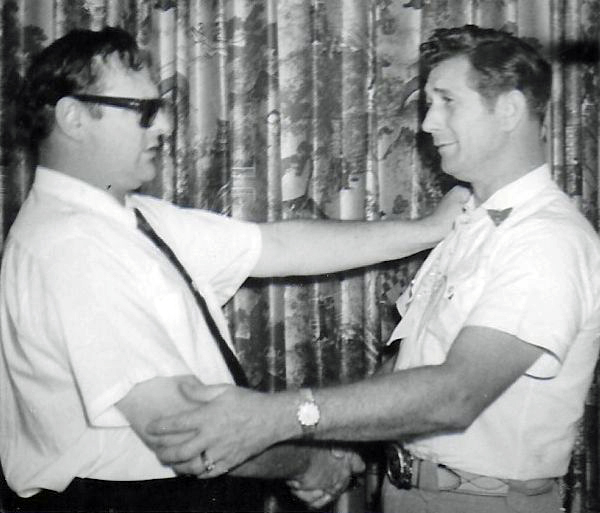
William C. Bland and William T. Strength. Photo courtesy Dale Strength
MY TAKE
Texas Bill got himself into a mess by drinking, driving, and maybe just being too ornery. But he was willing to own up to his mistake and live out the rest of his life, even if he could never sing again and if he had to get around in a wheelchair with an “outboard motor.”
What killed him was another mistake, a much more subtle but deadly mistake made by a nurse who accidentally asphyxiated him in a St. Paul hospital. This one was covered up, and although it couldn’t be undone, his family was denied the answers and compensation they deserved.
But however tragic the circumstances of his death, we are left with the songs, the stories, the adventures, the friendships, and the love for his family that make up the legacy of Texas Bill Strength.
SERVICES AND TRIBUTES
Services for Texas Bill were held at Fourth Baptist Church on October 6, 1973, at 11 am, with burial at Lakewood Cemetery in Minneapolis. Memorials were preferred to the Country Entertainers Association’s Trust Fund.
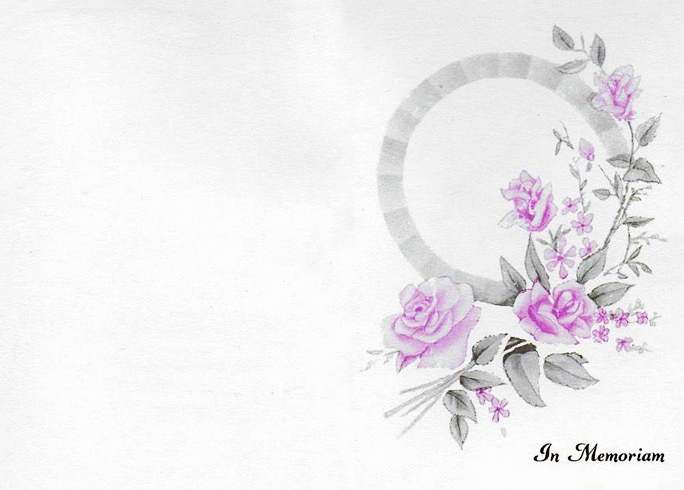
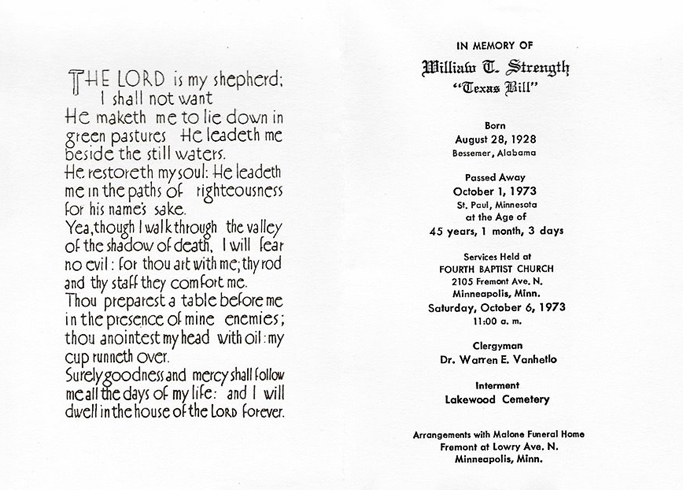
Funeral services were held last week for TBS, at Minneapolis. He died there of injuries suffered in an auto accident several weeks ago. (Billboard, October 20, 1973)
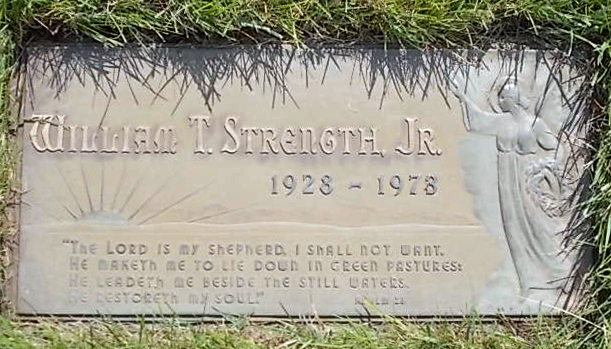
On October 6, 1973, KTCR honored TBS on its Country 9 + 20 Survey (look under “KTCR Pick-Album”).
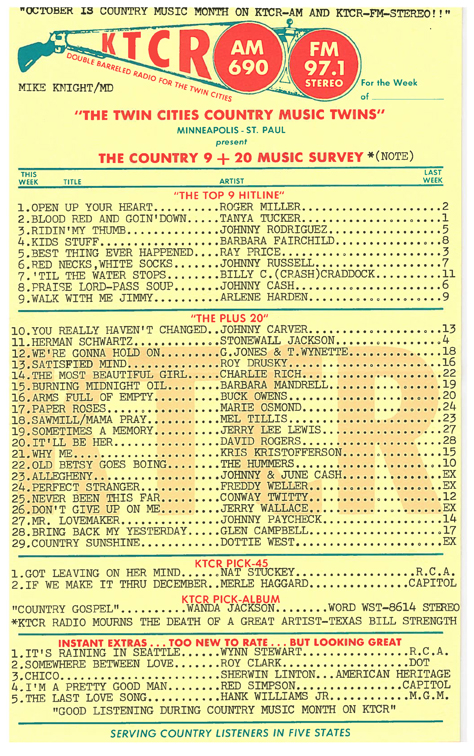
The November 1973 Insider’s announcement said,
Strength had one of the richest histories of any country star. He was a radio personality who’d appeared with friends like Hank Williams, Johnny Cash, Tex Ritter, and Marvin Rainwater. He’d recorded on the Memphis Sun label, Capitol, and Coral, as well as locally; and he’d appeared at the Grand Ole Opry. Though he never had that one monster smash song, he was a gifted and influential figure in country music. We’re saddened at the loss of this fine man.
COUNTRY ENTERTAINERS’ ASSOCIATION
The December 1973 Insider reported that the Country Entertainers’ Association of the Upper Midwest (CEA) was formed during the summer and fall in Minneapolis. The CEA was a pet project of TBS. Its many purposes were to:
- Promote the use of live entertainment;
- Provide an informational monthly publication;
- Provide social and promotional activities, including public exposure and stage experience for members and guests;
- Provide an annual directory of members; and
- Obtain discounts for members through music stores and other businesses engaged in supplying goods and services to country music entertainers.
A future goal was to set up a trust fund for regular members who become disabled and face severe financial difficulties. This would eliminate the benefit shows which had been the means to aid needy musicians.
Officers of the CEA were:
- Fredddie Haas, President
- Skip Spaulding, Vice President
- Linda Tretter, Secretary-Treasurer
1974
LETTERS FROM FRIENDS
In the wake of the passing of Tex Ritter on January 2, 1974, TBS’s son Dale wrote to his father’s friends in the Country music community to collect their memories of TBS. Many were received, including one from his old friend, Carl Perkins:
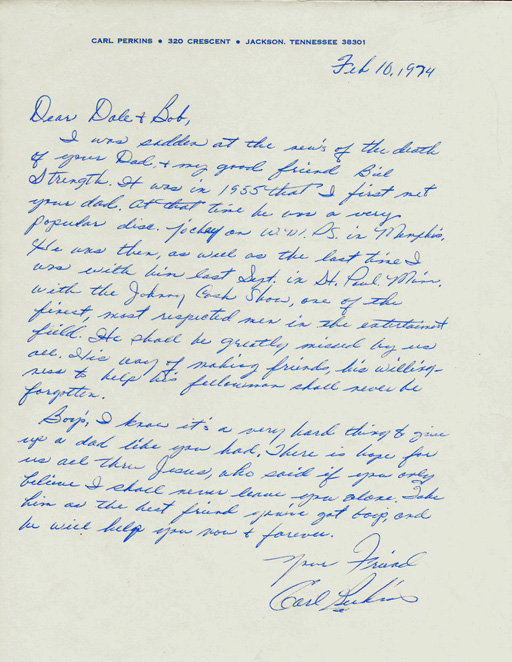
The letter reads:
Feb 10, 1974
Dear Dale & Bob,
I was saddened at the news of the death of your Dad & my good friend Bill Strength. It was in 1955 that I first met you dad. At that time he was a very popular disc jockey on WMPS in Memphis.
He was then, as well as the last time I was with him last Sept. in St. Paul, Minn. with the Johnny Cash Show, one of the finest, most respected men in the entertainment field. He shall be greatly missed by us all. His way of making friends, his willingness to help his fellow man shall never be forgotten.
Boys, I know it’s a very hard thing to give up a dad like you had. There is hope for us all thru Jesus, who said if you only believe I shall never leave you alone. Take him as the best friend you’ve got boys, and he will help you now & forever.
Your Friend
Carl Perkins
On January 26, 1974, Boudleaux and Felice Bryant placed a multi-page ad in Billboard with the text, “We hate to think of what the past twenty- five years would have been for us without you, the artists who have recorded our songs. Thanks forever.” Several hundred artists, including TBS, were listed alphabetically, followed by a list of songs the pair had written.
On May 5, 1974, the Dayton Daily News reported that a Texas Bill Strength Memorial Scholarship had been established at the University of Minnesota by the Country Entertainers Association of the Upper Midwest.
1975
Friends of the Grand Ole Opry published a list of the artists who had appeared on the show over the years, either as members or guests. TBS was listed as William T. Strength. (Billboard, September 6, 1975)
1978
On October 19, 1978, TBS was nominated posthumously to the Disk Jockey Hall of Fame, awarded by the Federation of International Country Air Personalities at their third [fourth] annual banquet, held in conjunction with Country Music Week in Nashville.
1979
TBS was nominated in the posthumous category to the Fifth Annual Country Music Disc Jockey Hall of Fame. The presentation was made on October 12, 1979, at the Hyatt Regency Hotel in conjunction with the annual Federation of International Country Air Personalities Banquet. (Billboard, October 13, 1979) He would win the award in 1991.
1991
TBS was inducted into the Country Music Disc Jockey Hall of Fame. The induction ceremony was held on June 13, 1991.
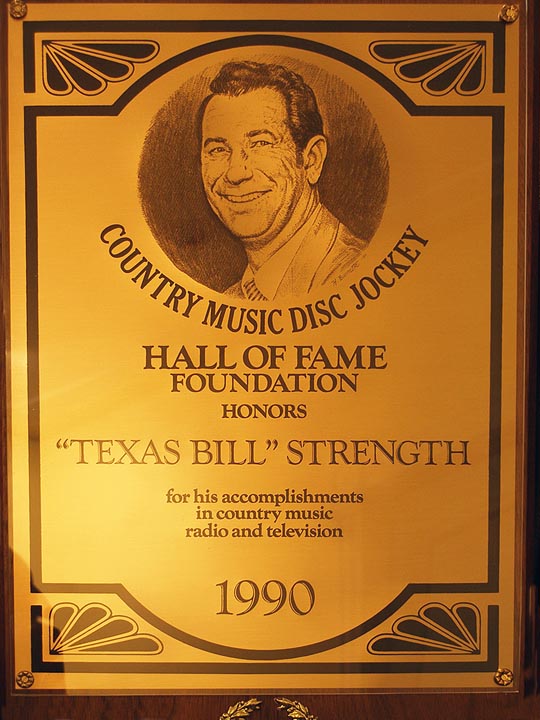
SHOWTIME
In the early ’90s, Dale’s friend Neal Bond had a cousin who was with the Showtime TV Network and helped Dale and Neal pitch the idea of a Texas Bill Strength movie, to be called “The Original Country Outlaw” to the network. Dale hoped that John Ritter could play his dad, Tex Ritter.
The people at Showtime passed, saying the story had “limited appeal.” Although Texas Bill was known all over the country for his recordings, his work as a disc jockey, his personal appearances, his TV and radio performance work, his appearances for the CIO, and his appearances on the Grand Ole Opry and other TV shows, Showtime said they were only interested in promoting stars of the stage and screen.
This blunt rejection was cruel and ironic, because if you’ll remember back to 1957, the St. Paul Pioneer Press’s special section dedicated to TBS was headlined “Movie Stardom is Texas Bill’s Aim.” At that time he was going to California with Tex Ritter to work with him in a couple of films, and said that his biggest ambition was to be a Western movie star. “I’ve had some real good encouragement from producers and directors in Hollywood,” he said. Although he had no formal acting training, he expressed his belief that “I’ve got a natural ability for Western parts.”
Texas Bill never did fulfill that dream, and so far no movie has been made about him. But it’s never too late for someone to shine a light on the fascinating life of this unique, talented, charismatic man – and we know so much more about him than we did in the 1990s.
2004
On May 22, 2004, TBS was given a posthumous Lifetime Achievement Award in the Minnesota Rock/Country Hall of Fame.
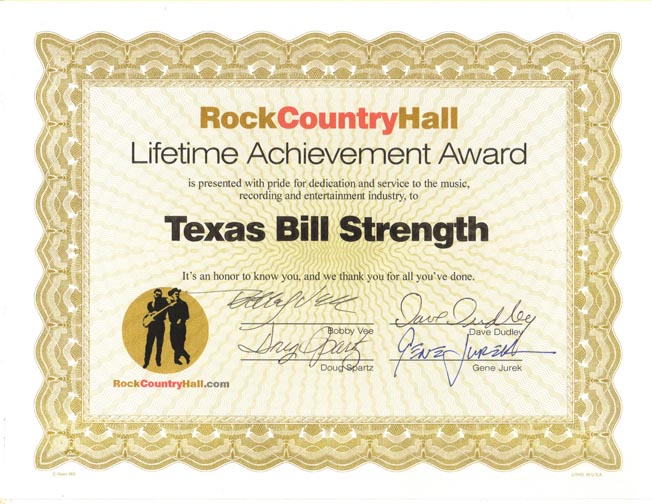
2006
In 2006, TBS was inducted as a performer into the Minnesota Rock/Country Hall of Fame.
2013
In 2013, TBS was inducted into the Legends of South Dakota Country Music and Museum.
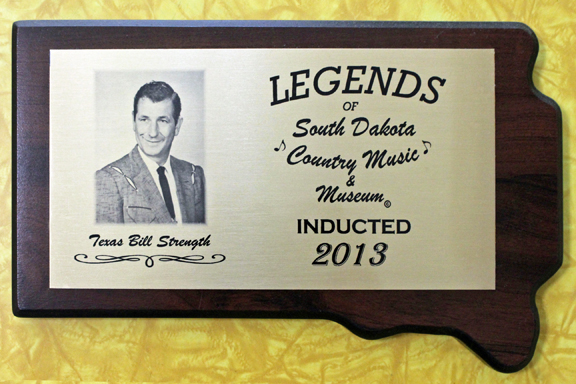
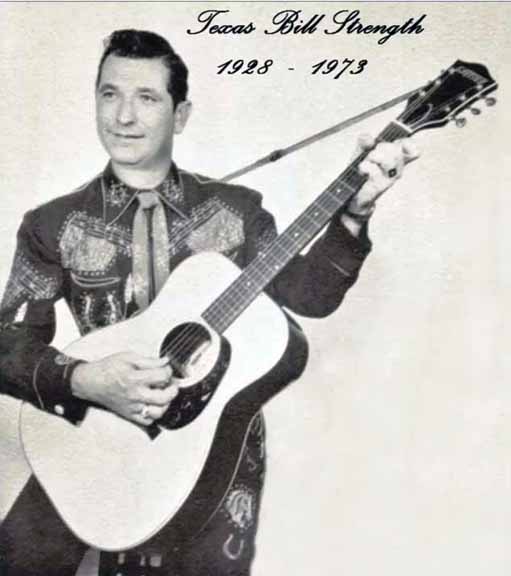
Photo courtesy Dale Strength
TEXAS BILL STRENGTH’S RECORDINGS
EXTENDED PLAY 45
Bill’s recording of “Six Fools” was included on an EP called “Round Up,” issued by Capitol Records in February of 1962, according to discogs.com. The song was recorded on February 25, 1957.
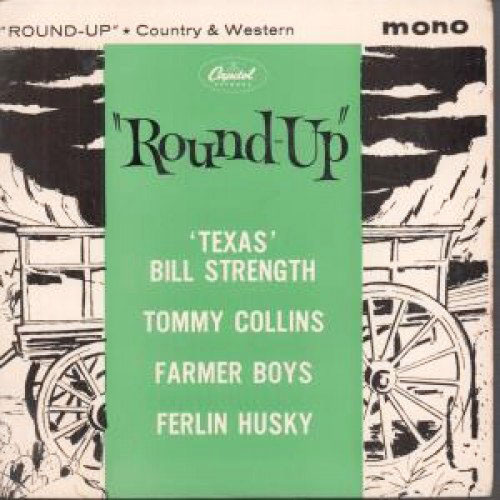
ALBUMS AND CDs
TBS issued one album during his lifetime, Texas Bill Strength’s Greatest Hits. It was released in 1967 on Re-Car Records, a Minneapolis label owned by Russell Holland. Holland wrote the liner notes, which mistakenly said that TBS was born and raised in Houston.

Songs on the album and the years they were recorded are:
- Let the Chips Fall – 1962
- Foolish Pretender – 1962
- The Moment I Found You – 1966
- The Best Thing in Life is Love – 1966
- As Much Yours as Mine – 1965
- Call of the Wild – 1960
- Lake Lonely – 1965
- I’m Gonna Catch You – 1966
- Betty Lou – 1966
- Let’s Make Love – 1963
- Bells of Memory – 1964
- Paper Boy Boogie – 1964
In 1982, a German company called Castle issued a set of albums called “Country & Western in the 1940’s and 1950’s.” There were six volumes, all sharing the same jackets, with only the Volume number circled. That’s efficiency! TBS’s was Volume 4. A note on Discogs says that it was a limited edition of 300 copies.
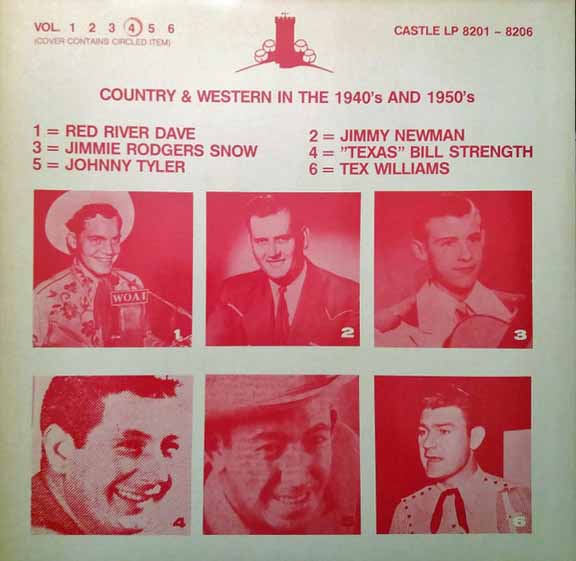
The track list for this album is:
- When Love Comes Knockin’
- Gotta Lotta Love
- Where Did My Heart Go
- Six Fools
- I Wanna Ride, Ride, Ride on Your Merry-go-round
- The Yellow Rose of Texas
- Cry, Cry, Cry
- Country Love
- Alone
- Is Someone Else the Lucky One Tonight
- Cherry Pie
- It Could Be a Wonderful World
- I’m Doing a Peach Of A Job
- Let’s Make Love or Go Home – Bill Strength and Tabby West
- You Can’t Have My Love – Bill Strength and Tabby West
In 2007 the British Archive of Country Music issued their CD 186, Texas Bill Strength, “When Love Comes Knockin’.” Songs on this CD are:
- Gotta Lotta Love
- Where Did My Heart Go
- Turn Around
- When Love Comes Knockin’
- North Wind
- But Do You Think I’m Happy
- It Ain’t Much But It’s Home
- When The Bright Lights Grow Dim
- It’s A Shame
- I Found My Love And Lost My Heart
- Yellow Rose Of Texas
- Country Love
- Alone
- It Could Be A Wonderful World
- Is Someone Else The Lucky One Tonight
- Cherry Pie
- Let’s Make Love Or Go Home
- You Can’t Have My Love
- Six Fools
- I Wanna Ride On Your Merry Go Round
- Black Coffee Blues
- Paper Boy Boogie
- Little I And Big You
- Who’s The Lucky One
- Frown On The Face Of The Moon
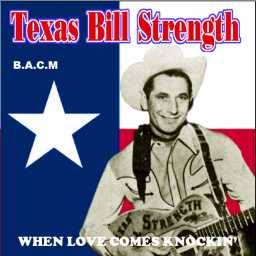
In 2013, the British Archive of Country Music issued their CD D415, Texas Bill Strength Volume 2, “Please Don’t Ever Forget Me.” Songs on this CD are: (*previously unissued)
- Prisoner’s Song (w. Johnny Bond) [radio]
- Turn Around (w. Carl Perkins) [radio]
- Never (w. Betty Foley [Atlanta, GA, 1954]
- What More Can I Do (w. Jerry Reed] [Minneapolis, radio, 1954]
- Someday You’ll Call My Name (w. Melody Ranch Boys) [Atlanta, GA, 1954]
- Y’All Come (w. Melody Ranch Boys) [Atlanta, GA, 1954]
- When I Lost My Baby*
- Try To Think How Lonesome I Would Be*
- There’s No Way Out*
- That Lucky Old Sun [radio] In 2023, Bill’s son Dale produced a video that melded Bill’s voice with live action of his sons singing along, Dale playing the mandolin, and Bobby playing the drums. The video was premiered on March 27, 2023, and can be seen on YouTube.
- Substitute Love
- Post No Bills
- Please Don’t Ever Forget Me
- King Size Broken Heart*
- Mr. Moon Sailing High
- Molly Darlin‘ [radio, July-54]
- Little Red Wagon
- I’m Walking In Heaven
- If I Could Buy Your Love
- Actions Speak Louder Than Words
- I Was Only Teasin‘ You
- It’s Nice To be Living
- Million Memories
- Tears In My Beer
- Nobody Knows This More Than Me
- Guess I’d Better Go
- Heart Don’t Complain
- Picture Of My Heart
- Rain Or Shine
- Senorita
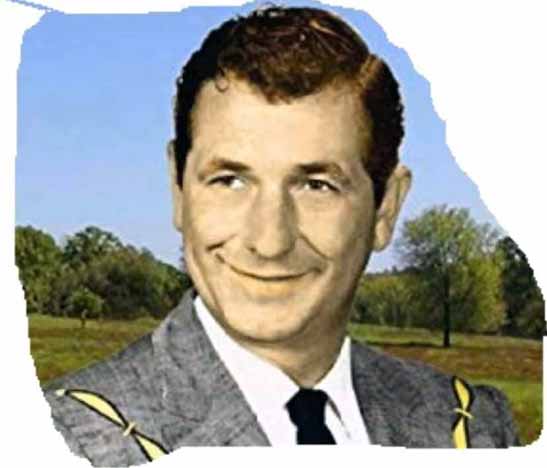
Prague Frank also lists an album on HMC Records called “Paper Boy Boogie.” He gives HMC a question mark, though, with no other information about the company or the record. He does list the tracks:
- Actions Speak Louder Than Words
- Mr. Moon Sailing High
- Black Coffee Blues
- Paper Boy Boogie
- Cherry Pie
- Rain Or Shine
- It’s Nice To Be Living
- Country Love
- Let’s Make Love Or Go Home
- Turn Around
- Cry Cry Cry
- When Love Comes Knockin’
- Gotta Lotta Love
- North Wind
- Six Fools
- Watching The World Go By
- Tears In My Beer
- Hillbilly Hades
- Nervous As A Cat
- Little Red Wagon
Texas Bill’s songs also appear on any number of compilations; “Hillbilly Hades” and “Paper Boy Boogie” seem to be his most popular for these records. The former even appears on a Dr. Demento package! See the bottom of this page for some examples.
